It’s been awhile since I’ve touched this blog. It’s been even longer since I took the trip I’m detailing in this post. It seems there was always an excuse for putting it off: chasing kids around with their busy schedules or chasing birds near and far. Well, here we are together, enduring this pandemic, with nothing but time on our hands and with no place to go. So maybe we can escape the news, however briefly, and go back to the summer of 2018 to relive a little roadtrip the kids and I took.
In July 2018, Melissa left the state for a convention with some girlfriends. Not wanting to be stuck at home that whole time, the kids and I struck out on our own adventure–a loop tour through South Dakota, Wyoming, Montana, and North Dakota. Of course it was fueled by my desire to get some new birds (and show the kids some new states and fun scenery, I guess).
With camper in tow, the kids and I set out early one morning to get to the Black Hills by late afternoon. Heading west on I-90 through South Dakota was pretty uneventful save for hundreds of Corvettes that passed us. They were literally everywhere, even at the obligatory stop of Wall Drug. What in the world was going on?
 Once we got to our destination of Spearfish, South Dakota, we figured it out. These geri drivers were at some annual Corvette rally which was being hosted by the very town where we were camping. While they were there to ogle each other’s cars, we were there to take in the natural beauty of the area. After dropping the camper off at the Spearfish City Campground, the kids and I drove the Spearfish Canyon Scenic Byway, a winding road that followed the mountain stream called Spearfish Creek up through the breathtaking, steep-sloped canyon.
Once we got to our destination of Spearfish, South Dakota, we figured it out. These geri drivers were at some annual Corvette rally which was being hosted by the very town where we were camping. While they were there to ogle each other’s cars, we were there to take in the natural beauty of the area. After dropping the camper off at the Spearfish City Campground, the kids and I drove the Spearfish Canyon Scenic Byway, a winding road that followed the mountain stream called Spearfish Creek up through the breathtaking, steep-sloped canyon.
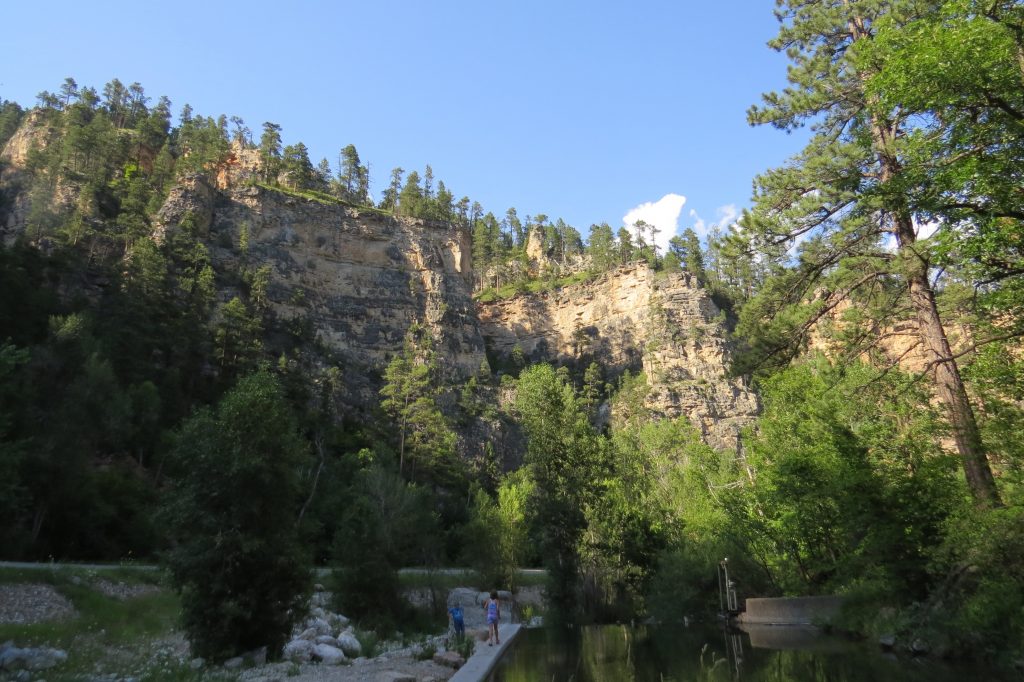 Truly this canyon was magnificent. Mount Rushmore is great, but Spearfish Canyon is a must-do if visiting the Black Hills. Unlike dozens more Corvettes on the Scenic Byway, I wasn’t just cruising looking at scenery–I was on a mission to find a bird that calls the fast, cold Spearfish Creek home: the American Dipper. The Black Hills are the closest place to Minnesota to find this bird that is a denizen of mountain streams. Range maps show the Black Hills as a habitat island for this bird, completely separate from the rest of its range. Seeing this shallow stream in the mountainous terrain made it clear why this place was acceptable to the Dipper.
Truly this canyon was magnificent. Mount Rushmore is great, but Spearfish Canyon is a must-do if visiting the Black Hills. Unlike dozens more Corvettes on the Scenic Byway, I wasn’t just cruising looking at scenery–I was on a mission to find a bird that calls the fast, cold Spearfish Creek home: the American Dipper. The Black Hills are the closest place to Minnesota to find this bird that is a denizen of mountain streams. Range maps show the Black Hills as a habitat island for this bird, completely separate from the rest of its range. Seeing this shallow stream in the mountainous terrain made it clear why this place was acceptable to the Dipper.
The kids and I made periodic stops along the Byway to check locations from eBird that had fresh Dipper sightings. We were striking out, including at Iron Creek which was a feeder stream to Spearfish Creek and held the most promise based on eBird reports. But it was Evan who came to the rescue. He asked me what these birds looked like and said he had just seen a small gray bird fly under the overpass where Iron Creek went underneath the highway. So we kept looking and eventually we spotted it. What a small, fantastic bird it was! There really is no other bird like an American Dipper.
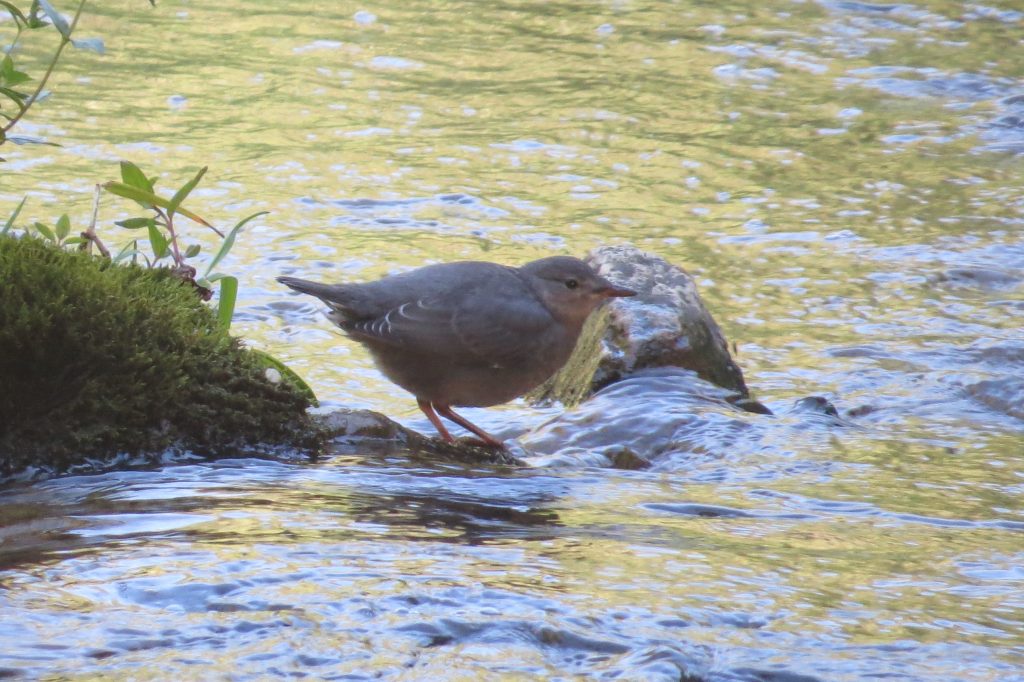
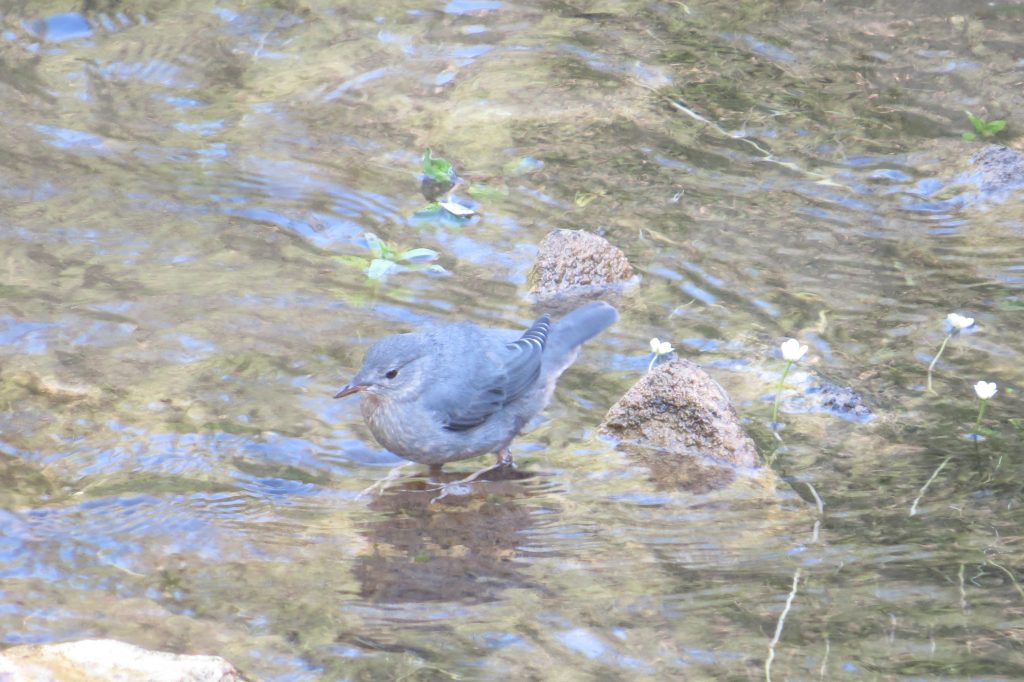
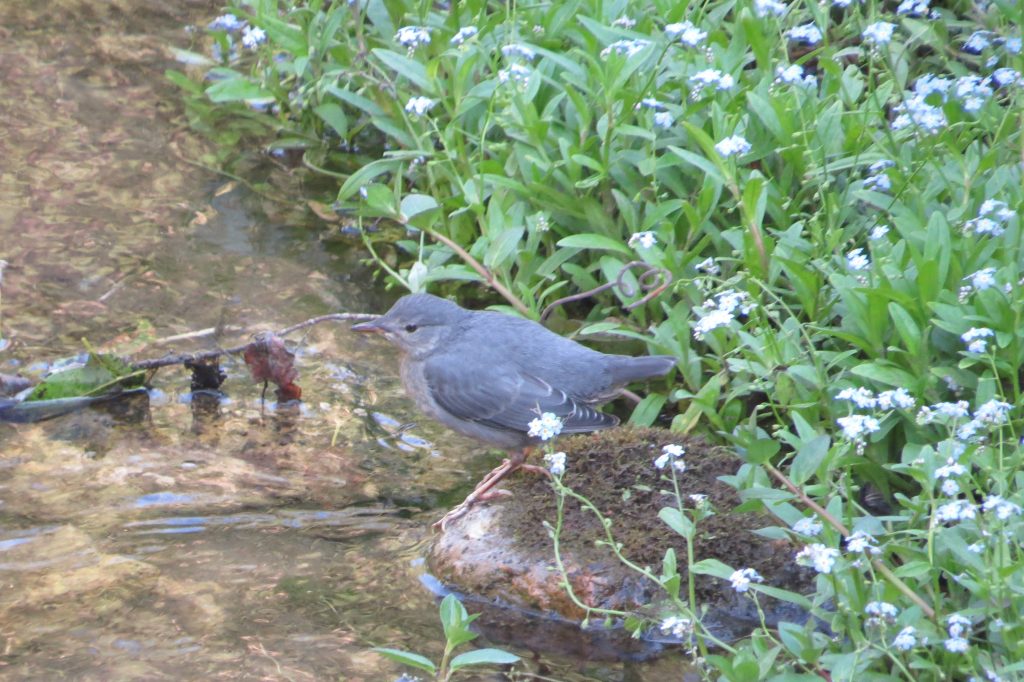
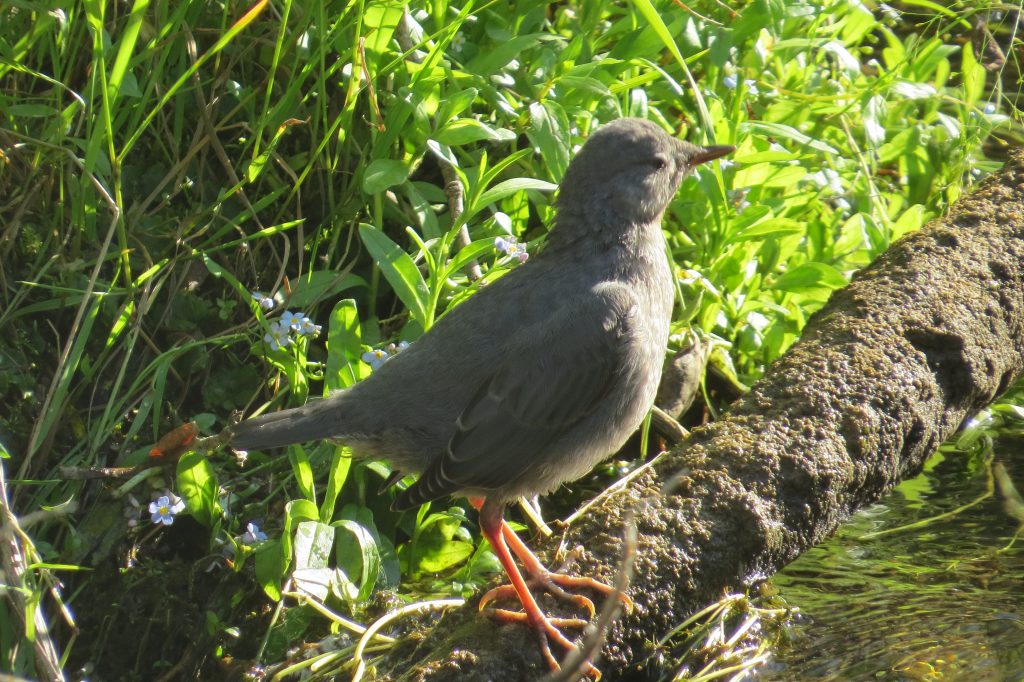 Even the kids enjoyed watching the Dipper do Dipper things, like flying all around and… dipping.
Even the kids enjoyed watching the Dipper do Dipper things, like flying all around and… dipping.
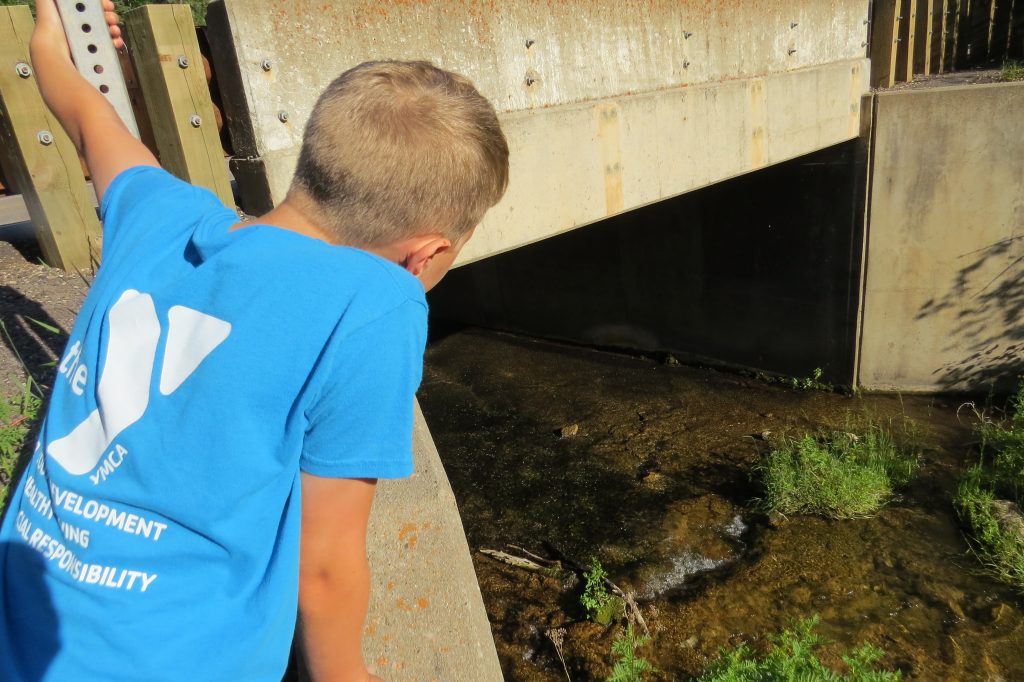
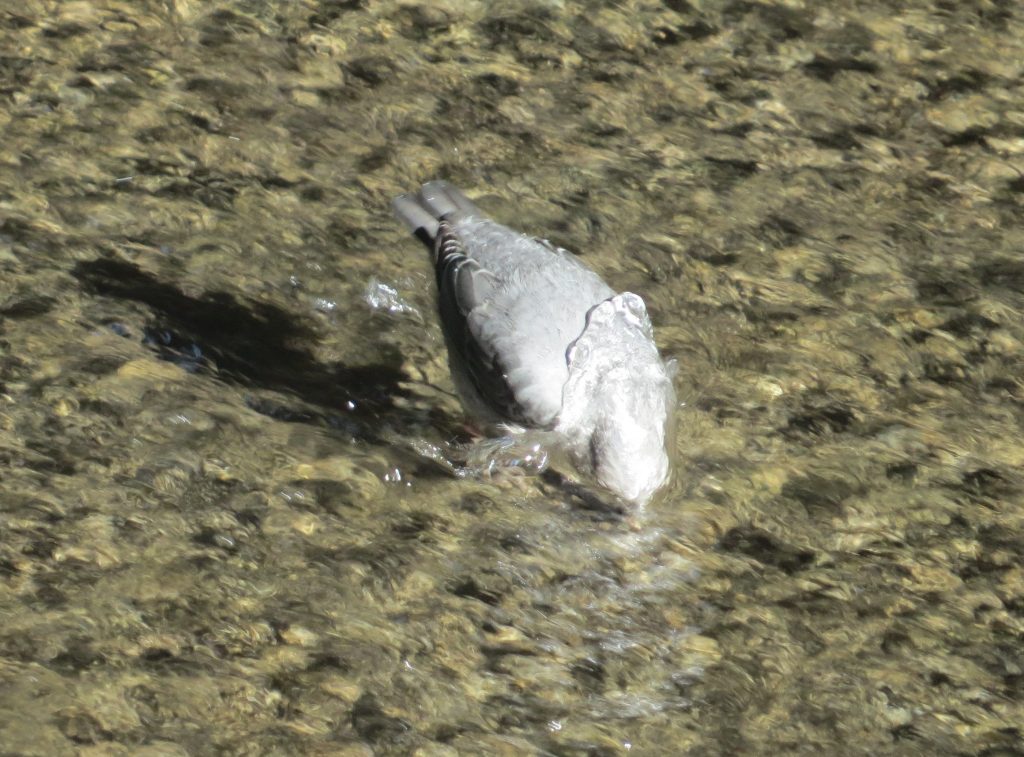
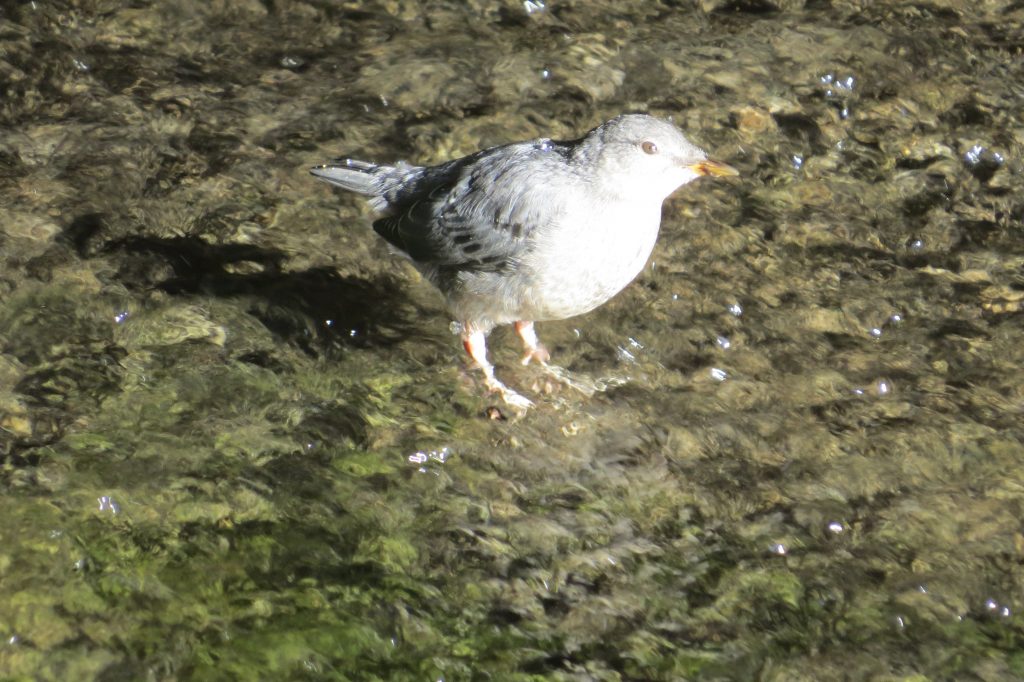 The Dipper was the main birding goal for South Dakota. With it securely locked down, the kids and I retired for the night at the Spearfish City Campground. This campground is the kids’ favorite camping location ever because Spearfish Creek runs right through it, a great place to cool off during the day or play in the night.
The Dipper was the main birding goal for South Dakota. With it securely locked down, the kids and I retired for the night at the Spearfish City Campground. This campground is the kids’ favorite camping location ever because Spearfish Creek runs right through it, a great place to cool off during the day or play in the night.
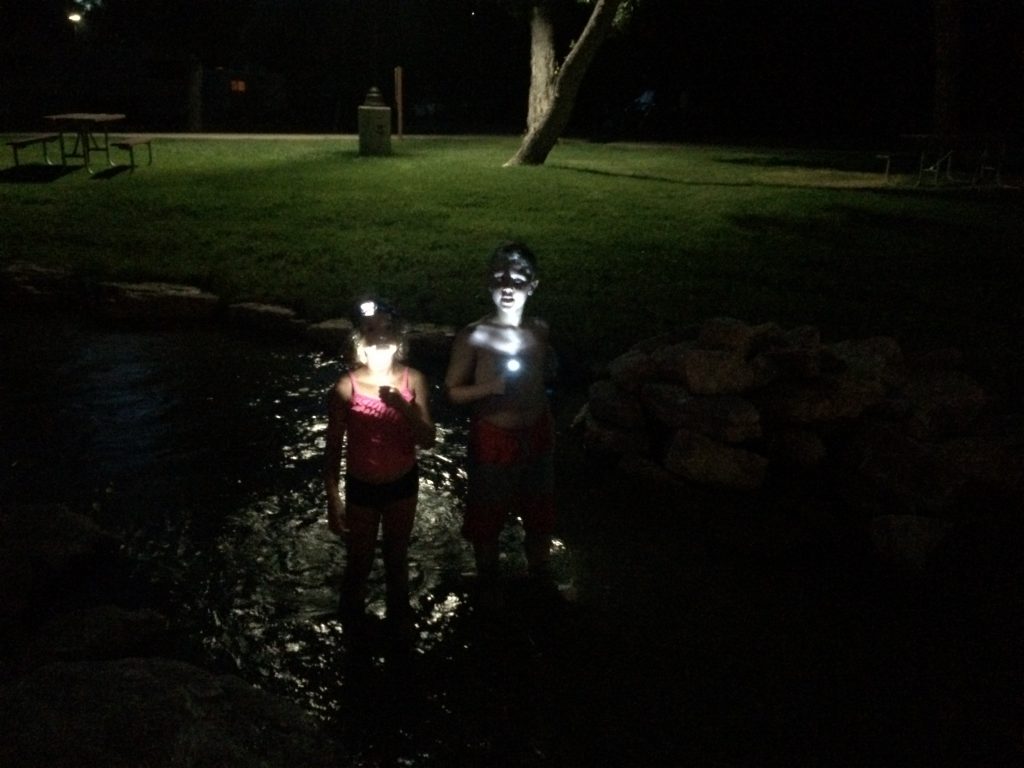 The kids enjoyed the campground so much that we decided to spend a second night there instead of our original plan of camping in Montana. Our second day of the trip was not about the birds as we went to see famous landmark in next-door Wyoming: Devils Tower. This was a lifer experience for all of us and something I had wanted to see for some time.
The kids enjoyed the campground so much that we decided to spend a second night there instead of our original plan of camping in Montana. Our second day of the trip was not about the birds as we went to see famous landmark in next-door Wyoming: Devils Tower. This was a lifer experience for all of us and something I had wanted to see for some time.
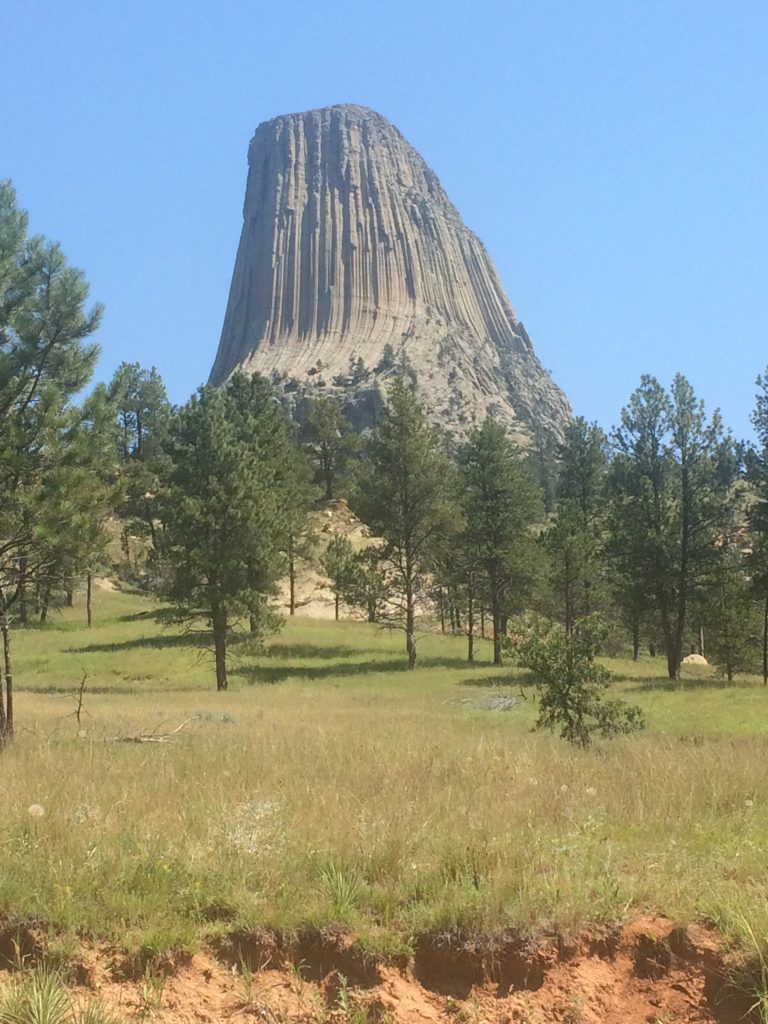
On the way back to Spearfish I decided to take the scenic route on the forest service roads through the Wyoming Black Hills. Little did I know that I wouldn’t have cell reception and that my paper placemat map of the area was woefully insufficient. As one winding road fed into another, we couldn’t tell when we would emerge from the wilderness. The kids grew more and more nervous. They claimed I was lost. Psshht. But to alleviate their worries, I flagged down a kind Wyoming resident who was recreating in the forest, and he kindly let us follow him out to a main highway and made sure we had enough gas. The kids were relieved. To this day we still argue about whether I was lost or not.
On the third day of our trip we traveled from Spearfish up into Montana. Our time in Montana was just a few hours which was just enough to stop and smell the sagebrush of southeastern Montana, a smell I will never grow tired of.
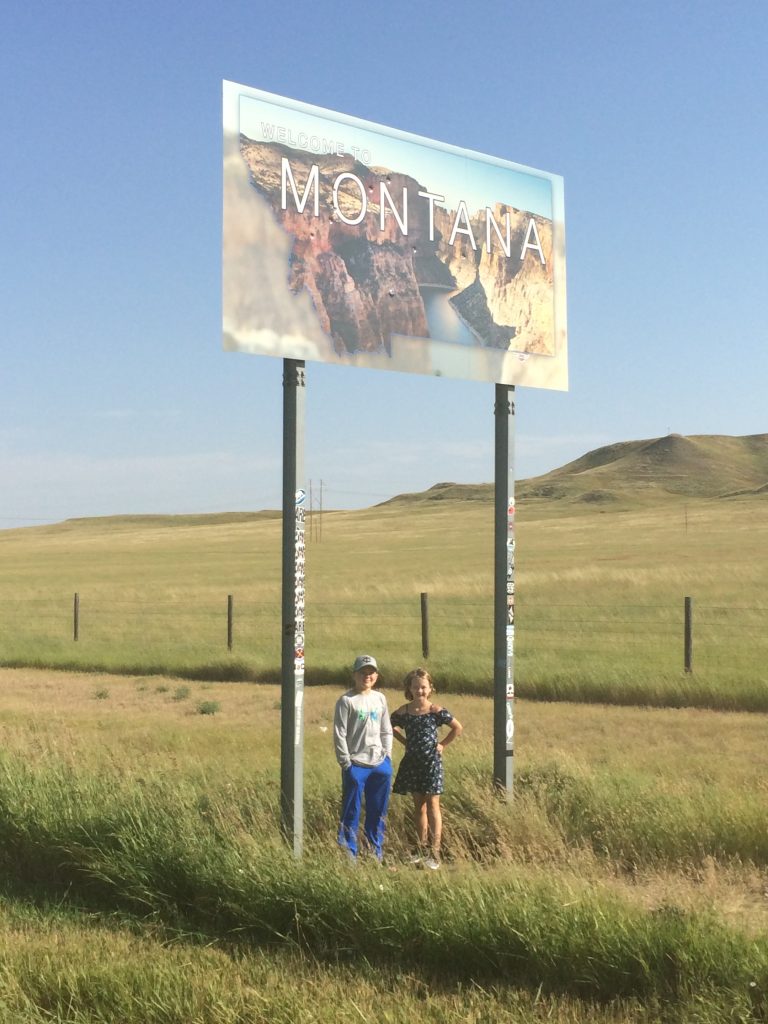 After our quick foray into Montana, we were headed to our camping destination of Theodore Roosevelt National Park in western North Dakota. When we got to the park, we were devastated to learn the campground was all filled up. So we camped at a Motel 6 in Dickinson.
After our quick foray into Montana, we were headed to our camping destination of Theodore Roosevelt National Park in western North Dakota. When we got to the park, we were devastated to learn the campground was all filled up. So we camped at a Motel 6 in Dickinson.
The next morning we went back west about 20 miles to a certain country road I had been studying on eBird just north of Belfield (31st Street). I knew this road held two potential lifers and a host of other fun birds, but I wasn’t expecting such remote grassland beauty. It was one of the coolest places I had ever birded.
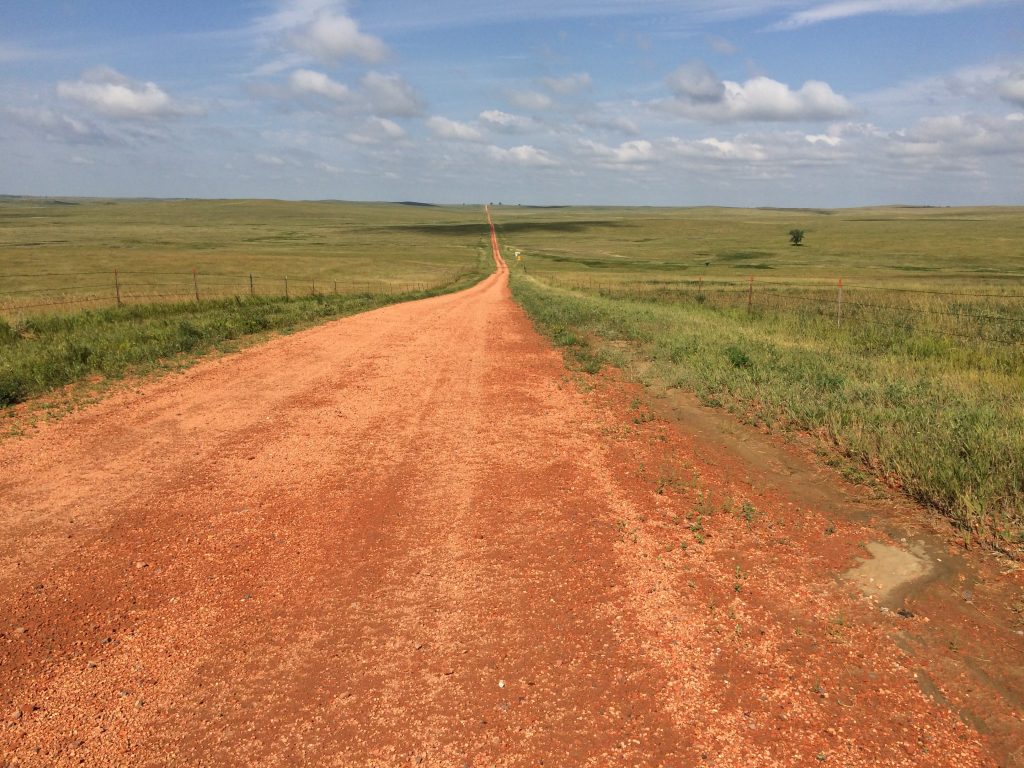
The two grassland species I was after were Baird’s Sparrow and Sprague’s Pipit–two extremely rare birds in Minnesota. Here in North Dakota, they are annual and occur in good numbers in some areas.
Because I had been studying the vocalizations of both birds, it didn’t take me long to pick out my Baird’s Sparrow lifer and get some good looks at it. I remember at the beginning stages of my birding thinking how boring and drab this sparrow looked, yet I found myself absolutely captivated by it here in North Dakota. Perhaps it was its beautiful song, the incredible setting, the rarity of it, or all of the above, but this was a lifer I enjoyed immensely.
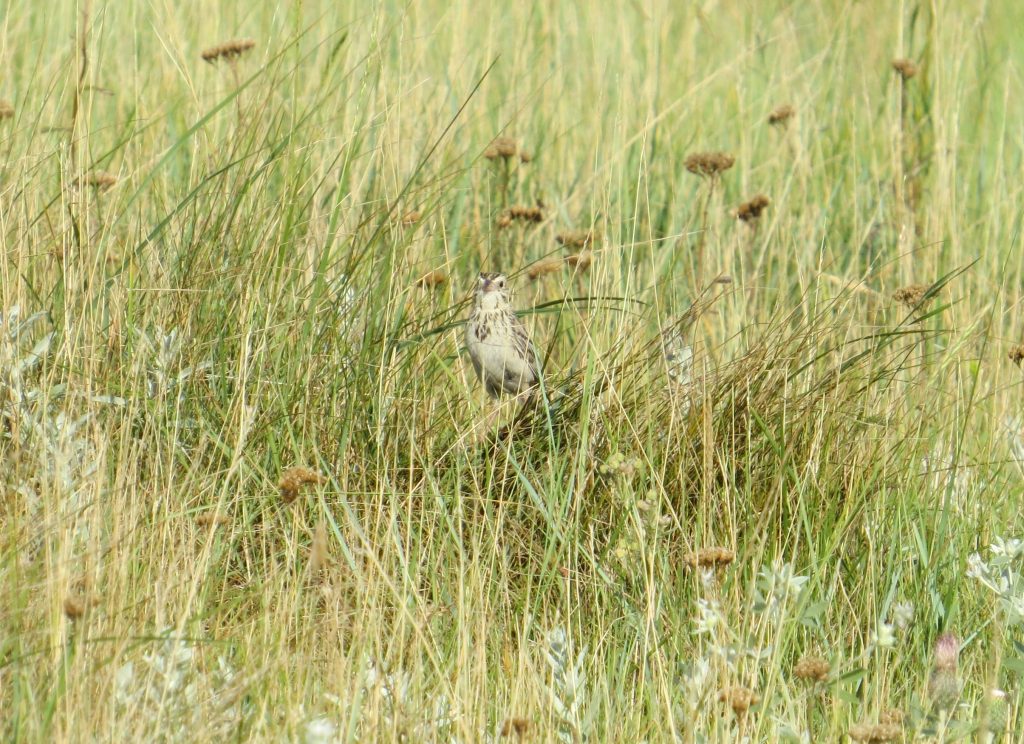
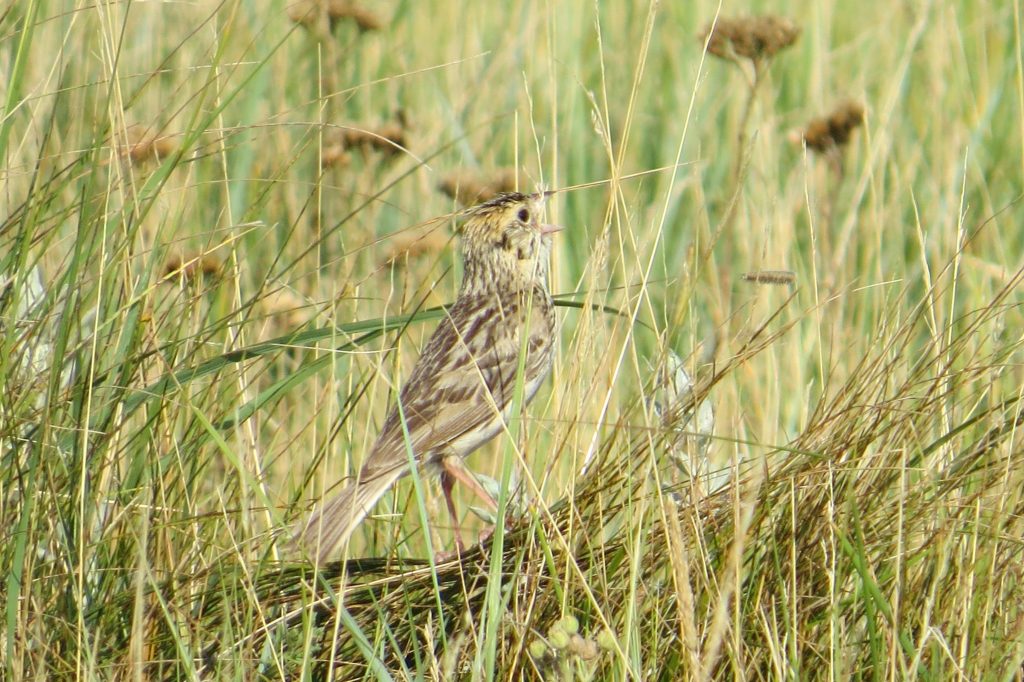
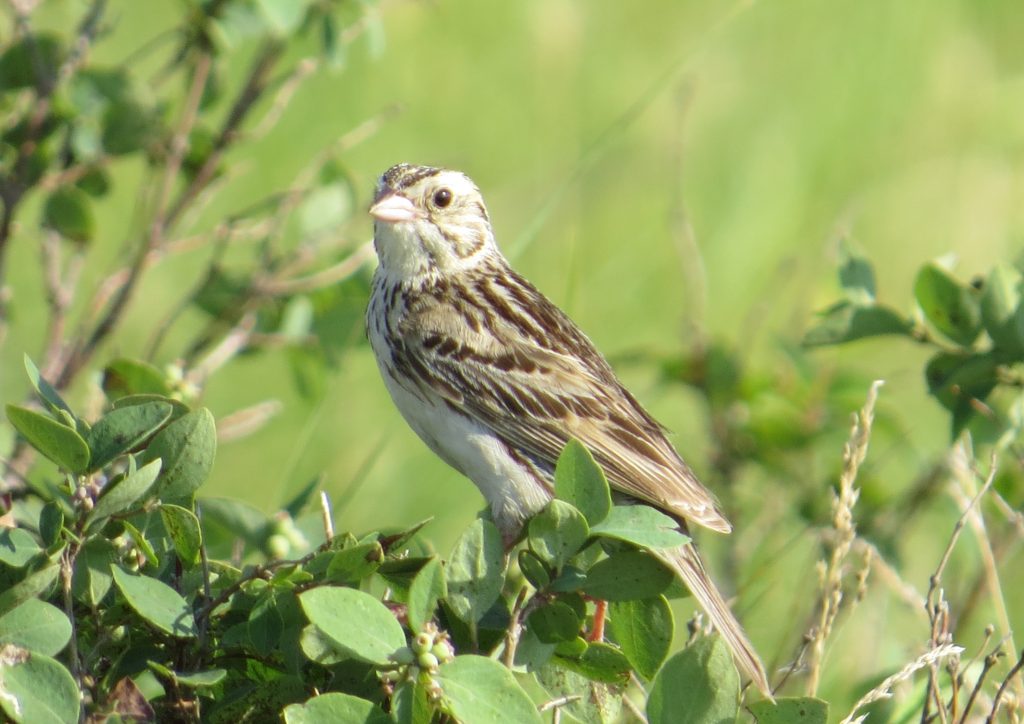
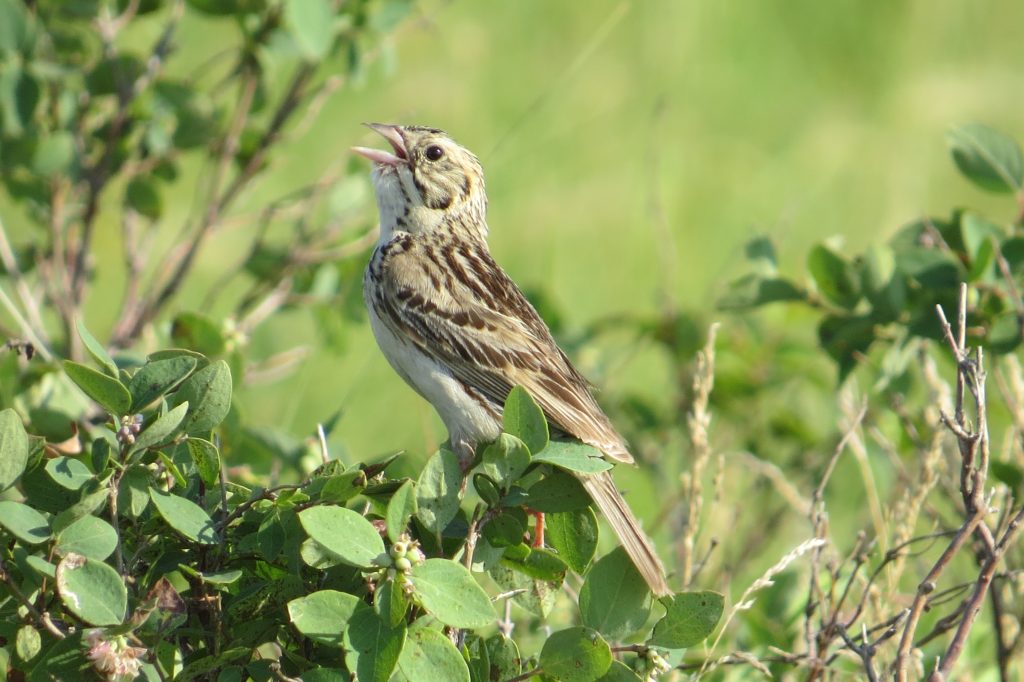 The Sprague’s Pipits had been reported in decent numbers too, and I was able to detect them by their spiraling series of whistles given from very high in the sky. It took a long time, but I was finally able to pick one out against the overcast sky–a mere speck that resembled a bird.
The Sprague’s Pipits had been reported in decent numbers too, and I was able to detect them by their spiraling series of whistles given from very high in the sky. It took a long time, but I was finally able to pick one out against the overcast sky–a mere speck that resembled a bird.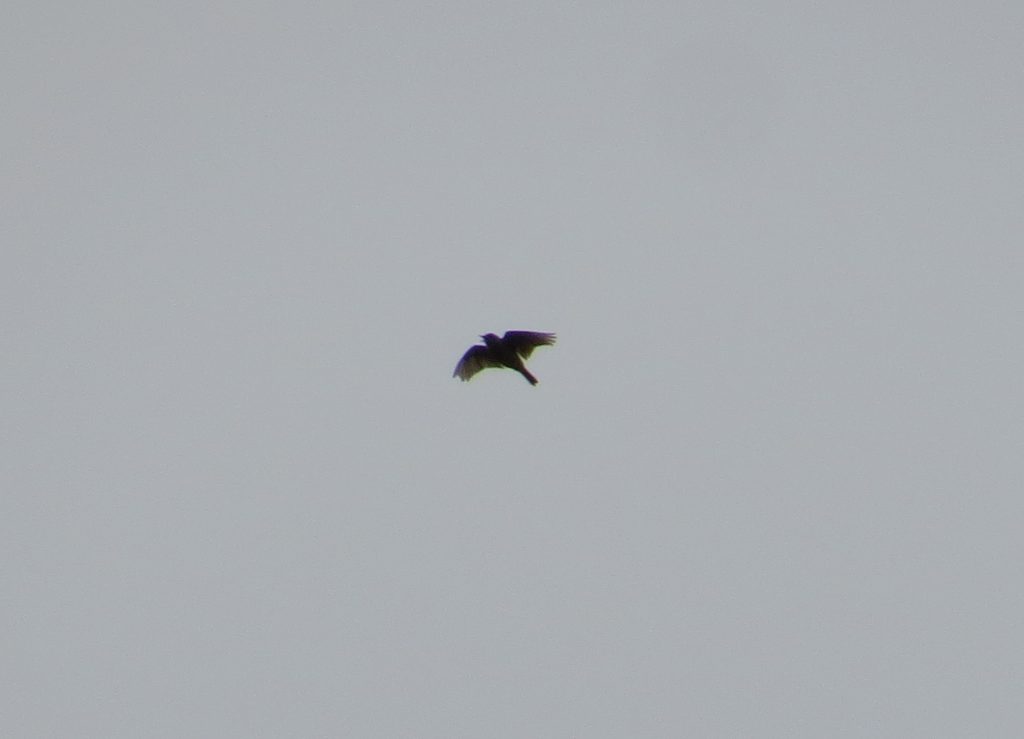
These birds seemingly stay aloft forever. It was remarkable how they would seem to just float in the strong winds without needing to come back to Earth. I never could spot one come down. I was hoping to view and photograph one on the ground. During all this time, their beautiful song became ingrained in my memory. In fact, long after this I heard that song repeatedly on the Canadian TV show Heartland that Marin had gotten hooked on.
This red dirt road was a treasure chest of good birds besides these two key lifers. Other highlights included seeing a couple of Burrowing Owls, a fly-by Prairie Falcon, a Golden Eagle, Western Kingbirds, Lark Buntings, and a juvenile Swainson’s Hawk. 31st Street north of Belfield was just one of those magical places to bird.
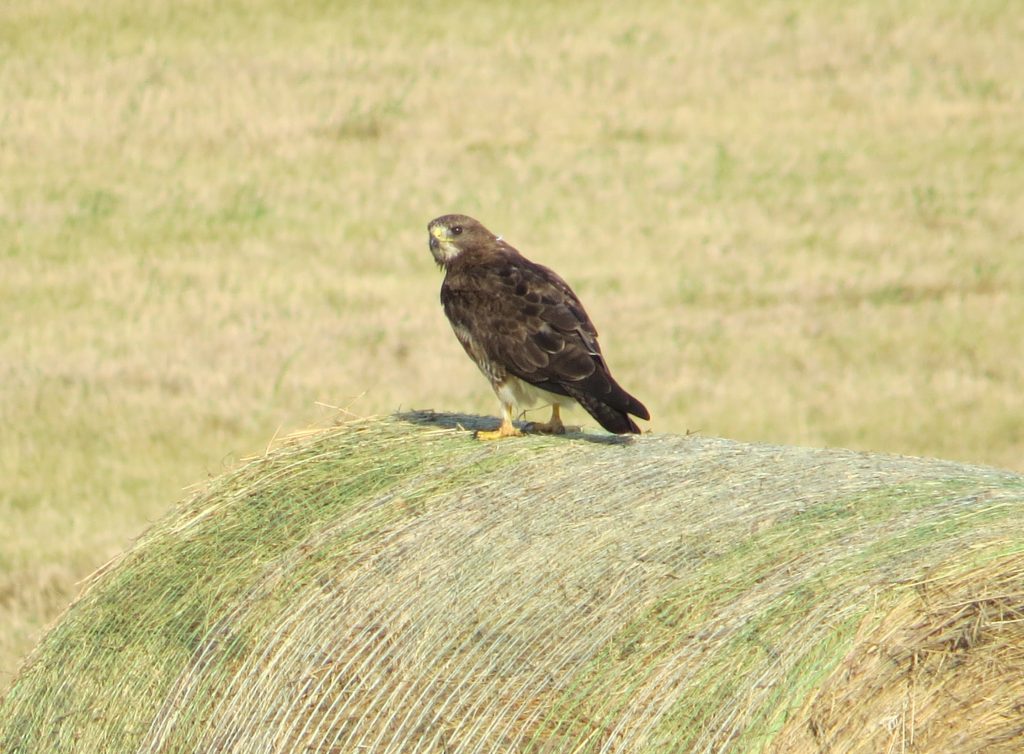
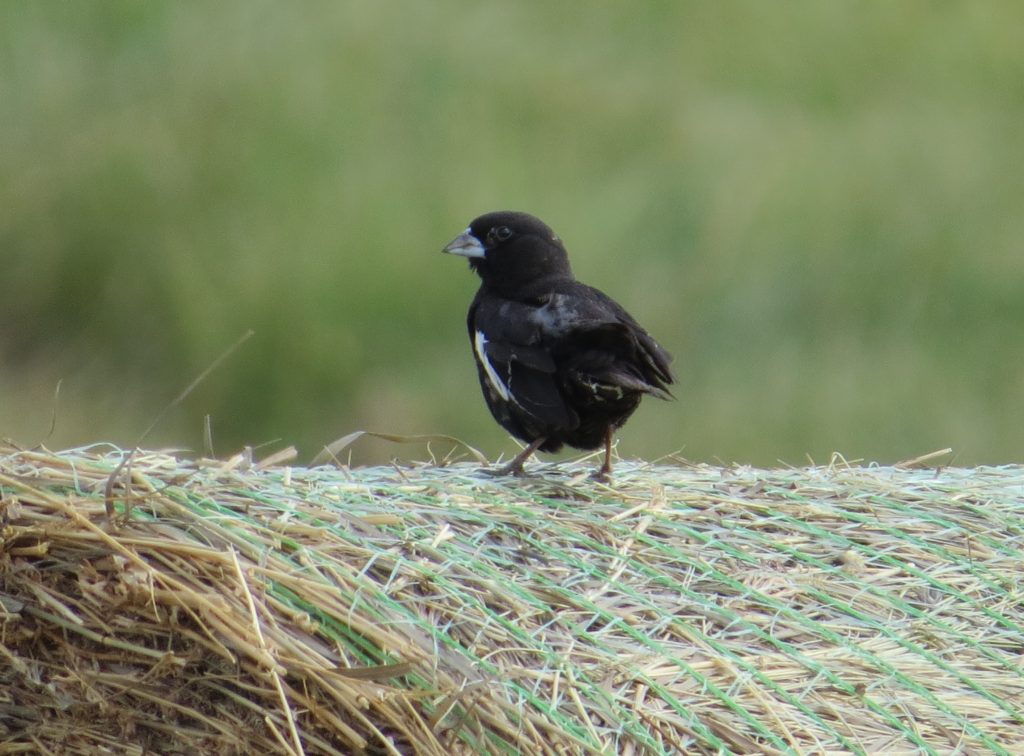 As we made our way east across North Dakota on our way back home, we stopped in the central part of the state to look for a Clark’s Grebe lifer. Despite finding many Western Grebes, we couldn’t come up with a Clark’s. All is well since I later got that one in San Francisco this past summer. One of my favorite memories from poking around looking for the Grebe was coming across a dozen Cattle Egrets mixed in with some cattle. It’s funny how birds like that can be so rare in Minnesota yet so easily found in North Dakota.
As we made our way east across North Dakota on our way back home, we stopped in the central part of the state to look for a Clark’s Grebe lifer. Despite finding many Western Grebes, we couldn’t come up with a Clark’s. All is well since I later got that one in San Francisco this past summer. One of my favorite memories from poking around looking for the Grebe was coming across a dozen Cattle Egrets mixed in with some cattle. It’s funny how birds like that can be so rare in Minnesota yet so easily found in North Dakota.
This was a fun little trip that produced some great memories for me and the kids and gave me three key lifers. I’m not sure why it took me so long to write about it. There are more untold stories of life birds still in the vault. As we go along in through this uncharted period of history, I may have to bring one out every so often.

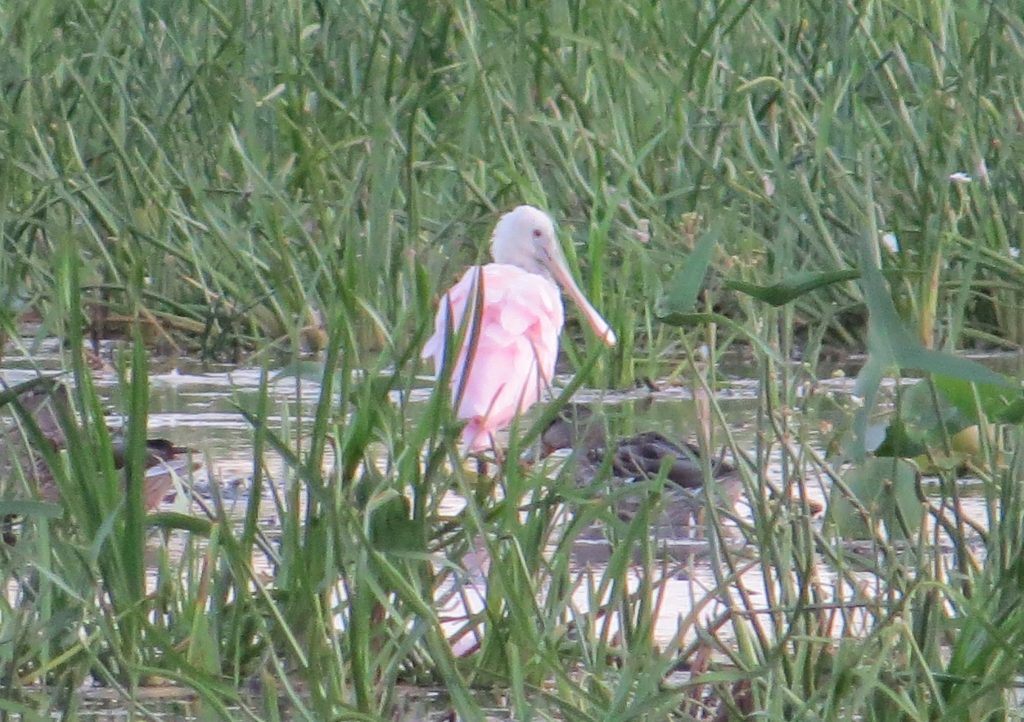
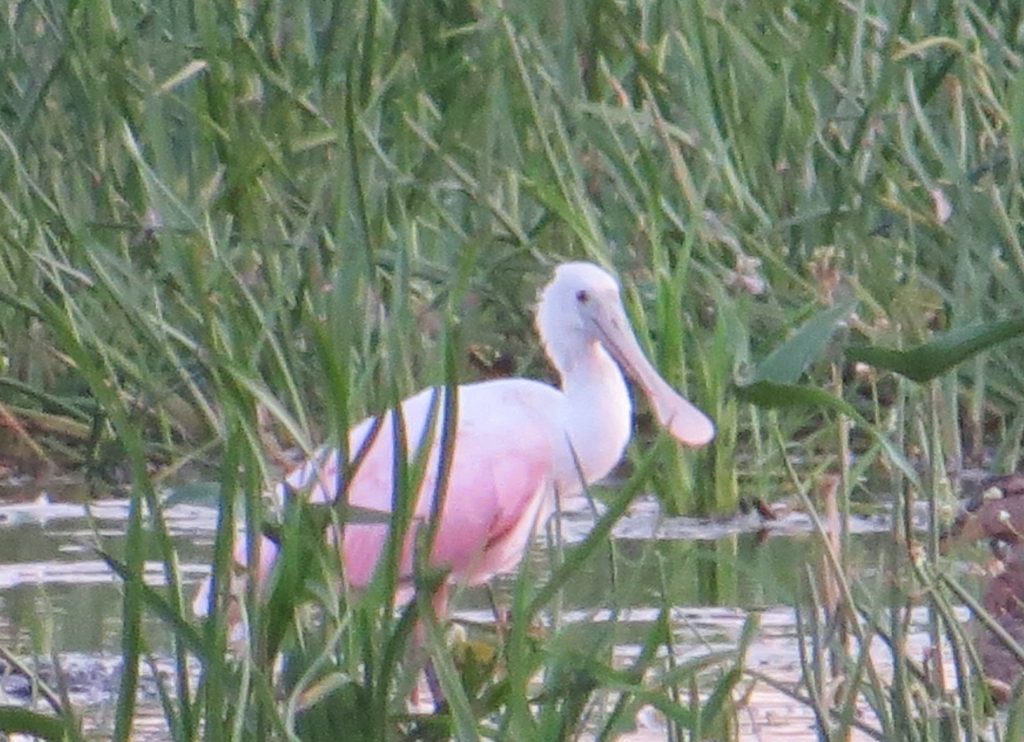
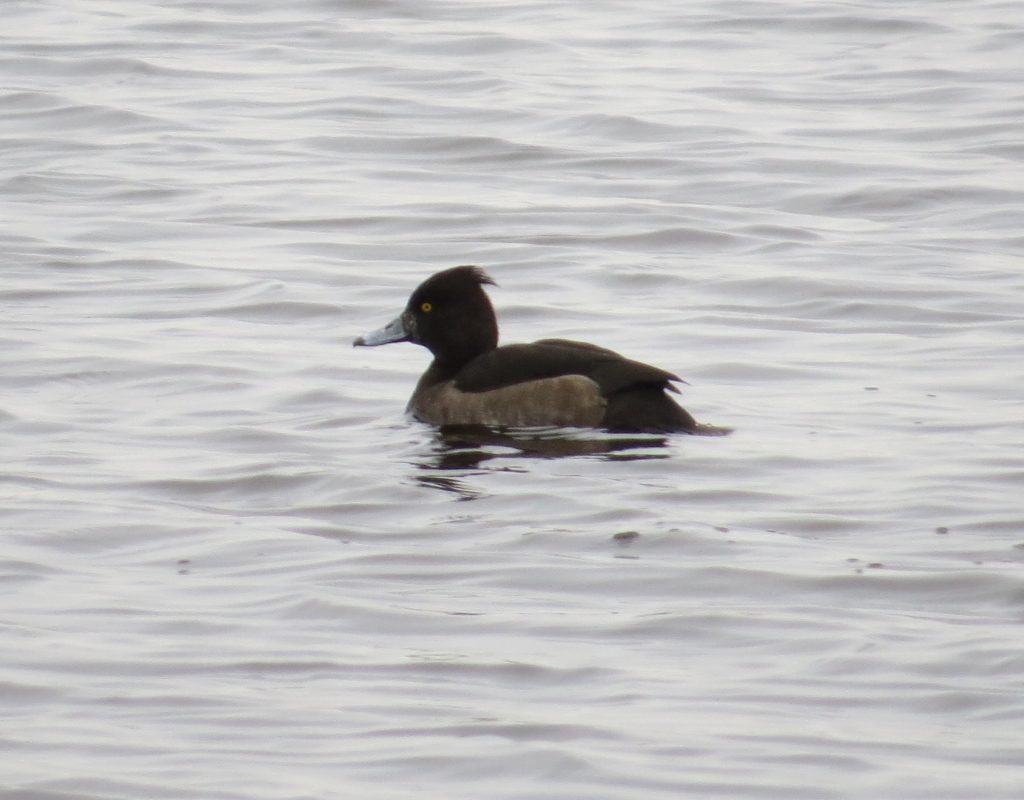
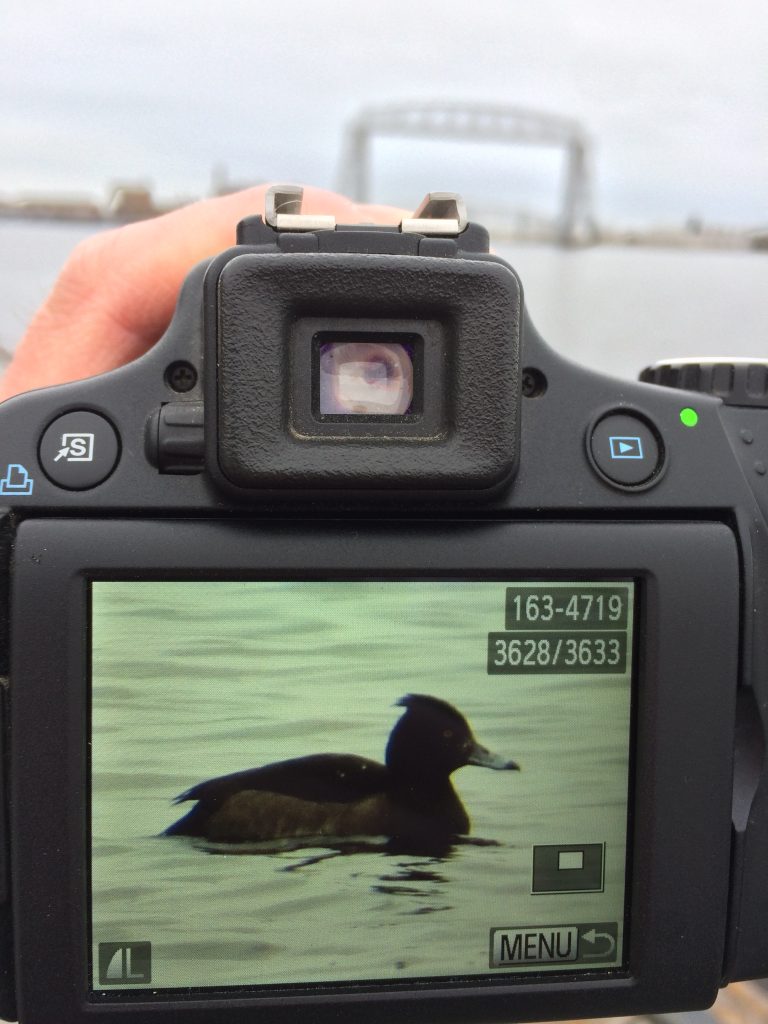

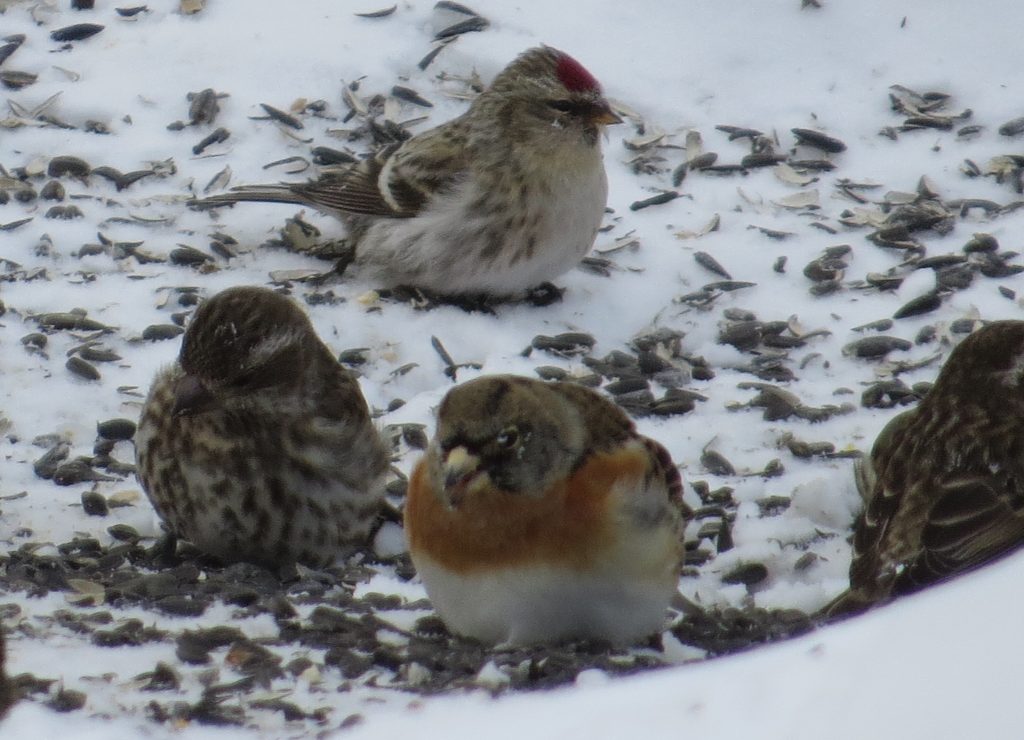
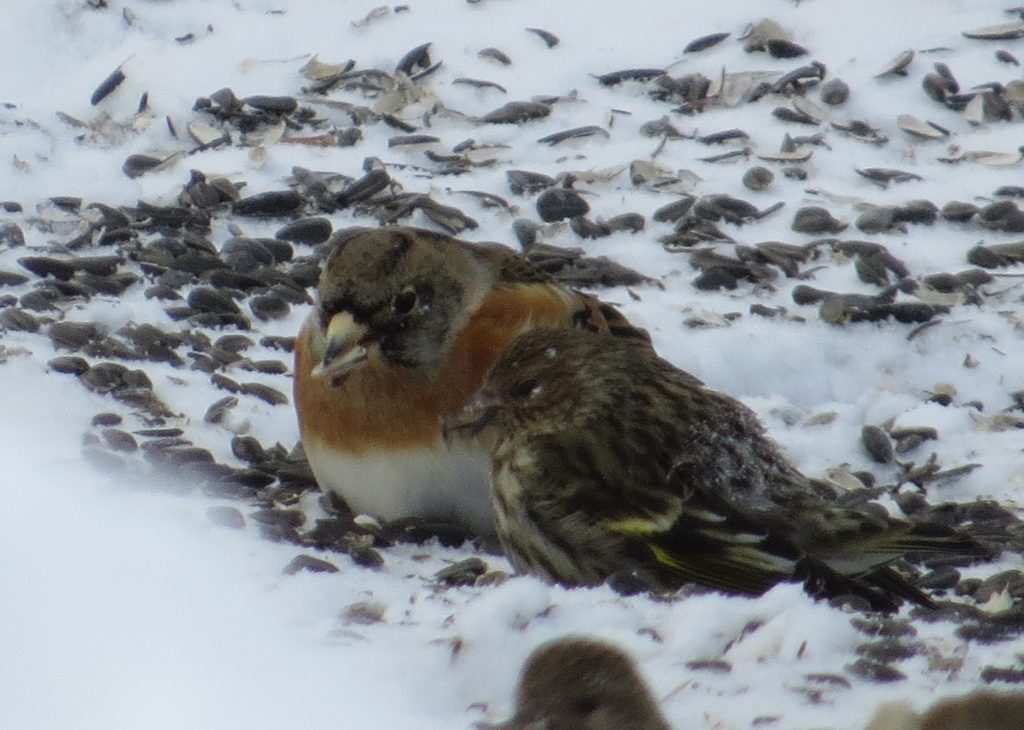
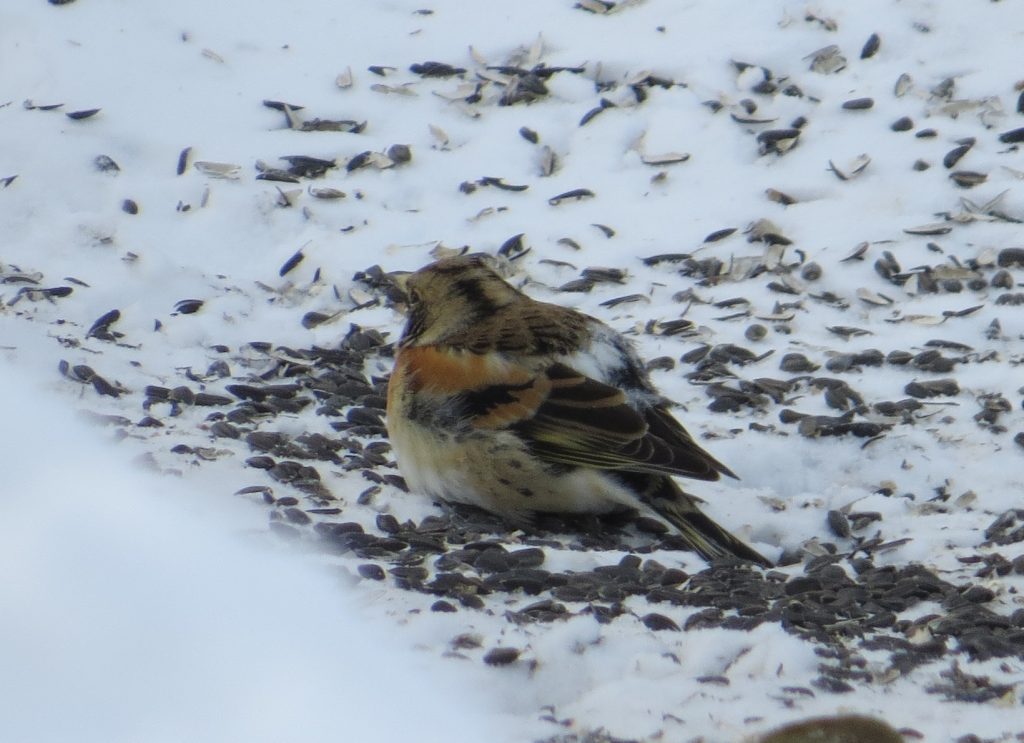 Beau was perhaps the most gracious stakeout host I’ve met. He generously shared this bird with other birders for days even though it meant his family had near constant vehicles right outside their living room. But with a yard scene this cool, it’s too good to keep to oneself.
Beau was perhaps the most gracious stakeout host I’ve met. He generously shared this bird with other birders for days even though it meant his family had near constant vehicles right outside their living room. But with a yard scene this cool, it’s too good to keep to oneself.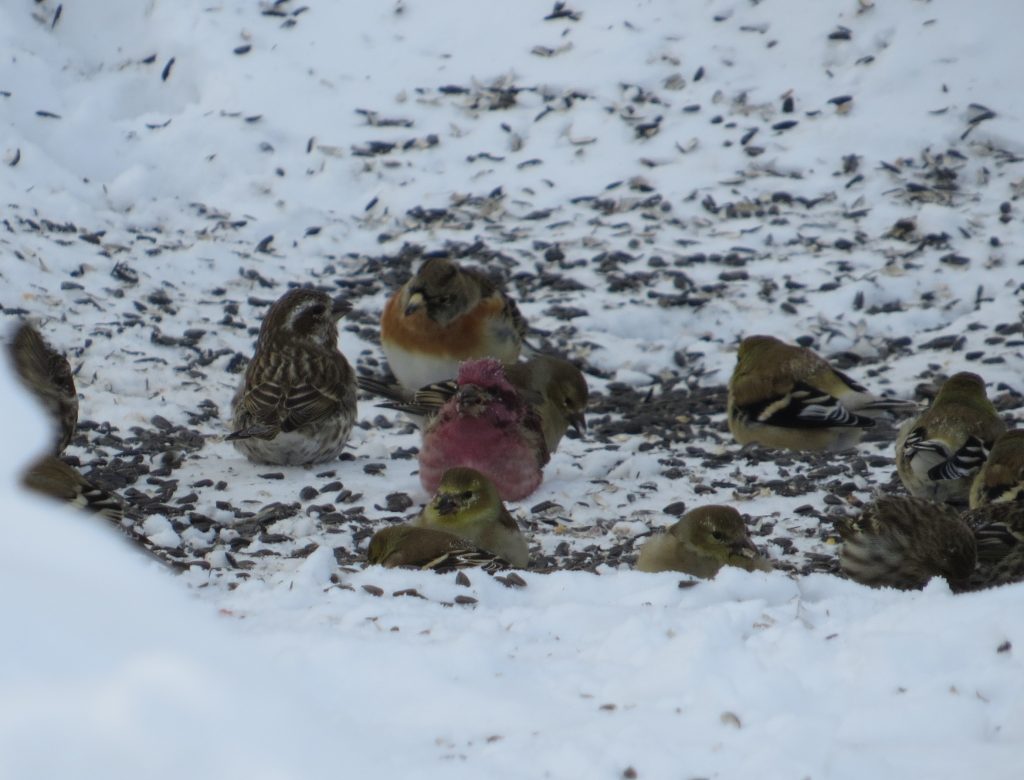
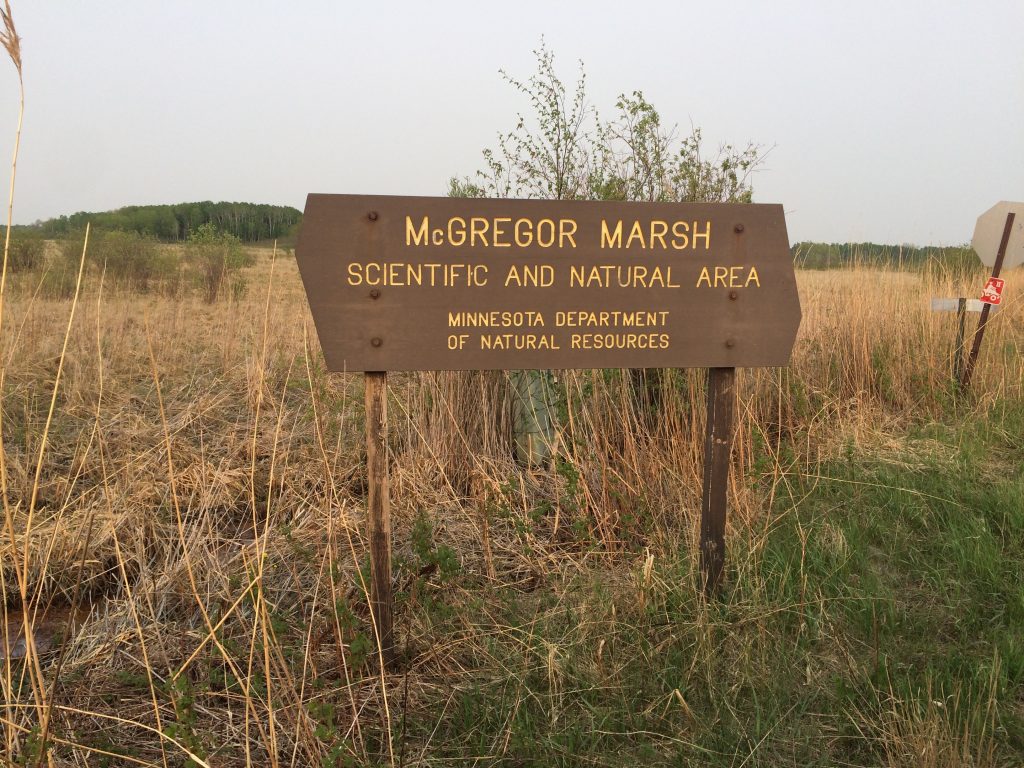
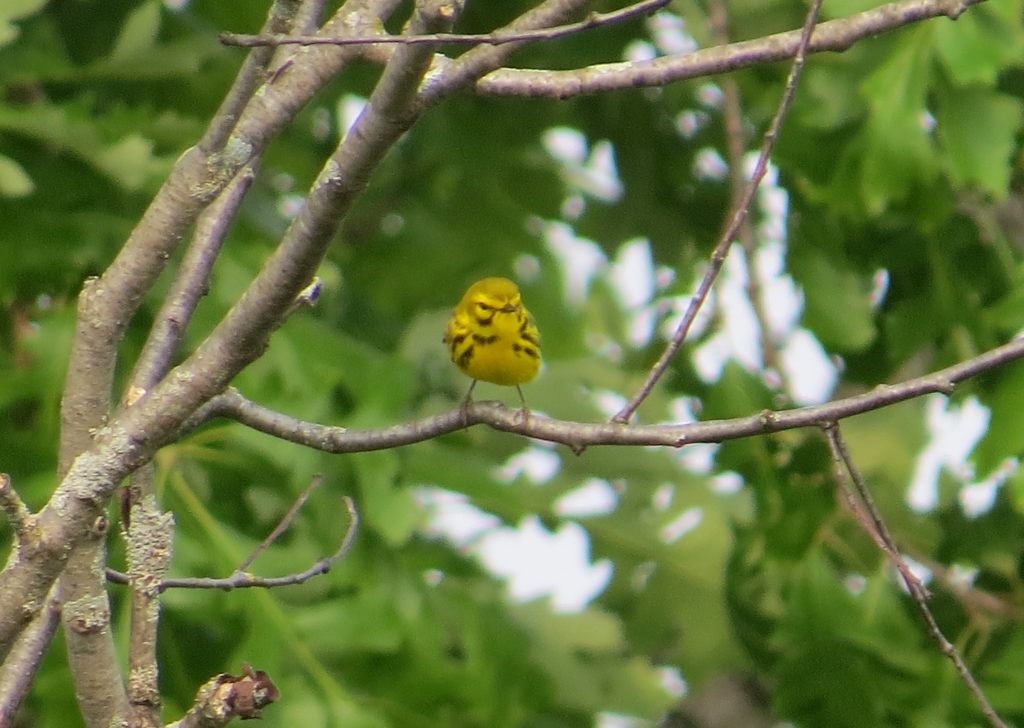 Birds that are long-hoped for seem more enjoyable than the random surprise birds. This one was a treat for the eyes and ears.
Birds that are long-hoped for seem more enjoyable than the random surprise birds. This one was a treat for the eyes and ears.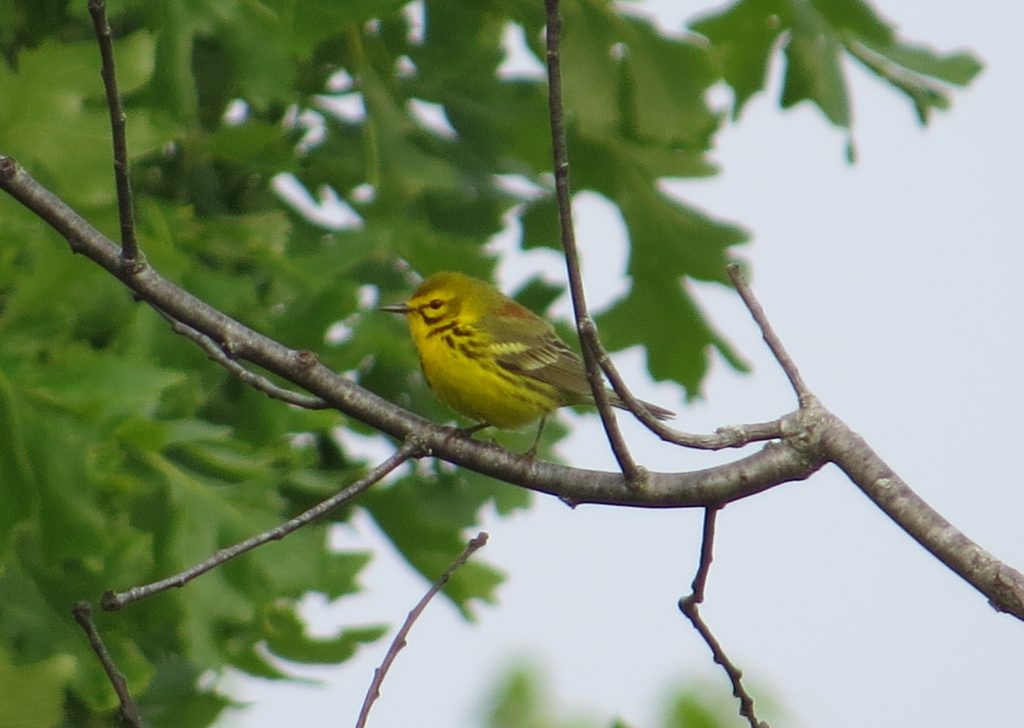
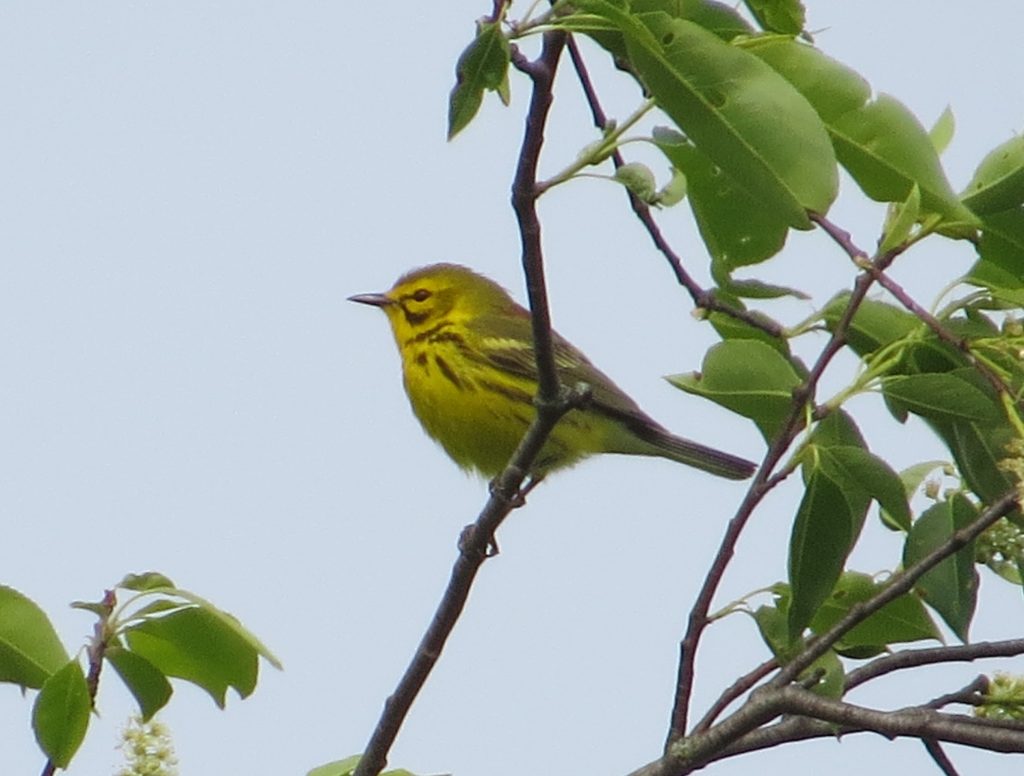 This bird was definitely the prize, but we also enjoyed numerous Henslow’s Sparrows and a Black-billed Cuckoo in the same area. We also made a stop a mile away for a White-eyed Vireo, also a casual species, found by Josh Watson in true Patagonia Picnic Table fashion. We got terrible looks at this bird before it disappeared. So it still remains as one of those birds I would like to see well since my other observation was a similar experience several years ago at Flandreau State Park in New Ulm. For Steve it was a state bird. Speaking of which, this trip to the southeastern part of the state allowed us to look for some overdue life birds for Steve. In Houston County we followed up on a report of an Acadian Flycatcher which we found no problem for Steve’s life list. A Cerulean Warbler singing nearby was a nice bonus.
This bird was definitely the prize, but we also enjoyed numerous Henslow’s Sparrows and a Black-billed Cuckoo in the same area. We also made a stop a mile away for a White-eyed Vireo, also a casual species, found by Josh Watson in true Patagonia Picnic Table fashion. We got terrible looks at this bird before it disappeared. So it still remains as one of those birds I would like to see well since my other observation was a similar experience several years ago at Flandreau State Park in New Ulm. For Steve it was a state bird. Speaking of which, this trip to the southeastern part of the state allowed us to look for some overdue life birds for Steve. In Houston County we followed up on a report of an Acadian Flycatcher which we found no problem for Steve’s life list. A Cerulean Warbler singing nearby was a nice bonus.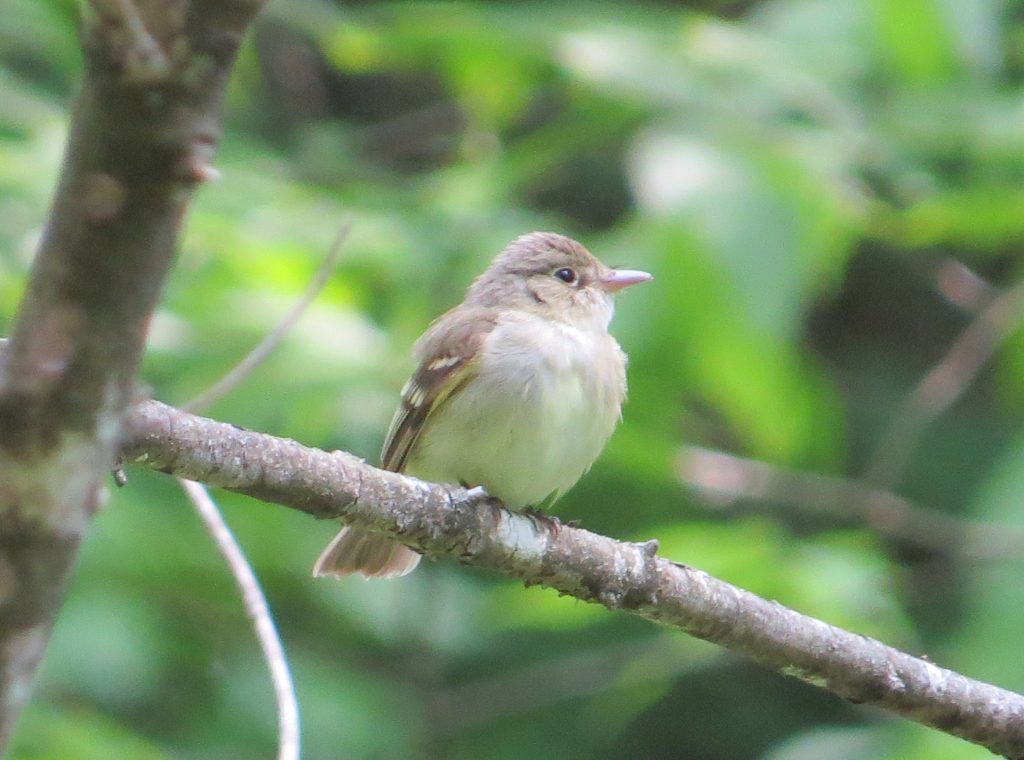 On the way home we stopped at Whitewater State Park and found Steve his lifer Louisiana Waterthrush thanks to some tips from John Hockema and some guiding from Malcolm Gold six years ago.
On the way home we stopped at Whitewater State Park and found Steve his lifer Louisiana Waterthrush thanks to some tips from John Hockema and some guiding from Malcolm Gold six years ago.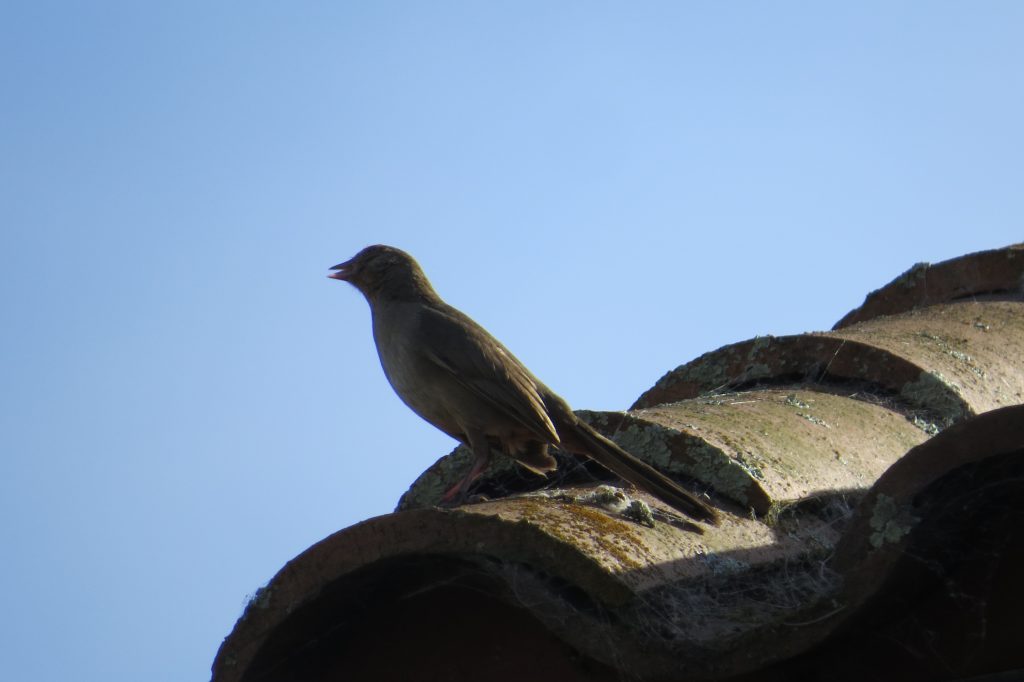
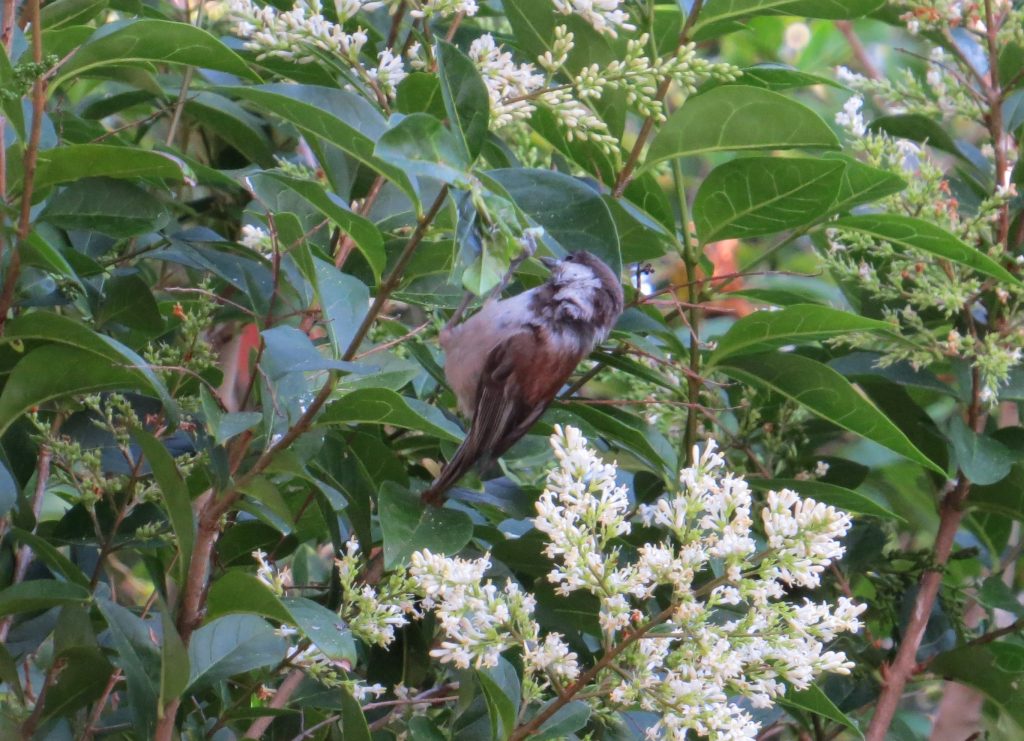
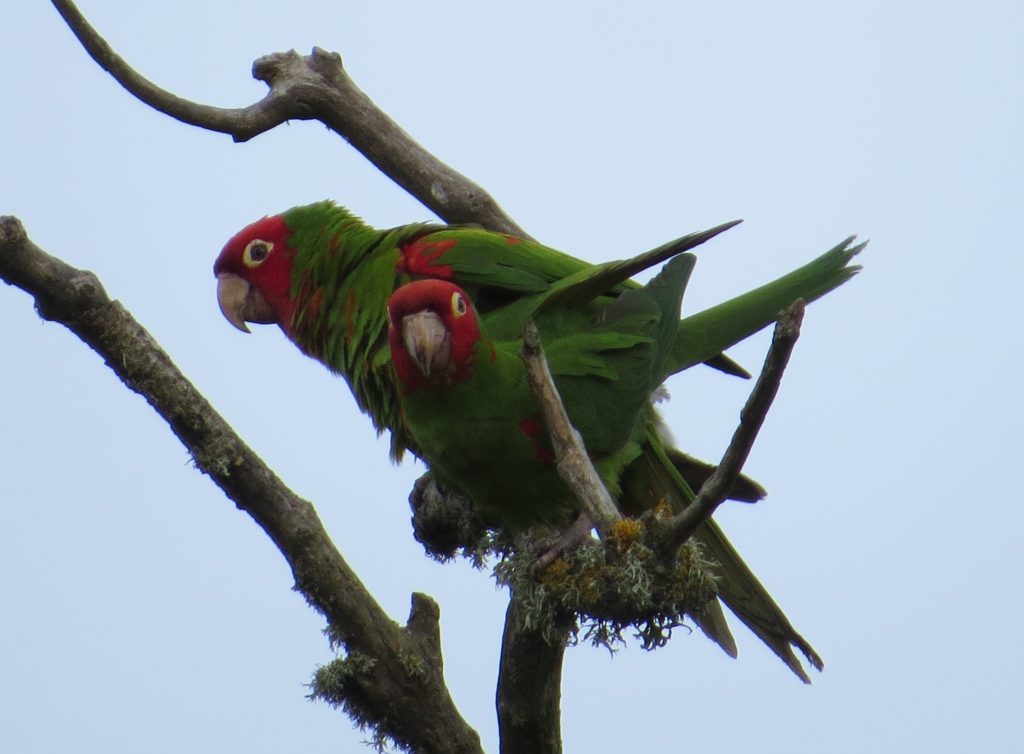
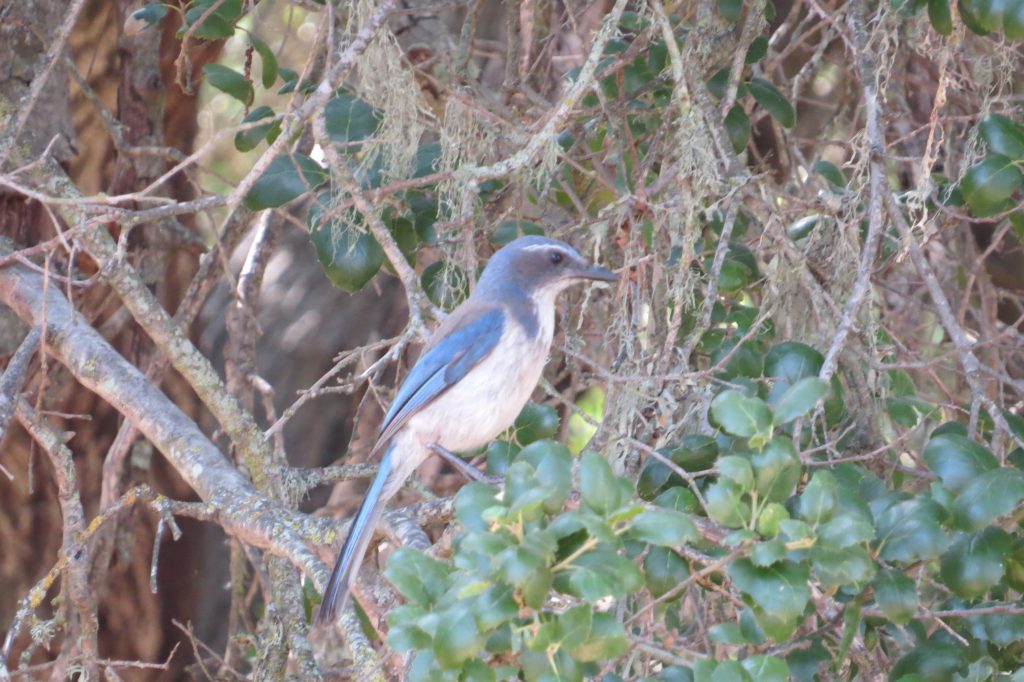
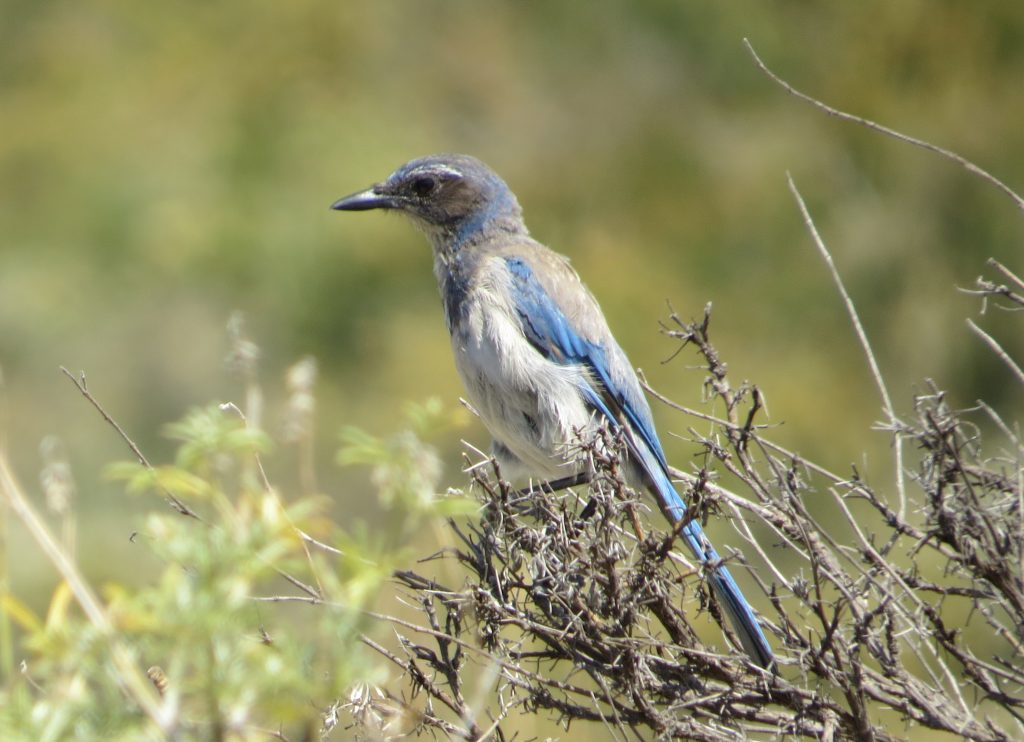
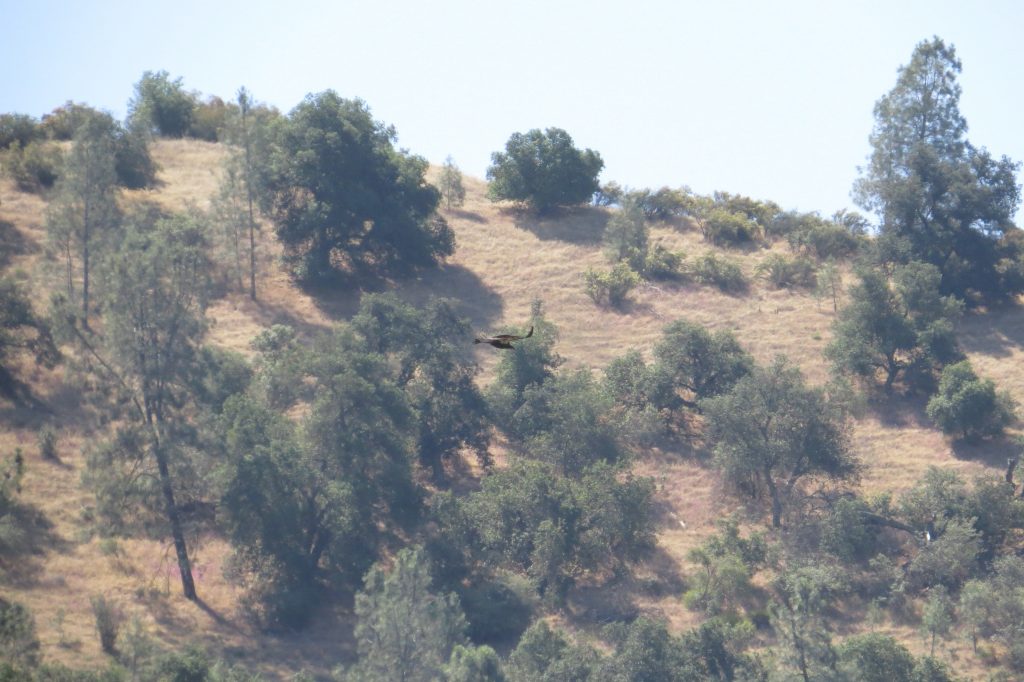
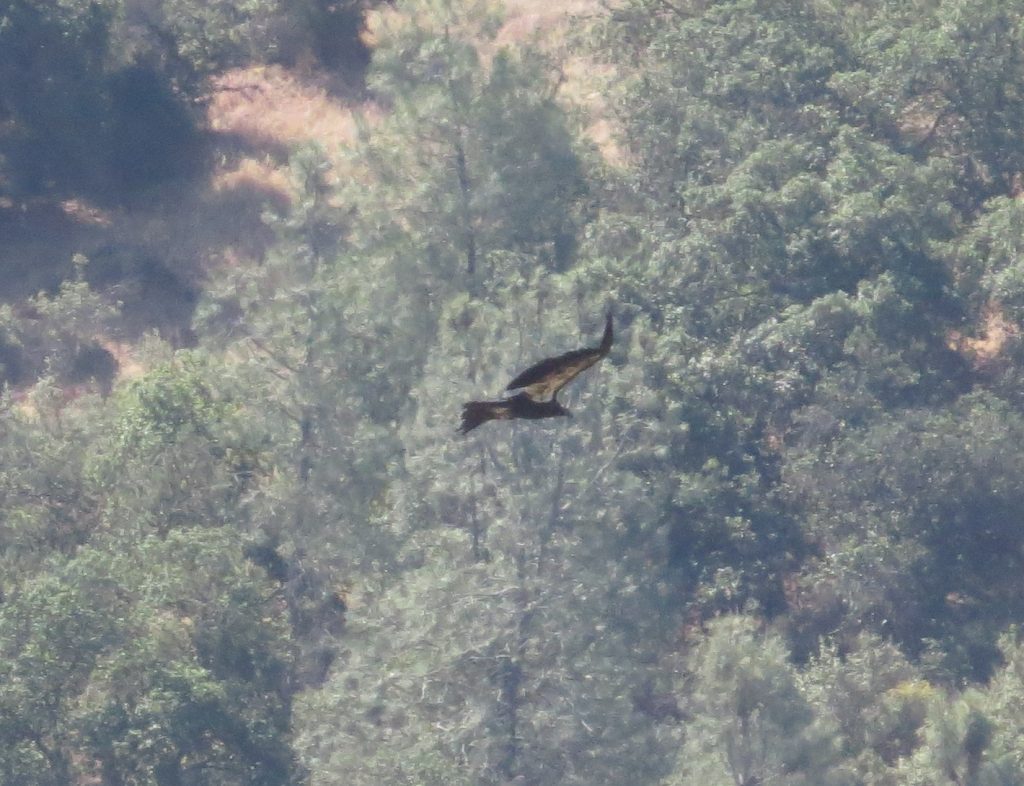
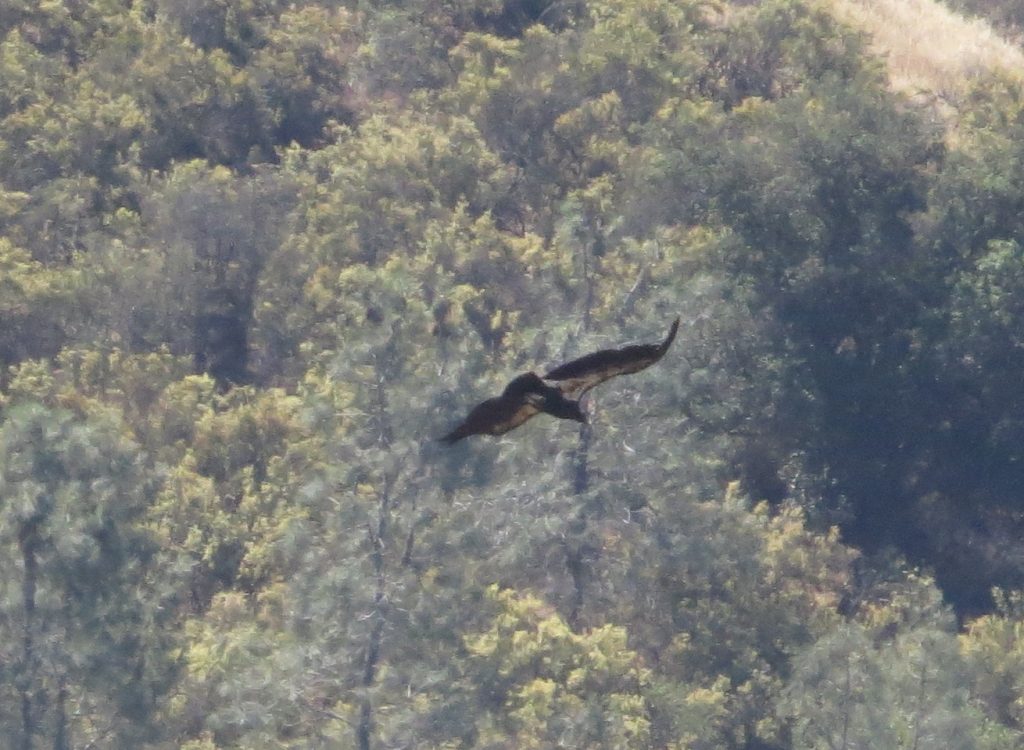 This bird was quite distant from me, but with an 8-foot wingspan, it still looked huge. The bird perched on a hillside on the opposite side of the valley, very near the campground. Even though I couldn’t see fine detail, this behemoth stood out like a sore thumb.
This bird was quite distant from me, but with an 8-foot wingspan, it still looked huge. The bird perched on a hillside on the opposite side of the valley, very near the campground. Even though I couldn’t see fine detail, this behemoth stood out like a sore thumb.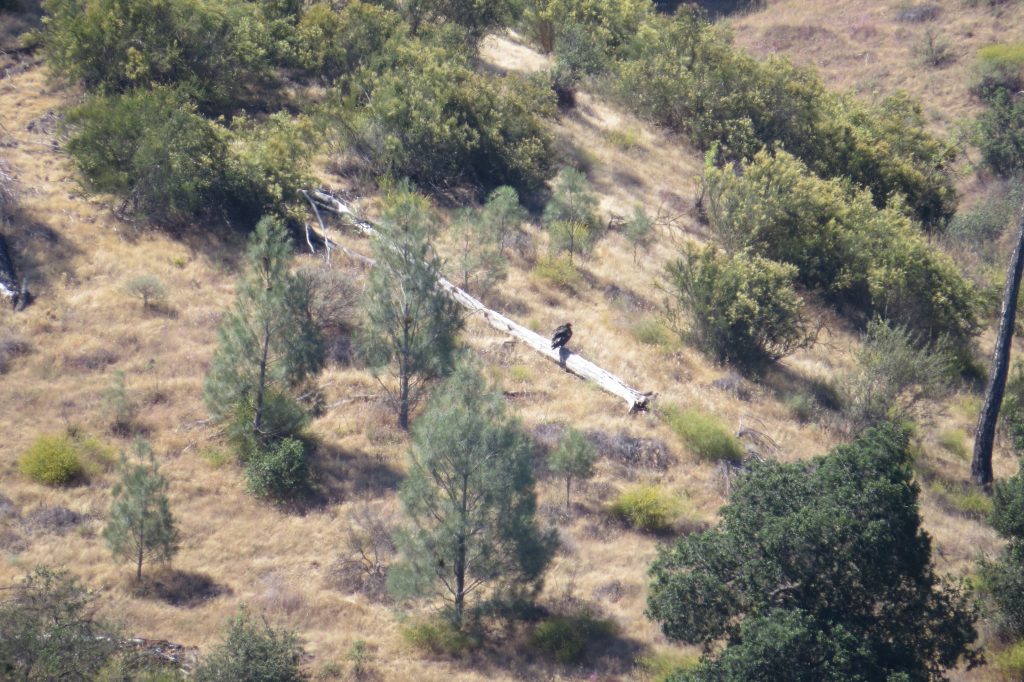
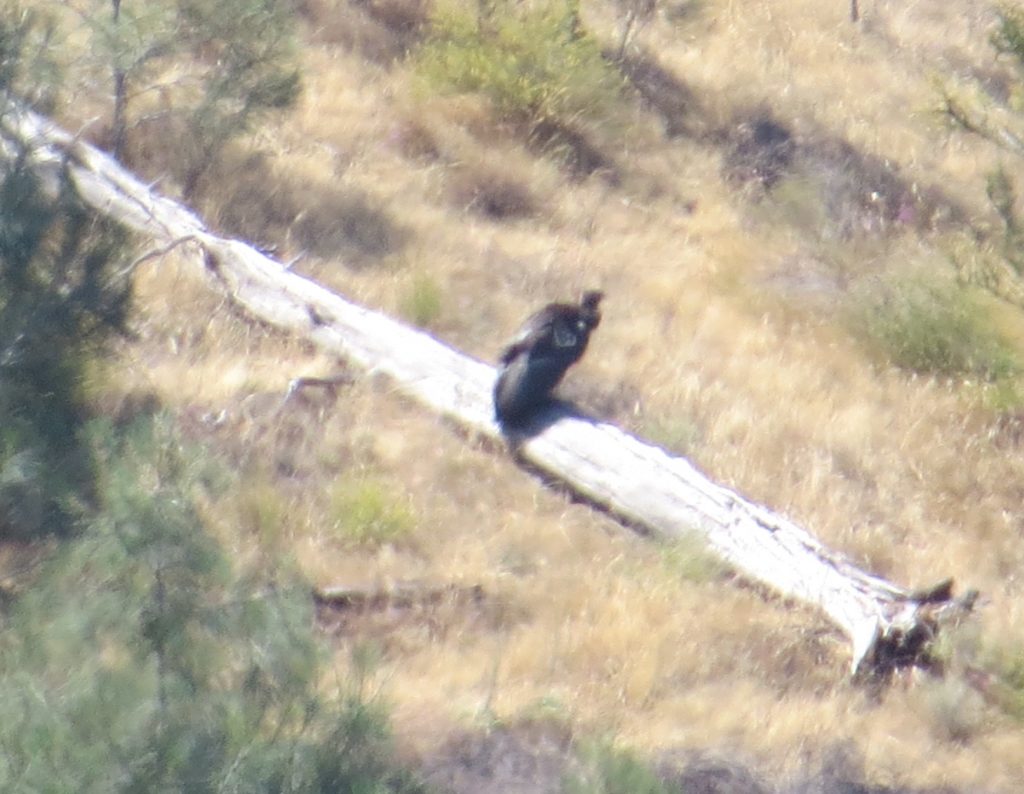 I had dipped on this bird at the Grand Canyon two years ago. All is well, because actually getting this lifer in California seemed more fitting. I would have liked better looks, but I wasn’t complaining. On the contrary, I was relieved that I didn’t have to do the longer, hotter hike with the family to get this bird.
I had dipped on this bird at the Grand Canyon two years ago. All is well, because actually getting this lifer in California seemed more fitting. I would have liked better looks, but I wasn’t complaining. On the contrary, I was relieved that I didn’t have to do the longer, hotter hike with the family to get this bird.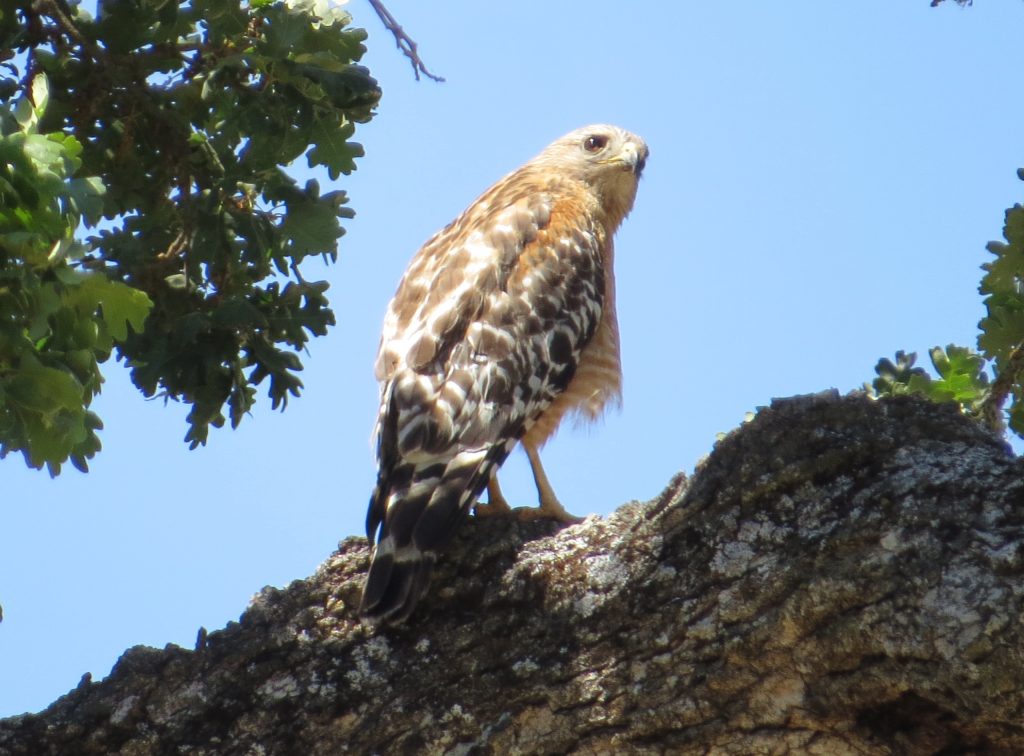
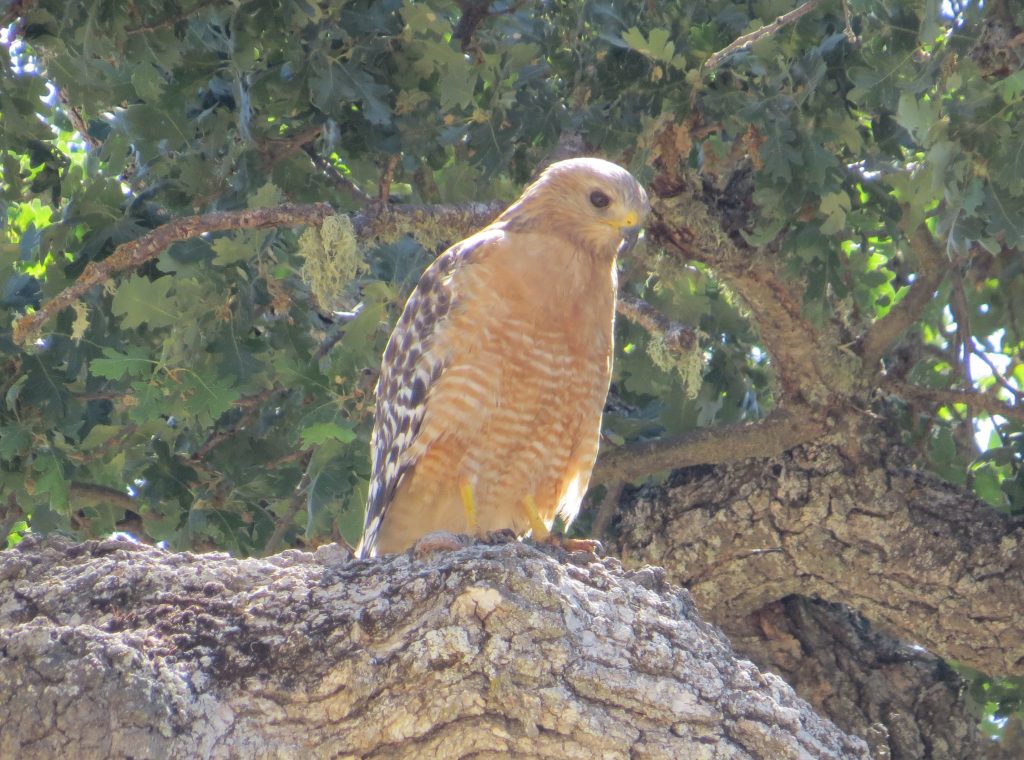
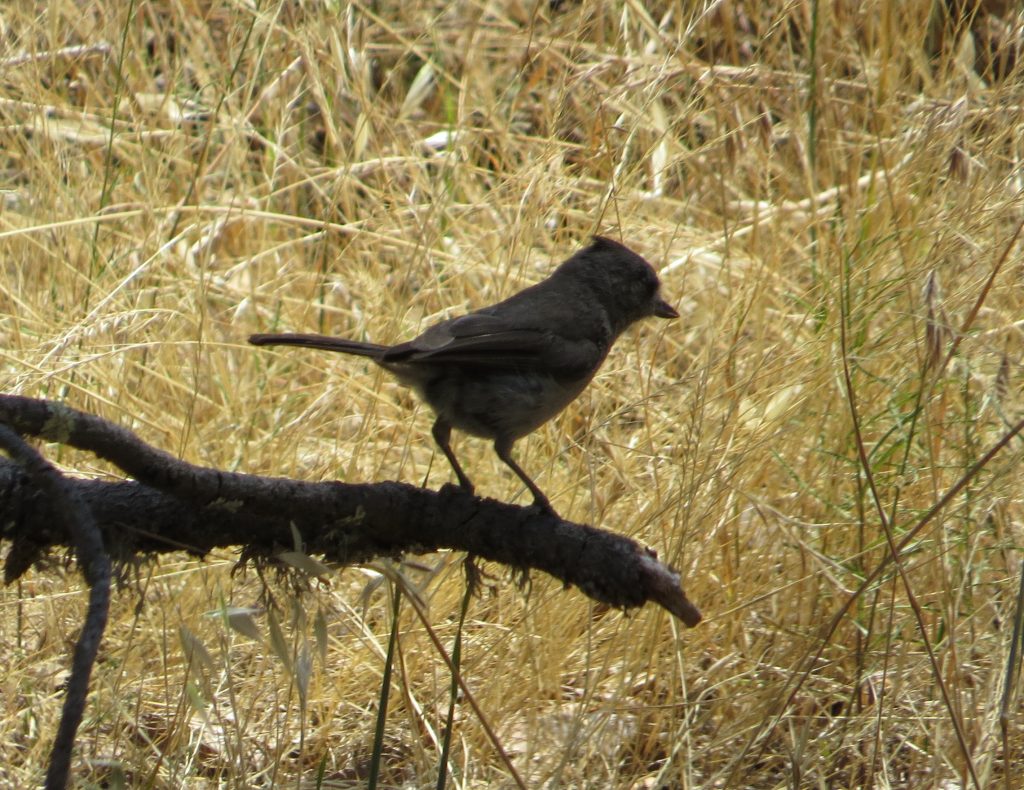
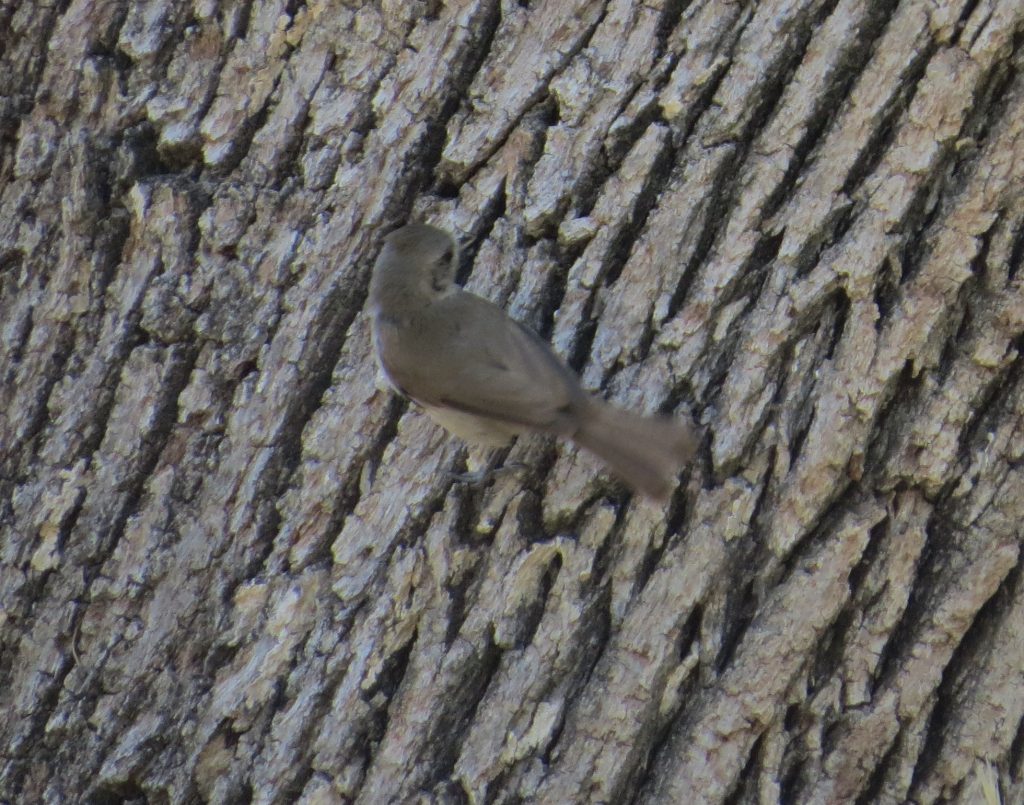 On the way out of the park, I wanted to make one more pass down that gravel road by the visitor center to look for the California Quail. Even though this bird looks extremely similar to the very common Gambel’s Quail I see in Arizona, this was still one of the species I was wanting to see the most on this trip. Unfortunately I was looking at a bad time of day for birds–close to noon. But as I walked along, I heard a cooing sound that I knew had to be the Quail. Somehow I got lucky and managed to spot it as it was hunkered down in a dense tree by the small stream of this riparian corridor.
On the way out of the park, I wanted to make one more pass down that gravel road by the visitor center to look for the California Quail. Even though this bird looks extremely similar to the very common Gambel’s Quail I see in Arizona, this was still one of the species I was wanting to see the most on this trip. Unfortunately I was looking at a bad time of day for birds–close to noon. But as I walked along, I heard a cooing sound that I knew had to be the Quail. Somehow I got lucky and managed to spot it as it was hunkered down in a dense tree by the small stream of this riparian corridor.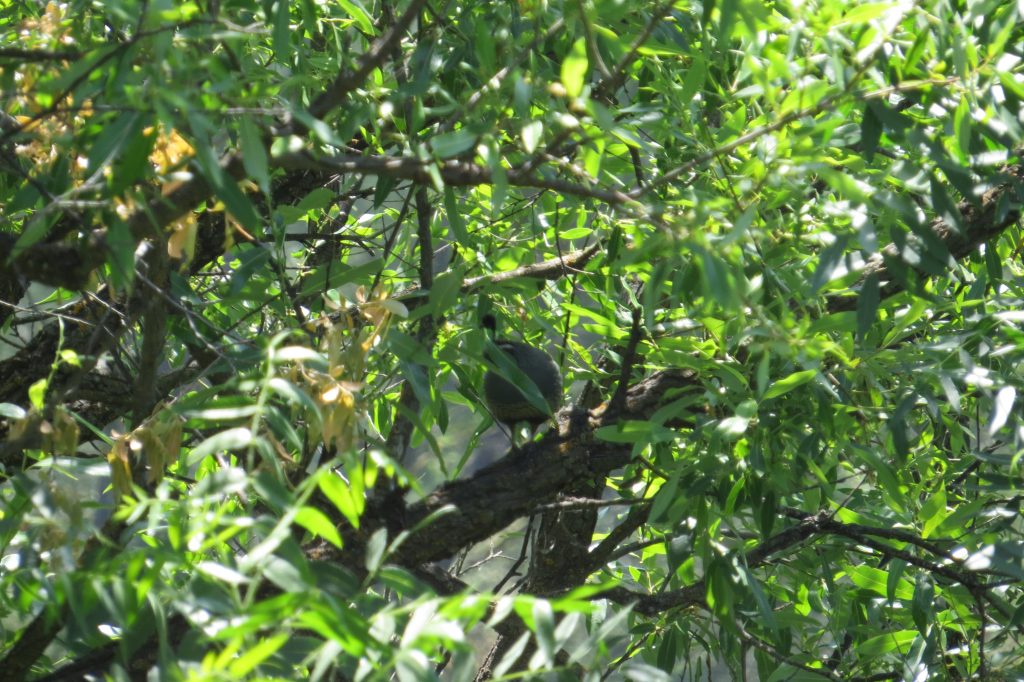
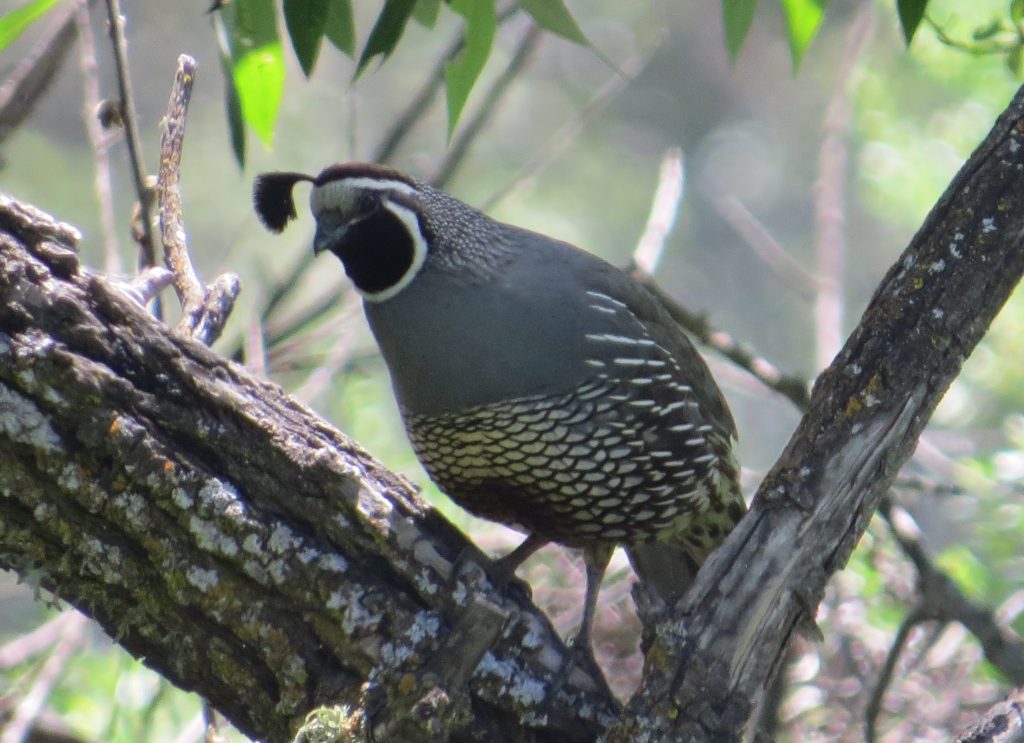
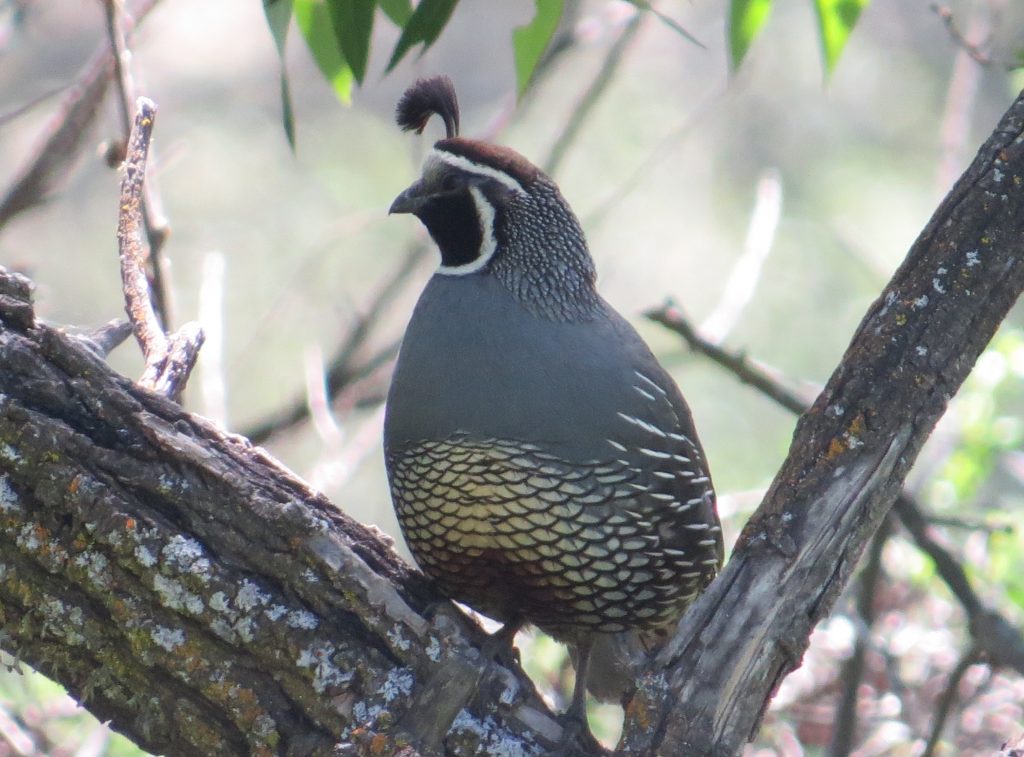 Satisfied, it was time to leave Pinnacles NP even though there were still some lifers left on the table. One of those was the Yellow-billed Magpie, but I knew to be watching for them on Highway 25 as we headed north back to San Francisco. They had been reported all along this road. Sure enough, as we passed by a farm I spotted two Magpies on a fence. I was thrilled. But with no shoulder and a car right behind me, I had to keep going down the road until I could get turned around. I finally got back to the spot about 5 minutes later, but there was no sign of the Magpies. Because they do not overlap with Black-billed Magpies in this area, they were certainly Yellow-billed. Unfortunately I never did get to see those yellow bills. It kind of took some of the air out of this being my 500th life bird. Sightings like this are one of the reasons I don’t get too hung up on what my actual 500th, 400th, etc birds are. Other reasons include heard-only observations of some species and splits/lumps of others. With that said, it was still nice to finally reach this milestone and surpass it on this trip.
Satisfied, it was time to leave Pinnacles NP even though there were still some lifers left on the table. One of those was the Yellow-billed Magpie, but I knew to be watching for them on Highway 25 as we headed north back to San Francisco. They had been reported all along this road. Sure enough, as we passed by a farm I spotted two Magpies on a fence. I was thrilled. But with no shoulder and a car right behind me, I had to keep going down the road until I could get turned around. I finally got back to the spot about 5 minutes later, but there was no sign of the Magpies. Because they do not overlap with Black-billed Magpies in this area, they were certainly Yellow-billed. Unfortunately I never did get to see those yellow bills. It kind of took some of the air out of this being my 500th life bird. Sightings like this are one of the reasons I don’t get too hung up on what my actual 500th, 400th, etc birds are. Other reasons include heard-only observations of some species and splits/lumps of others. With that said, it was still nice to finally reach this milestone and surpass it on this trip.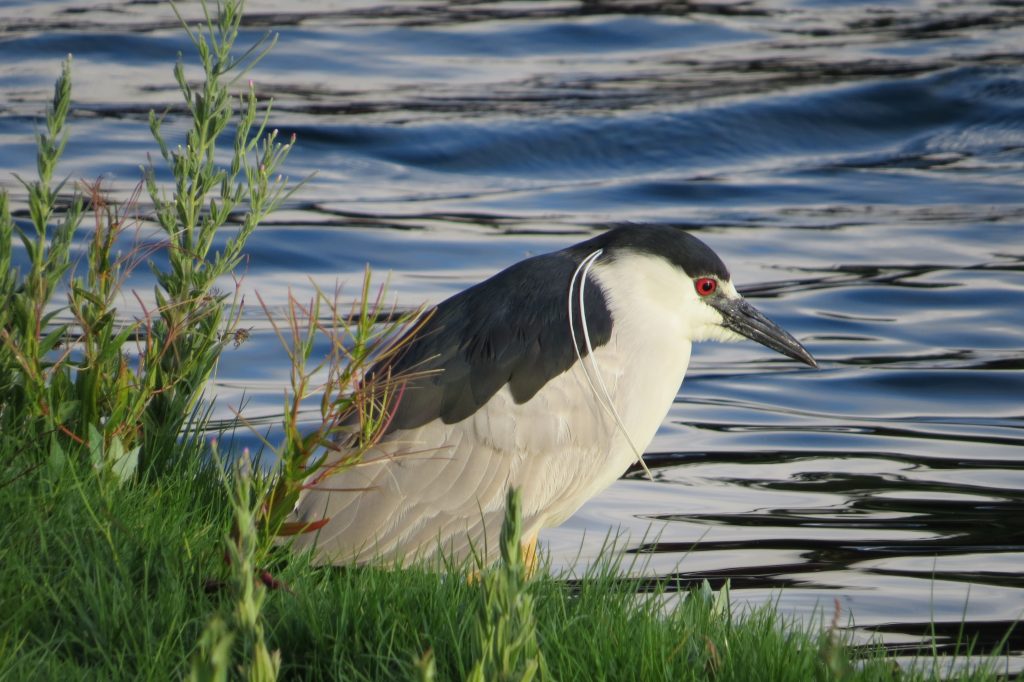 When I first spotted the White-tailed Kites, I had seen two adults, but when I arrived at the tree they were hanging out in, I found one adult and two juveniles. They didn’t move at all, and the juveniles were constantly begging for food with an annoying screaming sound. The worn-out parent just closed its eyes and hunkered down as if it was thinking Please just stop, somebody please just make it stop.
When I first spotted the White-tailed Kites, I had seen two adults, but when I arrived at the tree they were hanging out in, I found one adult and two juveniles. They didn’t move at all, and the juveniles were constantly begging for food with an annoying screaming sound. The worn-out parent just closed its eyes and hunkered down as if it was thinking Please just stop, somebody please just make it stop.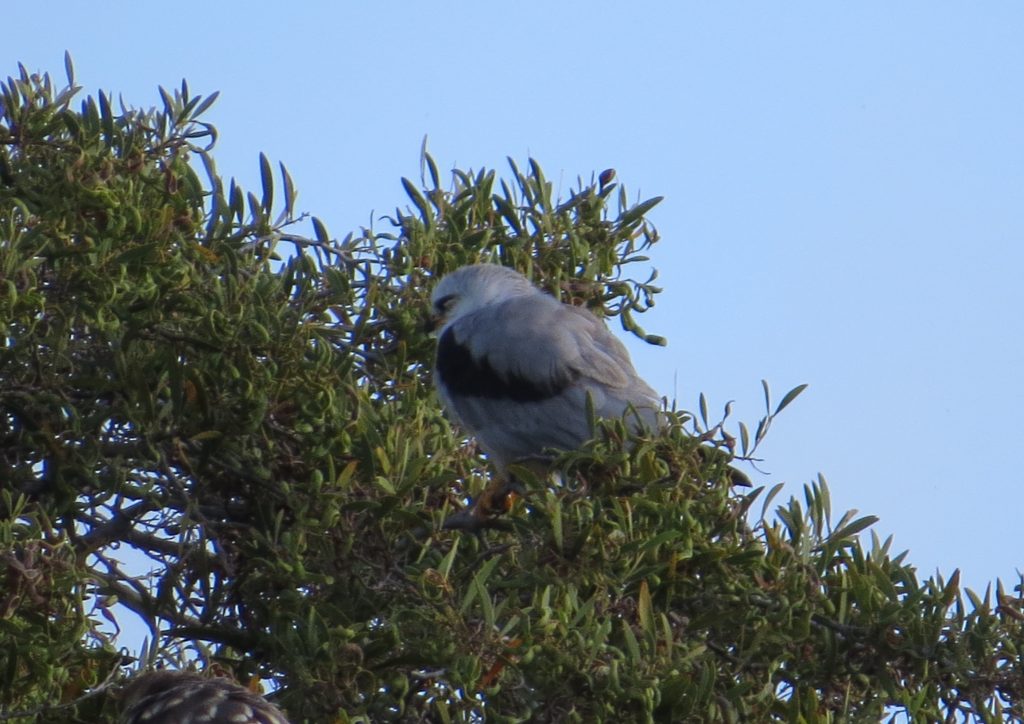
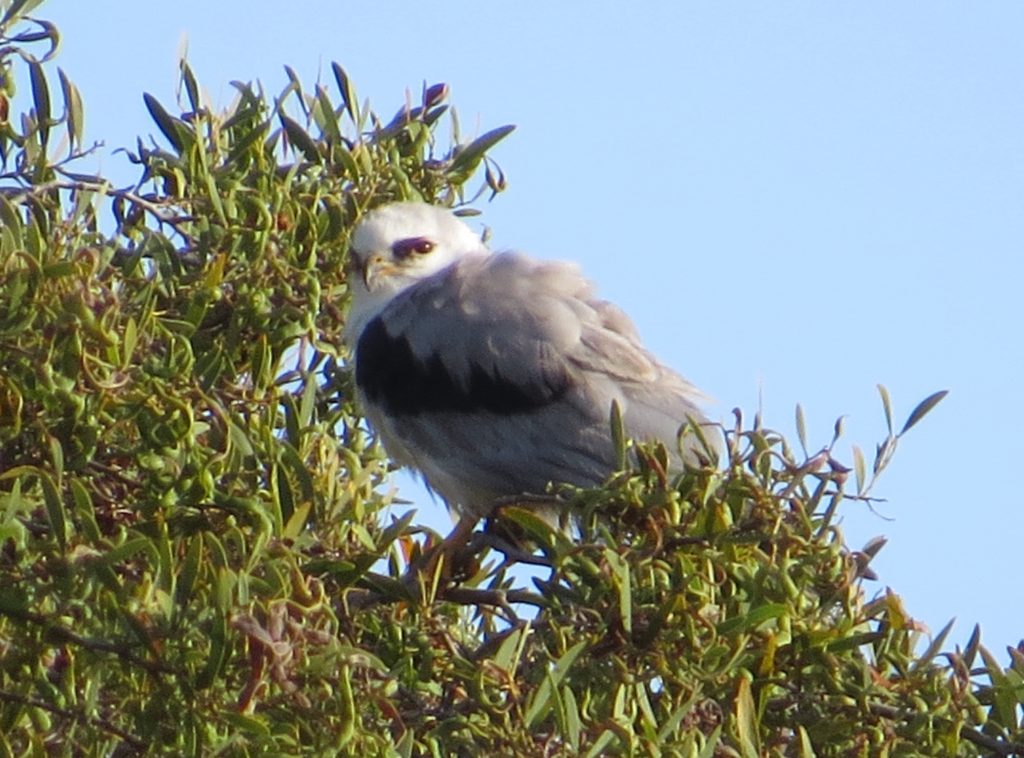
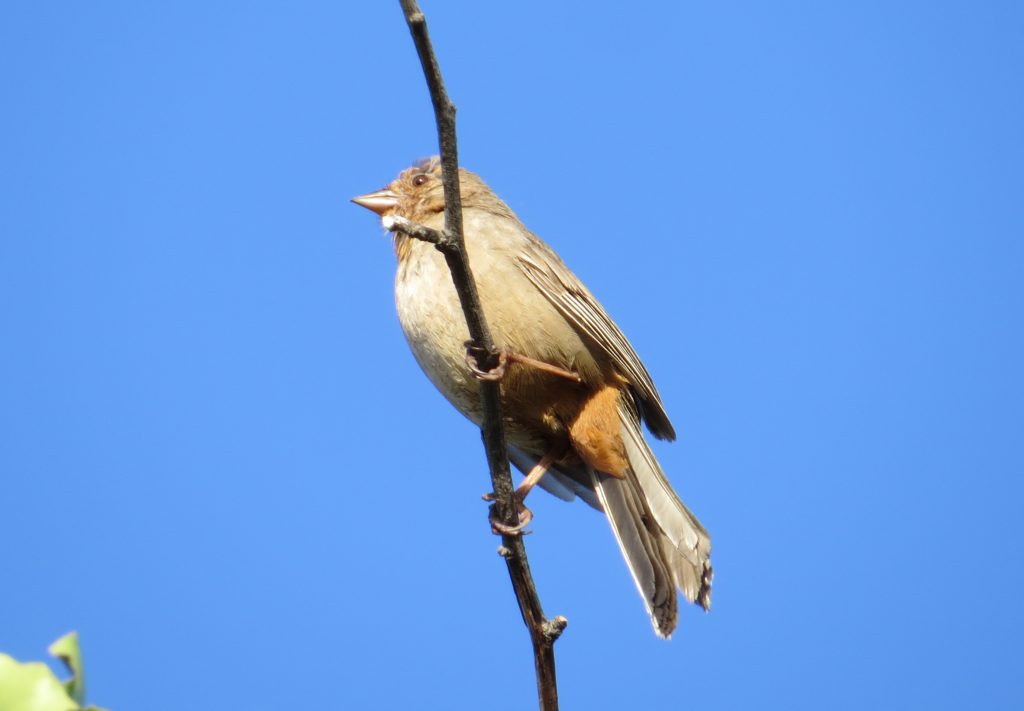
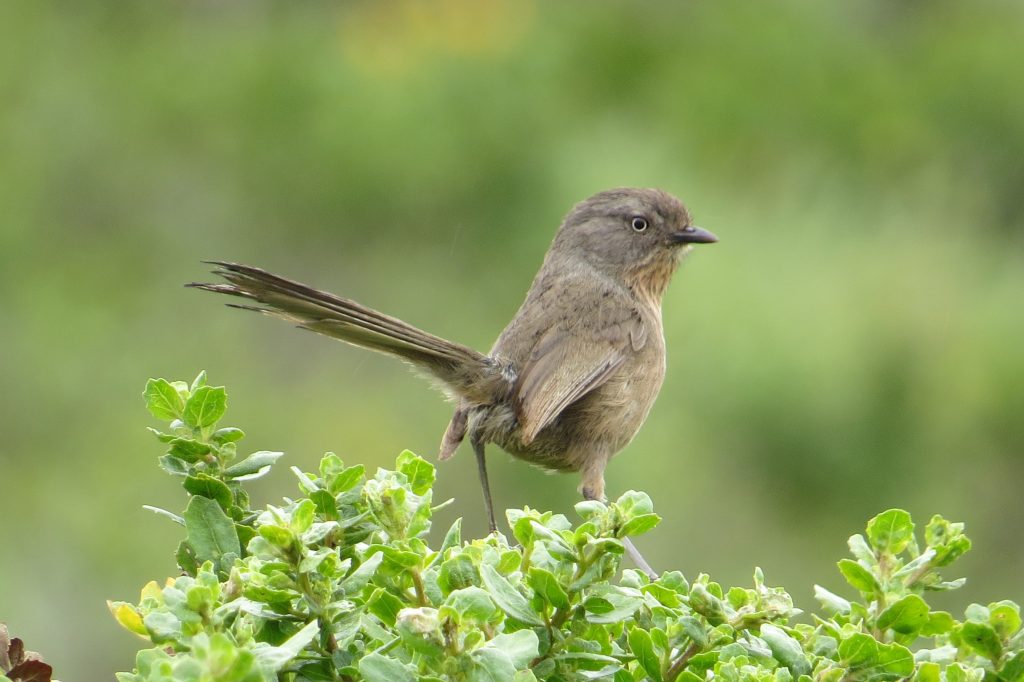
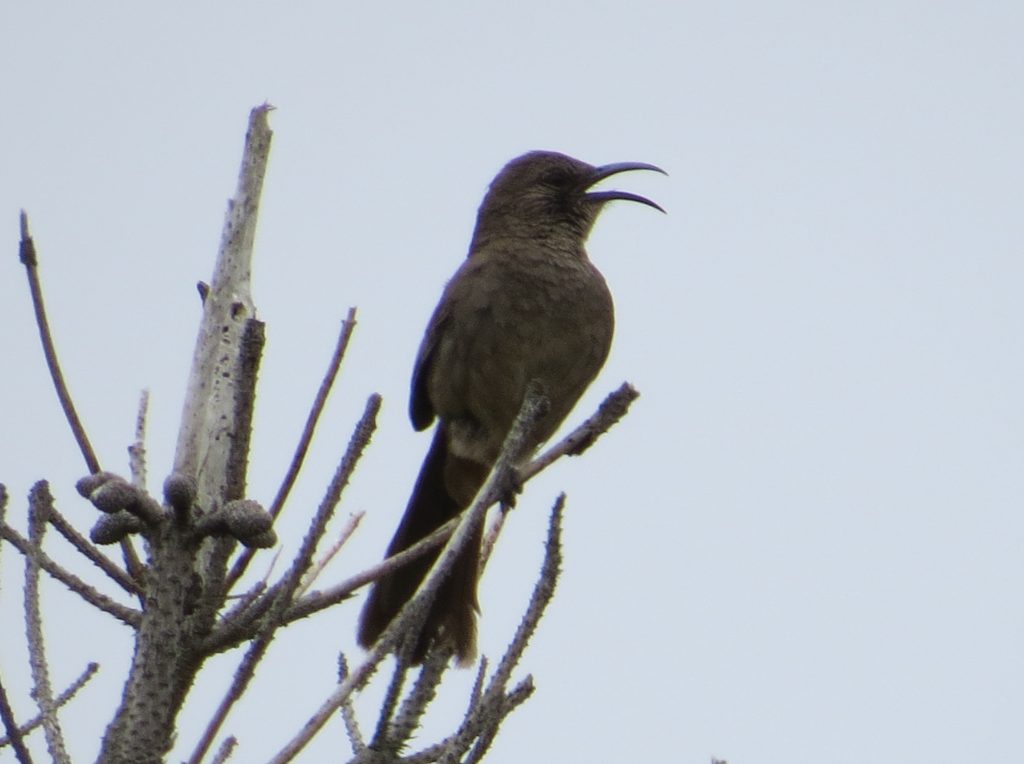
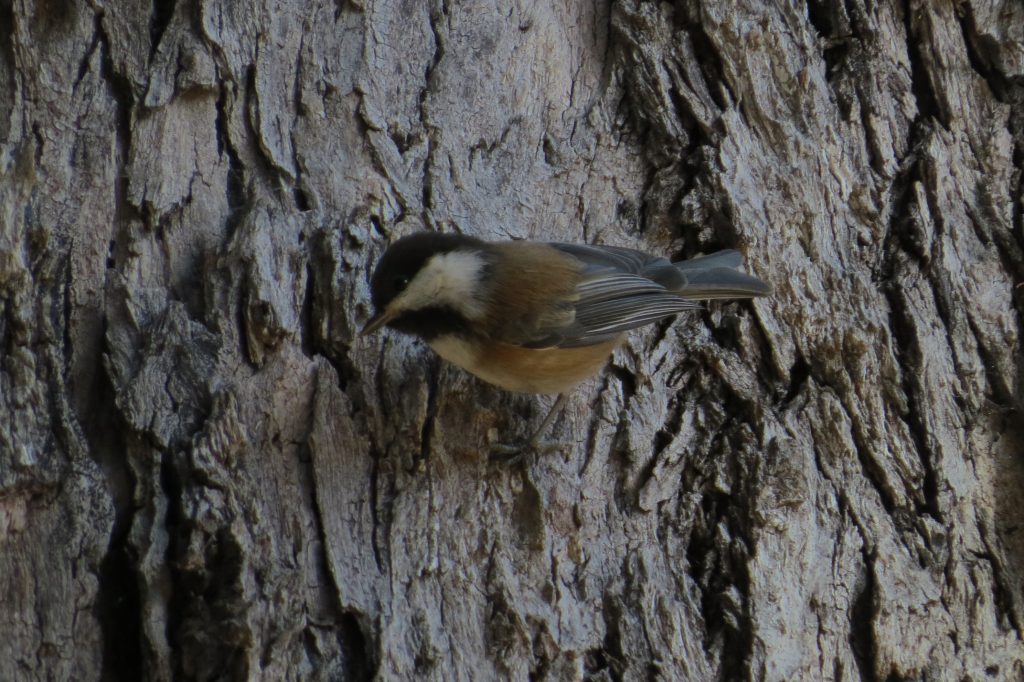
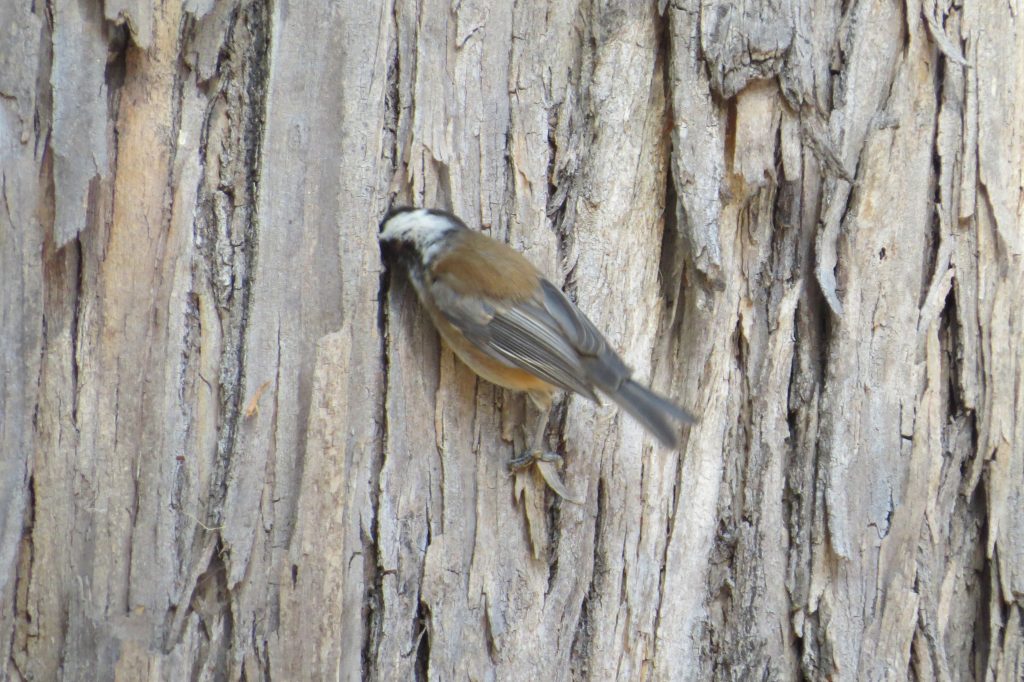
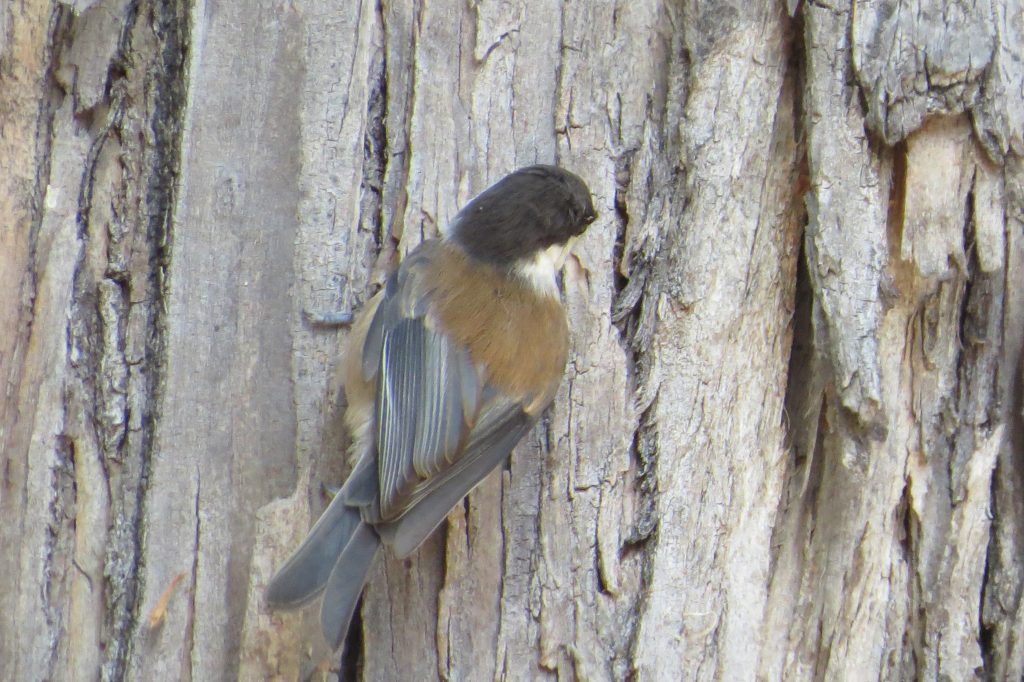
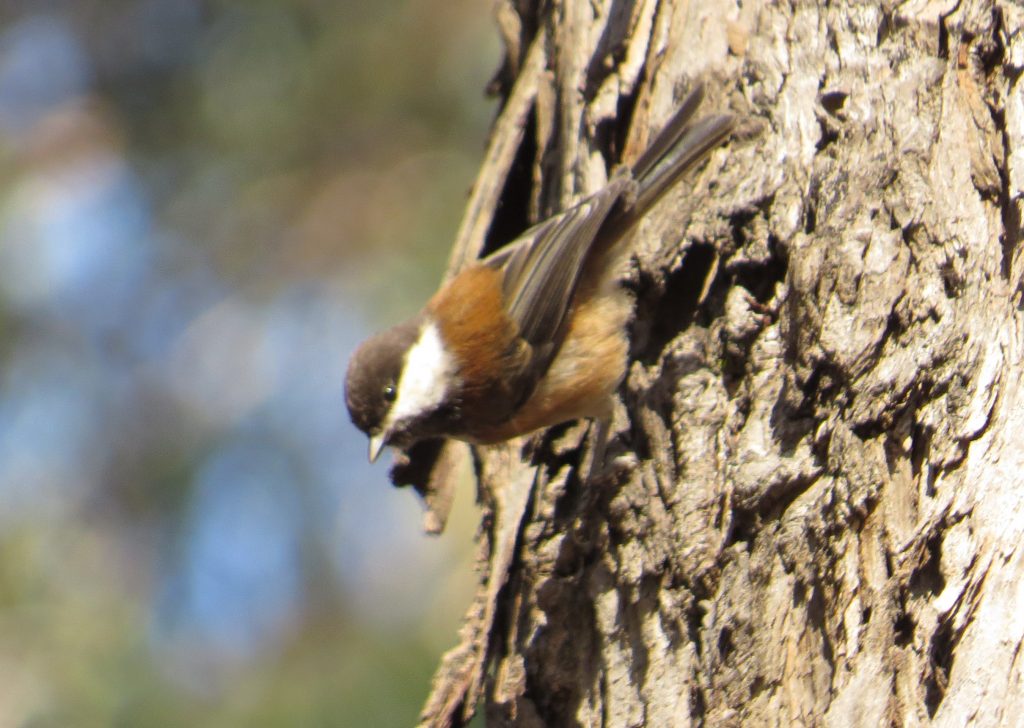 And with that, I had to close out my California birding for this time. I got a great taste of California and picked up most of the endemics and other range-limited birds. I am definitely looking forward to going back someday.
And with that, I had to close out my California birding for this time. I got a great taste of California and picked up most of the endemics and other range-limited birds. I am definitely looking forward to going back someday.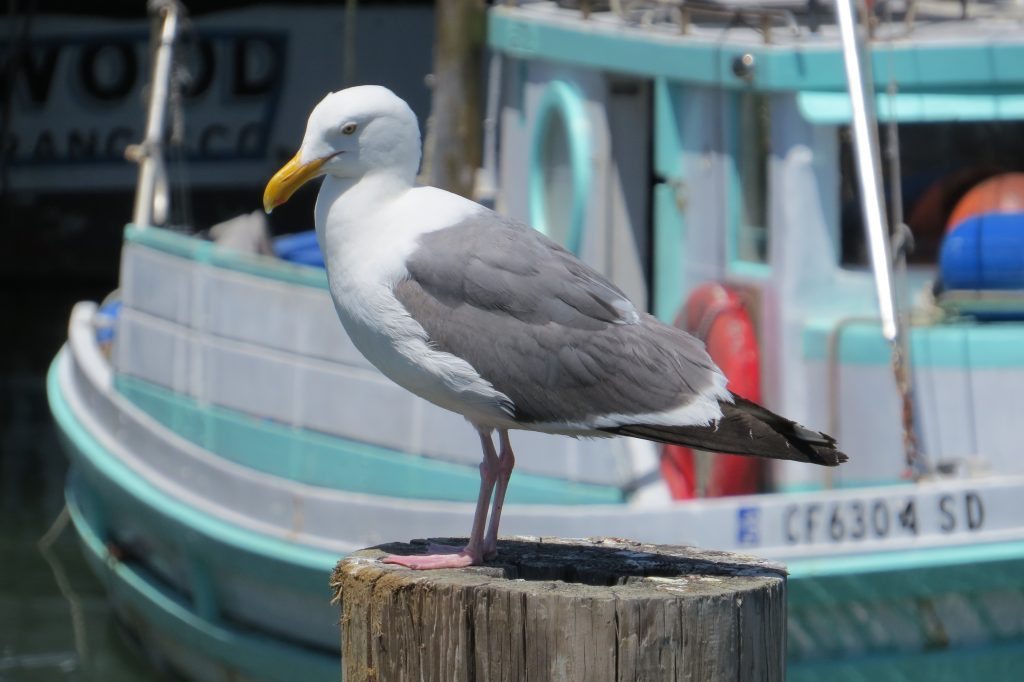
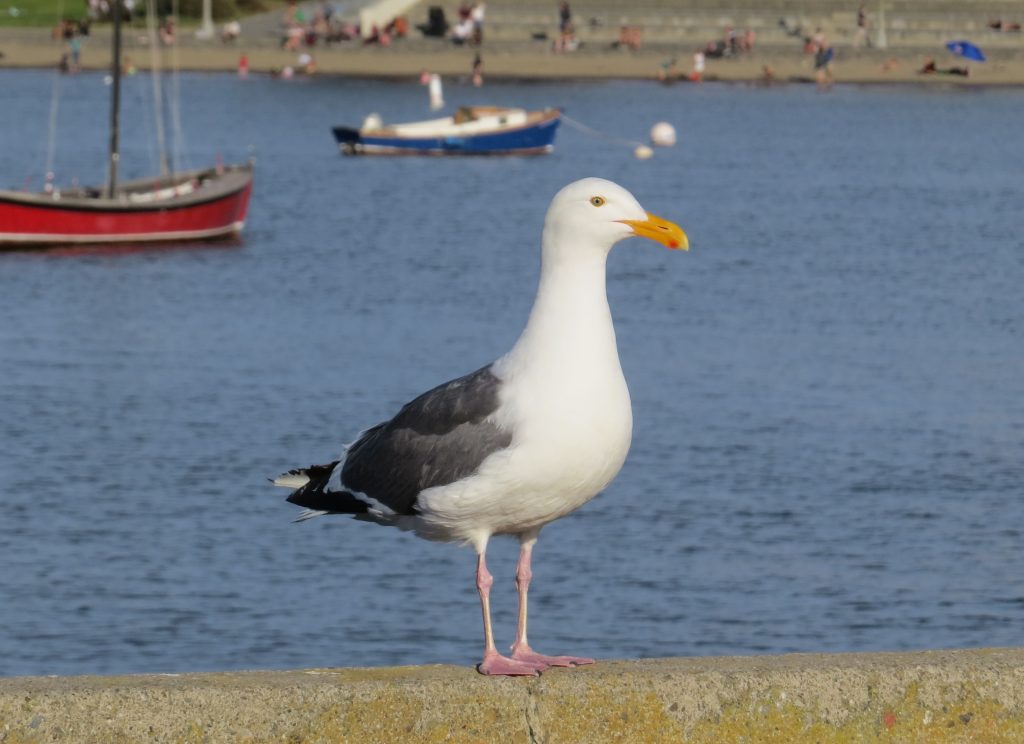 As a newbie Cali birder, I eagerly scanned the Bay when we first arrived at the waterfront, looking for absolutely anything new and different. Though not a new bird, I was pleasantly surprised to see a Red-throated Loon loafing about San Francisco Aquatic Park.
As a newbie Cali birder, I eagerly scanned the Bay when we first arrived at the waterfront, looking for absolutely anything new and different. Though not a new bird, I was pleasantly surprised to see a Red-throated Loon loafing about San Francisco Aquatic Park.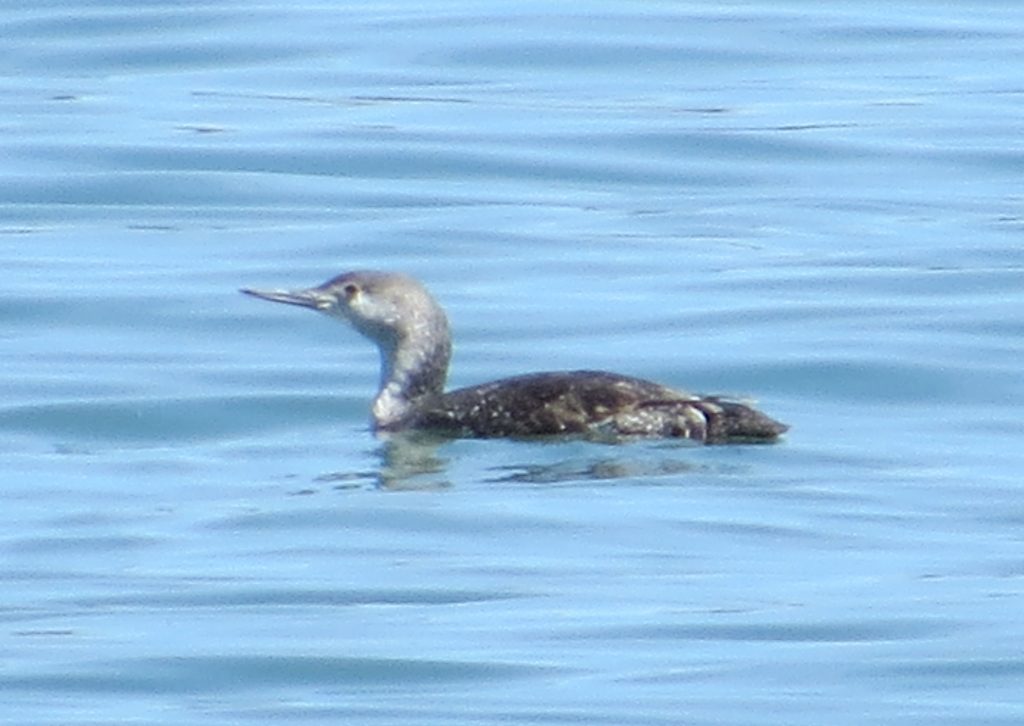
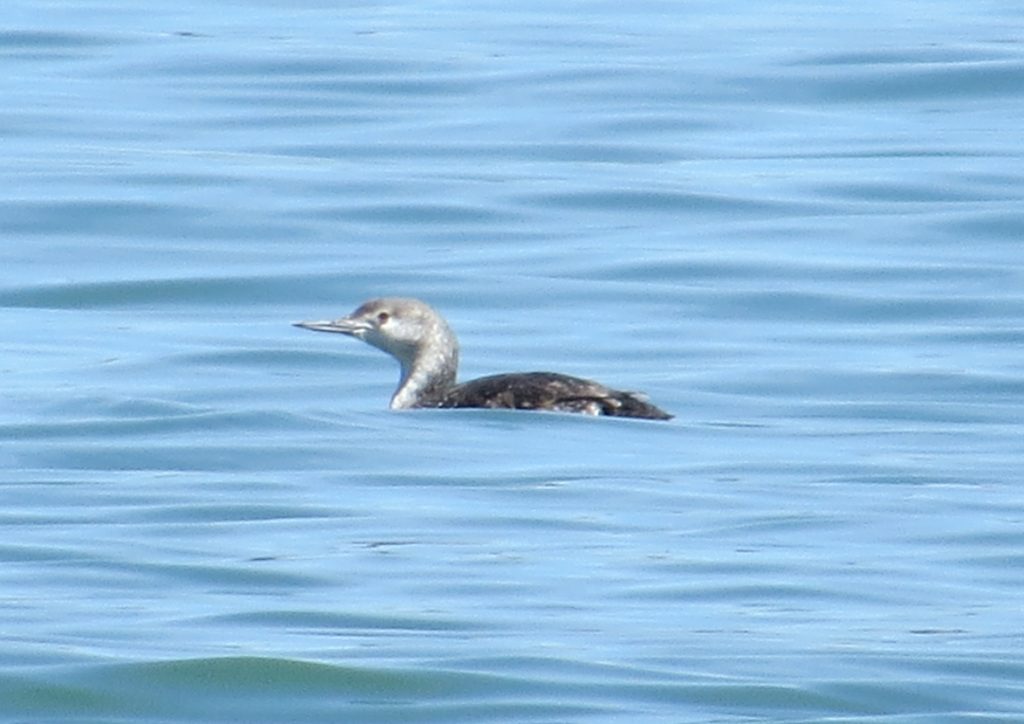 I was equally surprised to pick up this long overdue Clark’s Grebe lifer.
I was equally surprised to pick up this long overdue Clark’s Grebe lifer.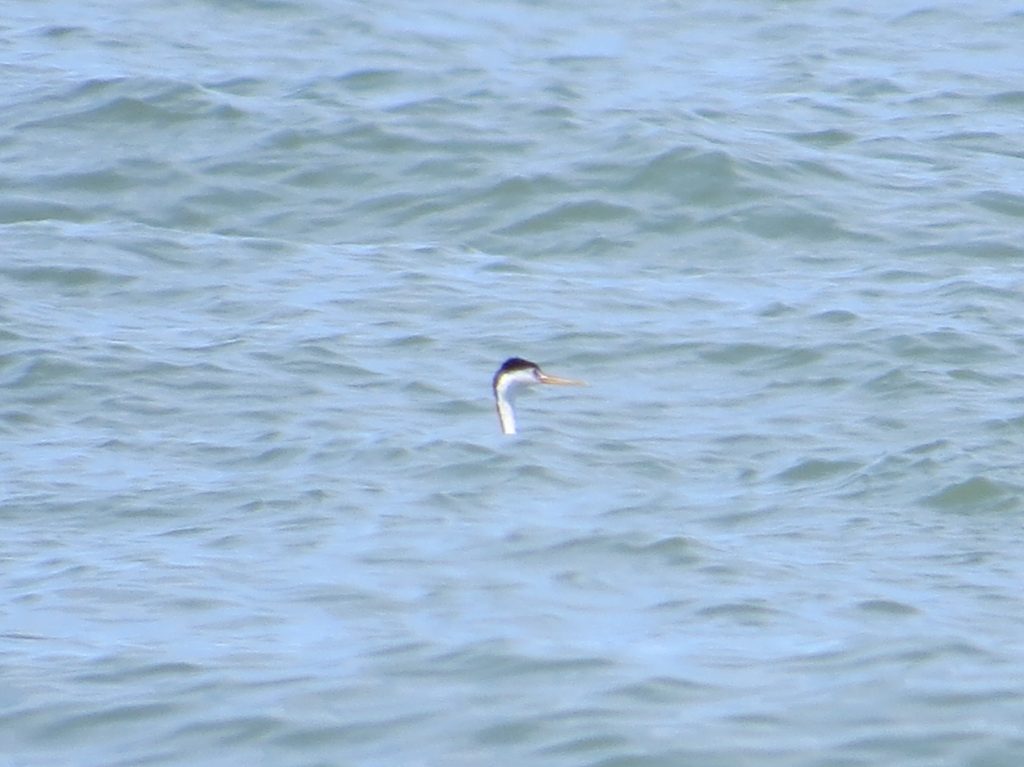 The next day of our trip was Alcatraz day–a bucket-list item for Melissa. I was excited to experience the Rock myself, but the ferry ride over to the island would be my first “pelagic” of sorts so my mind was more on the potential lifers. Taking Steve Gardner’s advice, I was sure to grab a spot at the front of the boat to be in position to see anything that might be moving out of the way of the boat. We had barely left the dock when the strategy already paid off with some handsome Pigeon Guillemot lifers. This was an expected species that was still exciting to see nonetheless.
The next day of our trip was Alcatraz day–a bucket-list item for Melissa. I was excited to experience the Rock myself, but the ferry ride over to the island would be my first “pelagic” of sorts so my mind was more on the potential lifers. Taking Steve Gardner’s advice, I was sure to grab a spot at the front of the boat to be in position to see anything that might be moving out of the way of the boat. We had barely left the dock when the strategy already paid off with some handsome Pigeon Guillemot lifers. This was an expected species that was still exciting to see nonetheless.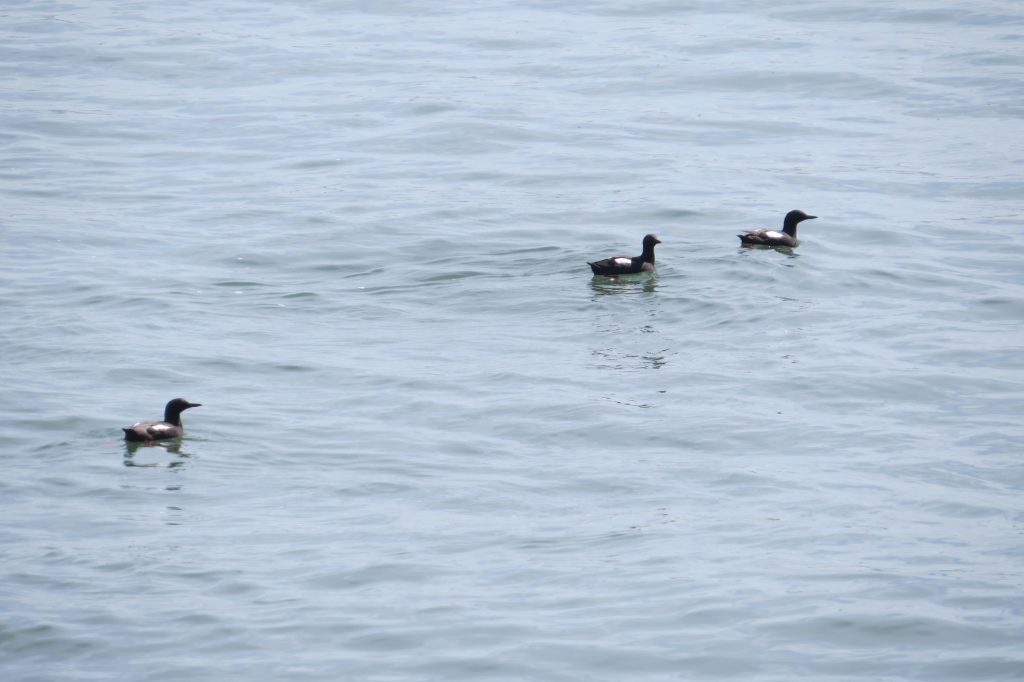
 The Rock looms large, though, and commands your attention itself regardless of what birds may be on or near it.
The Rock looms large, though, and commands your attention itself regardless of what birds may be on or near it.
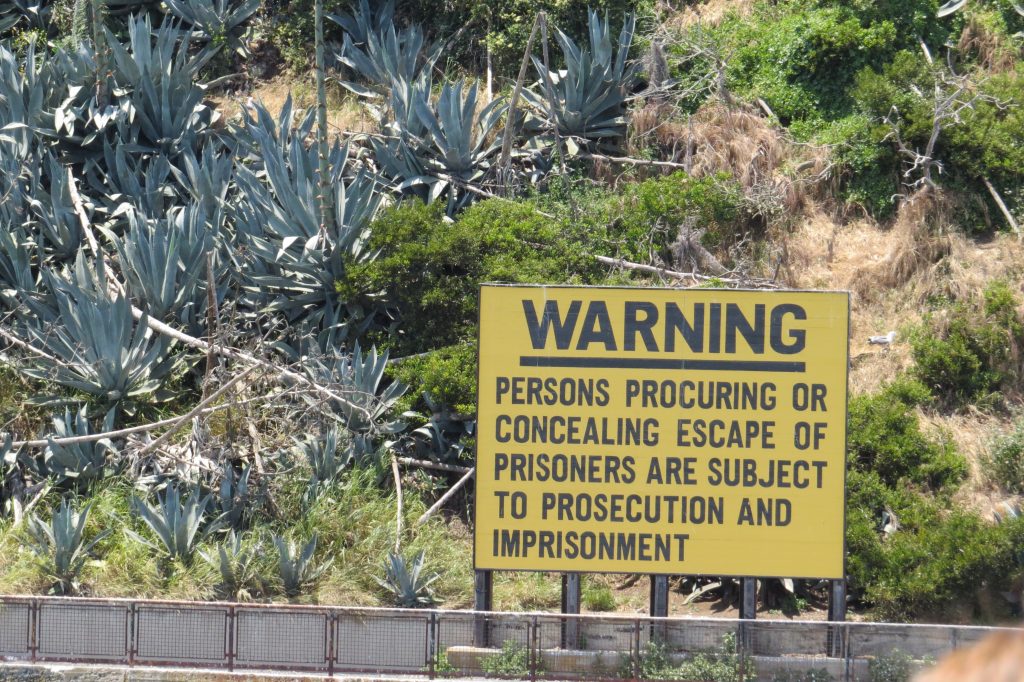 As we waited to disembark, Pigeon Guillemots served as a bookend bird for our short boat ride, giving better looks this time at least.
As we waited to disembark, Pigeon Guillemots served as a bookend bird for our short boat ride, giving better looks this time at least.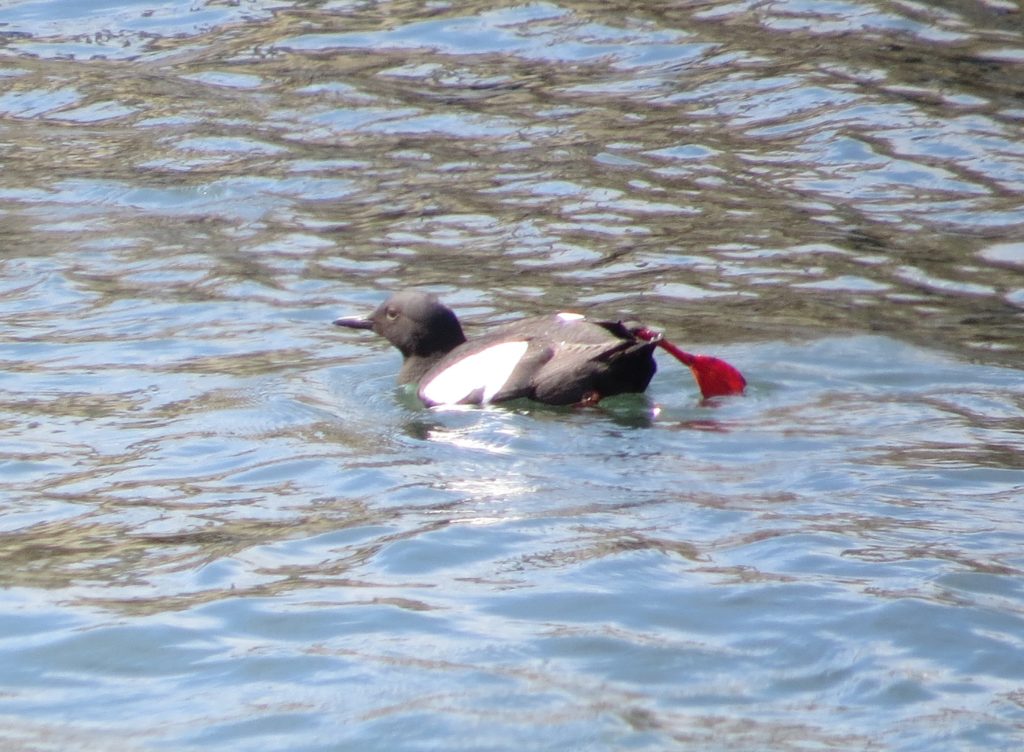
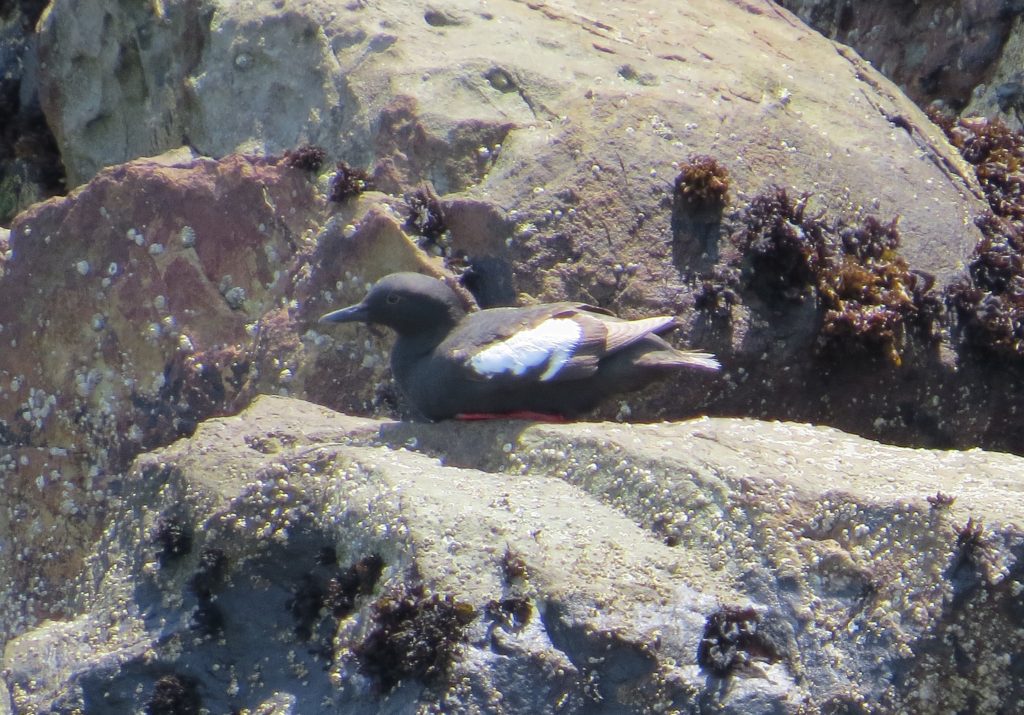 In addition to its fame as a federal prison and an Army post, Alcatraz is an important bird area, as there are huge colonies of nesting birds there. Western Gulls are one of the main breeders on the island. Their nests were absolutely everywhere on the island. Mommas and their chicks were a common sight on the steep hillsides as we hiked the switchback road up to the famed cell house for an audio tour (I highly recommend this tour BTW).
In addition to its fame as a federal prison and an Army post, Alcatraz is an important bird area, as there are huge colonies of nesting birds there. Western Gulls are one of the main breeders on the island. Their nests were absolutely everywhere on the island. Mommas and their chicks were a common sight on the steep hillsides as we hiked the switchback road up to the famed cell house for an audio tour (I highly recommend this tour BTW).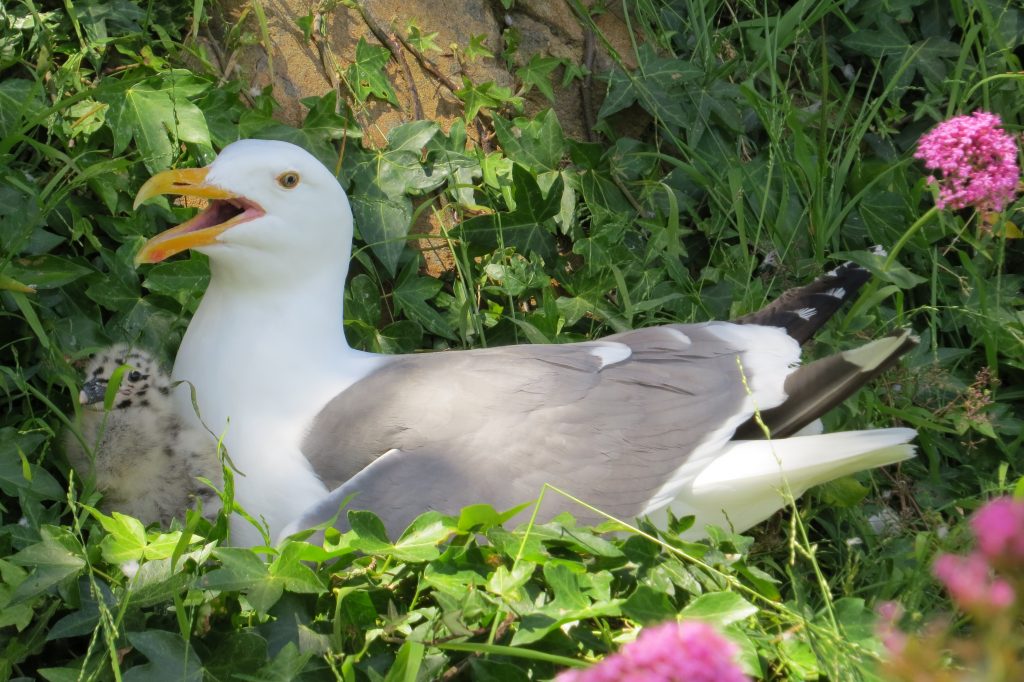 We stopped in an air-conditioned Civil War era building to get some relief from the heat and the climb and to learn something about the island from an informative Discovery Channel video shown on several large screens in the catacombs of this building. One thing mentioned in the video was how Alcatraz is an important bird area, and the video hilariously portrays a ranger eagerly looking over a rail to show some excited tourists a Canada Goose on the steep slope below. Life imitates art as they say, and as we continued our hike up to the top after the movie, Evan looked over a rail and said, “Hey, look! A goose!” We all had a good laugh since he truly did spot a Canada Goose. And since it was my California CANG, I was mildly excited.
We stopped in an air-conditioned Civil War era building to get some relief from the heat and the climb and to learn something about the island from an informative Discovery Channel video shown on several large screens in the catacombs of this building. One thing mentioned in the video was how Alcatraz is an important bird area, and the video hilariously portrays a ranger eagerly looking over a rail to show some excited tourists a Canada Goose on the steep slope below. Life imitates art as they say, and as we continued our hike up to the top after the movie, Evan looked over a rail and said, “Hey, look! A goose!” We all had a good laugh since he truly did spot a Canada Goose. And since it was my California CANG, I was mildly excited.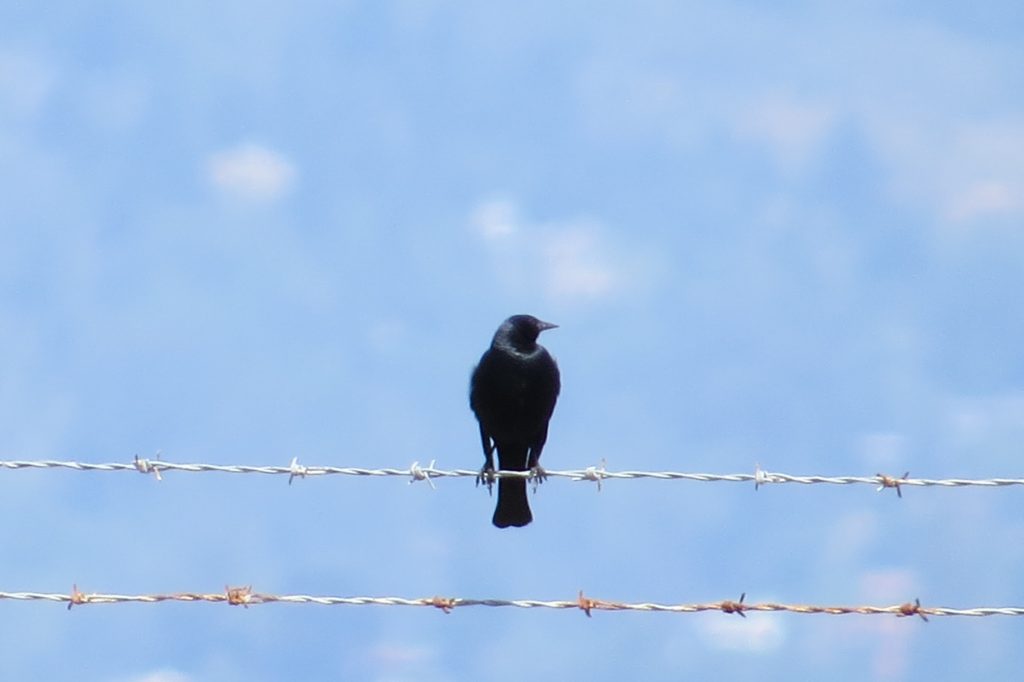

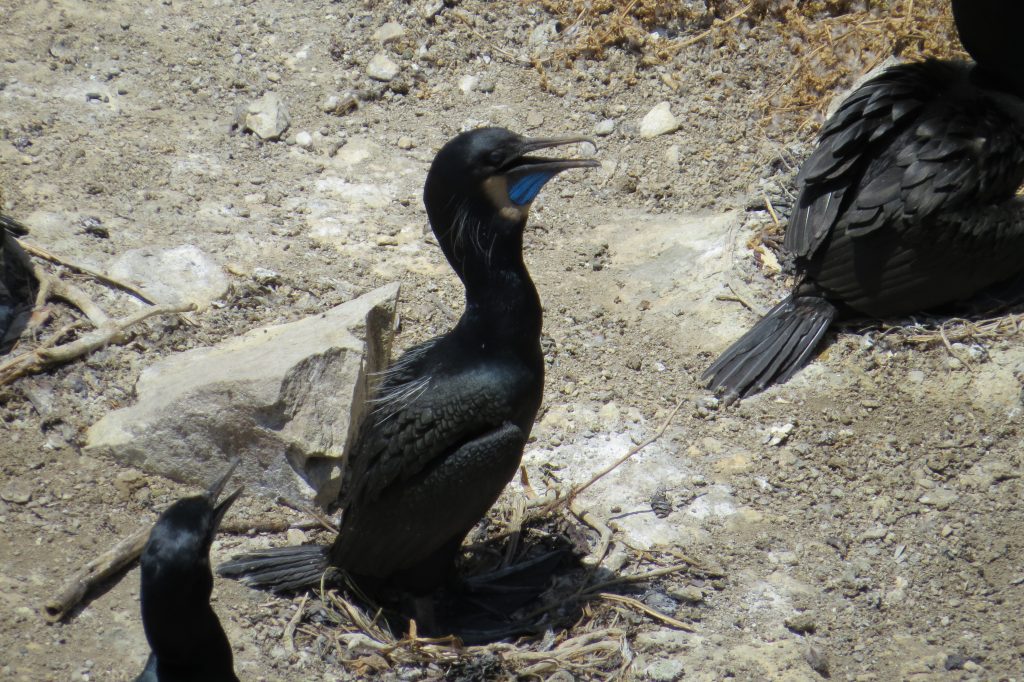 A Pelagic Cormorant or two had been reported among the Brandt’s, but trying to find one was a needle-in-the-haystack exercise, something that was tough to do in the company of non-birders.
A Pelagic Cormorant or two had been reported among the Brandt’s, but trying to find one was a needle-in-the-haystack exercise, something that was tough to do in the company of non-birders.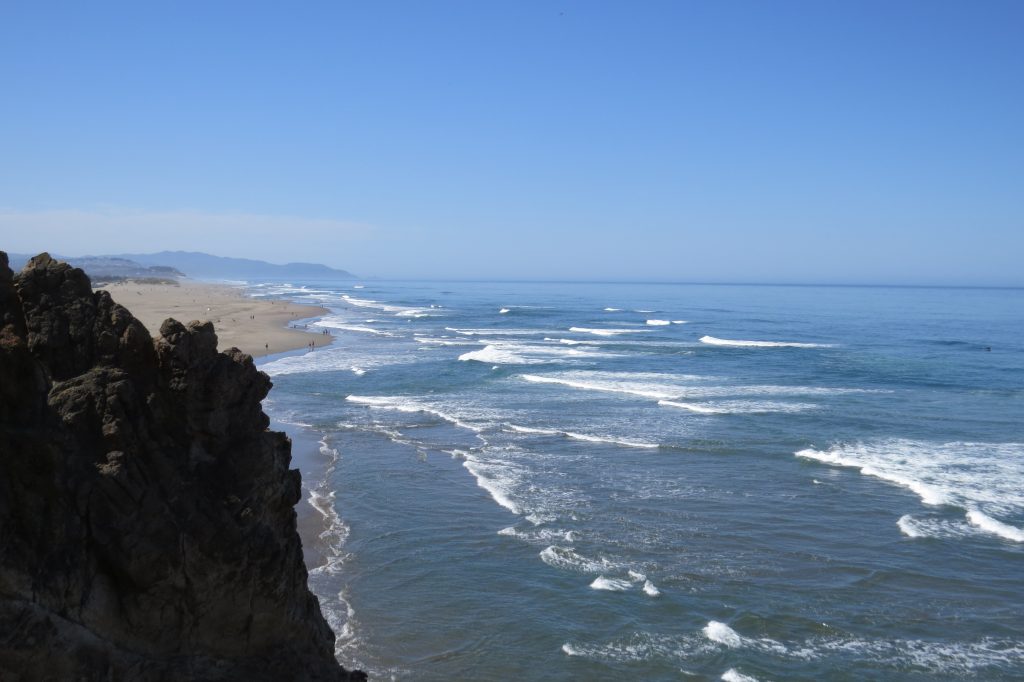 Melissa and the kids ventured down to the beach while I hung out by the famed Cliff House, looking for a pair of reported Black Oystercatchers to no avail. Eventually I joined the family at the beach and looked for seashells with the kids and a Common Murre lifer for myself. I was not successful with the latter. After spending sufficient time at the beach, we stopped for lunch at the Lands End Lookout visitor center. The Oystercatchers were bugging me. I knew this was probably my only chance on the trip for this species. I had to take one more stab at it. While the fam poked around the gift shop, I descened the stairs down to the Suttro Baths to see if I could find these odd, conspicuous birds. Going down to the Baths did allow me to see my lifer Heerman’s Gulls up close.
Melissa and the kids ventured down to the beach while I hung out by the famed Cliff House, looking for a pair of reported Black Oystercatchers to no avail. Eventually I joined the family at the beach and looked for seashells with the kids and a Common Murre lifer for myself. I was not successful with the latter. After spending sufficient time at the beach, we stopped for lunch at the Lands End Lookout visitor center. The Oystercatchers were bugging me. I knew this was probably my only chance on the trip for this species. I had to take one more stab at it. While the fam poked around the gift shop, I descened the stairs down to the Suttro Baths to see if I could find these odd, conspicuous birds. Going down to the Baths did allow me to see my lifer Heerman’s Gulls up close.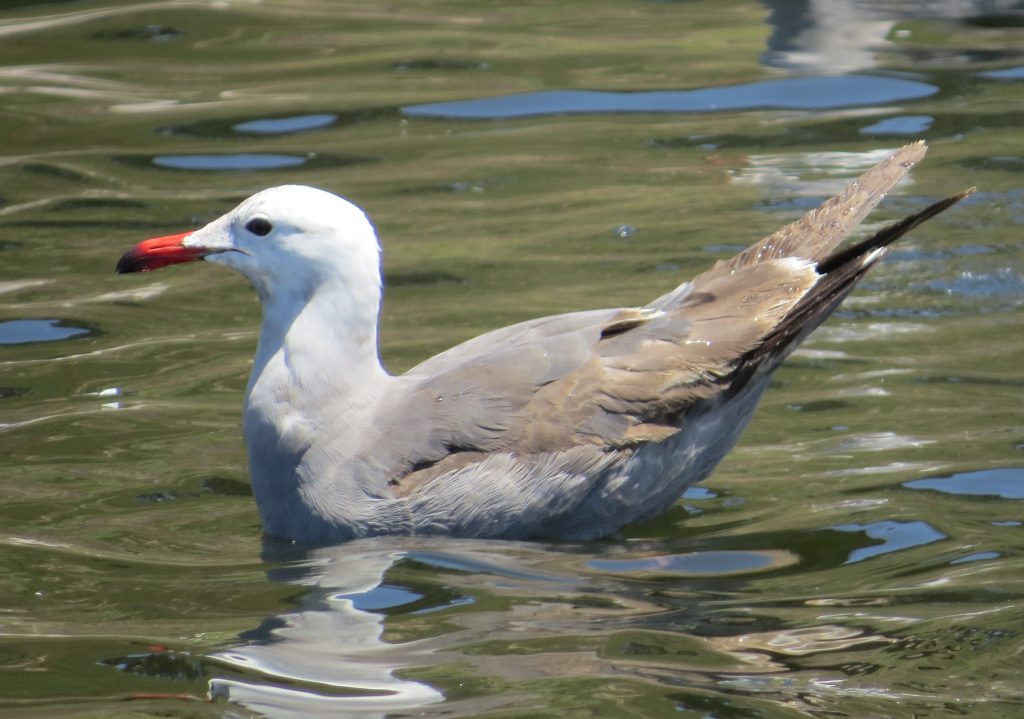 It’s such a good-looking Gull, both the deep sooty-colored juvenile and the adult with that white head and red bill.
It’s such a good-looking Gull, both the deep sooty-colored juvenile and the adult with that white head and red bill.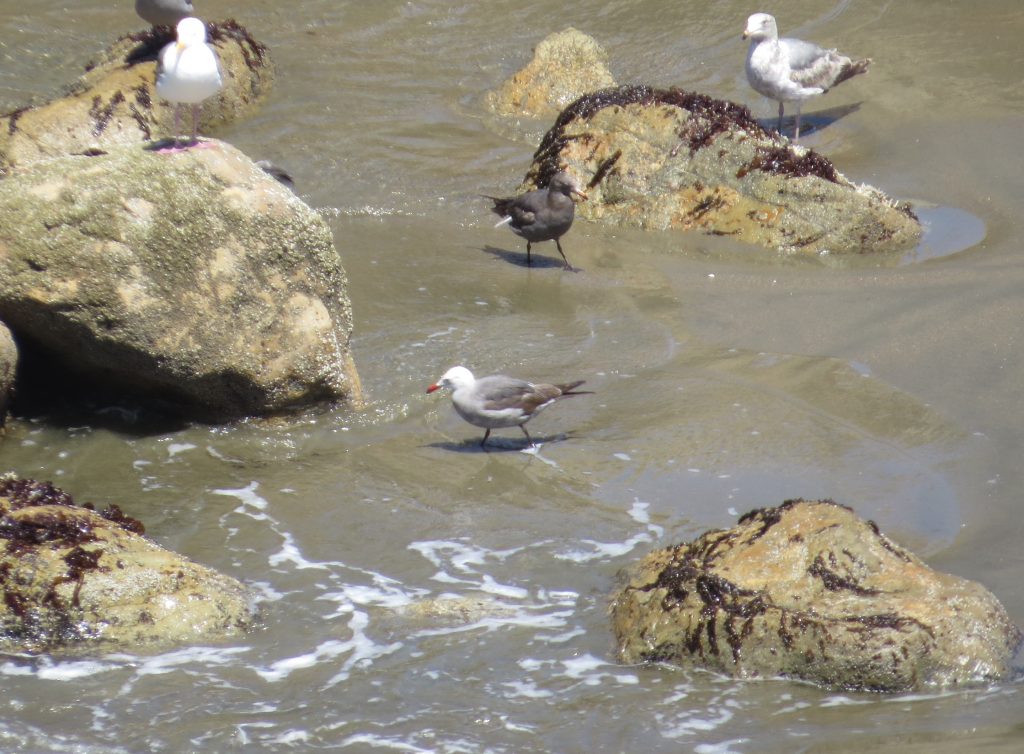 This isn’t the greatest photo, but it captures the awesome color-scheme of this bird.
This isn’t the greatest photo, but it captures the awesome color-scheme of this bird.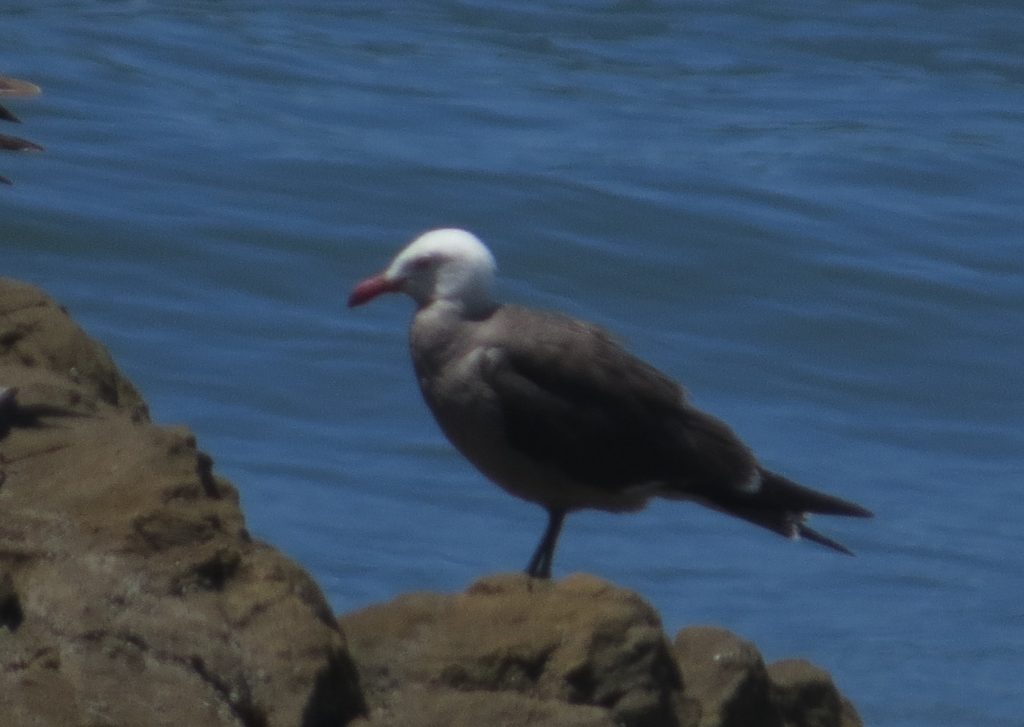 As nice as the Heerman’s Gulls were, I really wanted to find the Oystercatchers. I gave up trying to pick out a Pelagic Cormorant on these rocks that were covered in Brandt’s Cormorants and Brown Pelicans.
As nice as the Heerman’s Gulls were, I really wanted to find the Oystercatchers. I gave up trying to pick out a Pelagic Cormorant on these rocks that were covered in Brandt’s Cormorants and Brown Pelicans.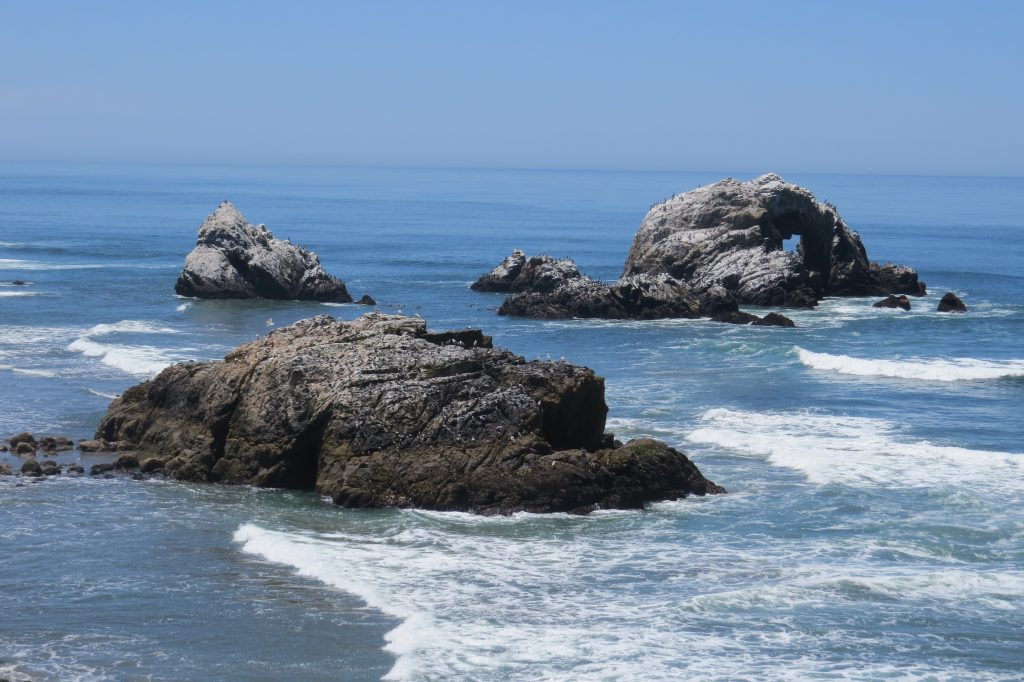 As I hiked down toward the ruins of the Suttro Baths, I paused to scan the rock in the foreground of the photo above. Finally, I picked out the large black birds I was looking for–they were in the deep shadow of the large cleft on the right side of that rock. Their orange bills stood out like beacons from the dark recesses of the shadow.
As I hiked down toward the ruins of the Suttro Baths, I paused to scan the rock in the foreground of the photo above. Finally, I picked out the large black birds I was looking for–they were in the deep shadow of the large cleft on the right side of that rock. Their orange bills stood out like beacons from the dark recesses of the shadow.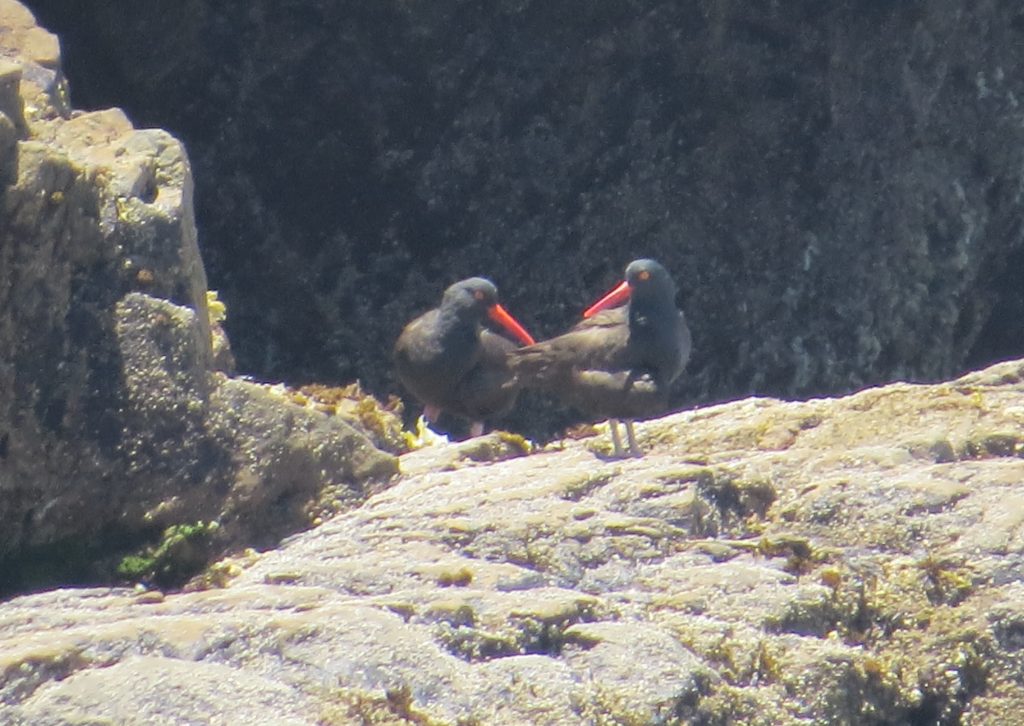
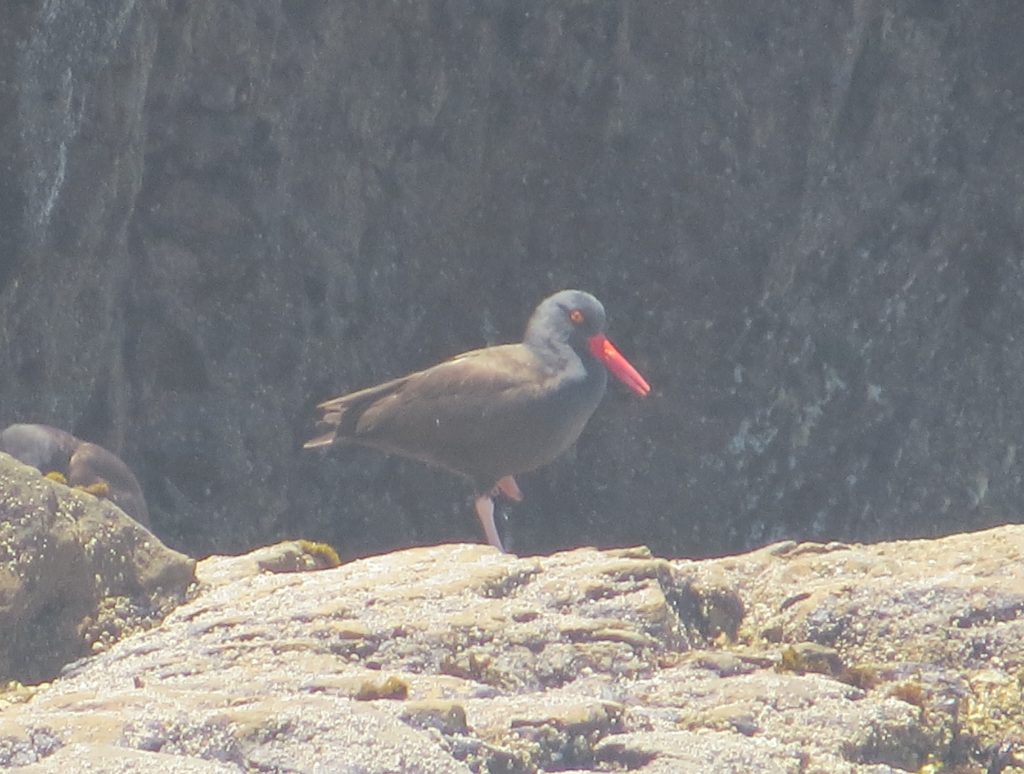
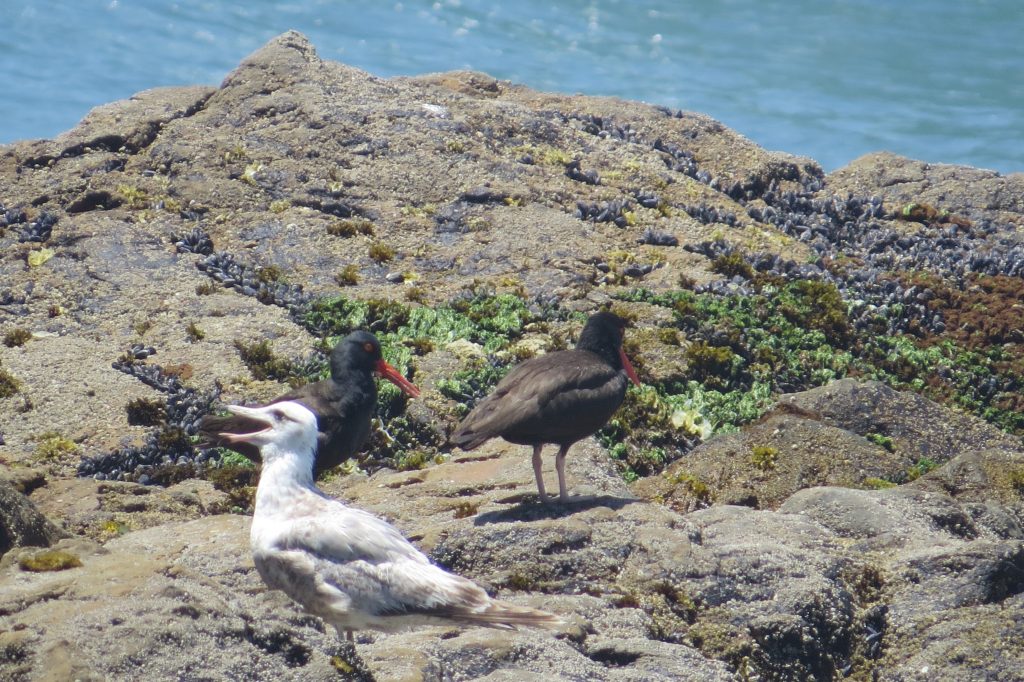
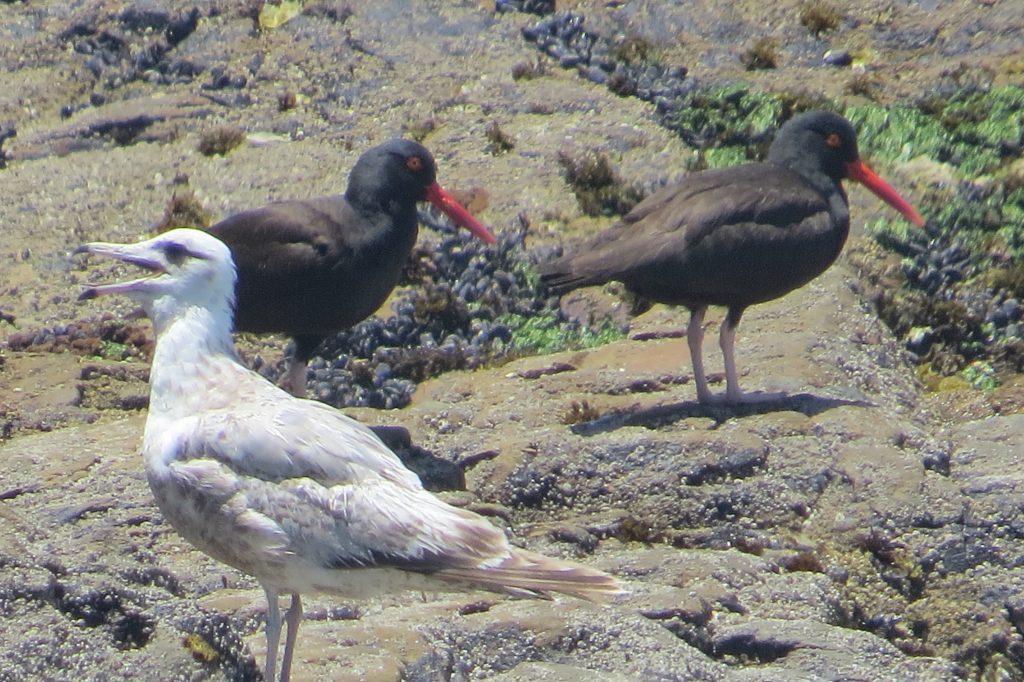 It wasn’t until a few days after our time at Ocean Beach that we made it back to the Pacific Ocean proper. On our last day of vacation we drove down the Coastal Highway with no real destination. I did want to stop at a spot near Half Moon Bay to look for an inland bird that I’ll write about in the next post. Little did I know that I would nab two pelagic lifers as a bonus when we stopped at Dunes Beach State Park and enjoyed the ocean one last time.
It wasn’t until a few days after our time at Ocean Beach that we made it back to the Pacific Ocean proper. On our last day of vacation we drove down the Coastal Highway with no real destination. I did want to stop at a spot near Half Moon Bay to look for an inland bird that I’ll write about in the next post. Little did I know that I would nab two pelagic lifers as a bonus when we stopped at Dunes Beach State Park and enjoyed the ocean one last time.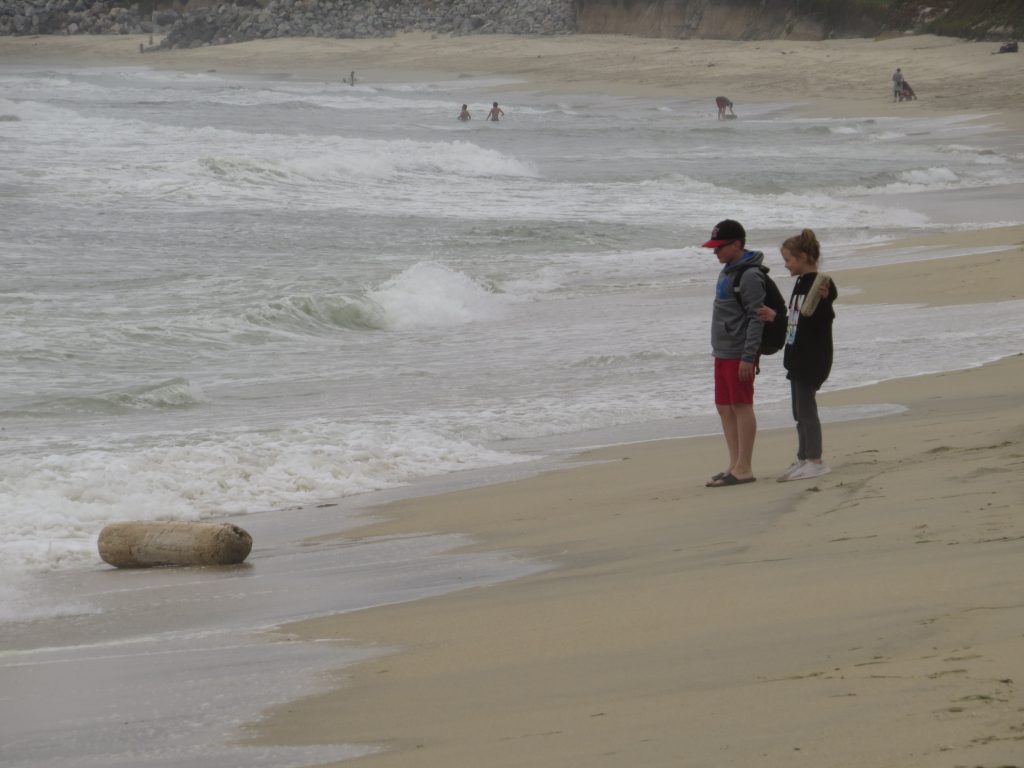 While the kids studied a log rolling in the surf, I studied beach chickens. It was good practice to work on going through the key field marks of this immature California Gull, as seeing one in Minnesota is a rare but real possibility. It was also good to see another “California”-named species in California. There will be more “California” birds in the next post.
While the kids studied a log rolling in the surf, I studied beach chickens. It was good practice to work on going through the key field marks of this immature California Gull, as seeing one in Minnesota is a rare but real possibility. It was also good to see another “California”-named species in California. There will be more “California” birds in the next post.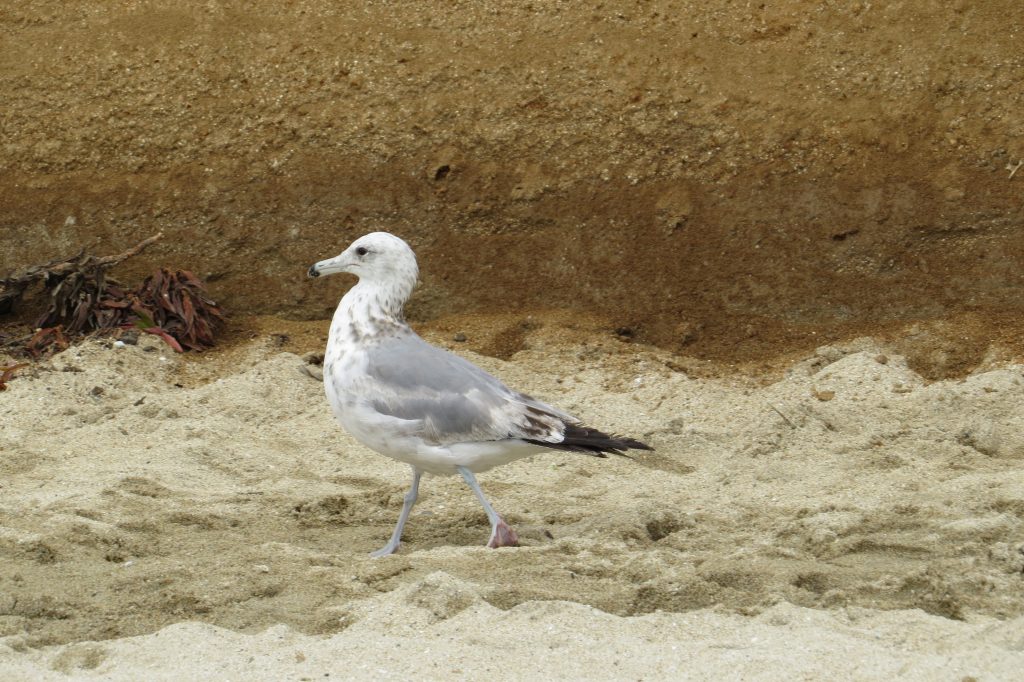 I also scanned the surf as the bird life was super abundant at sea. There, just beyond where the edge of the breaking waves, were several Common Murres, another lifer.
I also scanned the surf as the bird life was super abundant at sea. There, just beyond where the edge of the breaking waves, were several Common Murres, another lifer.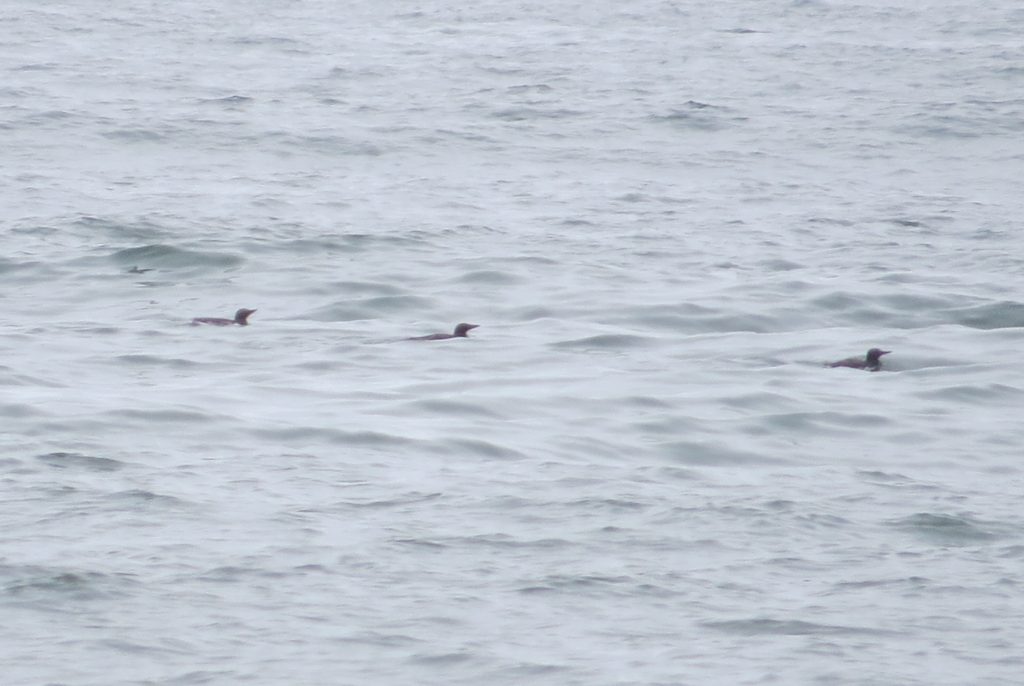 I certainly wished I had my scope along to better enjoy these birds and look for other interesting pelagic species. I did note that the Cormorants I was seeing looked a little different…
I certainly wished I had my scope along to better enjoy these birds and look for other interesting pelagic species. I did note that the Cormorants I was seeing looked a little different…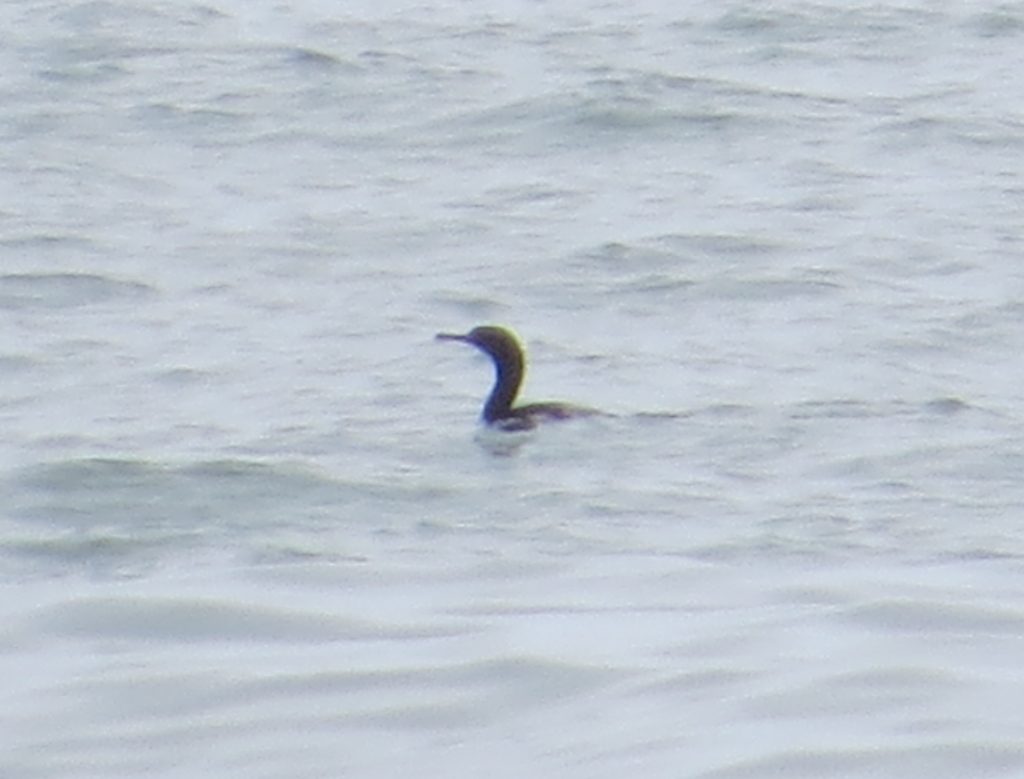 With the steep forehead and thin bill, this one looked good for a Pelagic Cormorant. I would have liked a cleaner look, but I’ll take the lifer.
With the steep forehead and thin bill, this one looked good for a Pelagic Cormorant. I would have liked a cleaner look, but I’ll take the lifer.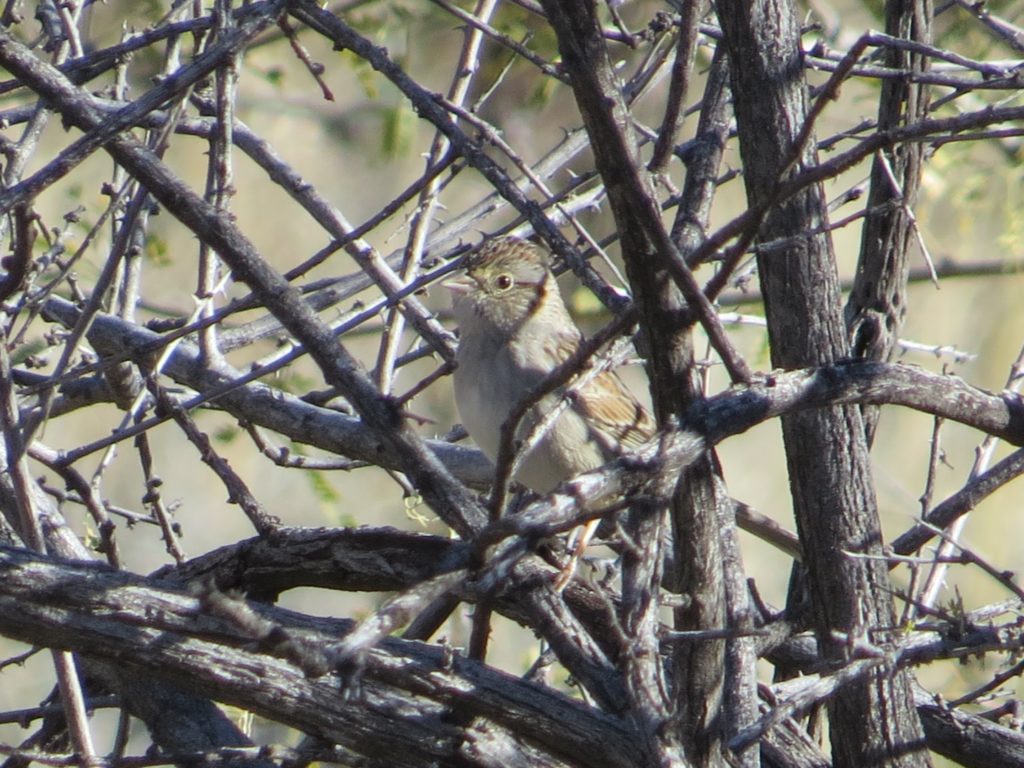
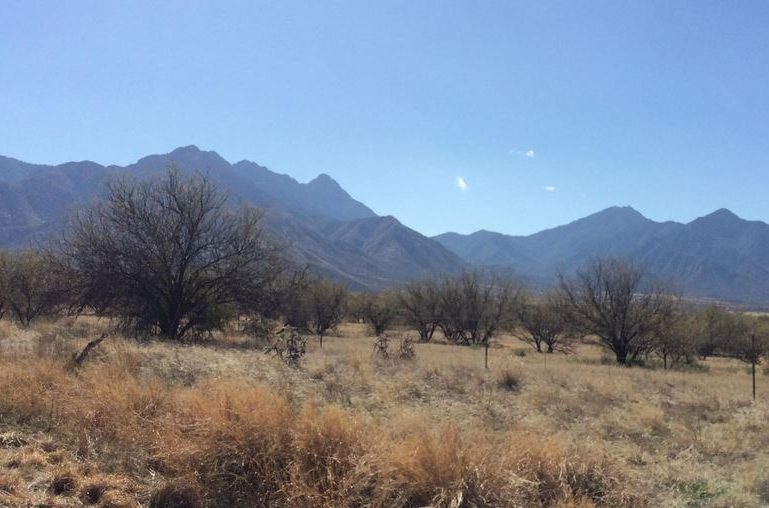
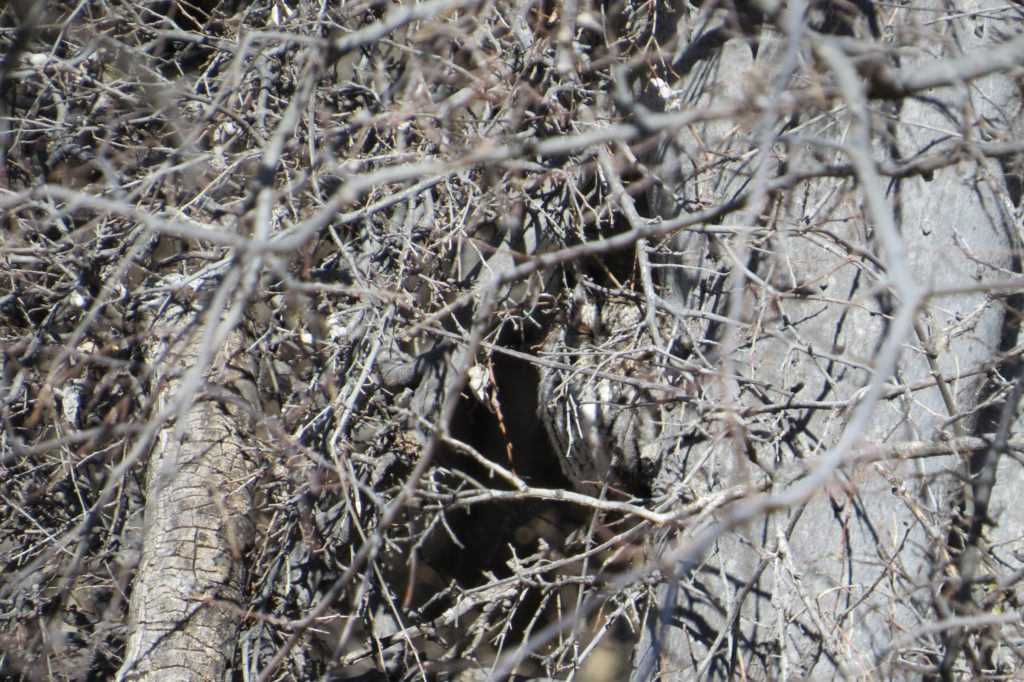 How someone spotted this thing I’ll never know. I could barely find it with multiple people pointing to it.
How someone spotted this thing I’ll never know. I could barely find it with multiple people pointing to it.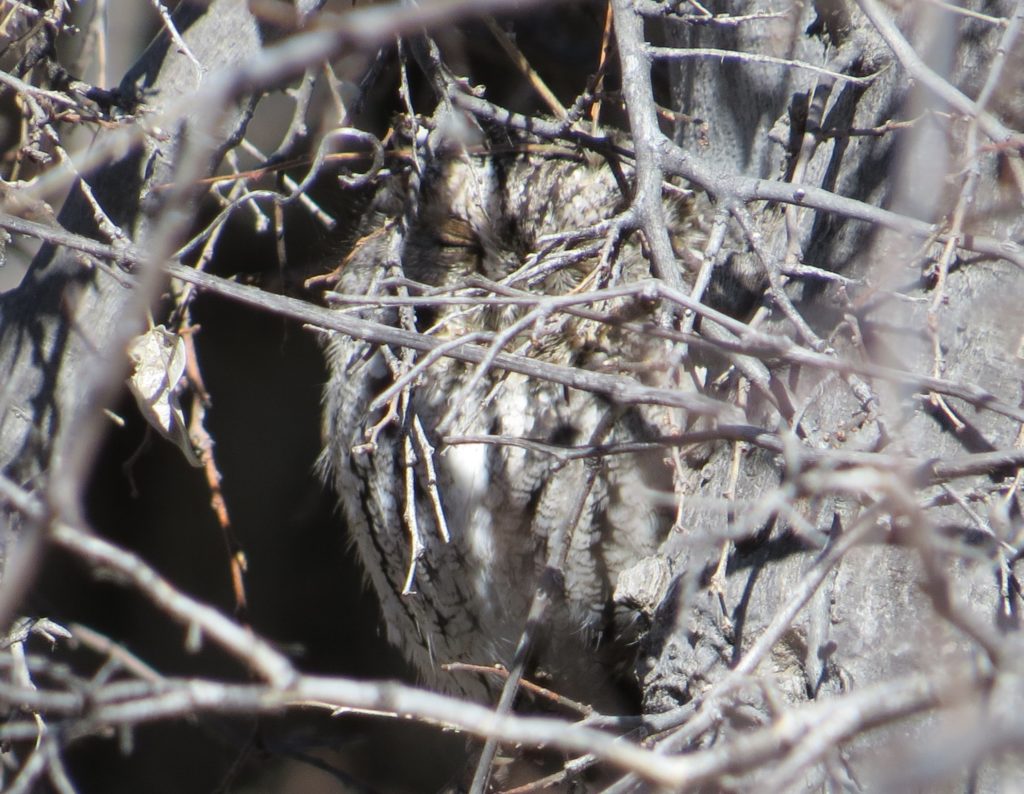 Tommy and I had barely resumed our Thrush sorting when I asked Tommy whatever happened to Caleb. I no sooner said those words, and the Boy came sprinting down the path toward us hollering (without breaking stride) that the Thrush had been spotted further up the trail. Caleb continued running and proclaiming the good news to everyone and their cousin, birders or not, that the White-throated Thrush was present.
Tommy and I had barely resumed our Thrush sorting when I asked Tommy whatever happened to Caleb. I no sooner said those words, and the Boy came sprinting down the path toward us hollering (without breaking stride) that the Thrush had been spotted further up the trail. Caleb continued running and proclaiming the good news to everyone and their cousin, birders or not, that the White-throated Thrush was present.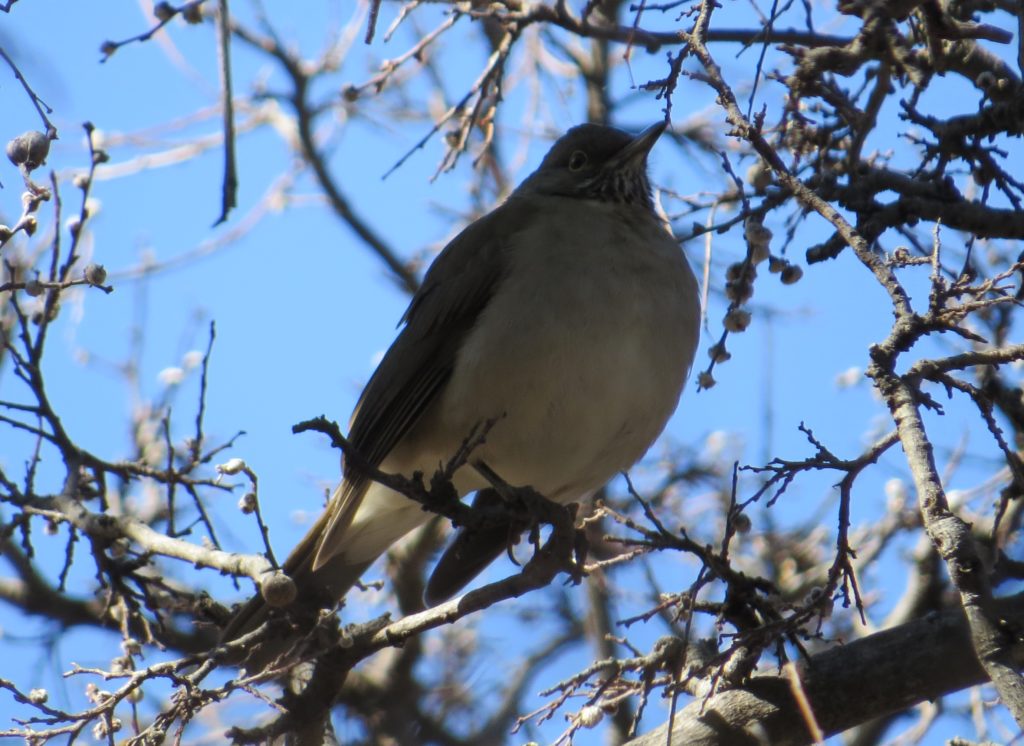
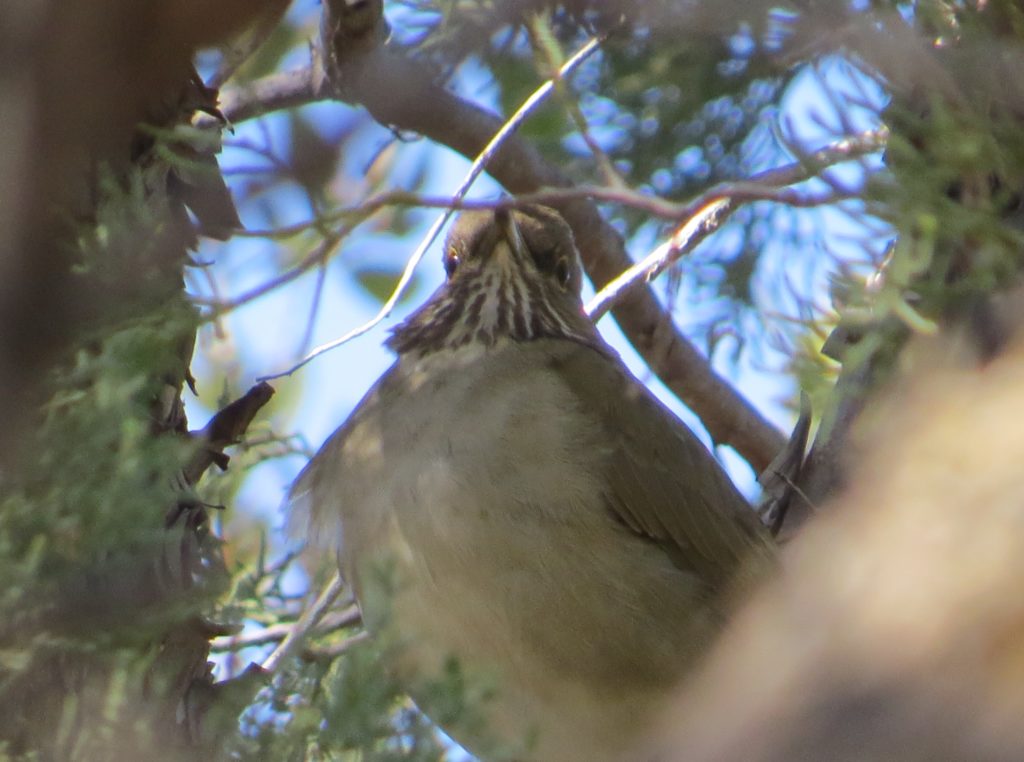
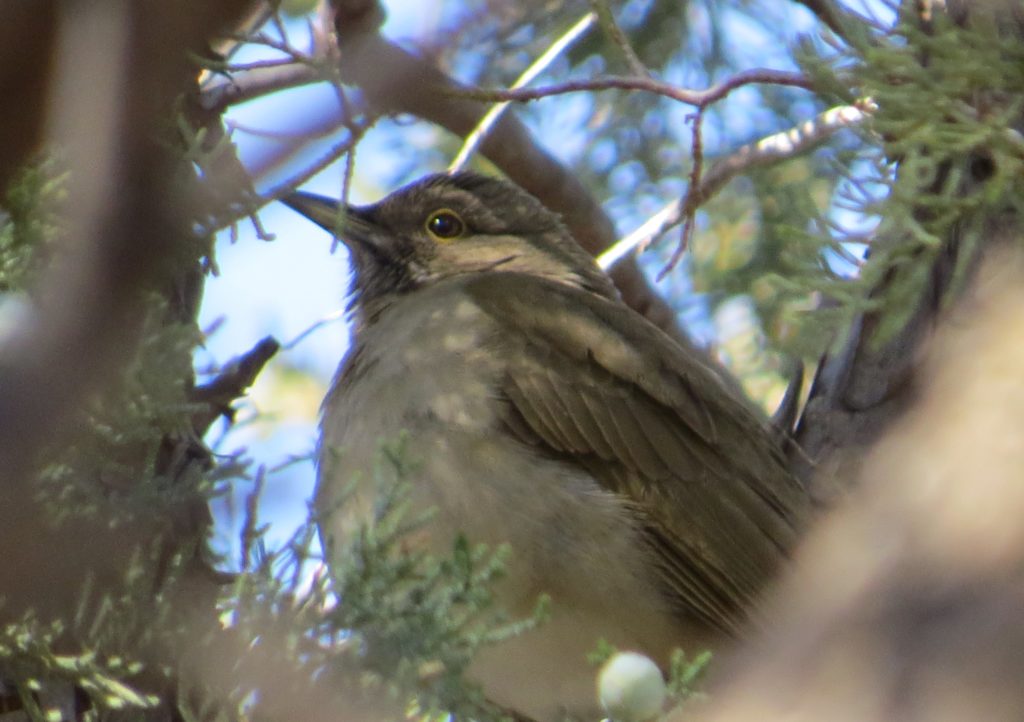 A bit of serendipity happened at the parking lot on the way out when a birder recognized Tommy. Turns out that birder was Linda Grant, the original finder of the famous Thrush. Linda had come back for better photos after her first ones were harried as bird photos can be when you realize you have a Mega and need to get the word out immediately. Tommy had written a great blog post on Linda’s discovery of the White-throated Thrush and on over two dozen birders’ reactions to the find. Linda and her husband were able to tell Tommy how much they enjoyed the post, and Tommy clearly enjoyed meeting this hero to hundreds of birders. A cool moment.
A bit of serendipity happened at the parking lot on the way out when a birder recognized Tommy. Turns out that birder was Linda Grant, the original finder of the famous Thrush. Linda had come back for better photos after her first ones were harried as bird photos can be when you realize you have a Mega and need to get the word out immediately. Tommy had written a great blog post on Linda’s discovery of the White-throated Thrush and on over two dozen birders’ reactions to the find. Linda and her husband were able to tell Tommy how much they enjoyed the post, and Tommy clearly enjoyed meeting this hero to hundreds of birders. A cool moment.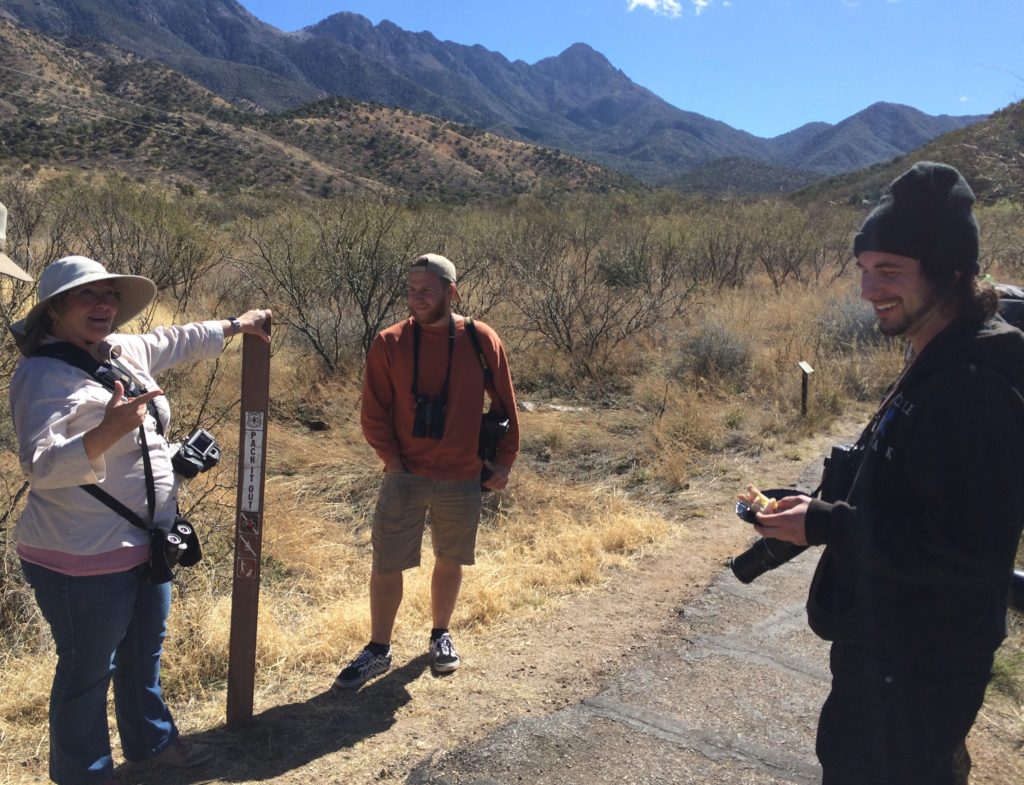
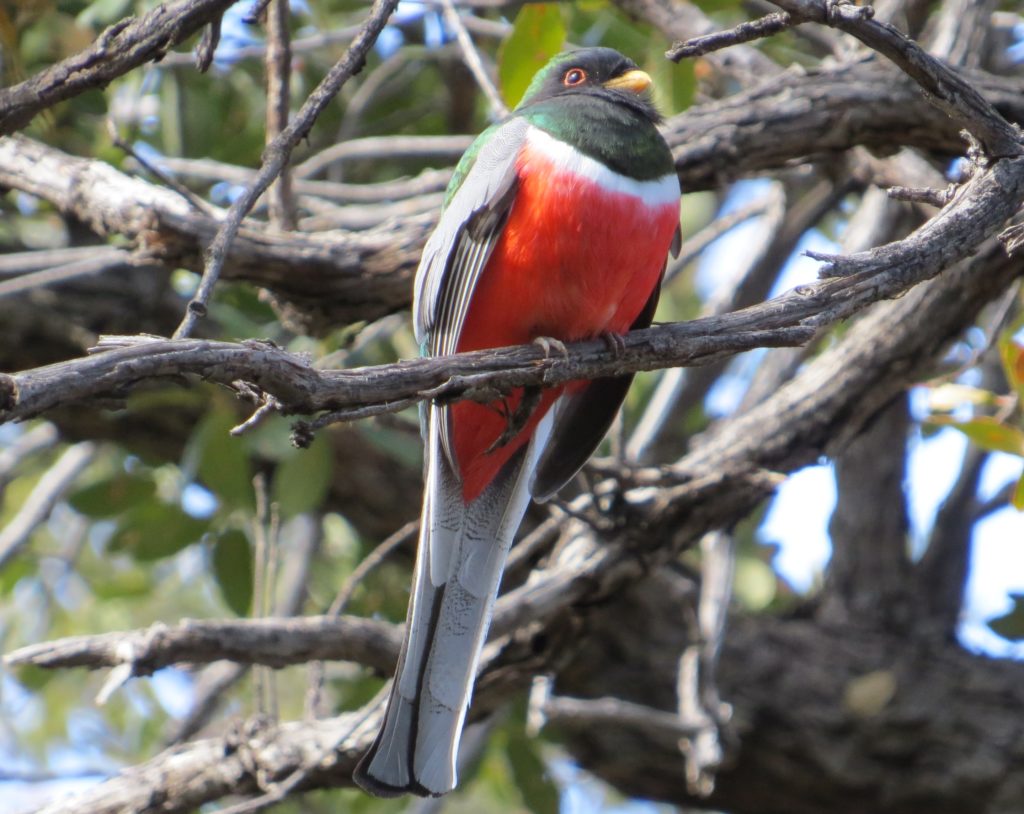 The Trogon was incredibly tame and would sit for long periods of time on a perch before moving a short distance, easy to find and easy to approach. SE AZ never ceases to amaze me. This was a stunning moment. And, AZ birders will have to forgive me, but this was just as big a thrill or bigger than the Thrush.
The Trogon was incredibly tame and would sit for long periods of time on a perch before moving a short distance, easy to find and easy to approach. SE AZ never ceases to amaze me. This was a stunning moment. And, AZ birders will have to forgive me, but this was just as big a thrill or bigger than the Thrush.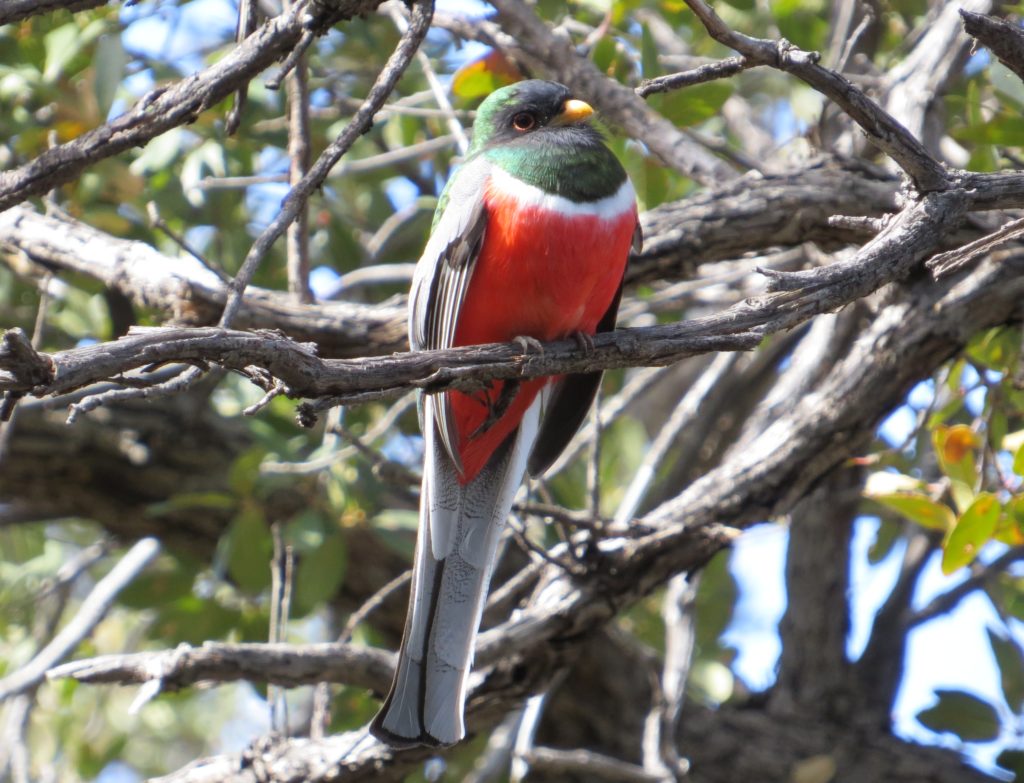 In 2015 my only real photo of the Elegant Trogon was from the back. This was a refreshing and a much yearned for change. I, of course, got to see the back this time too and once again admire that coppery tail that it was once named for.
In 2015 my only real photo of the Elegant Trogon was from the back. This was a refreshing and a much yearned for change. I, of course, got to see the back this time too and once again admire that coppery tail that it was once named for.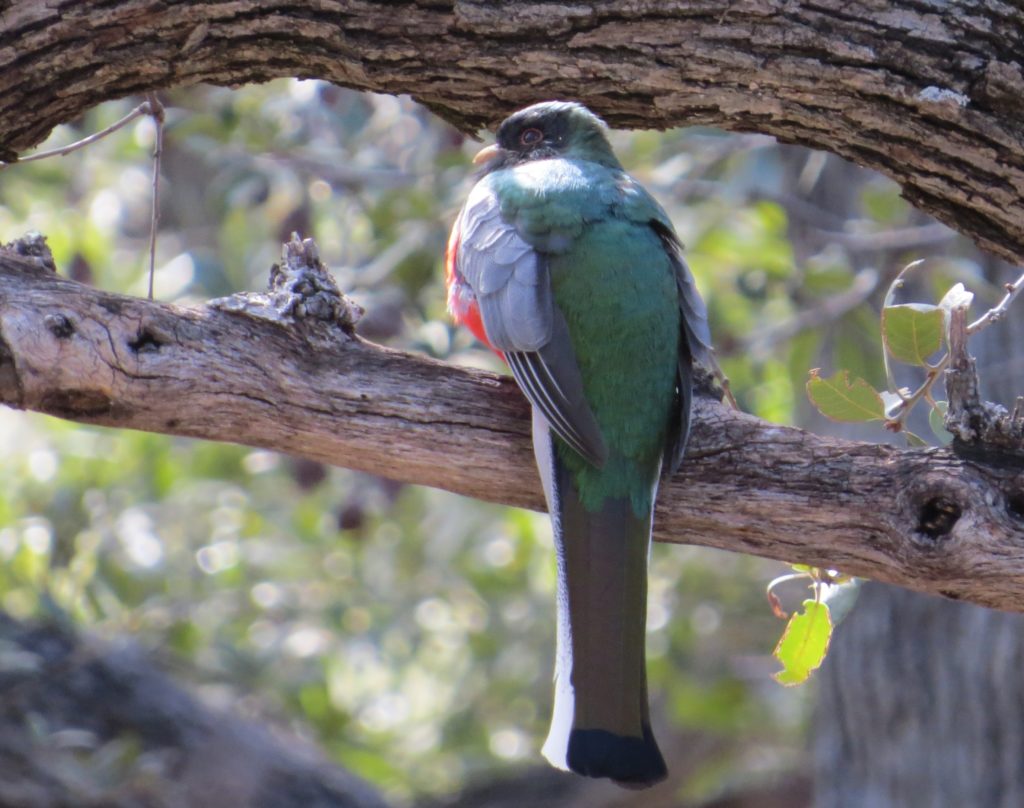
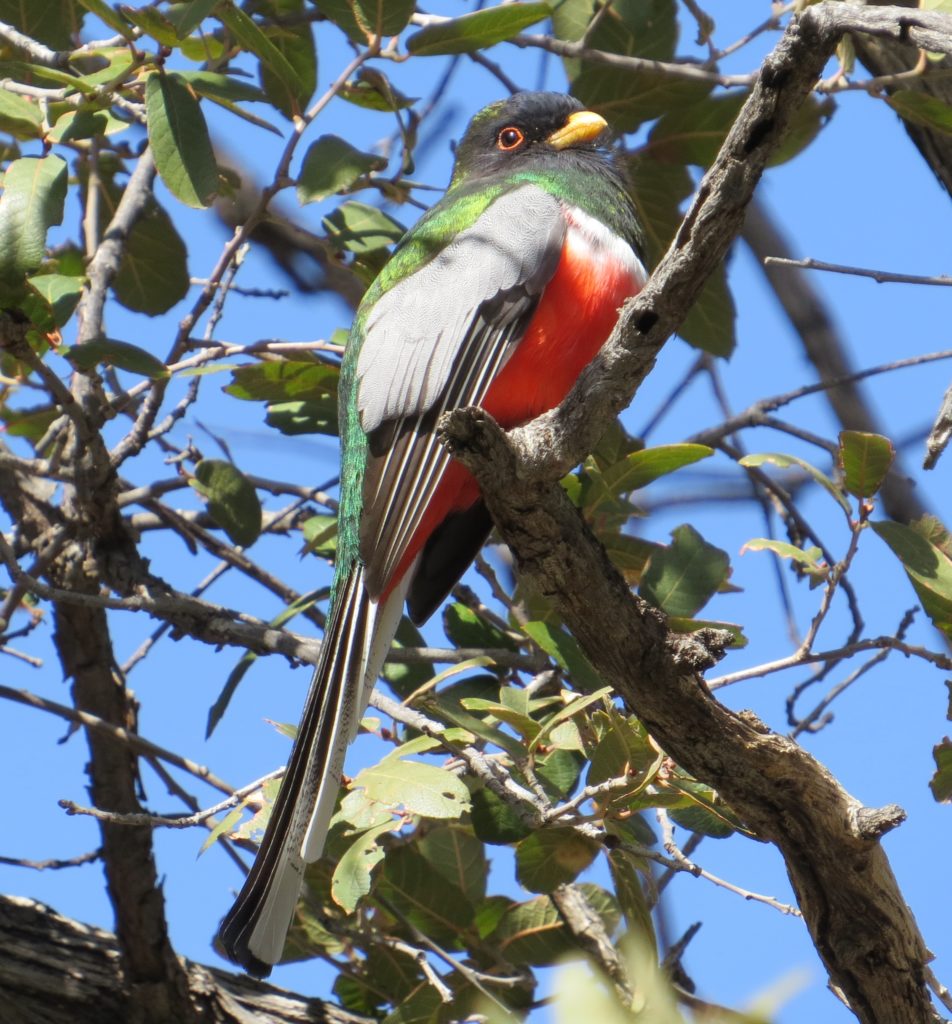
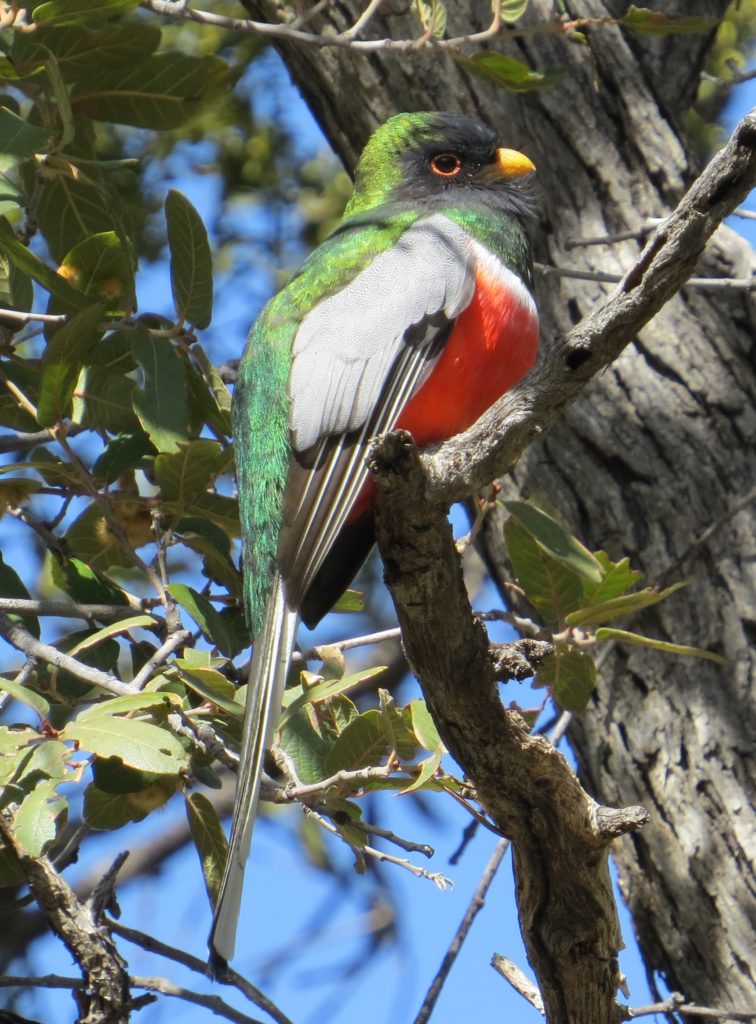 This was a Trogon-crushfest, enjoyed by even the most experienced of locals…
This was a Trogon-crushfest, enjoyed by even the most experienced of locals…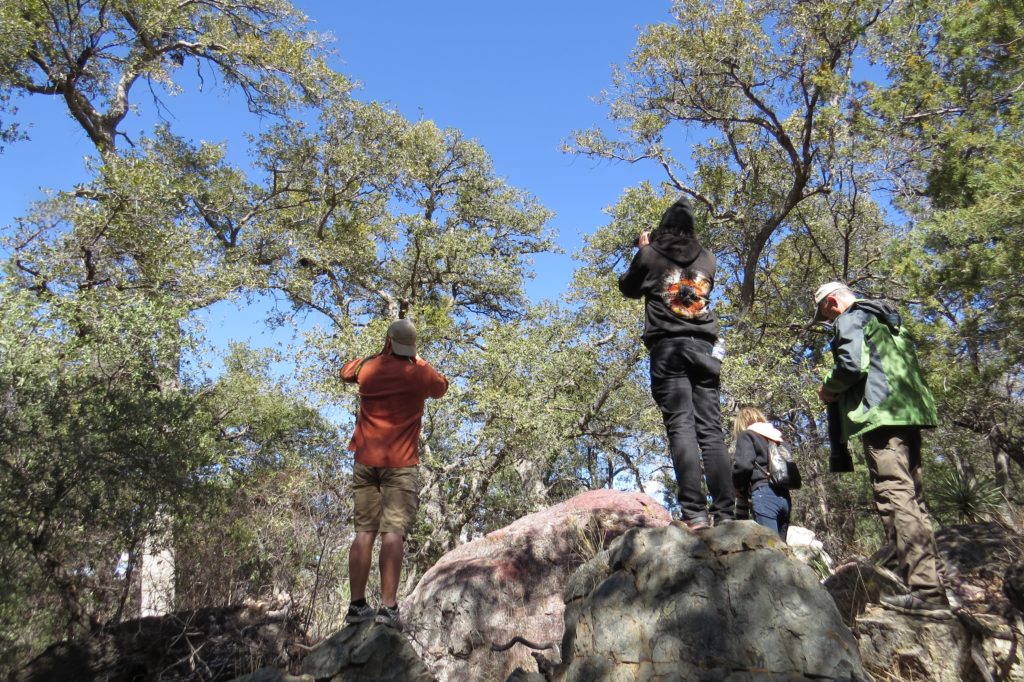
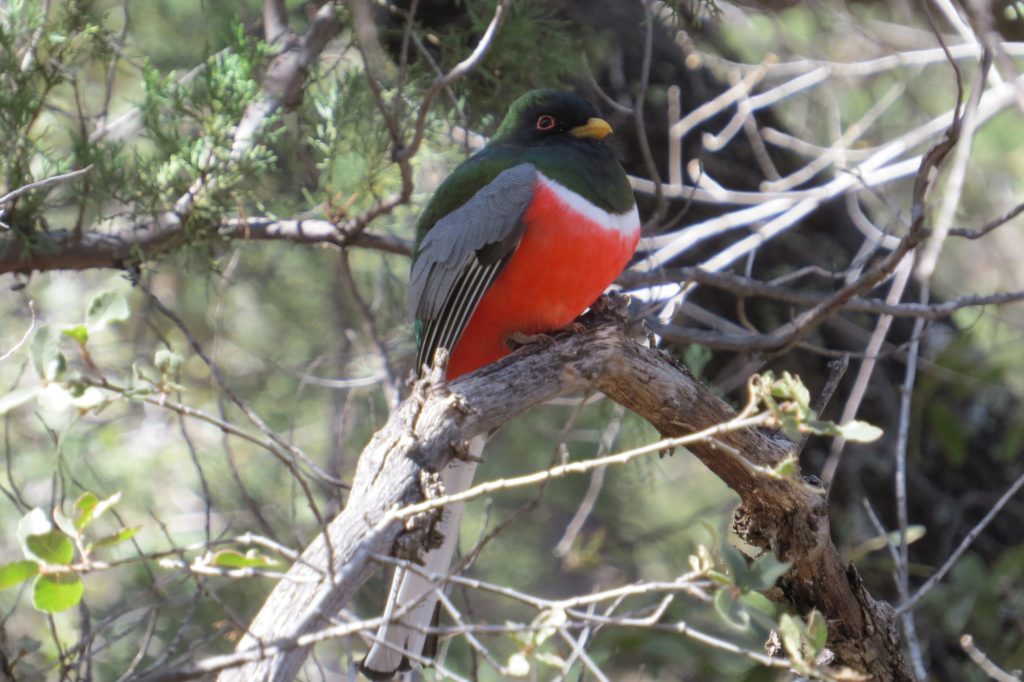
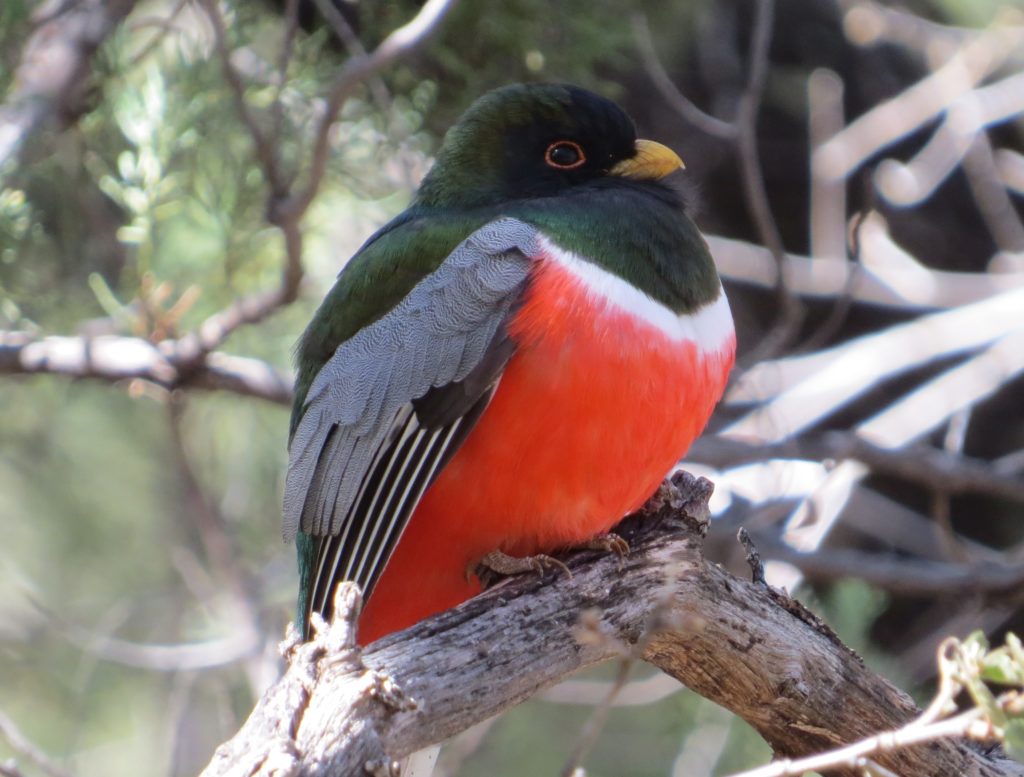 Obviously I had a hard time prying myself away from that bird, but the clock was ticking and the birding queue had a new line leader. Would I have liked to go to the Santa Rita Lodge and try to get a better look at a Blue-throated Hummingbird? Yes. Would I have liked to pick up some fresh Trogon gear at the gift shop? Also yes. But did I? Sadly, no. Time was slipping by, and the one bird I needed was in nearby Green Valley. Lawrence’s Goldfinches have irrupted this winter all over the place, and the Canoa Ranch was a stronghold for them. I needed to grab this bird while I could since this was the year for that bird. I have never seen reports of them in other years on my visits. But first we made a quick stop down by Proctor Road to look for a Black-capped Gnatcatcher. No dice, again.
Obviously I had a hard time prying myself away from that bird, but the clock was ticking and the birding queue had a new line leader. Would I have liked to go to the Santa Rita Lodge and try to get a better look at a Blue-throated Hummingbird? Yes. Would I have liked to pick up some fresh Trogon gear at the gift shop? Also yes. But did I? Sadly, no. Time was slipping by, and the one bird I needed was in nearby Green Valley. Lawrence’s Goldfinches have irrupted this winter all over the place, and the Canoa Ranch was a stronghold for them. I needed to grab this bird while I could since this was the year for that bird. I have never seen reports of them in other years on my visits. But first we made a quick stop down by Proctor Road to look for a Black-capped Gnatcatcher. No dice, again.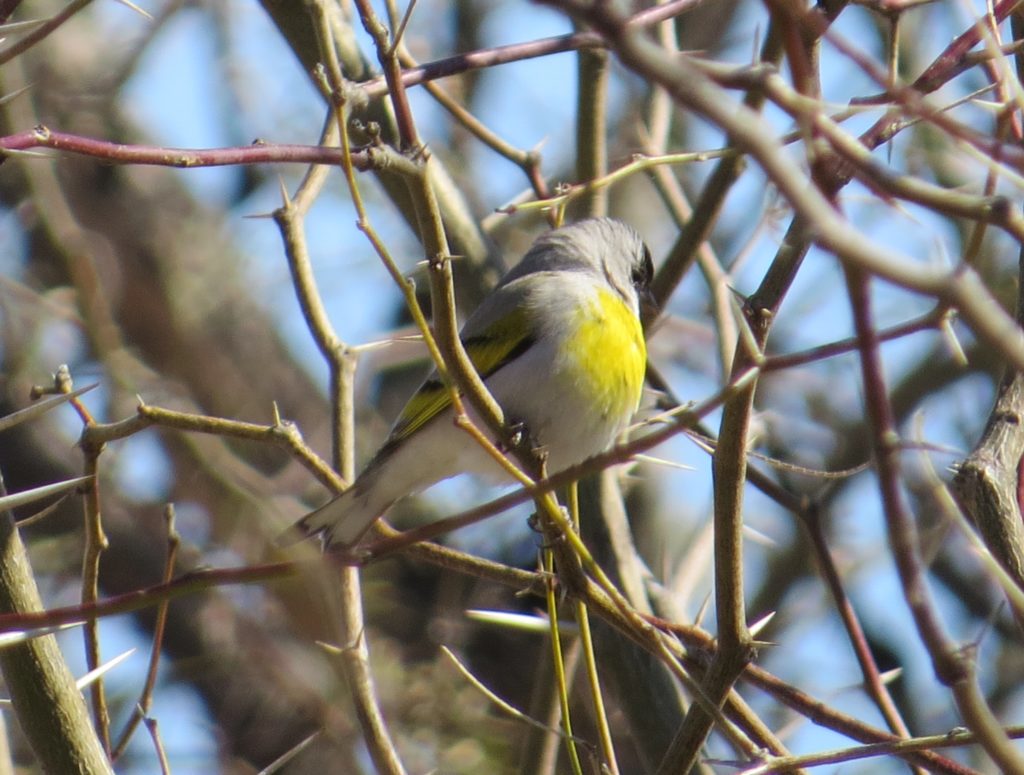 It was now time to bust back to Mom and Dad’s. Mom was putting on a spread for the birders and non-birders. By the end of the day we were all stuffed–with good food and good birds.
It was now time to bust back to Mom and Dad’s. Mom was putting on a spread for the birders and non-birders. By the end of the day we were all stuffed–with good food and good birds.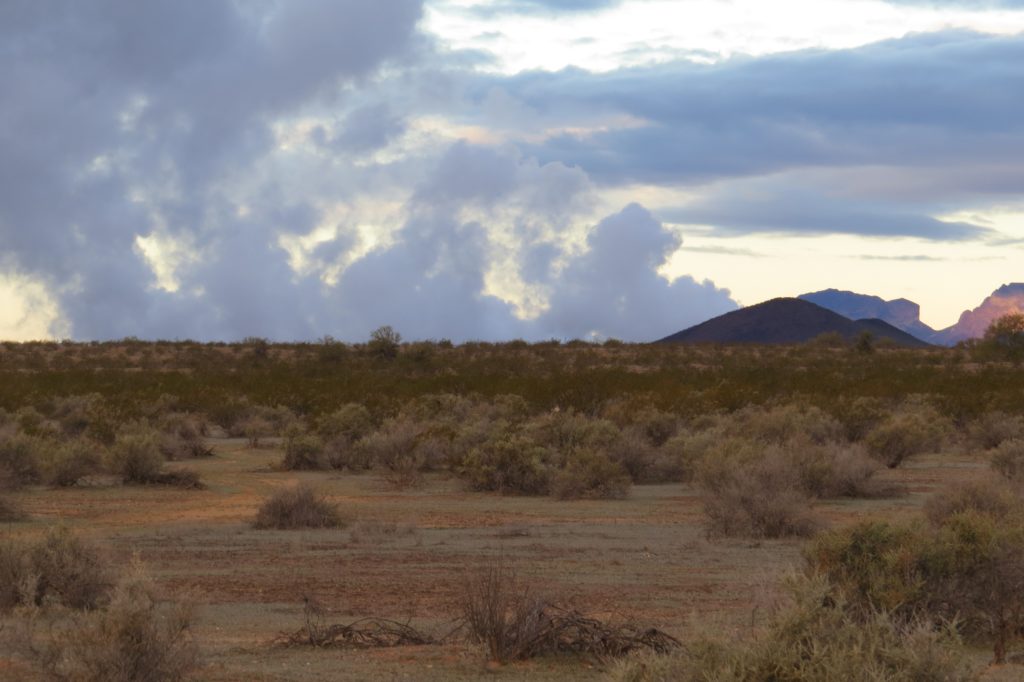
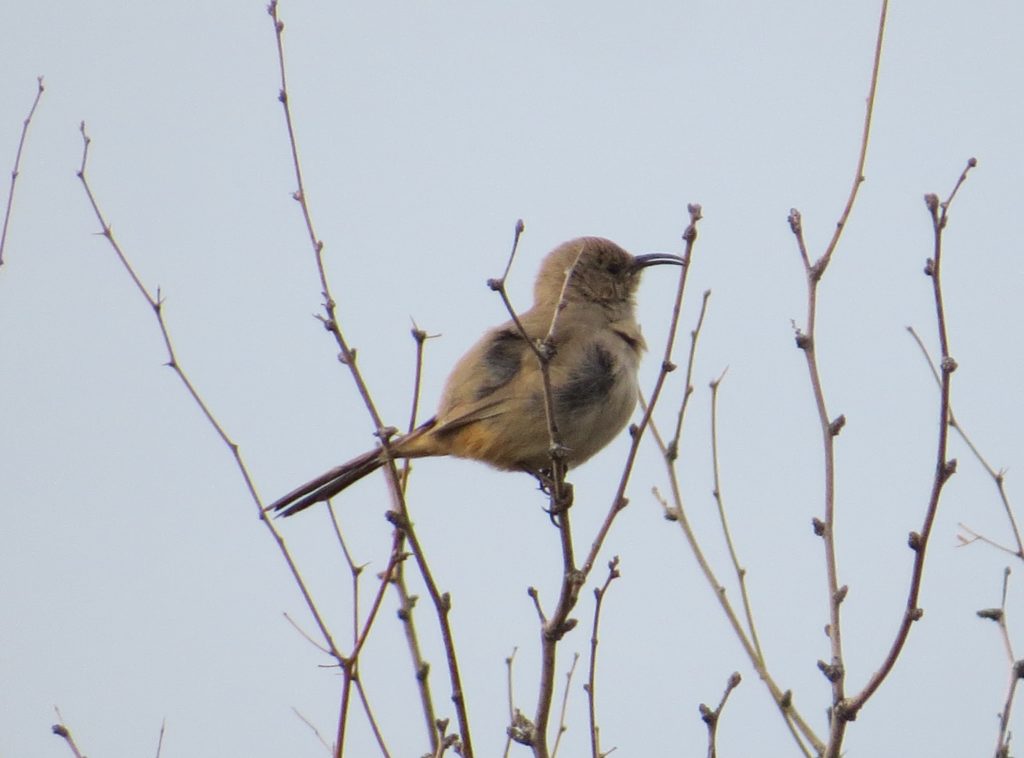 It was one lifer down with four to go. Two thoughts struck me on my first visit to the Thrasher Spot. One was that I couldn’t believe how flat the ground was.
It was one lifer down with four to go. Two thoughts struck me on my first visit to the Thrasher Spot. One was that I couldn’t believe how flat the ground was.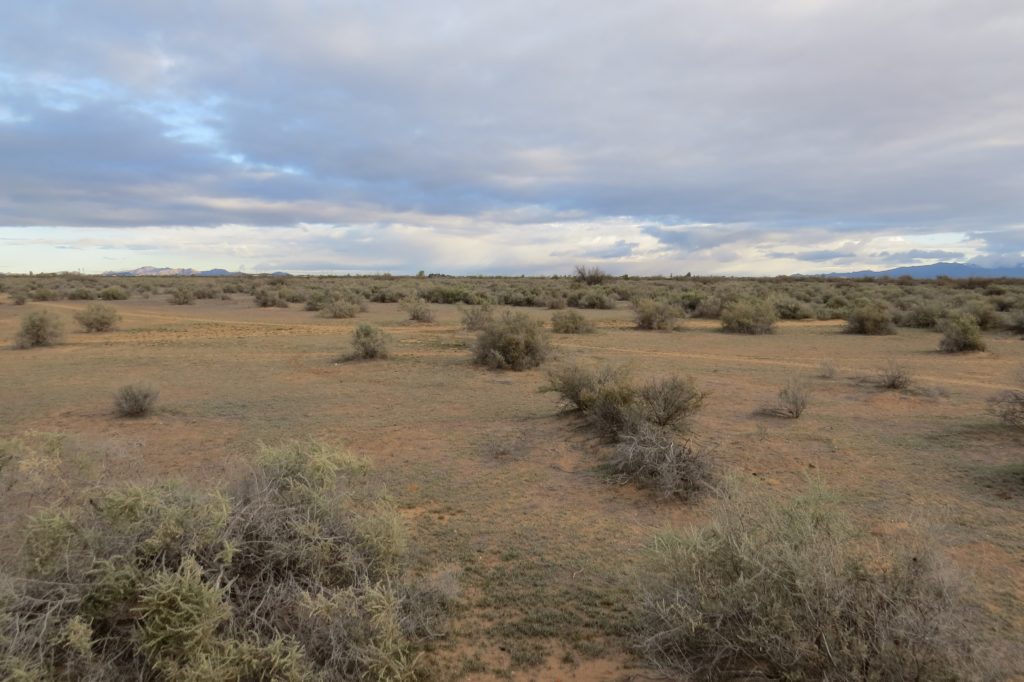
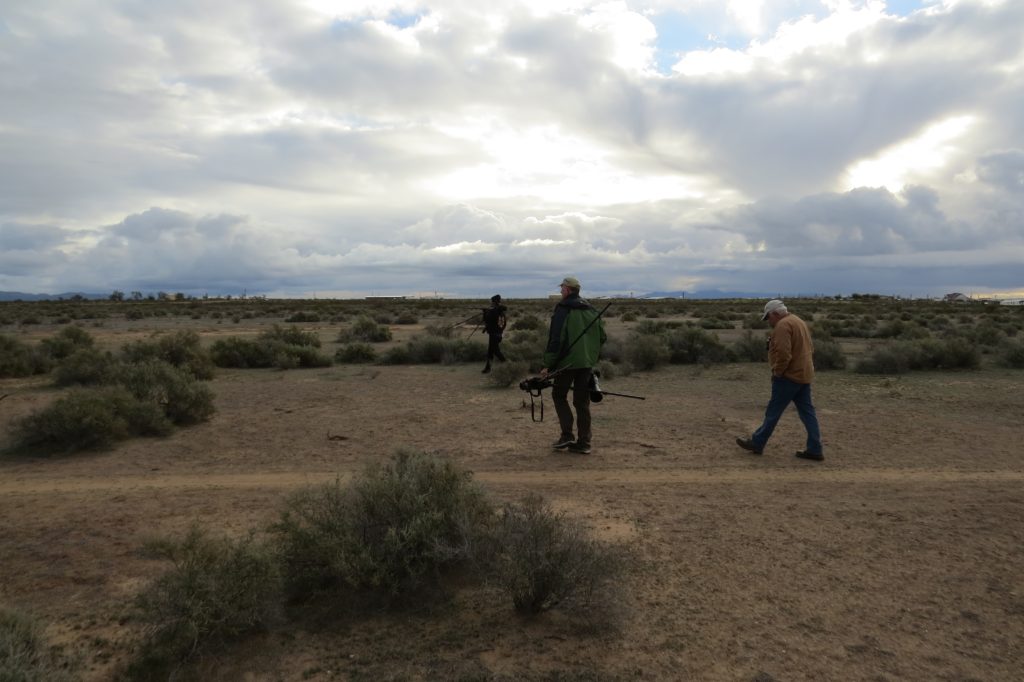 Though not completely unexpected, there were sightings of a couple different old men wandering alone and somewhat aimlessly trying to tally some Thrasher lifers for themselves. At least I wasn’t as late to the party as these guys. The sparse saltbush- studded landscape was not only good habitat for the occasional septagenerian but also for numerous Sagebrush Sparrows (lifer) that would run with tails held high from bush to bush. I was shocked to learn they didn’t respond to pishing. What kind of Sparrows are these anyway? Good looks at these birds and the others were tough to come by. Pressing on and going wider in our search efforts, we eventually locked up a Bendire’s Thrasher lifer.
Though not completely unexpected, there were sightings of a couple different old men wandering alone and somewhat aimlessly trying to tally some Thrasher lifers for themselves. At least I wasn’t as late to the party as these guys. The sparse saltbush- studded landscape was not only good habitat for the occasional septagenerian but also for numerous Sagebrush Sparrows (lifer) that would run with tails held high from bush to bush. I was shocked to learn they didn’t respond to pishing. What kind of Sparrows are these anyway? Good looks at these birds and the others were tough to come by. Pressing on and going wider in our search efforts, we eventually locked up a Bendire’s Thrasher lifer.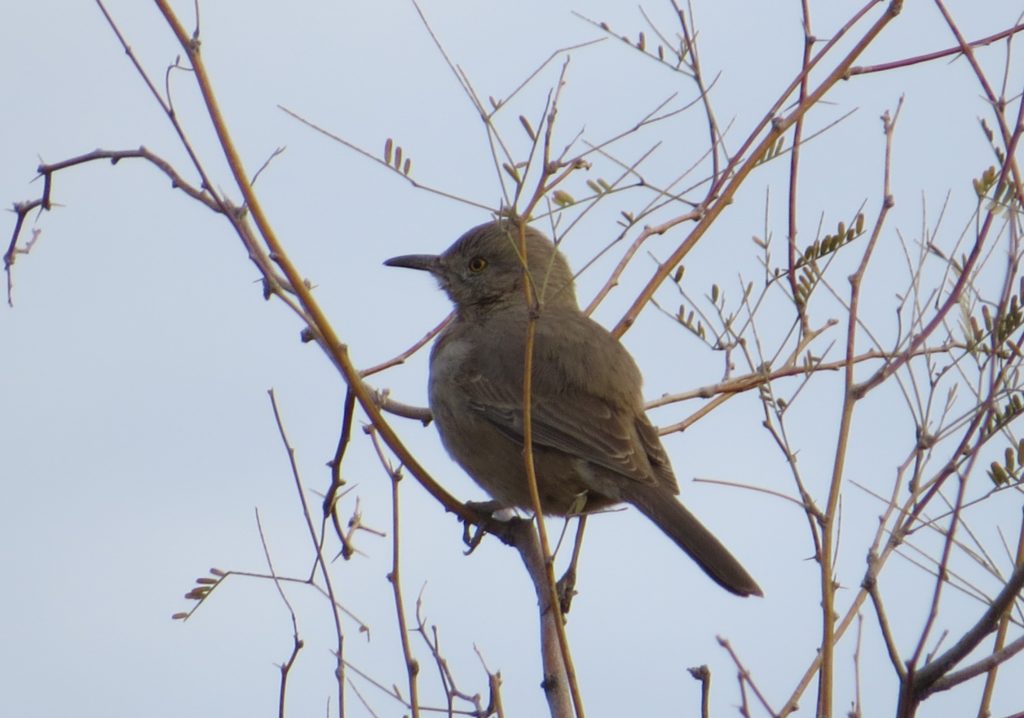 By this time, the sun was finally showing itself and warming up our frozen bodies. The birds seemed to enjoy it too as we finally started to get some good looks of perching Sagebrush Sparrows.
By this time, the sun was finally showing itself and warming up our frozen bodies. The birds seemed to enjoy it too as we finally started to get some good looks of perching Sagebrush Sparrows.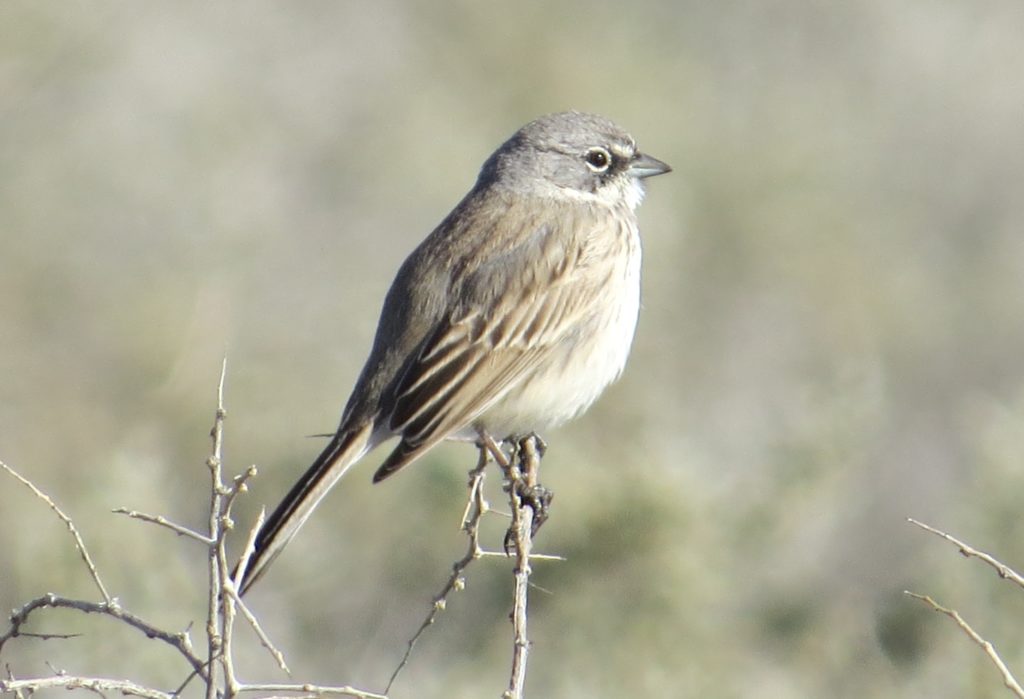 Tommy was able to spy the more rare doppelganger Bell’s Sparrow to make my fourth lifer of five for the morning. The Bell’s is told apart from the Sagebrush Sparrow by its bolder, thicker malar stripe and its unstreaked back.
Tommy was able to spy the more rare doppelganger Bell’s Sparrow to make my fourth lifer of five for the morning. The Bell’s is told apart from the Sagebrush Sparrow by its bolder, thicker malar stripe and its unstreaked back.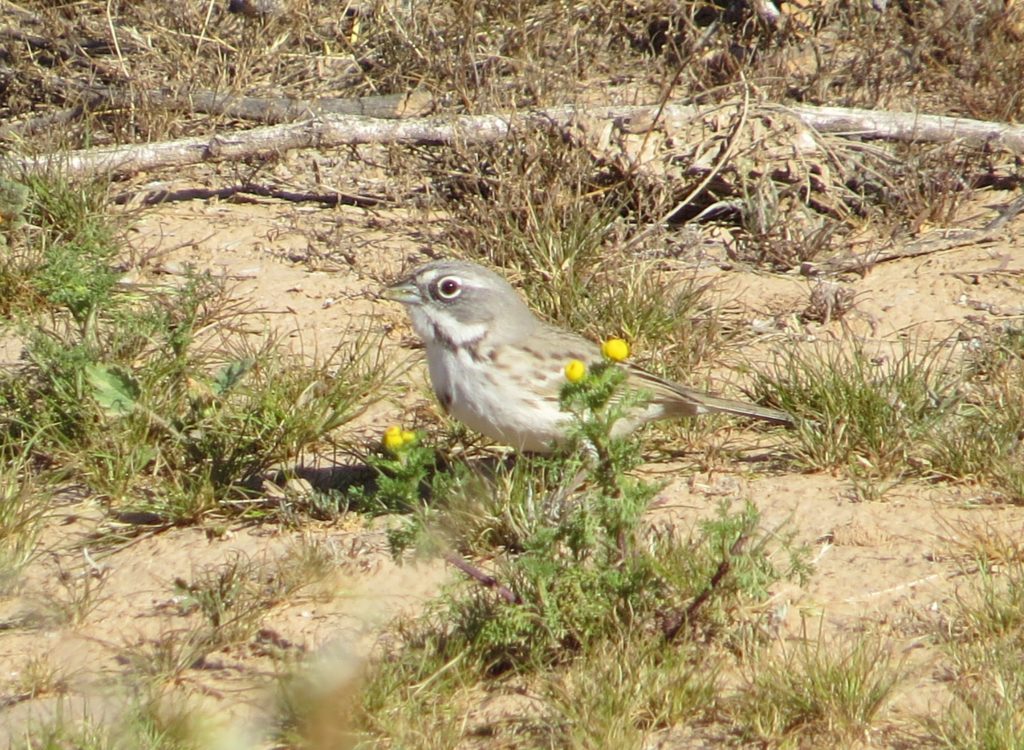
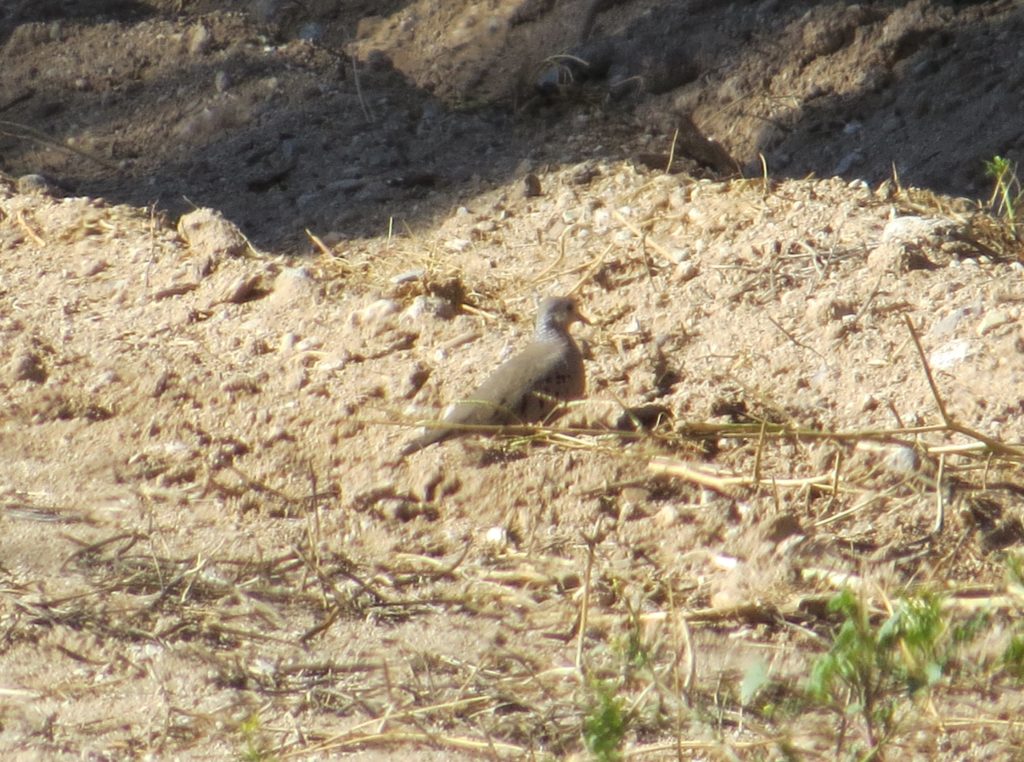 I repaid Gordon by spotting a raptor flying over us. I casually asked the guys what it was since they were making an eBird checklist. Turns out it was a Crested Caracara, a county bird for Gordon and only the second one Tommy has seen in Maricopa County.
I repaid Gordon by spotting a raptor flying over us. I casually asked the guys what it was since they were making an eBird checklist. Turns out it was a Crested Caracara, a county bird for Gordon and only the second one Tommy has seen in Maricopa County.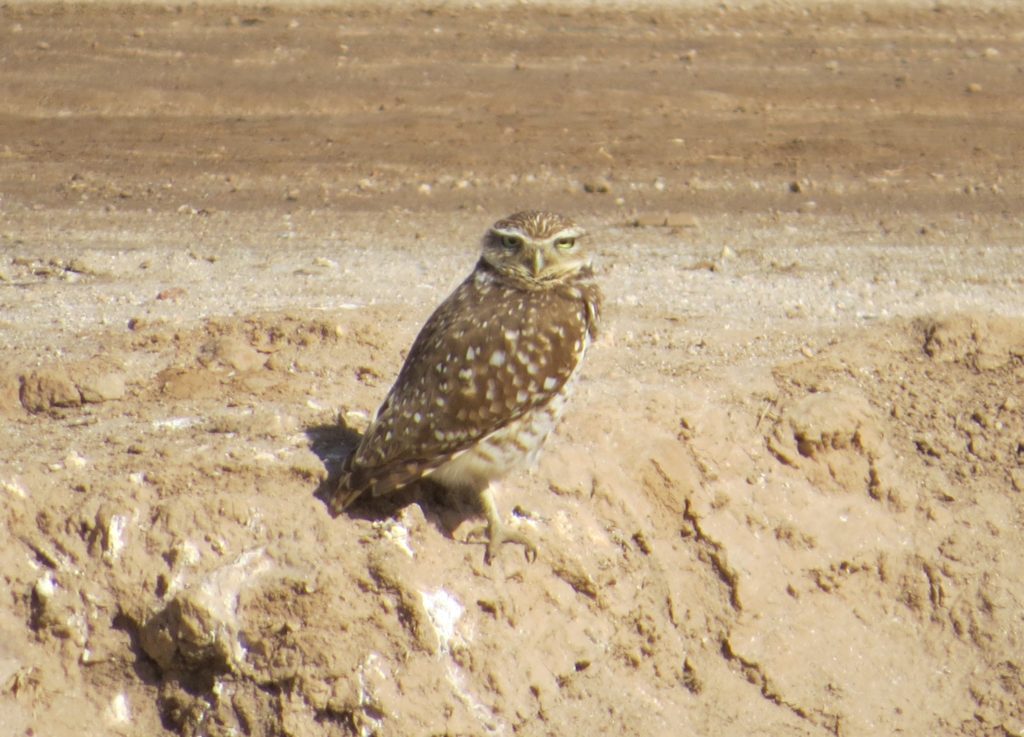 At the end of the dead end road, Tomy finally heard it–a Crissal Thrasher. Unfortunately no views were had of the true curve-billed Thrasher. So it goes. It’s hard to have any misgivings or least find anyone sympathetic whining about not seeing a CRTH when the birding had been sooo good. What’s next, Arizona? After 123 life birds in eight trips, I seriously have no idea and no plans.
At the end of the dead end road, Tomy finally heard it–a Crissal Thrasher. Unfortunately no views were had of the true curve-billed Thrasher. So it goes. It’s hard to have any misgivings or least find anyone sympathetic whining about not seeing a CRTH when the birding had been sooo good. What’s next, Arizona? After 123 life birds in eight trips, I seriously have no idea and no plans.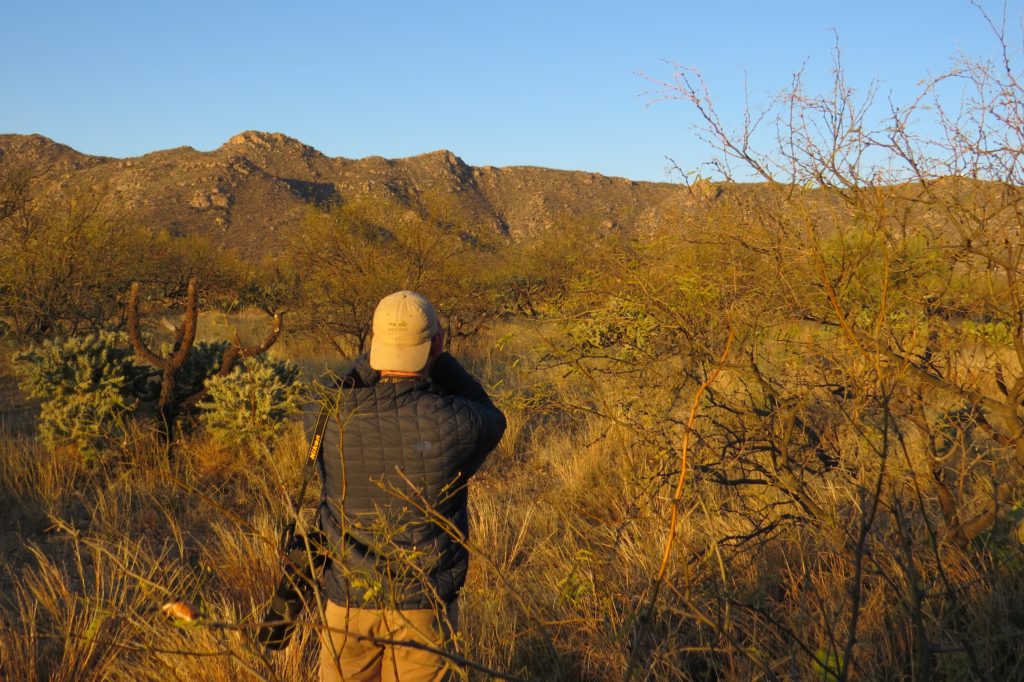
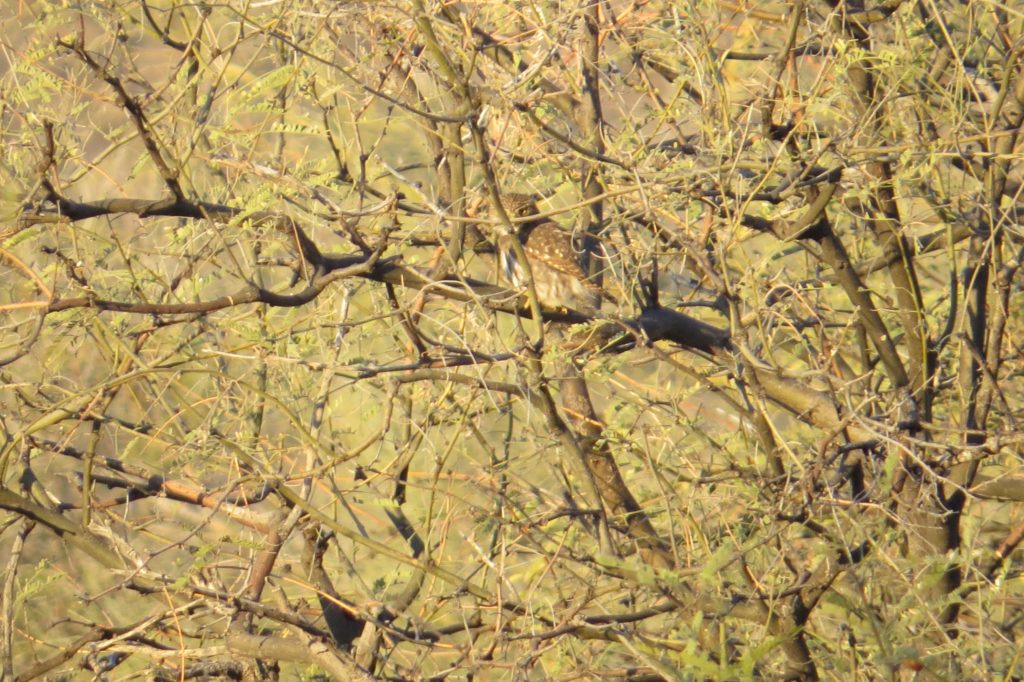
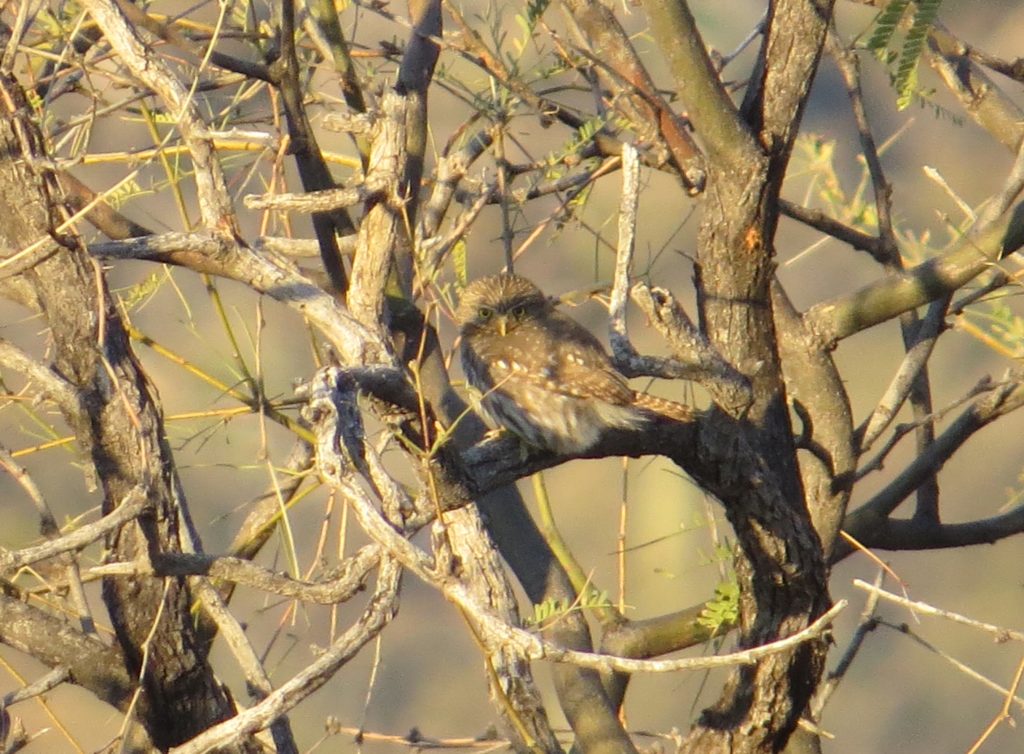
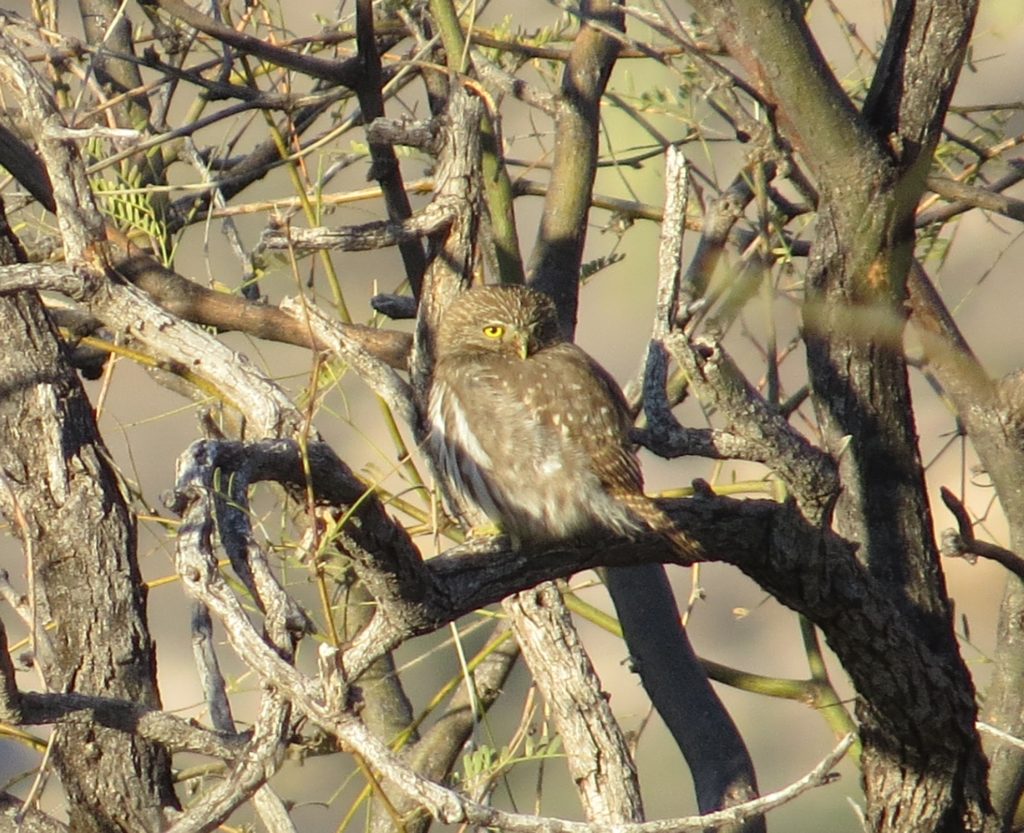
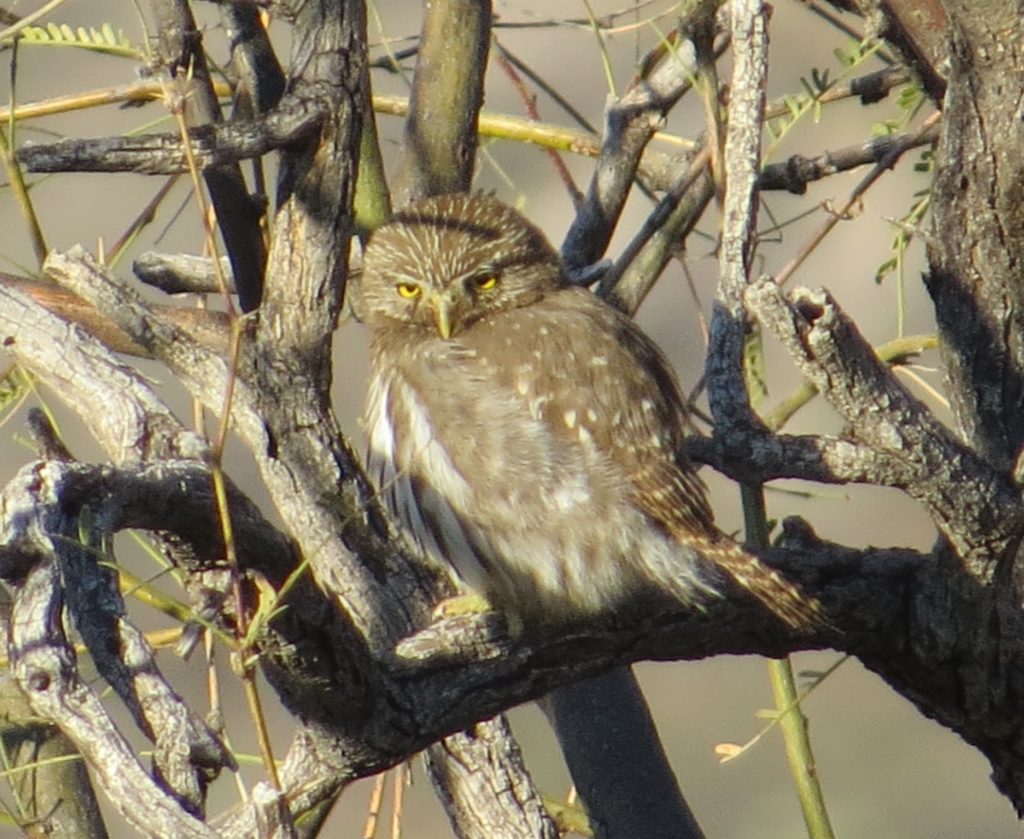 Note the black, false “eyes” on the back of its head to ward off predators.
Note the black, false “eyes” on the back of its head to ward off predators.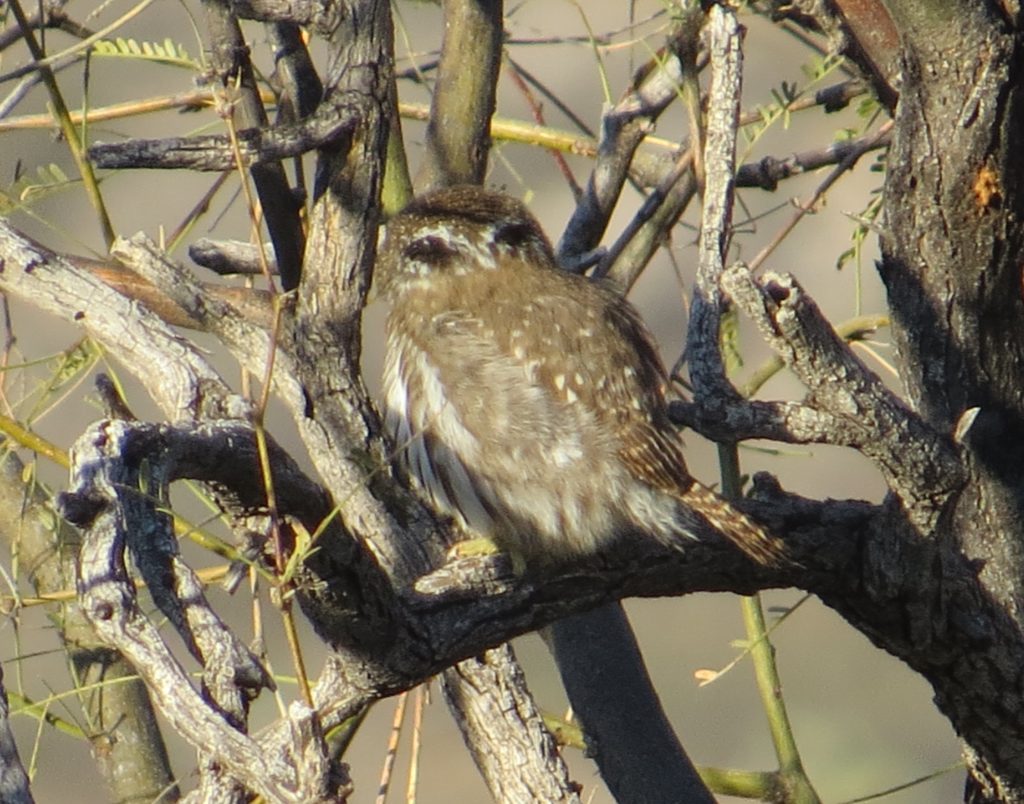 Here you can see a white throat patch that is visible when it vocalizes.
Here you can see a white throat patch that is visible when it vocalizes.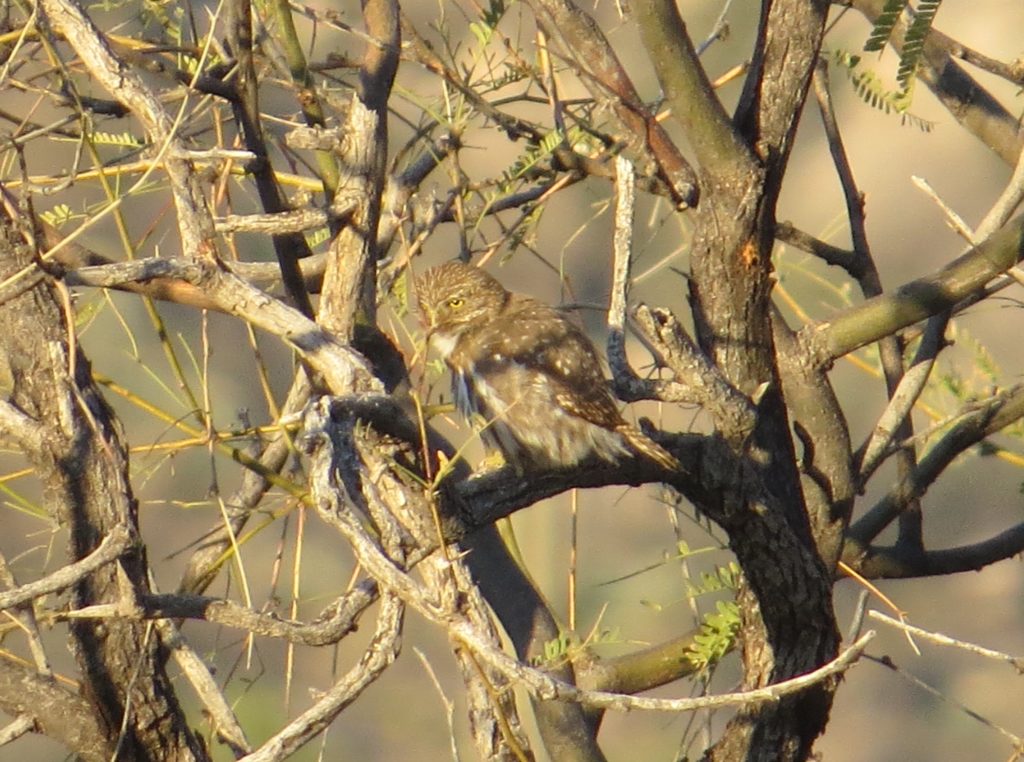 This is a short clip of the FEPO vocalizing.
This is a short clip of the FEPO vocalizing.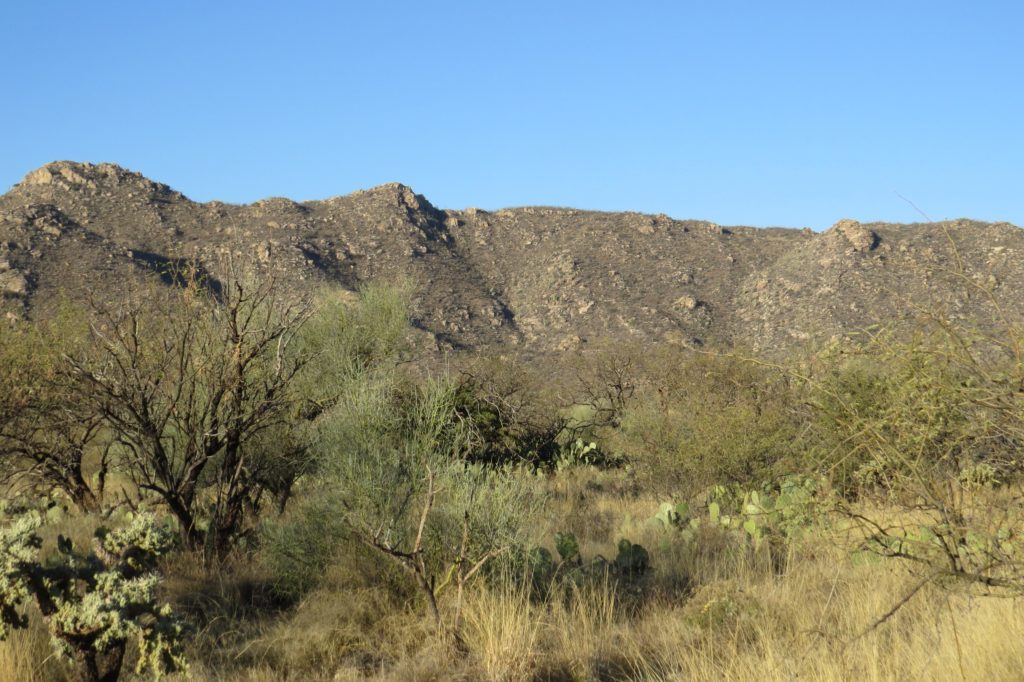
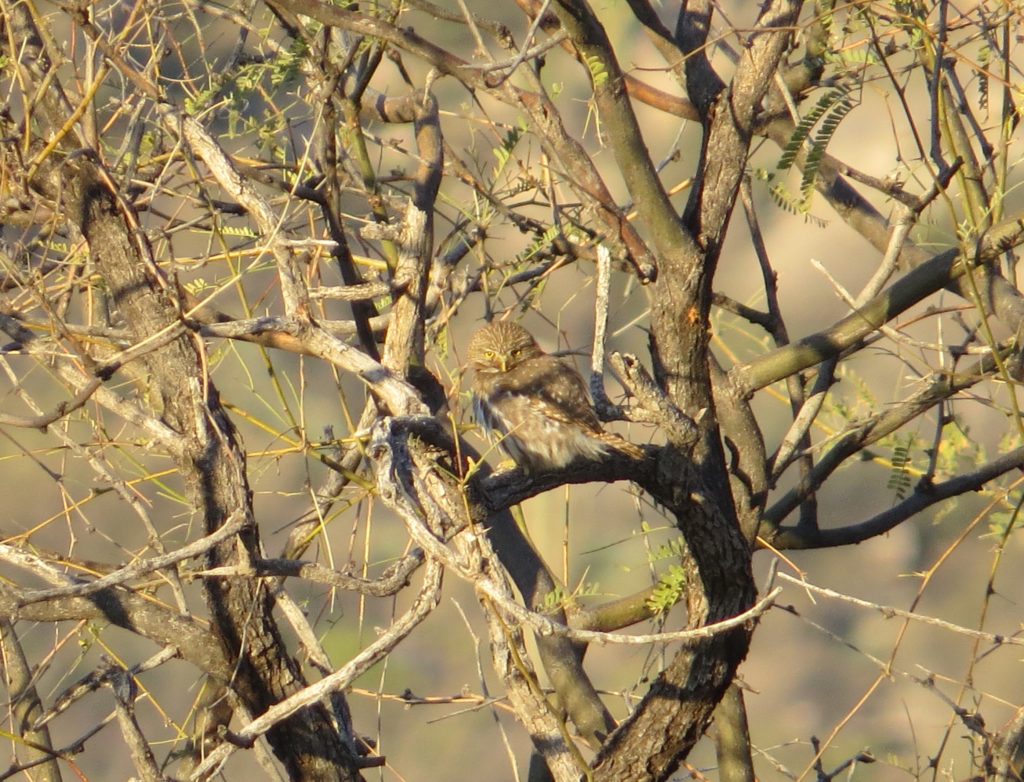 We enjoyed this Owl for the better part of an hour. For most of that time it stayed on this perch but eventually flew off. We did track it down again, but it went into deeper, thicker vegetation with worse views.
We enjoyed this Owl for the better part of an hour. For most of that time it stayed on this perch but eventually flew off. We did track it down again, but it went into deeper, thicker vegetation with worse views.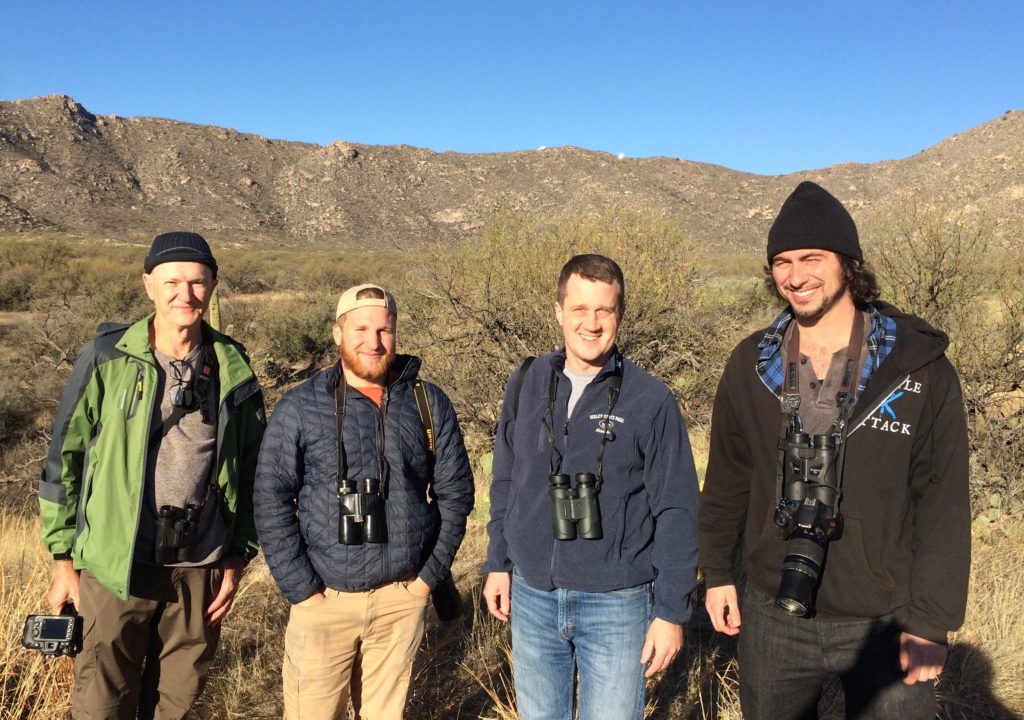 The views here are spectacular, even more so after just freshly lifering on Ferruginous Pygmy-Owl to complete the 19-Owl sweep. I don’t know about the rest of the guys, but there was definitely a bonce in my step on the way out.
The views here are spectacular, even more so after just freshly lifering on Ferruginous Pygmy-Owl to complete the 19-Owl sweep. I don’t know about the rest of the guys, but there was definitely a bonce in my step on the way out.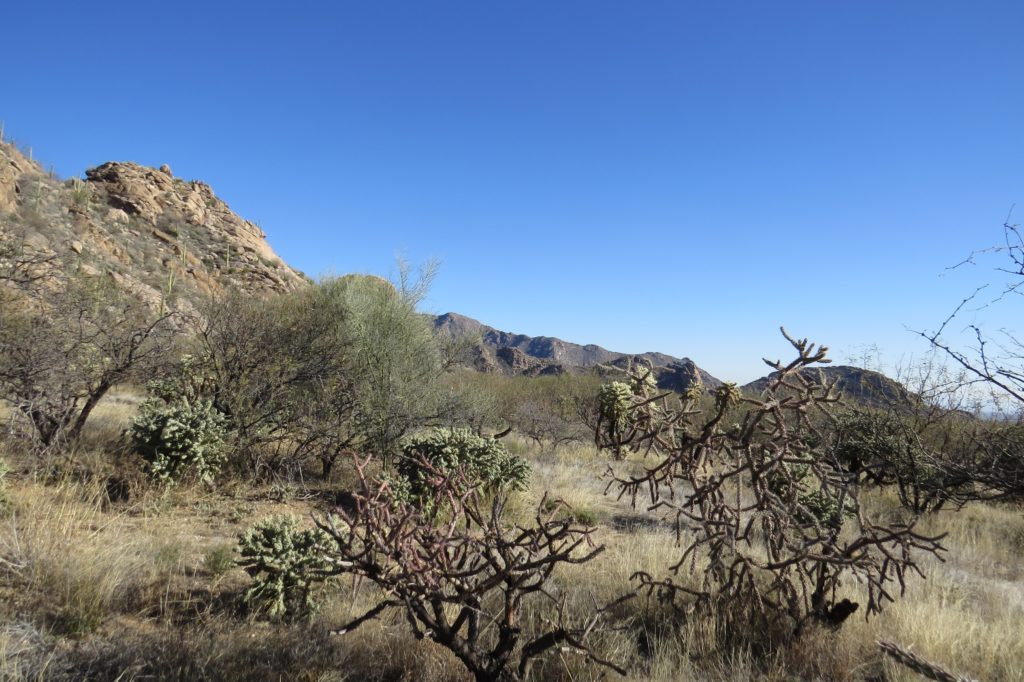
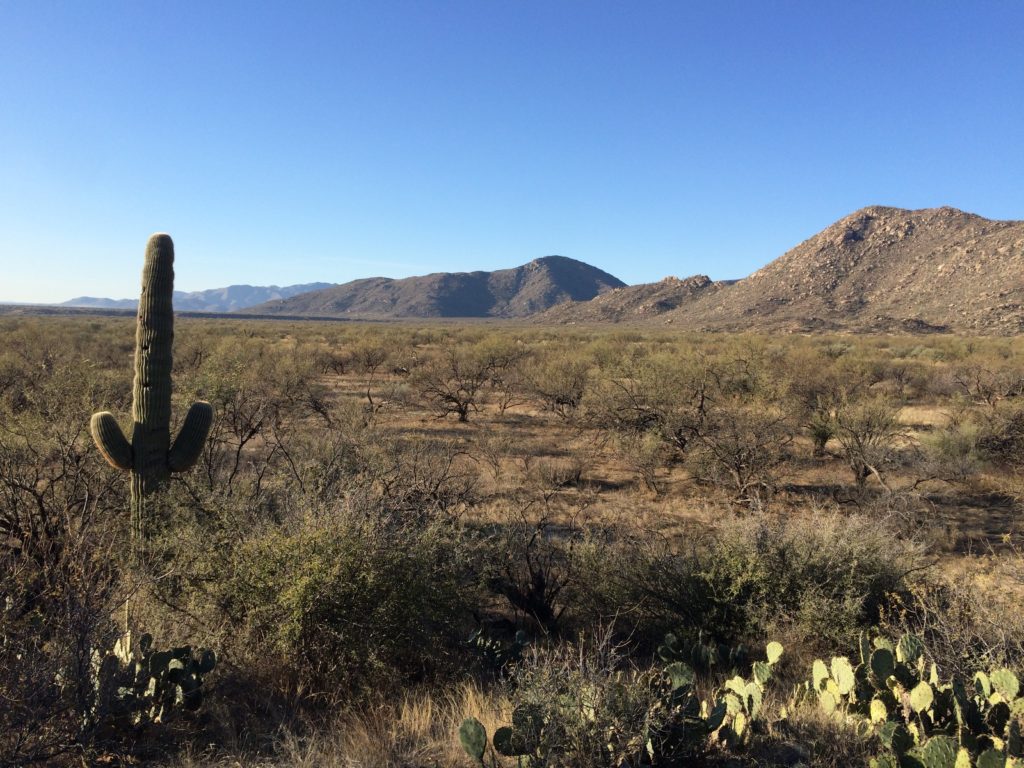
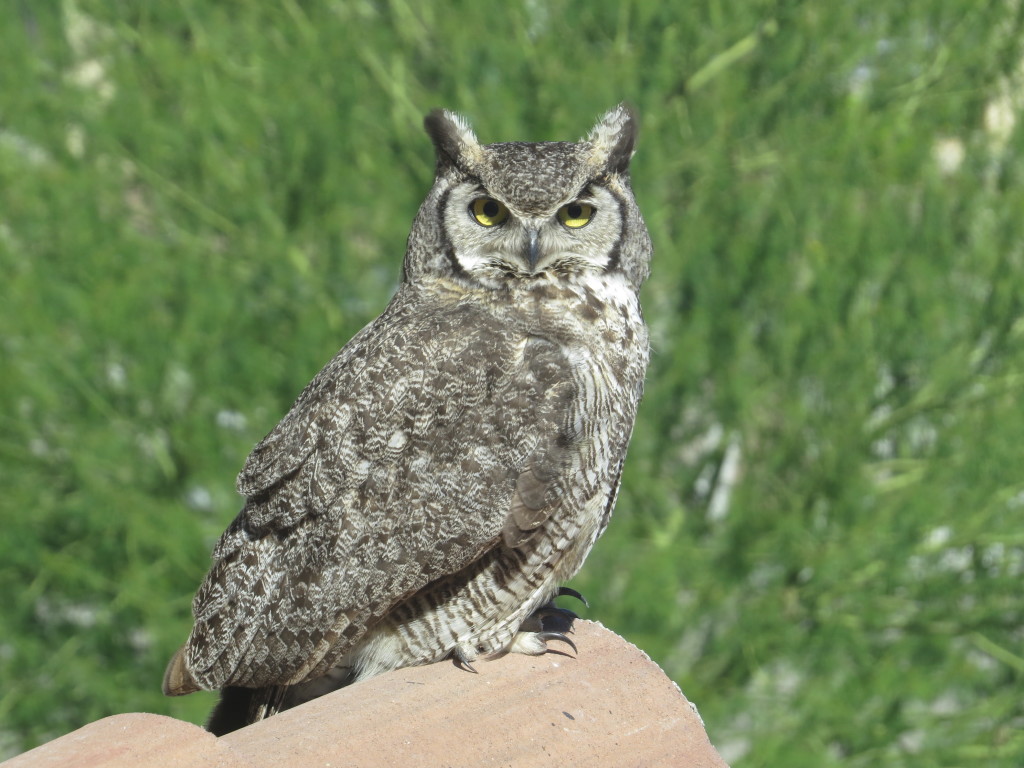
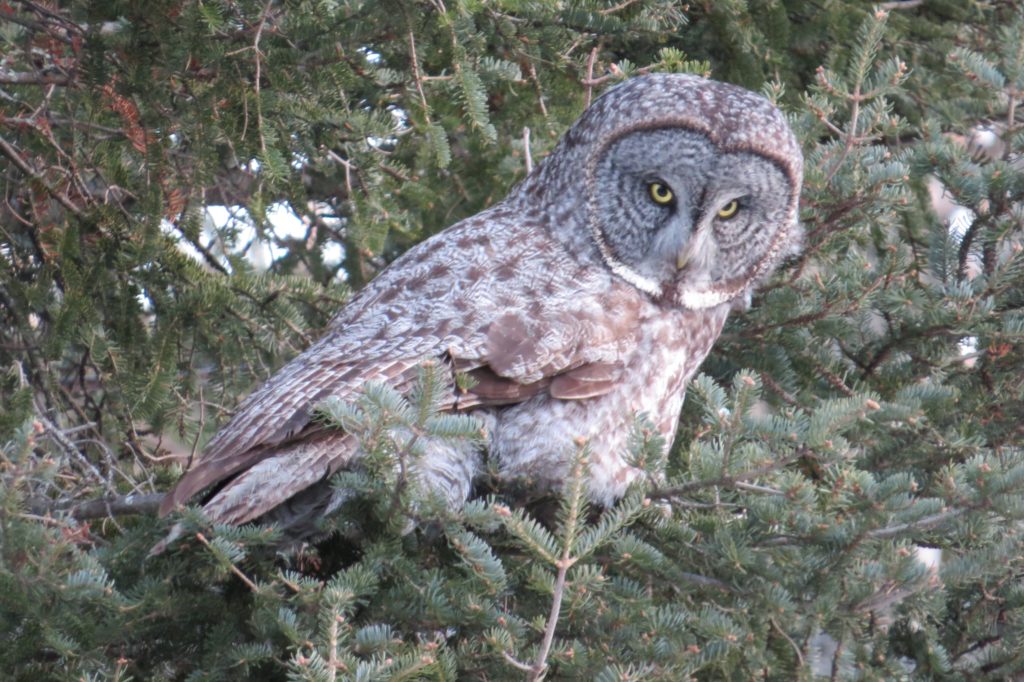
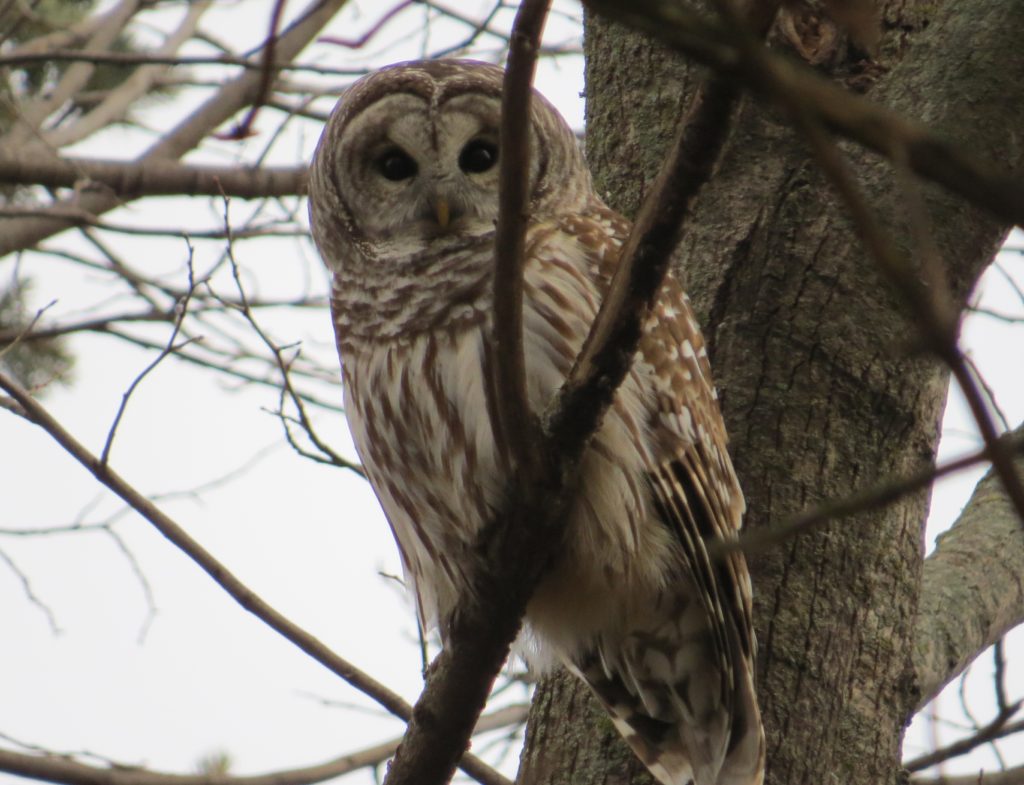
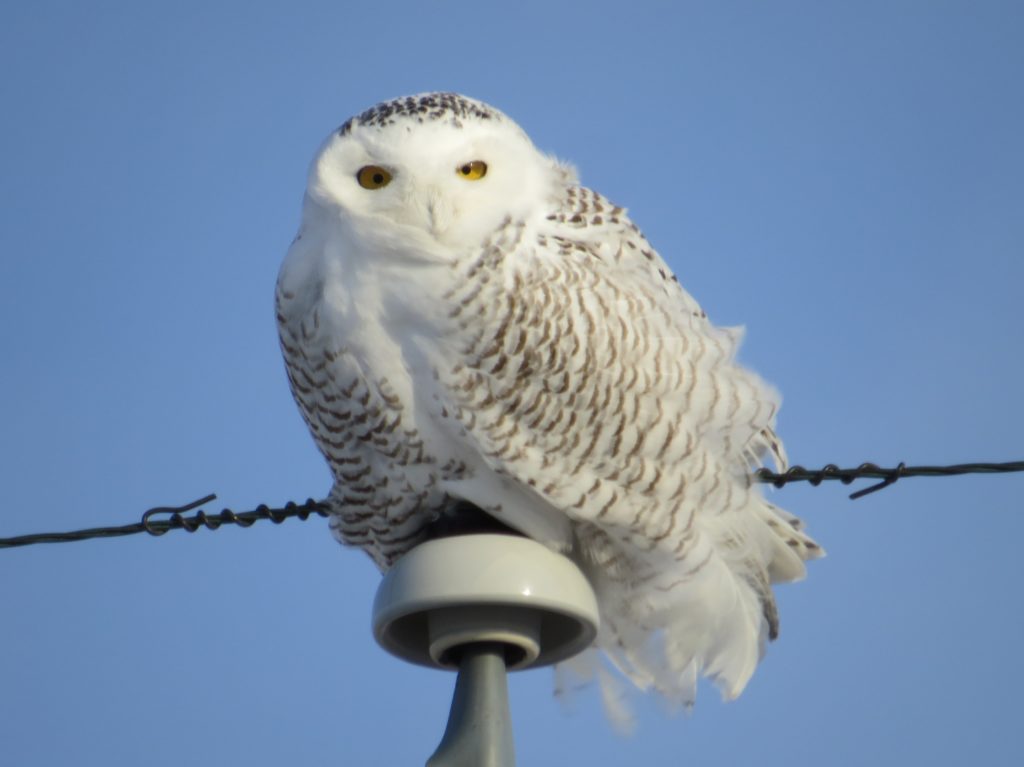
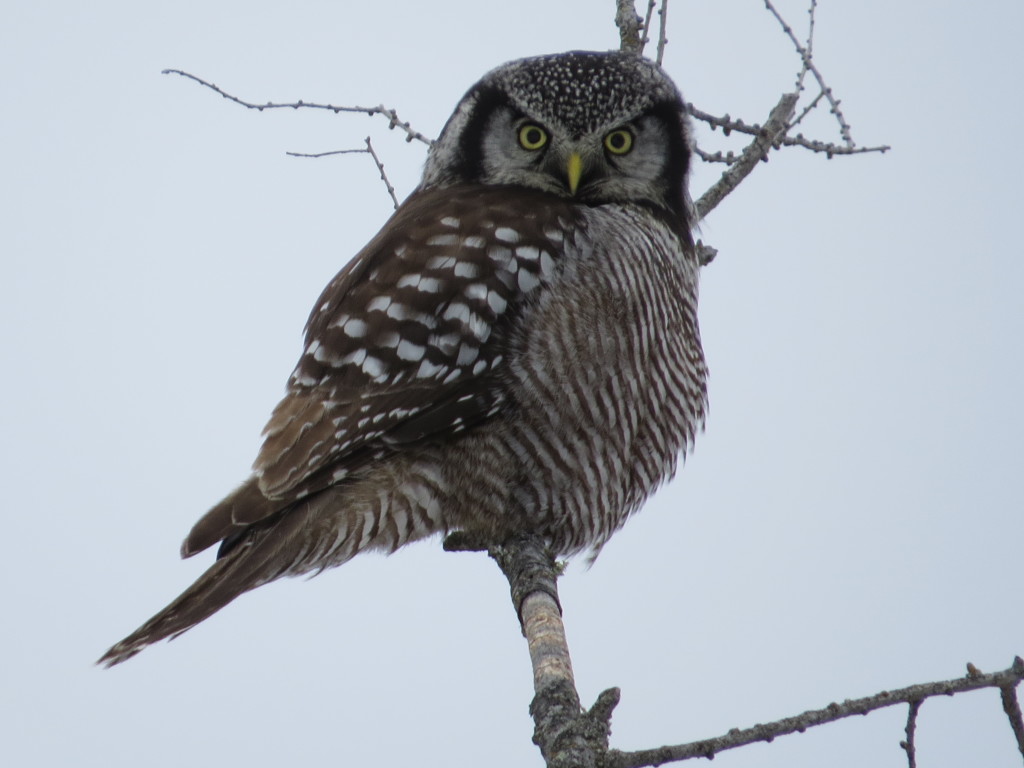
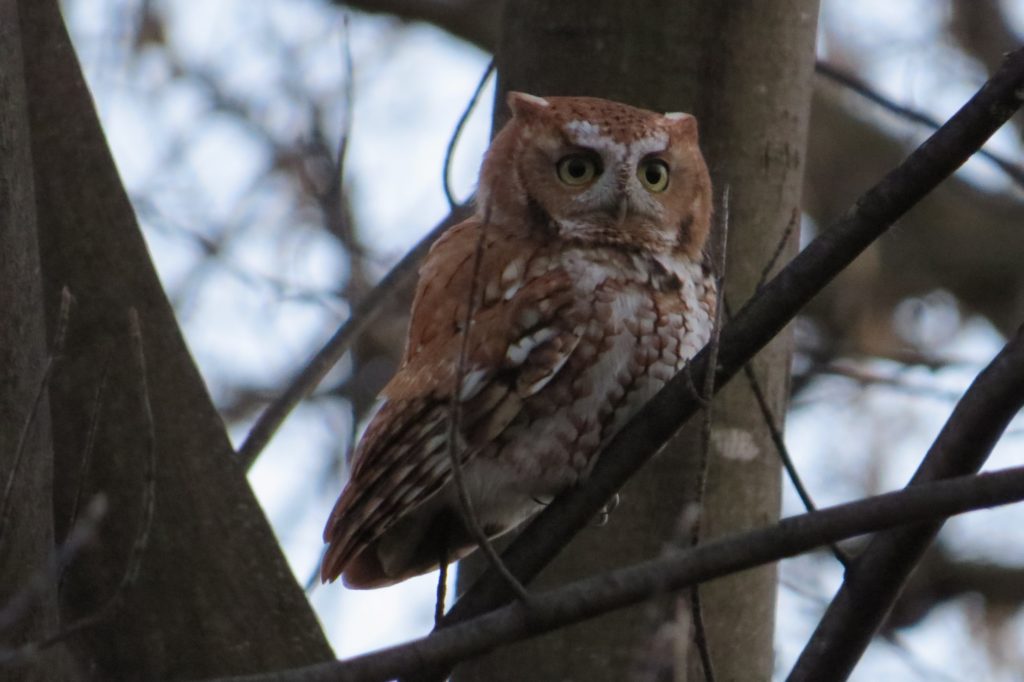
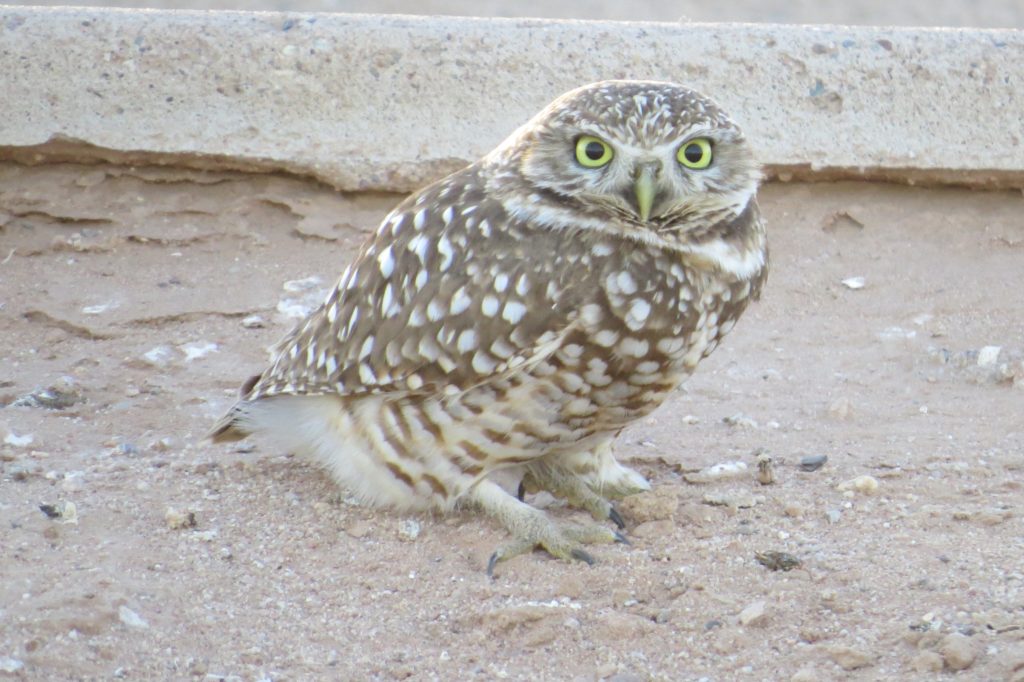 #8 Long-eared Owl
#8 Long-eared Owl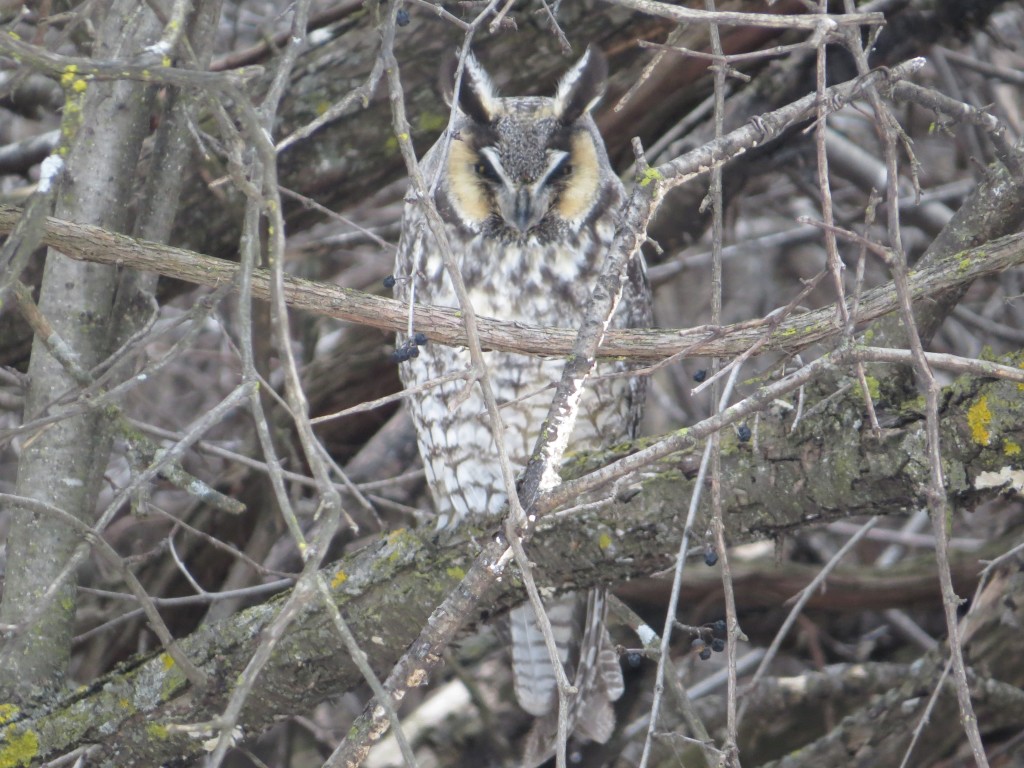
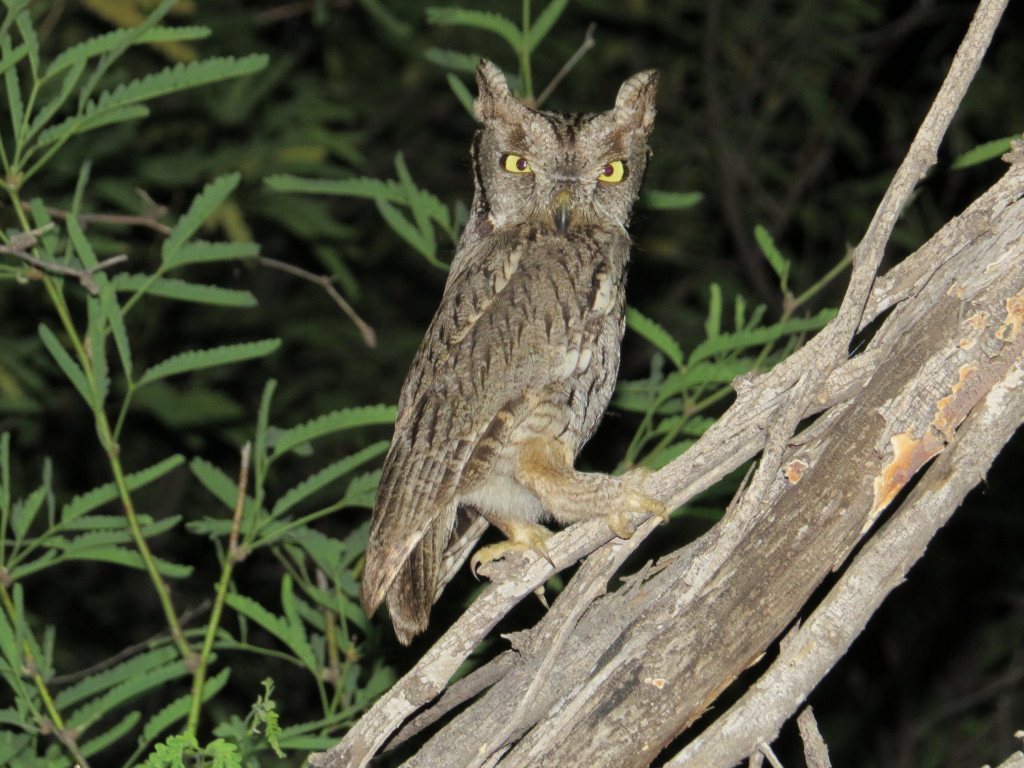
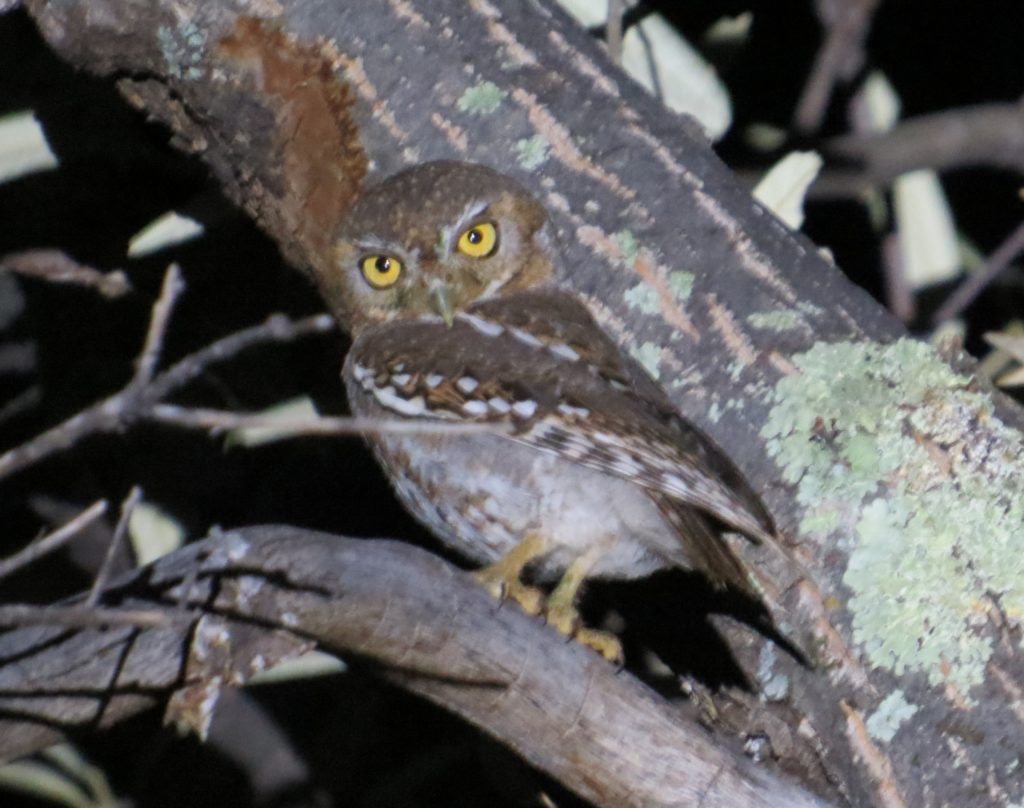
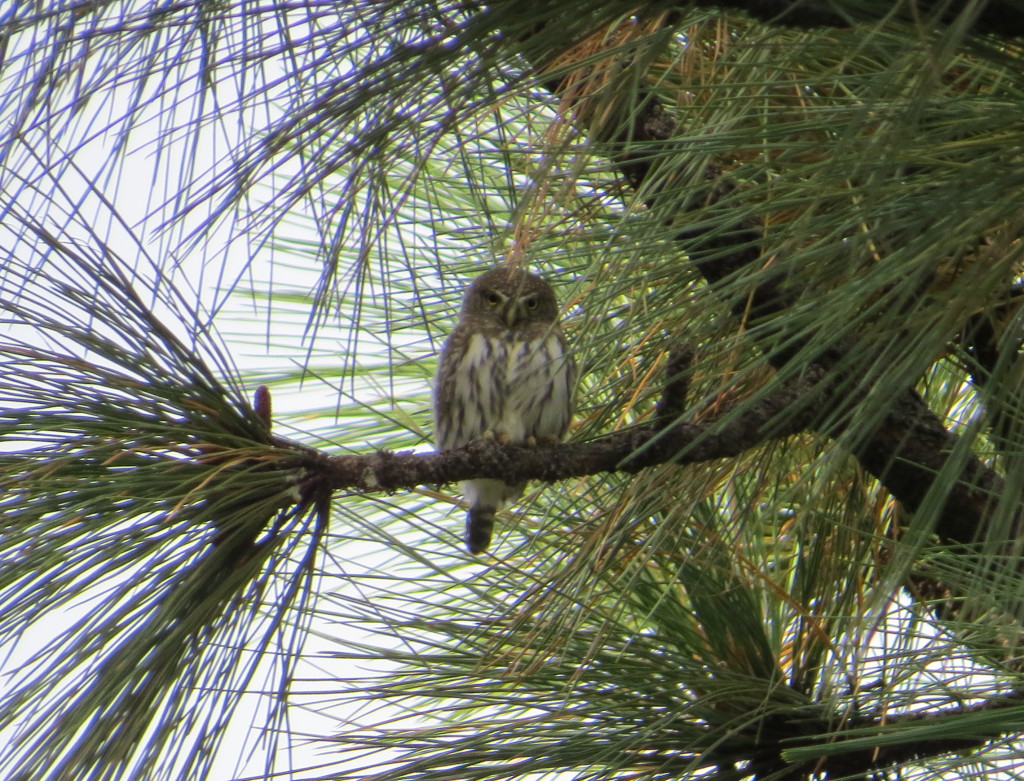
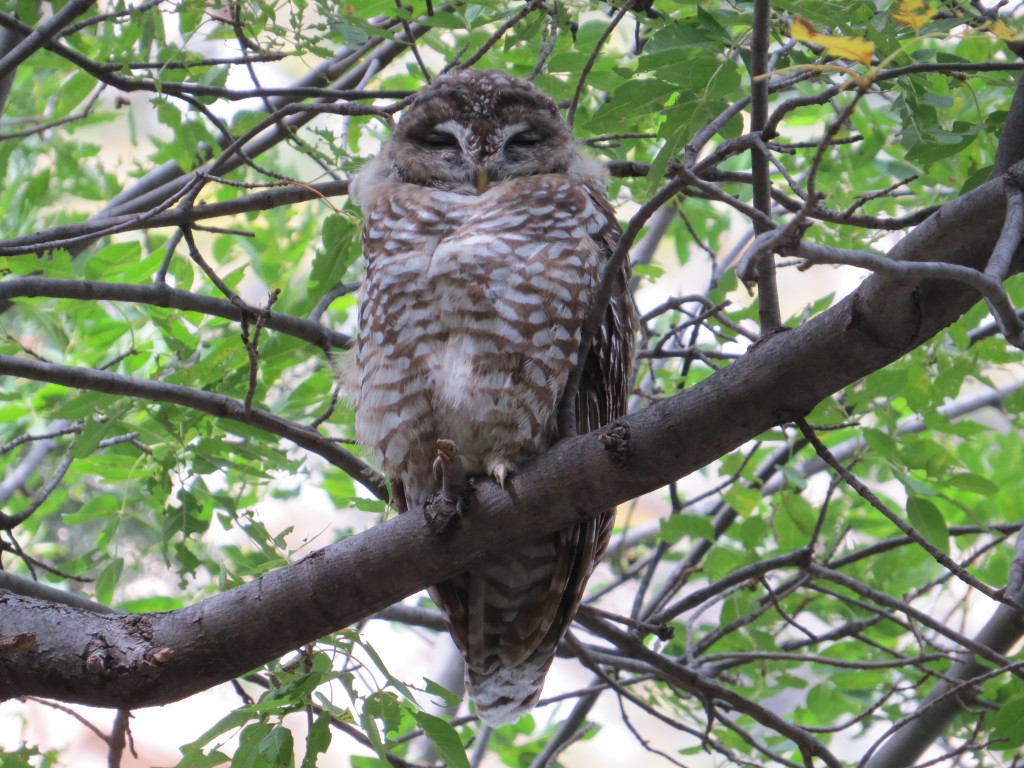
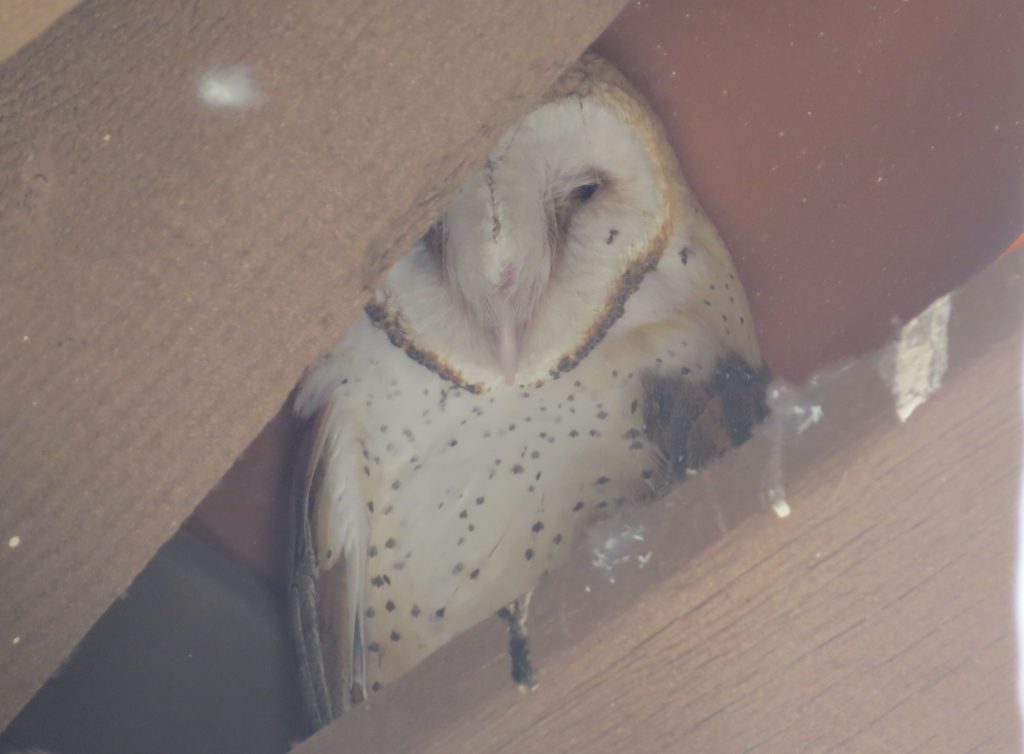
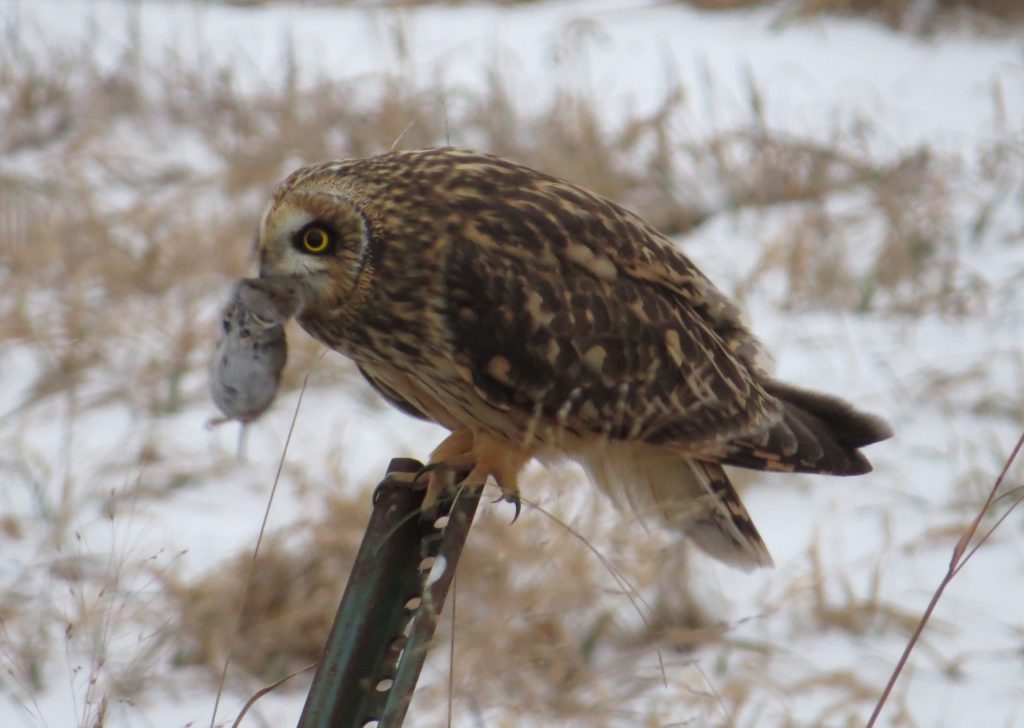 #15 Northern Saw-whet Owl
#15 Northern Saw-whet Owl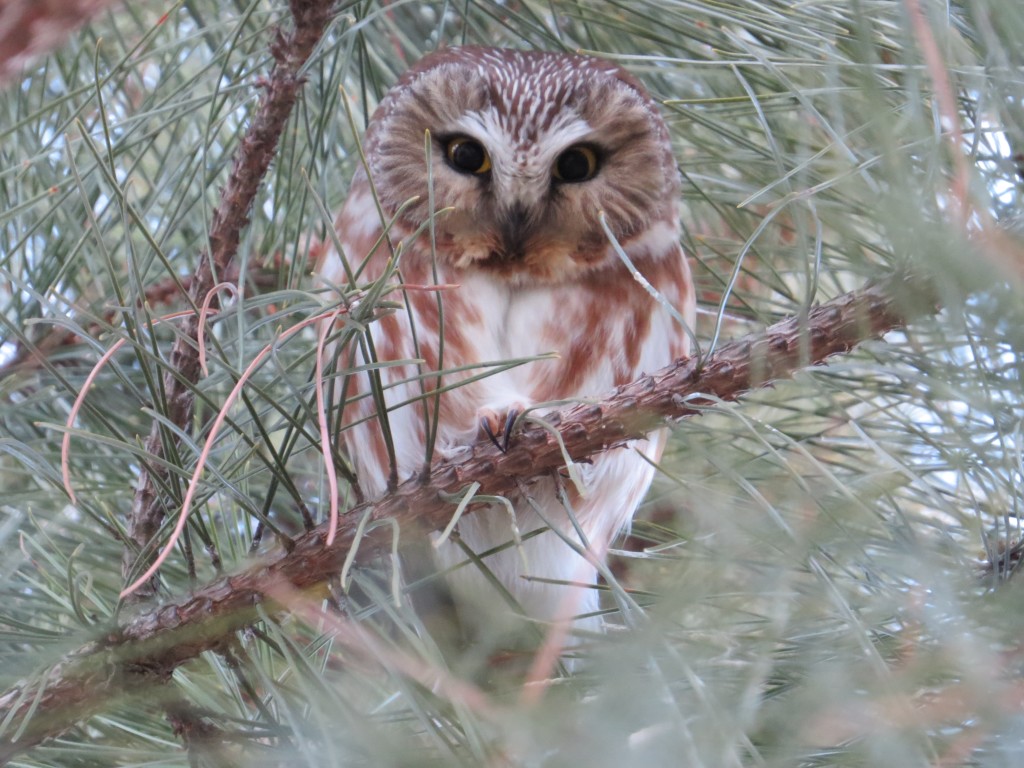
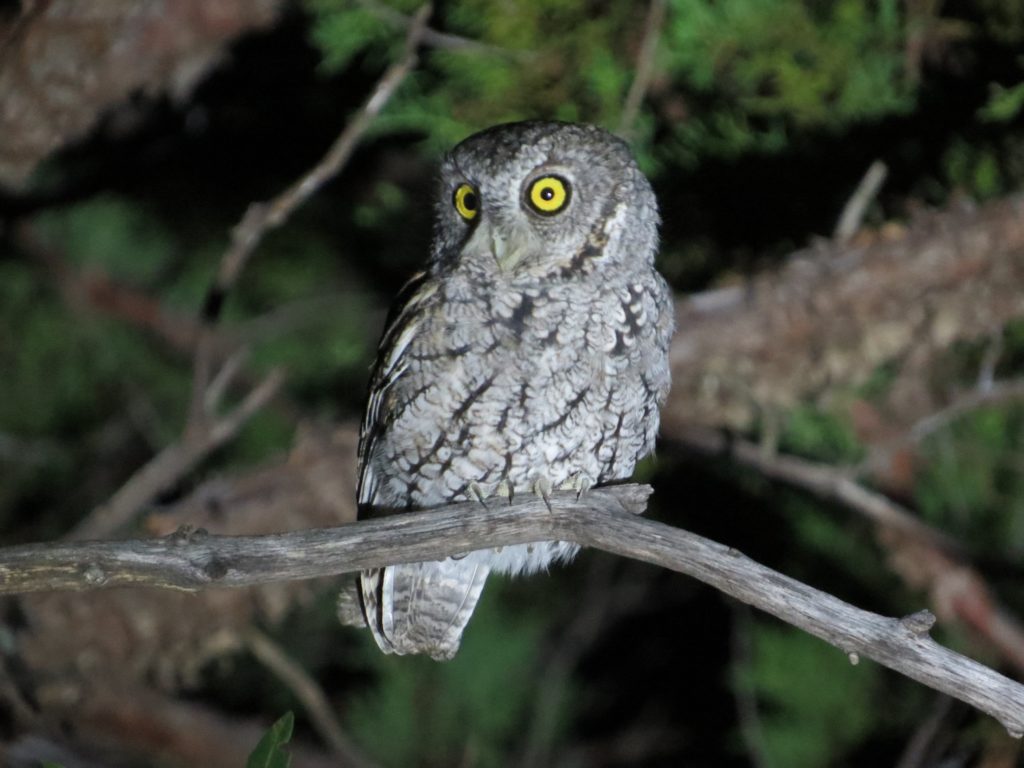
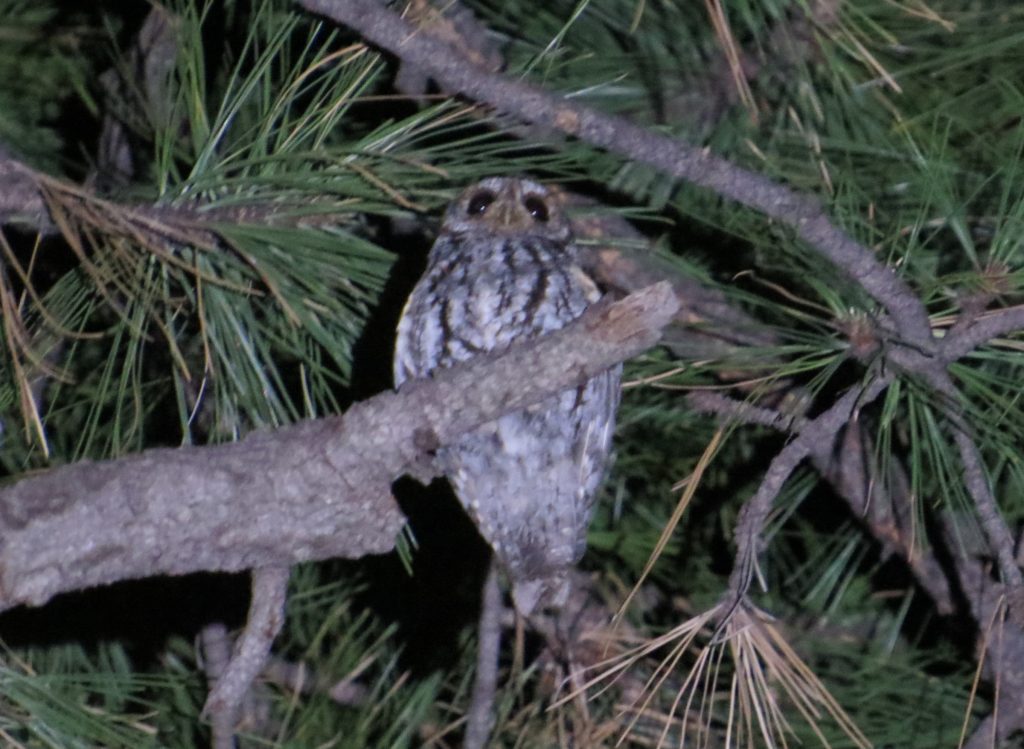
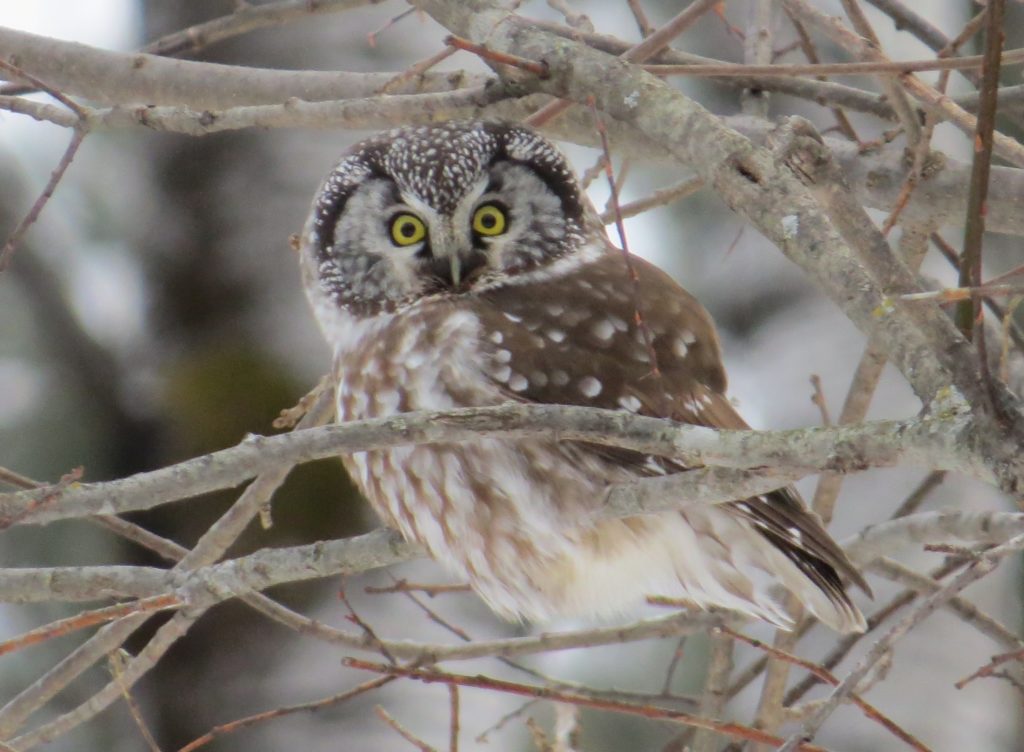
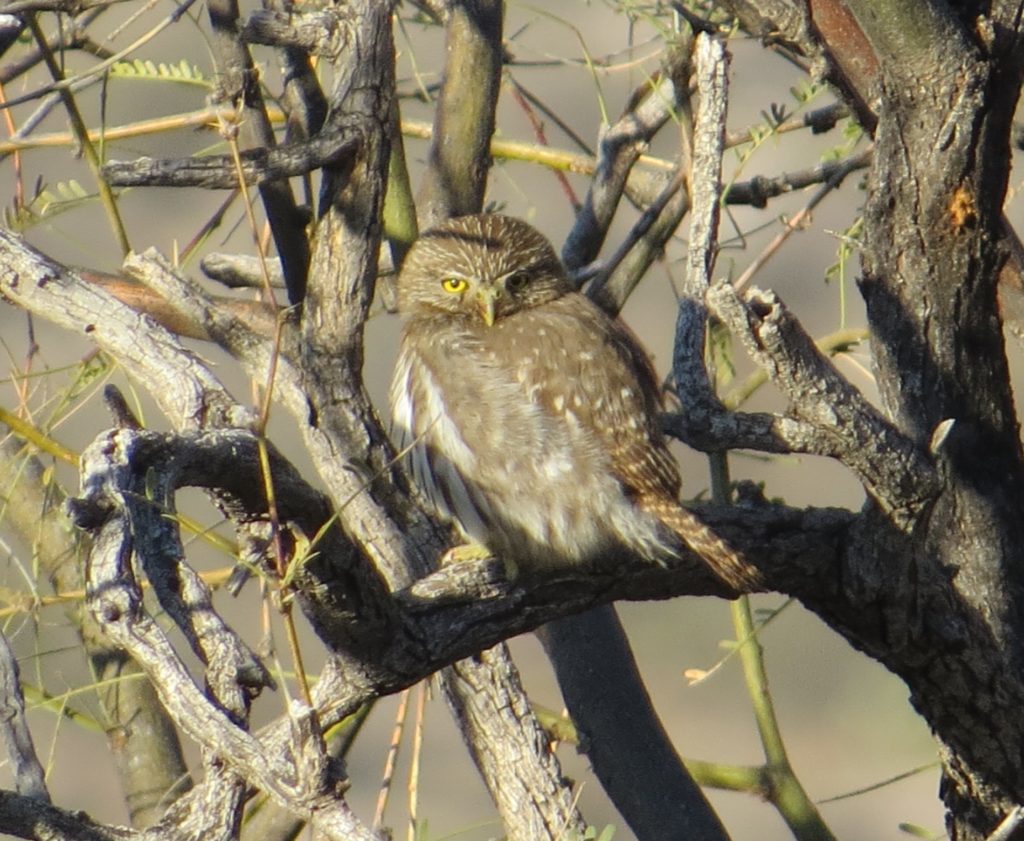
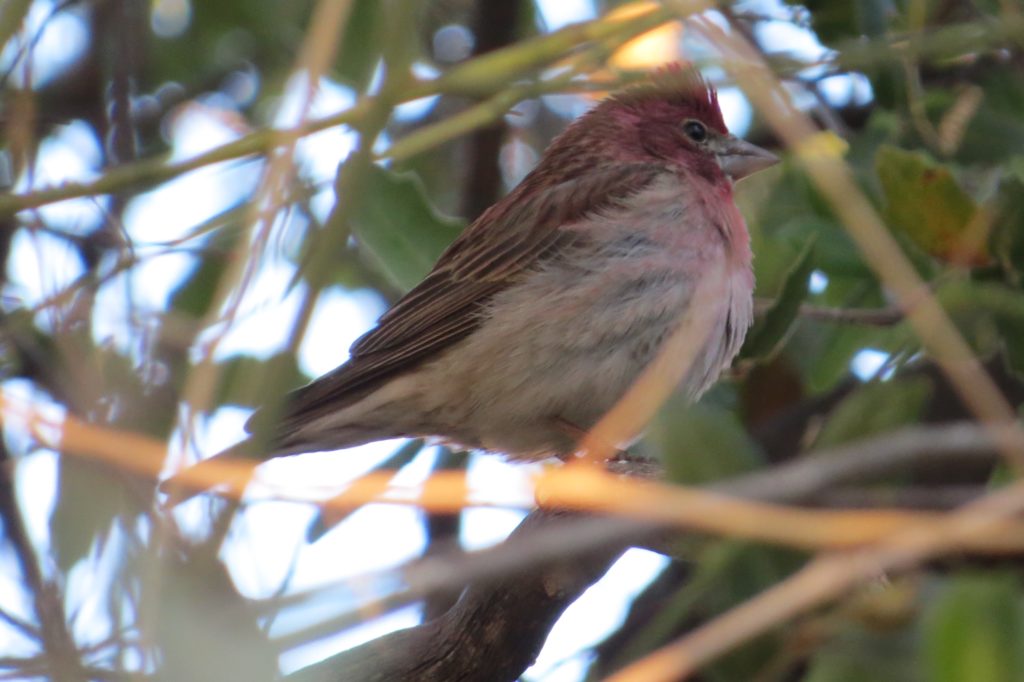
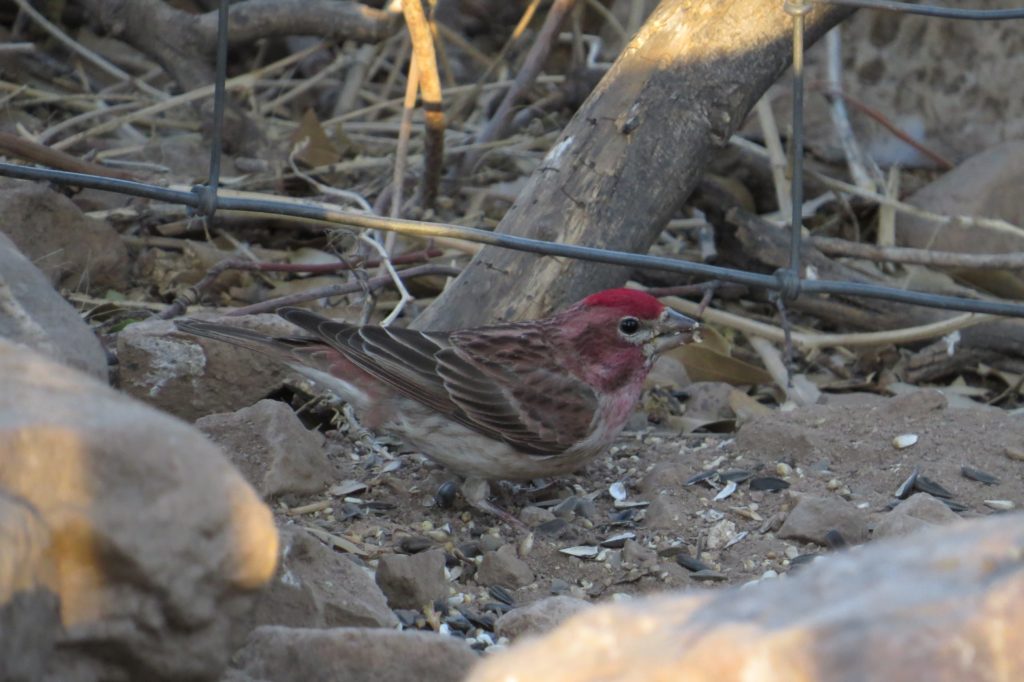 We barely had any time to enjoy the Cassin’s Finch warm-up band before the real head-banging act materialized suddenly, shocking and awing a crowd too afraid to move or breathe, lest the show be over for good.
We barely had any time to enjoy the Cassin’s Finch warm-up band before the real head-banging act materialized suddenly, shocking and awing a crowd too afraid to move or breathe, lest the show be over for good.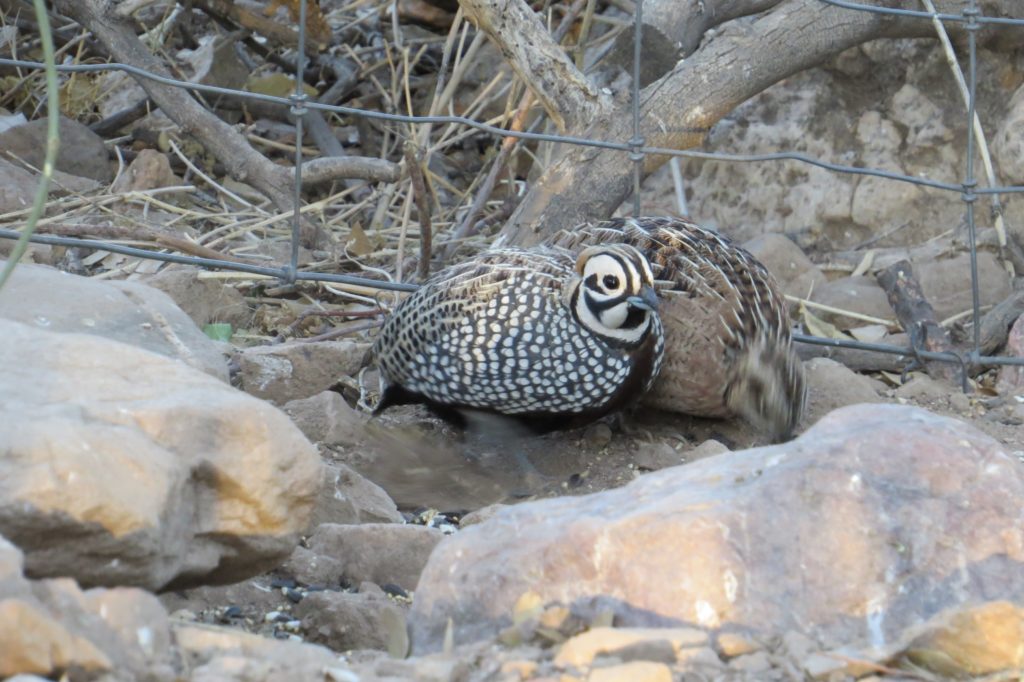
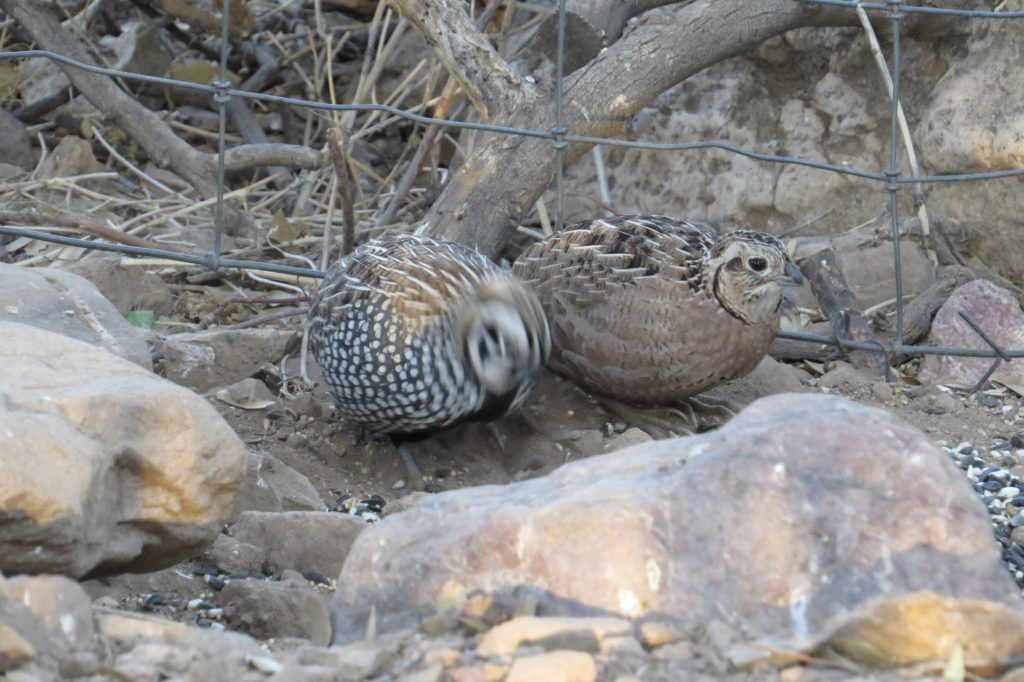
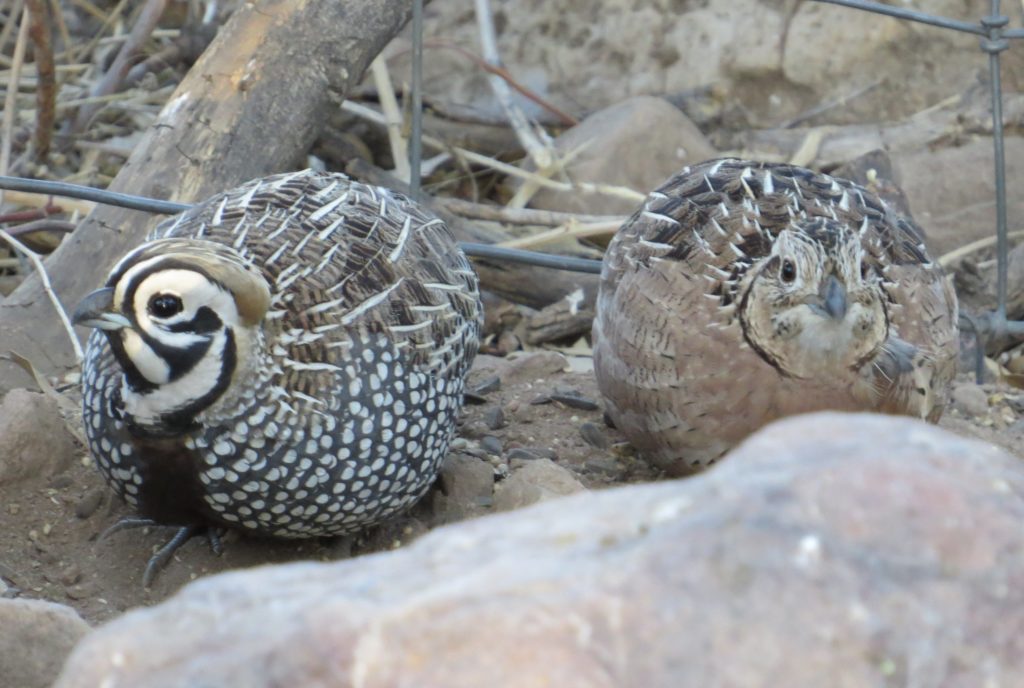
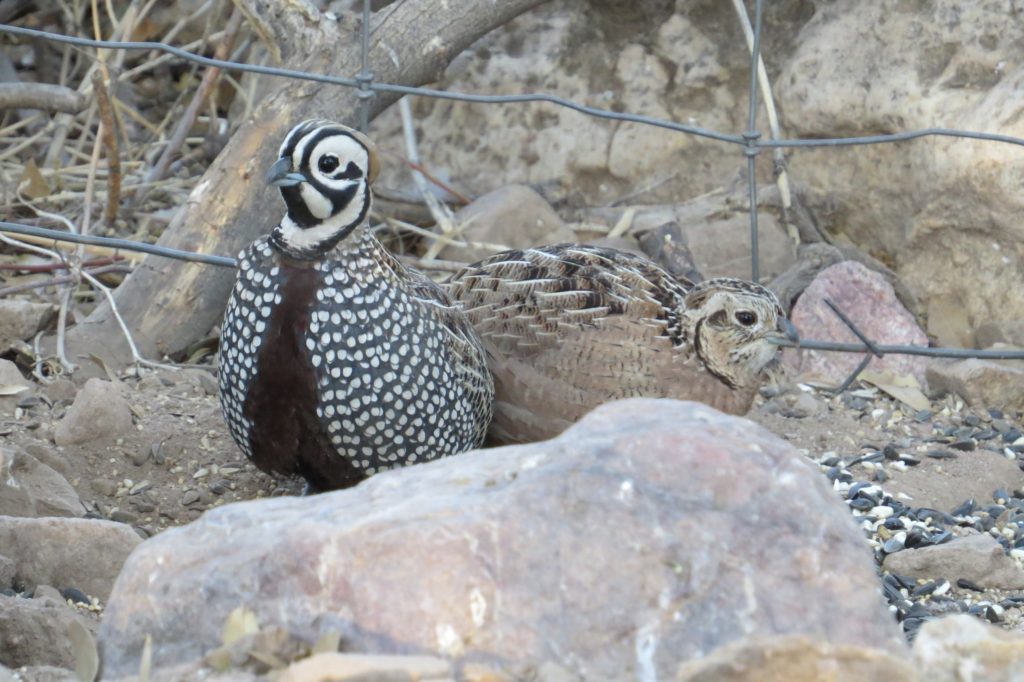
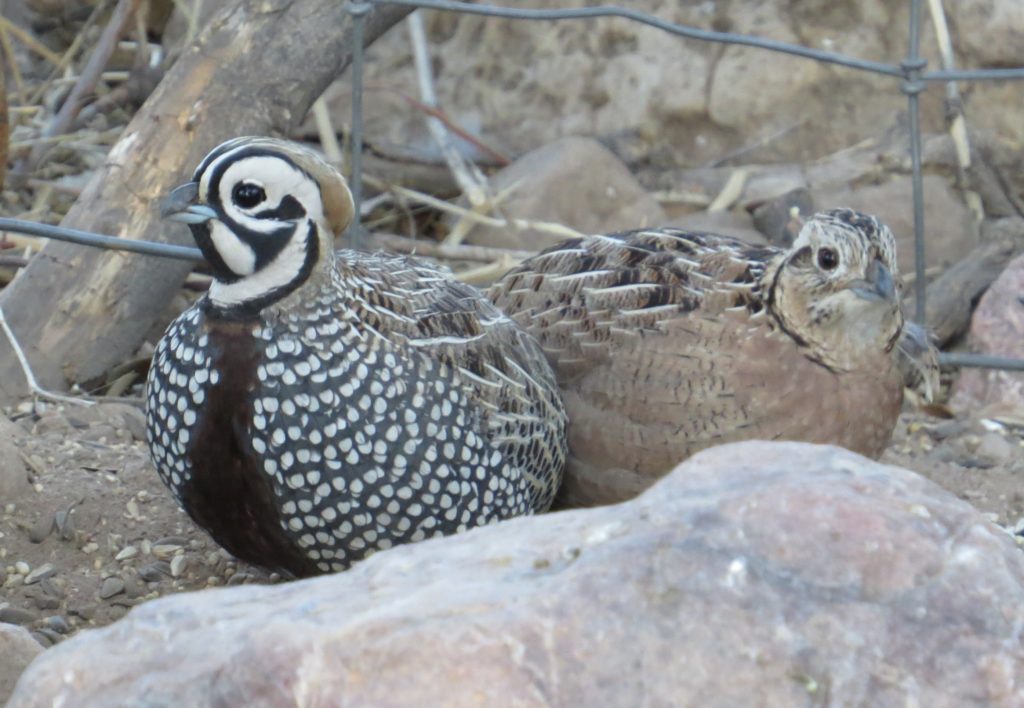 It was not the Ferruginous Pygmy-Owl I craved, but the Montezuma Quail was one of those birds that can make an entire trip. Not only was it a key lifer for Steve and me, but this was Tommy’s first time photographing this species. It was a high for the entire group.
It was not the Ferruginous Pygmy-Owl I craved, but the Montezuma Quail was one of those birds that can make an entire trip. Not only was it a key lifer for Steve and me, but this was Tommy’s first time photographing this species. It was a high for the entire group.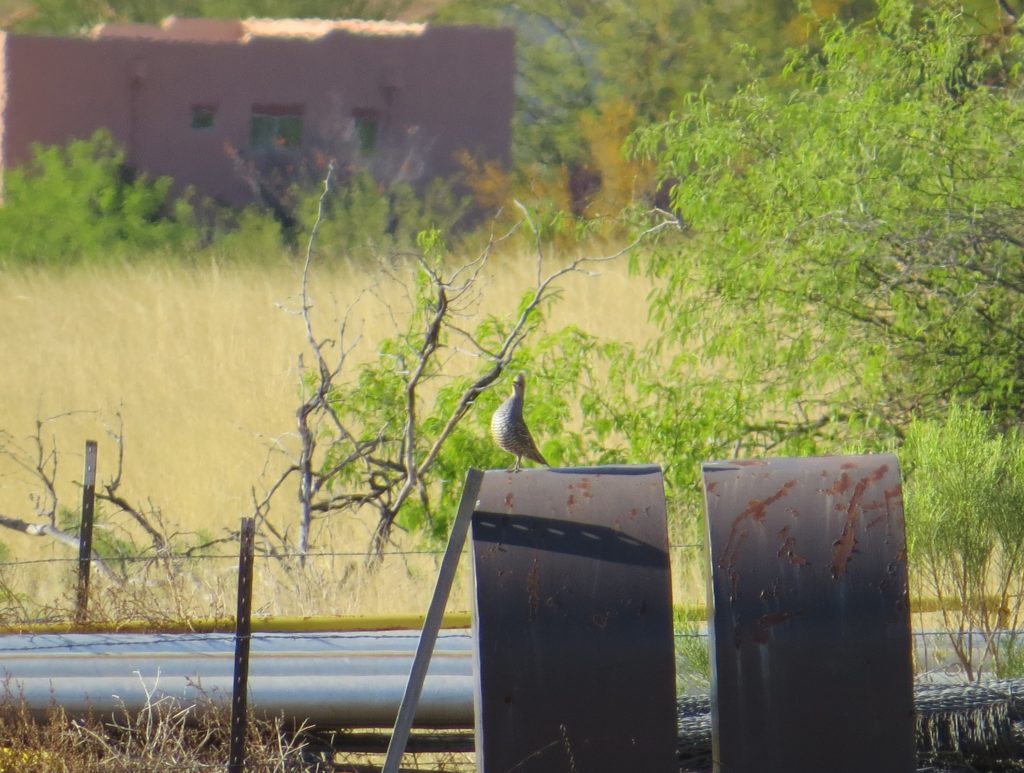 On our to-do list was to hit up Miller Canyon next to try to get Steve a Spotted Owl lifer, among others. This whole time that Fan-tailed Warbler report was still on all of our minds. Strangely, there had been no word the previous day or this morning. It was odd considering it was such a mega rarity. I finally heard from Chris Rohrer that the Warbler had been seen Saturday by numerous people AND that it was still there this morning. We decided to do Miller Canyon as planned since we were so close. What hadn’t been decided yet was if we were going after the Warbler. A chase to the Chiricahuas in far southeastern AZ would mean the FEPO plans would have to be nixed–we had originally planned to try for FEPO again Sunday night and Monday morning before we flew out. Though the Warbler would have been a lifer for Tommy, he graciously said the decision was mine to continue with the FEPO plans or abandon them. Steve also said it didn’t matter to him as he was enjoying a plethora of new birds wherever we went. As we hiked up Miller Canyon, I didn’t know what to do. It made it tough for me to enjoy some of the canyon’s residents, many of which were lifers for Steve.
On our to-do list was to hit up Miller Canyon next to try to get Steve a Spotted Owl lifer, among others. This whole time that Fan-tailed Warbler report was still on all of our minds. Strangely, there had been no word the previous day or this morning. It was odd considering it was such a mega rarity. I finally heard from Chris Rohrer that the Warbler had been seen Saturday by numerous people AND that it was still there this morning. We decided to do Miller Canyon as planned since we were so close. What hadn’t been decided yet was if we were going after the Warbler. A chase to the Chiricahuas in far southeastern AZ would mean the FEPO plans would have to be nixed–we had originally planned to try for FEPO again Sunday night and Monday morning before we flew out. Though the Warbler would have been a lifer for Tommy, he graciously said the decision was mine to continue with the FEPO plans or abandon them. Steve also said it didn’t matter to him as he was enjoying a plethora of new birds wherever we went. As we hiked up Miller Canyon, I didn’t know what to do. It made it tough for me to enjoy some of the canyon’s residents, many of which were lifers for Steve.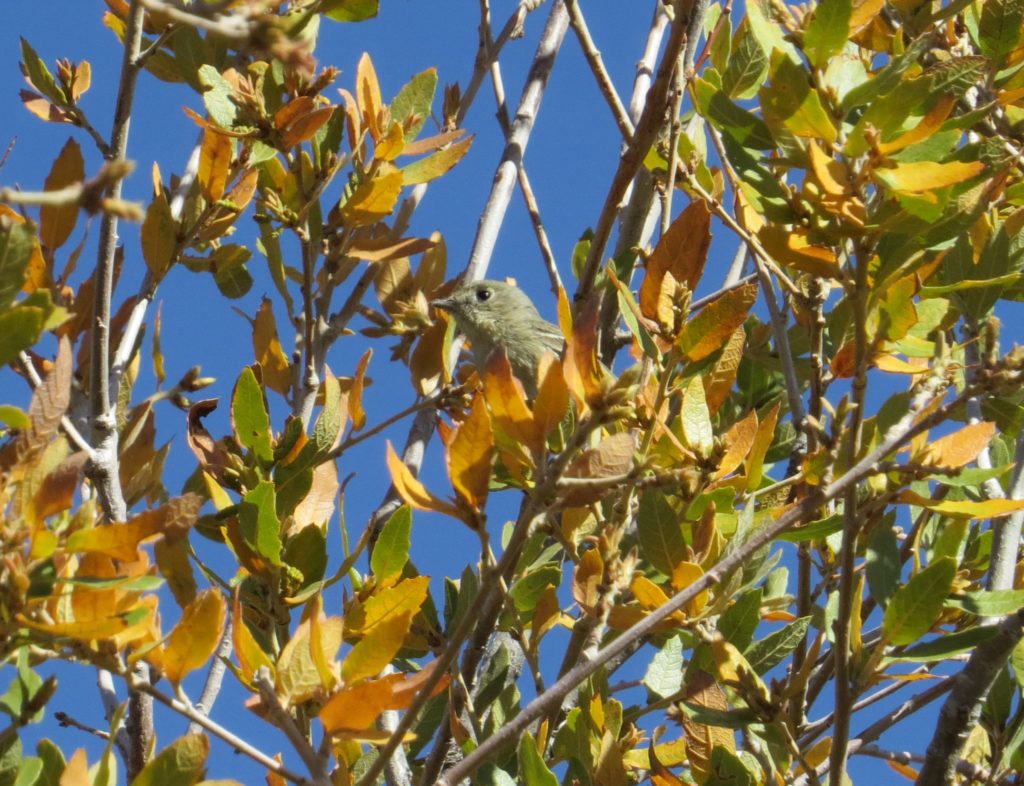
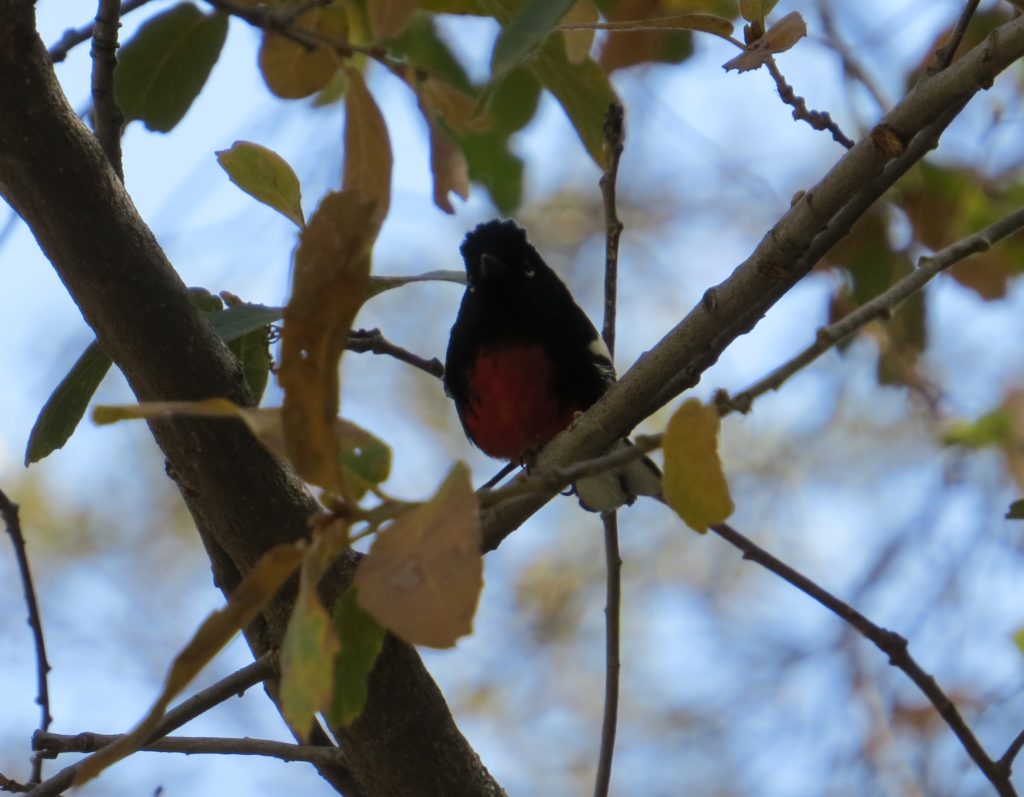
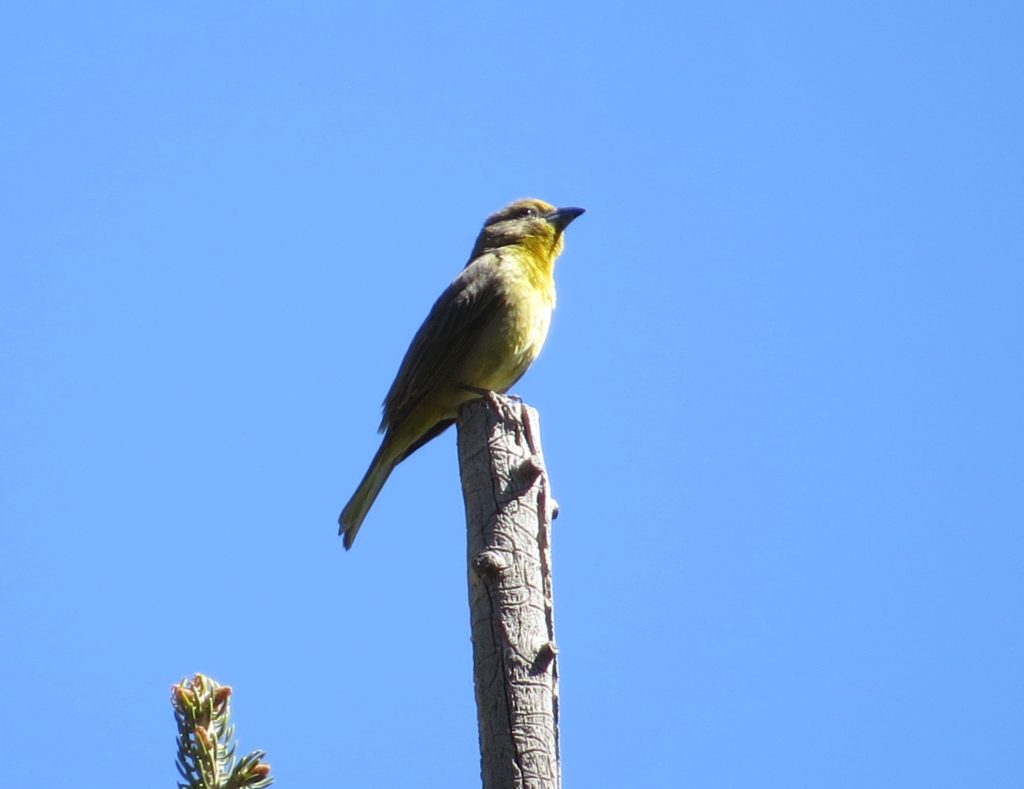
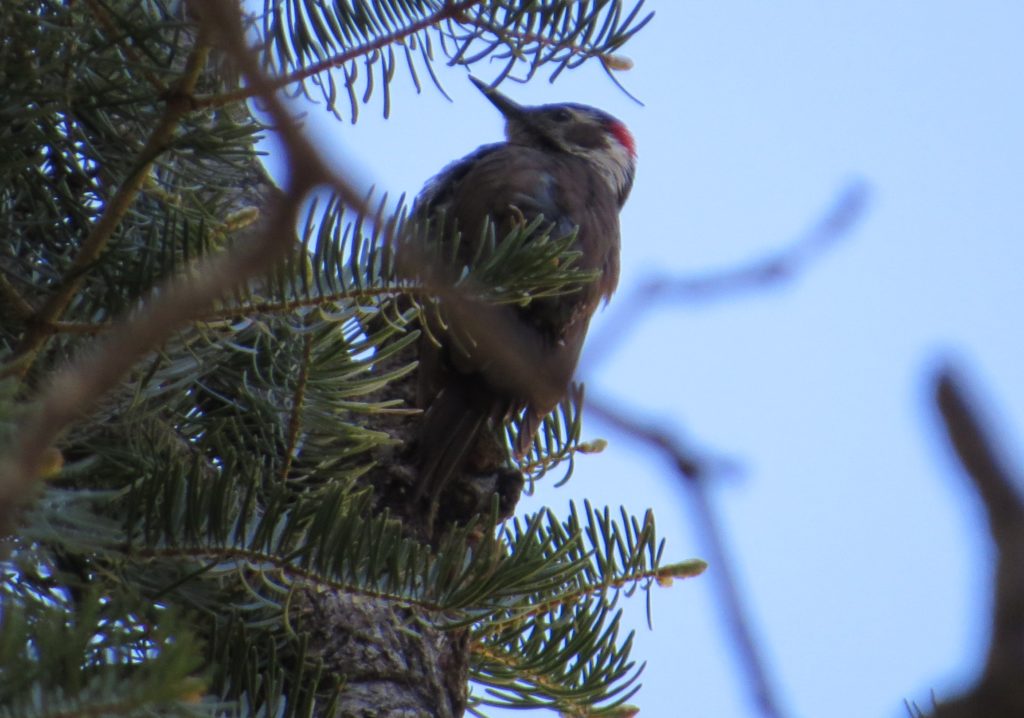
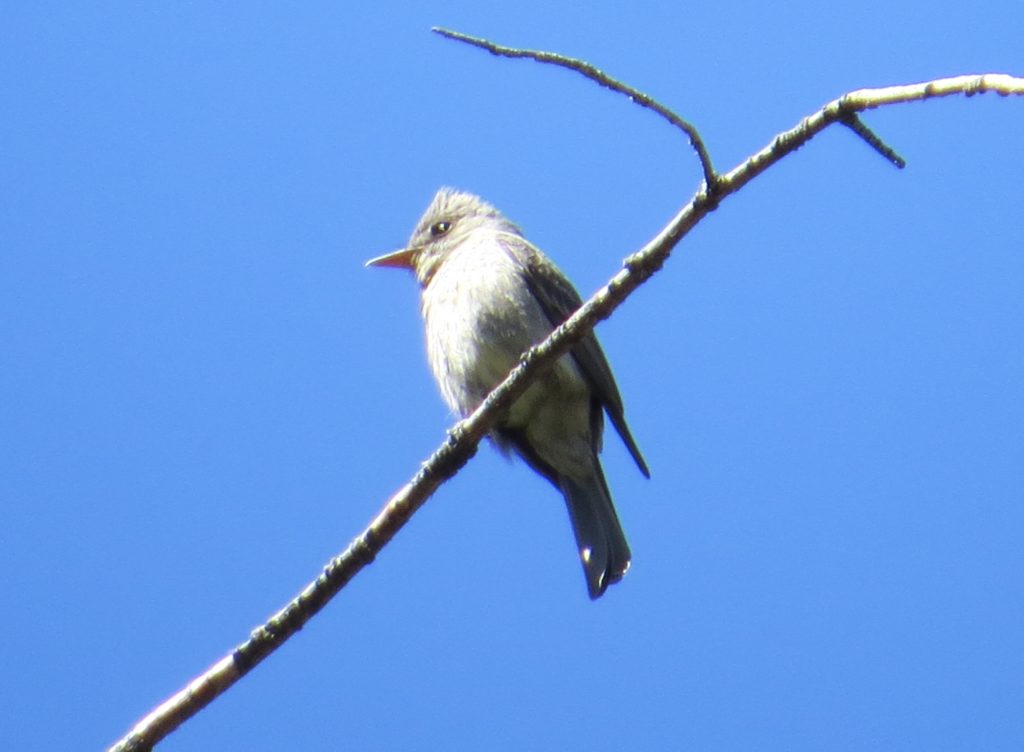
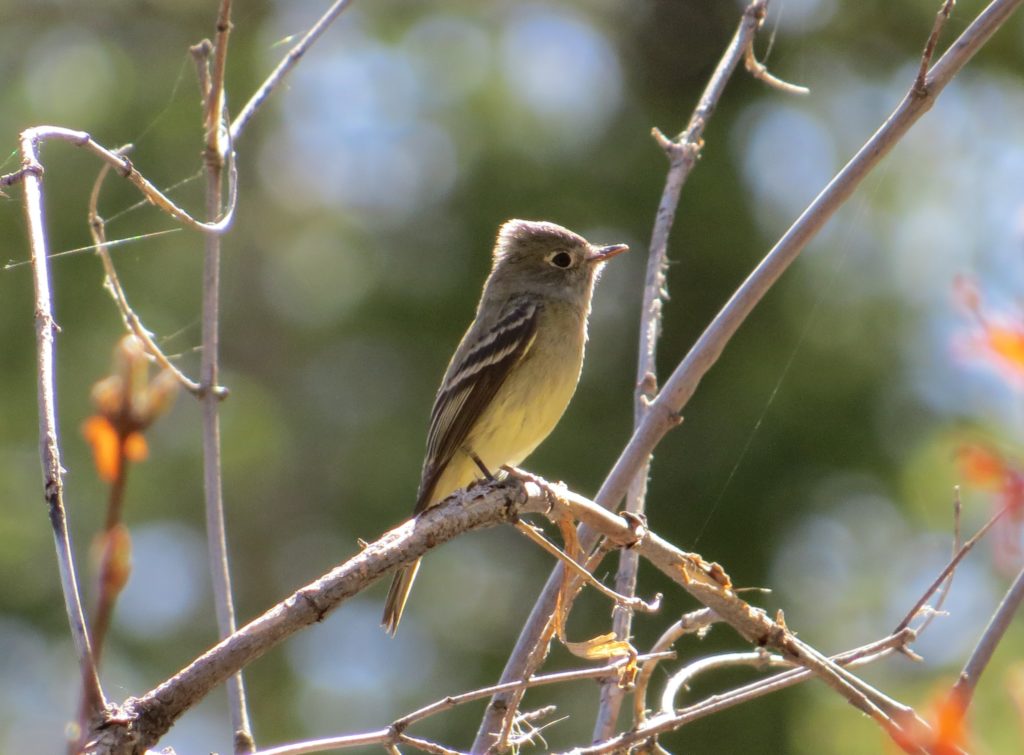 Another ID question prolonged the decision. Anybody know what species this lizard is?
Another ID question prolonged the decision. Anybody know what species this lizard is?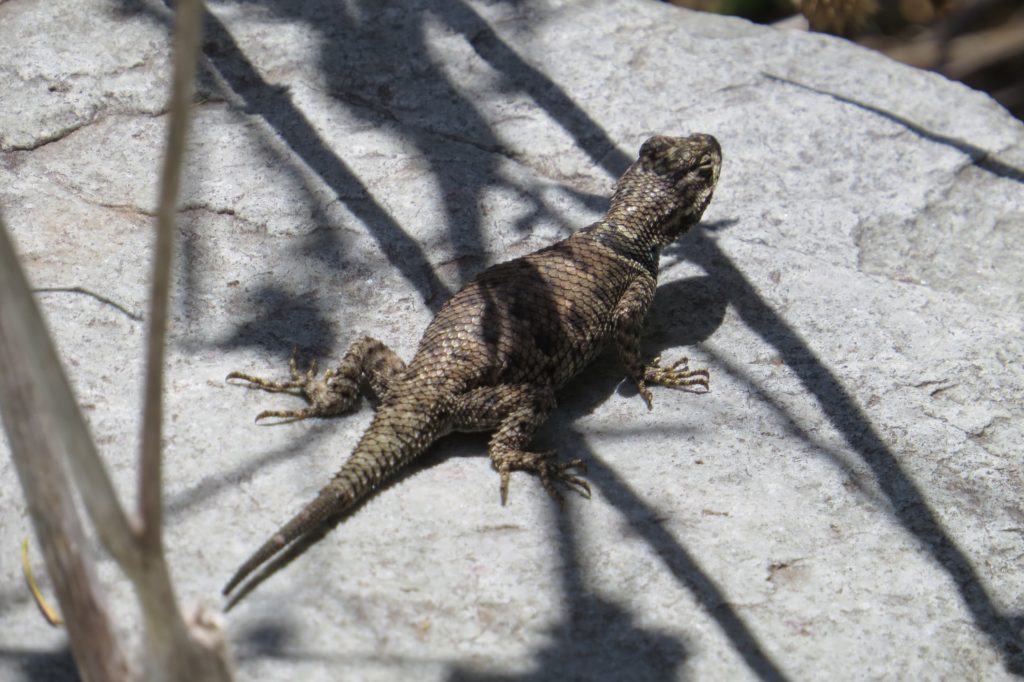
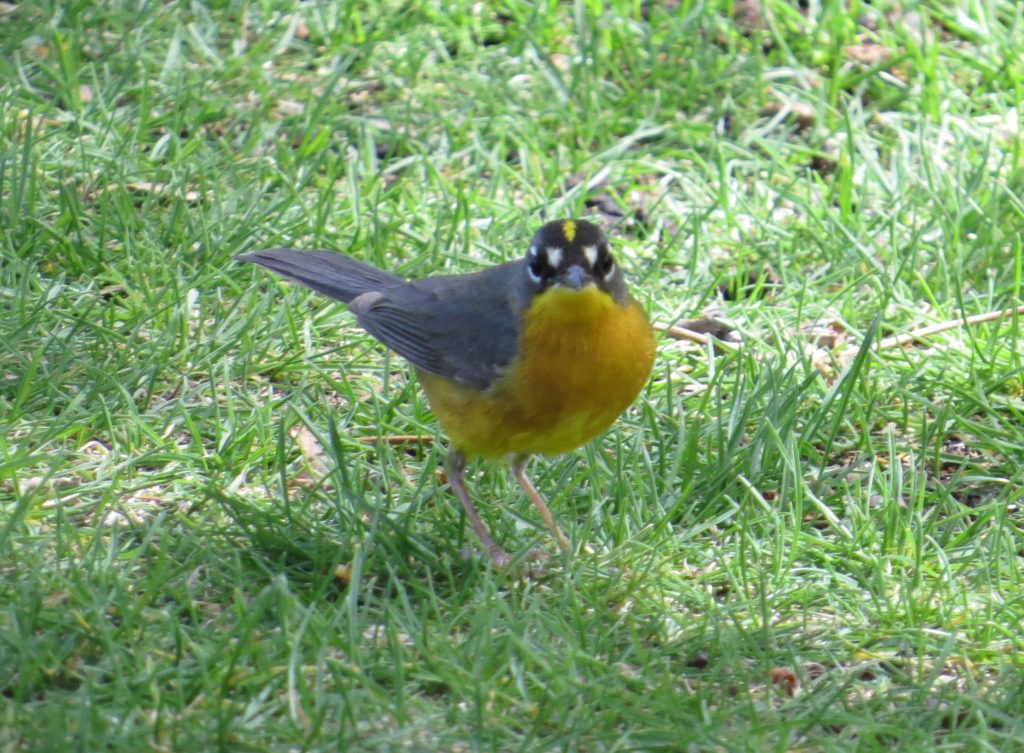
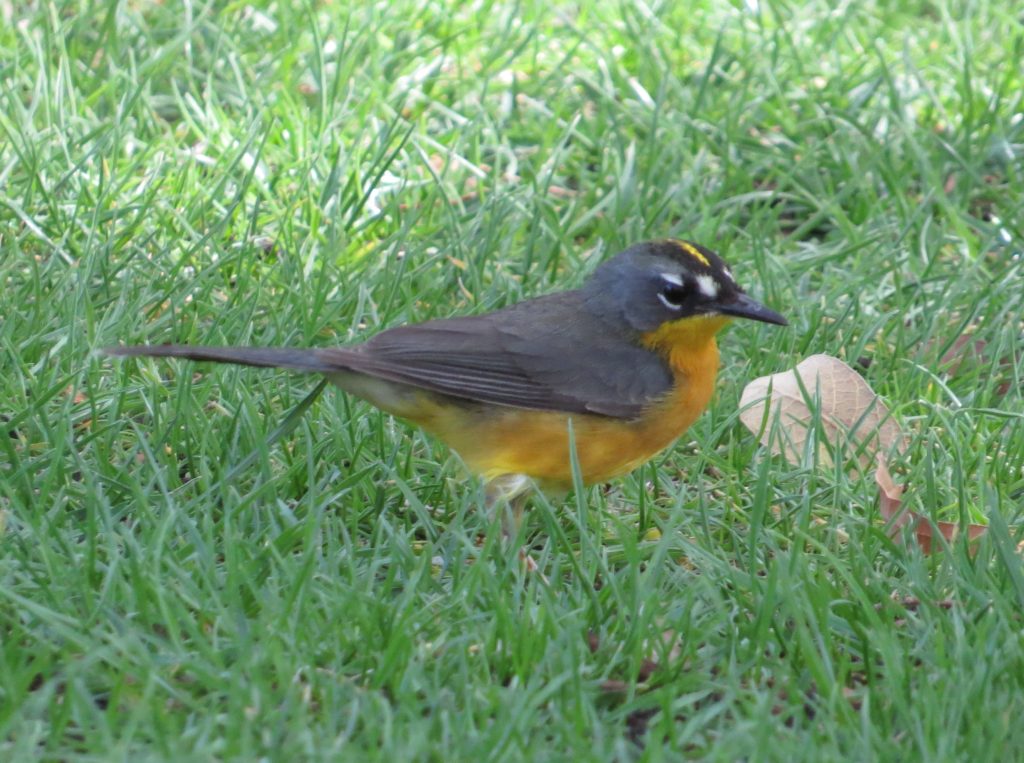 If the Fan-tailed Warbler weren’t enough, the regulars of Rick’s yard were worthy of their own awe. The place was positively buzzing with bird activity. Among the many species of birds were a couple more lifers for me, the bulky Blue-throated Hummingbird and a Calliope Hummingbird. Both were quick sightings that didn’t allow for photos. This gorgeous male Scott’s Oriole was cooperative, though. It was a nice redemptive photo from my lifer butt-shot in Hunter Canyon a few years ago.
If the Fan-tailed Warbler weren’t enough, the regulars of Rick’s yard were worthy of their own awe. The place was positively buzzing with bird activity. Among the many species of birds were a couple more lifers for me, the bulky Blue-throated Hummingbird and a Calliope Hummingbird. Both were quick sightings that didn’t allow for photos. This gorgeous male Scott’s Oriole was cooperative, though. It was a nice redemptive photo from my lifer butt-shot in Hunter Canyon a few years ago.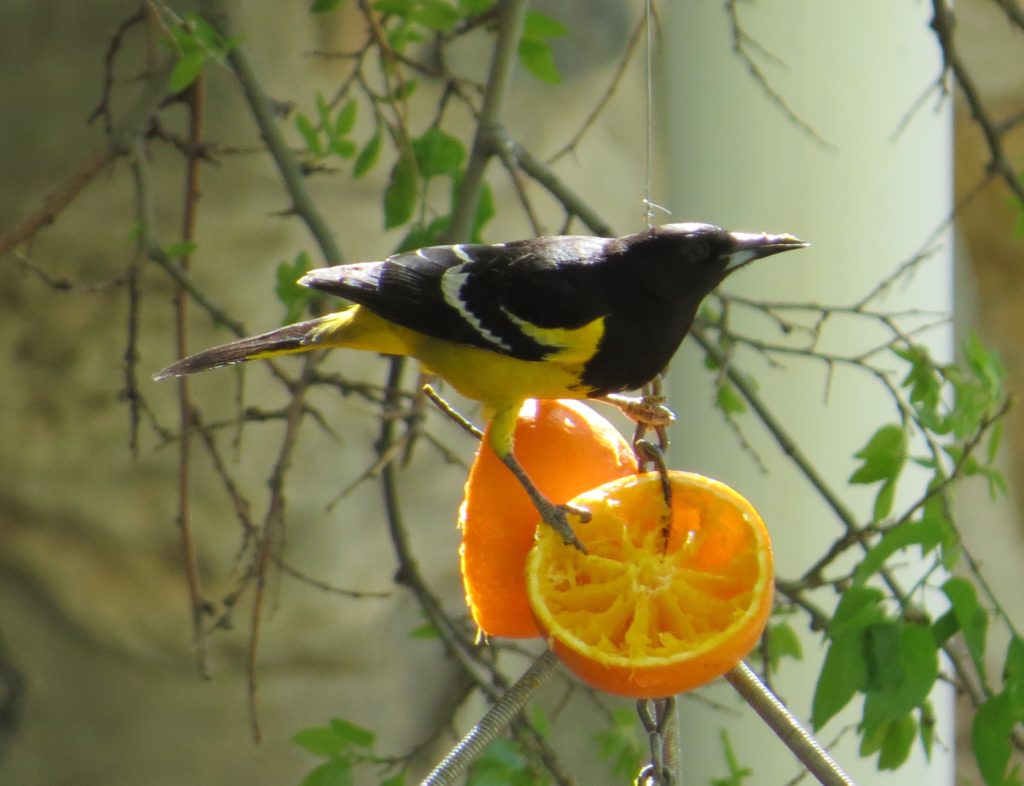 While we were at Rick’s yard visiting with Rick and his wife, there was another young birder there from New Mexico. I forget his name, but it was this kid’s 14th birthday, and his parents had driven him several hundred miles for his birthday to see this mega rarity. Cool parents, huh? The kid was no slouch birder either as he was identifying birds left and right. In fact, as we were leaving, he spotted two raptors overhead and announced they were Zone-tailed Hawks! That was a lifer for Steve and me and one that we were hoping for.
While we were at Rick’s yard visiting with Rick and his wife, there was another young birder there from New Mexico. I forget his name, but it was this kid’s 14th birthday, and his parents had driven him several hundred miles for his birthday to see this mega rarity. Cool parents, huh? The kid was no slouch birder either as he was identifying birds left and right. In fact, as we were leaving, he spotted two raptors overhead and announced they were Zone-tailed Hawks! That was a lifer for Steve and me and one that we were hoping for.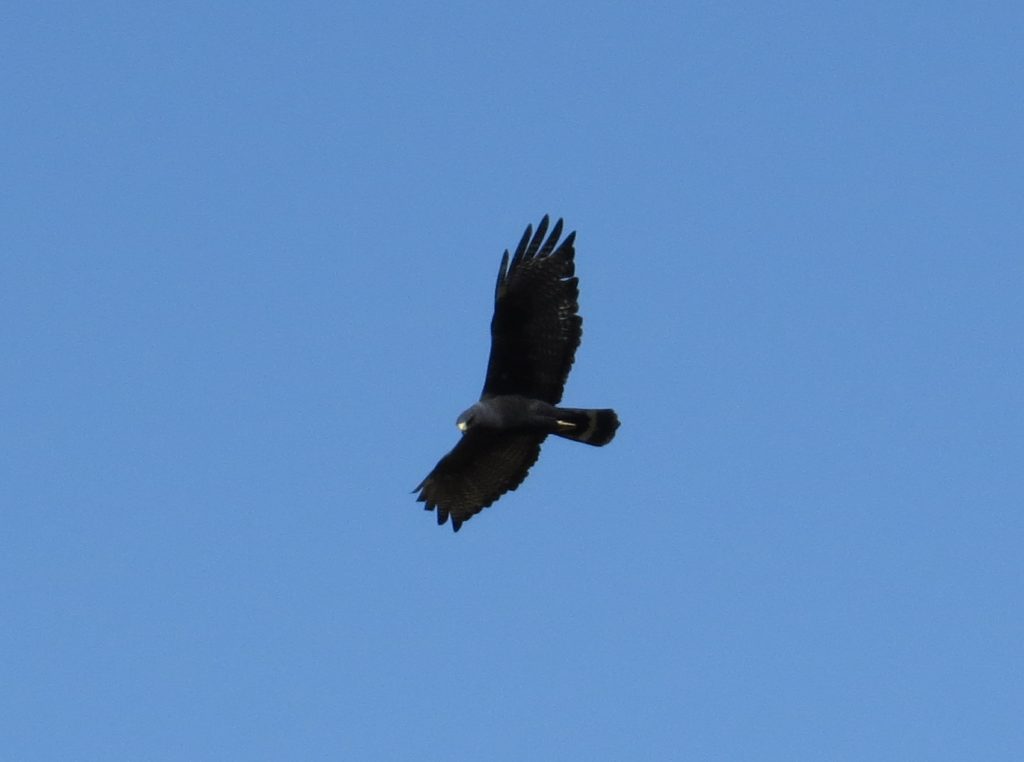 With one Mexican Warbler under our belts, it was time to go after another that had been showing in the Chiricahuas, the Slate-throated Redstart. I had tried for this ABA Code-3 a few years ago in Hunter Canyon. We barely had enough daylight to get all the way up and over the Chiris to Pinery Canyon where it had been seen. The views along the way were spectacular even if the road was a bit stressful with its curves and steep drop-offs. I’m glad Steve was driving.
With one Mexican Warbler under our belts, it was time to go after another that had been showing in the Chiricahuas, the Slate-throated Redstart. I had tried for this ABA Code-3 a few years ago in Hunter Canyon. We barely had enough daylight to get all the way up and over the Chiris to Pinery Canyon where it had been seen. The views along the way were spectacular even if the road was a bit stressful with its curves and steep drop-offs. I’m glad Steve was driving.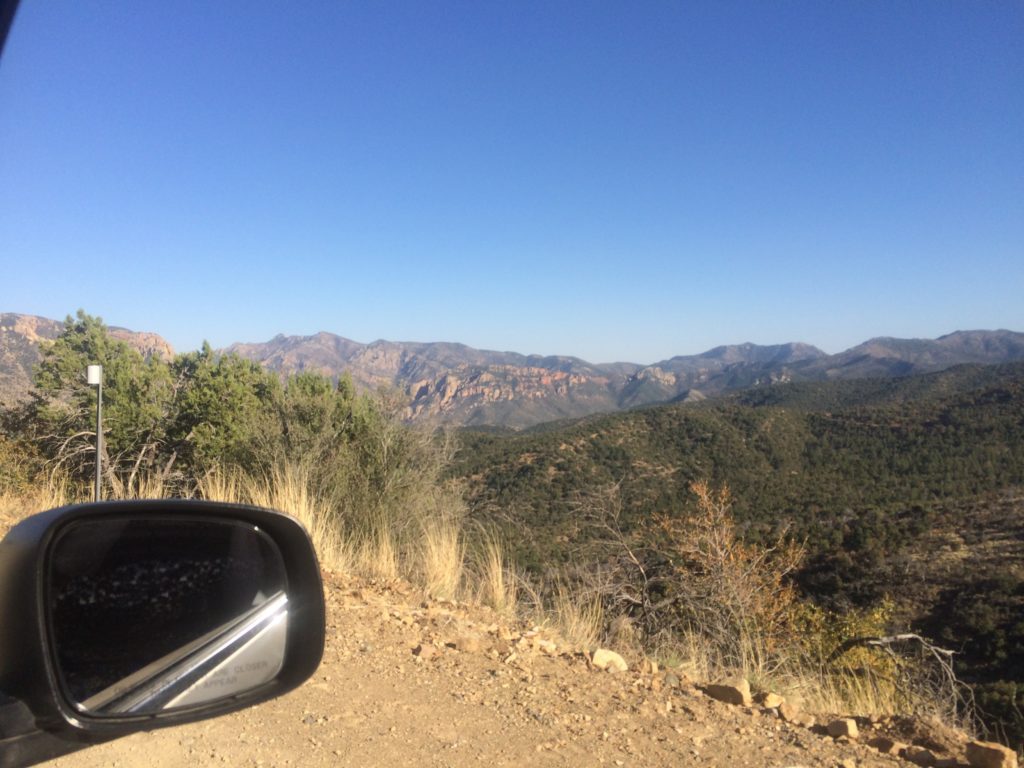
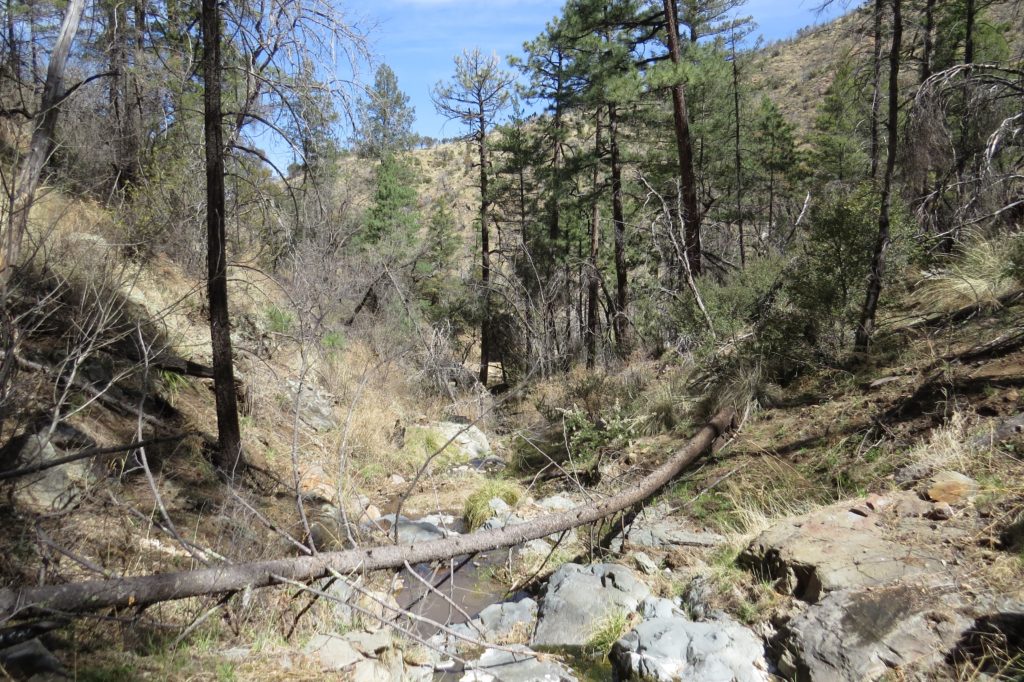
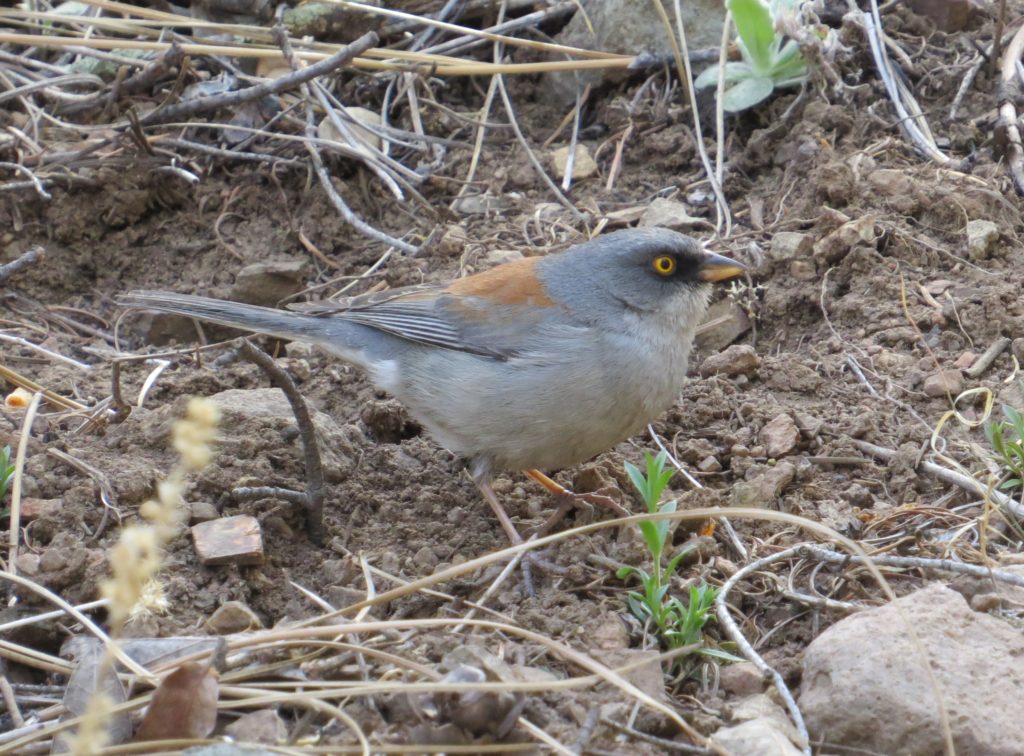
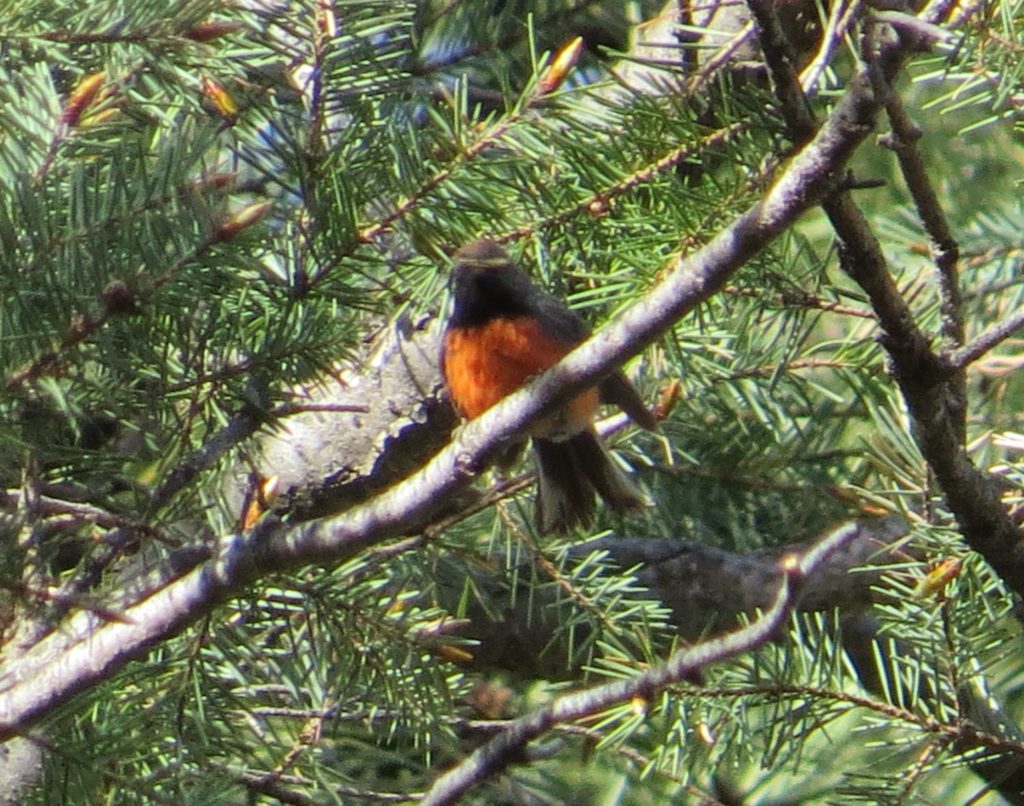
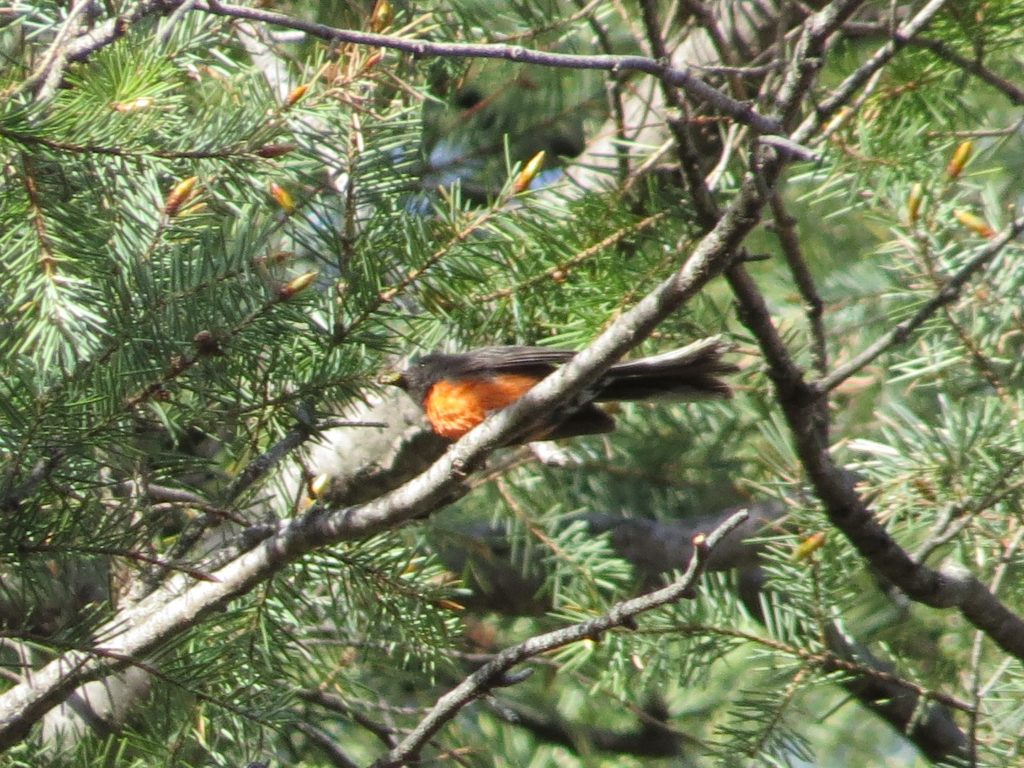
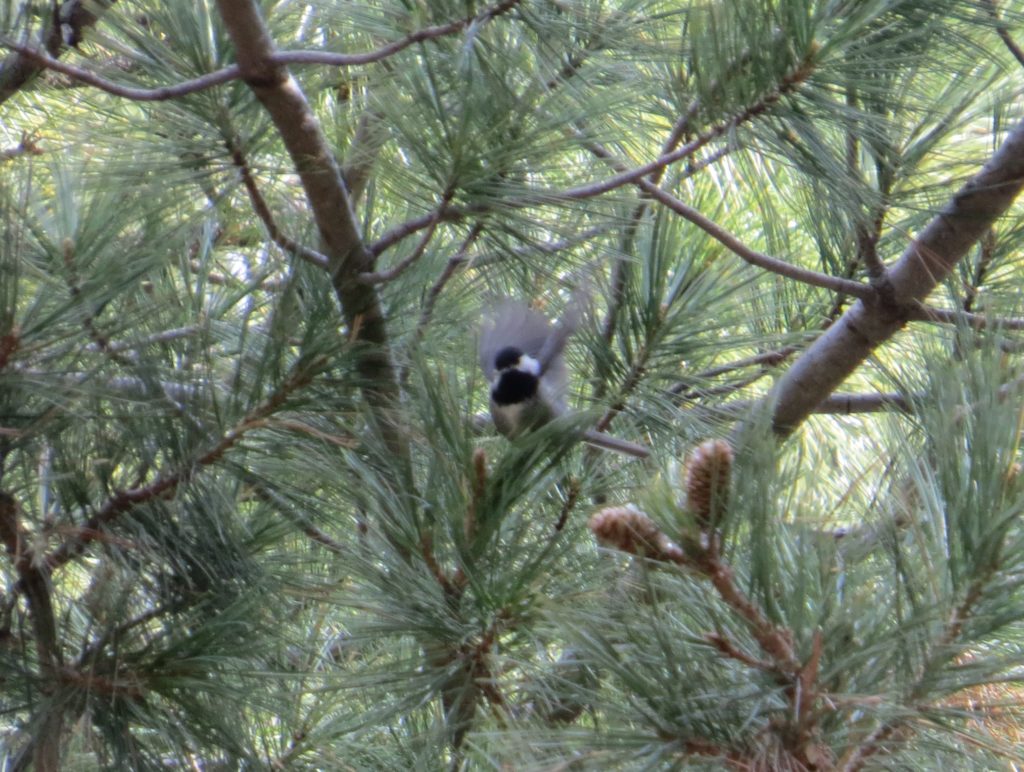 When you are literally on top of the world and have seen the Mexican Chickadee (and all kinds of other crazy good birds), a celebratory selfie is in order.
When you are literally on top of the world and have seen the Mexican Chickadee (and all kinds of other crazy good birds), a celebratory selfie is in order.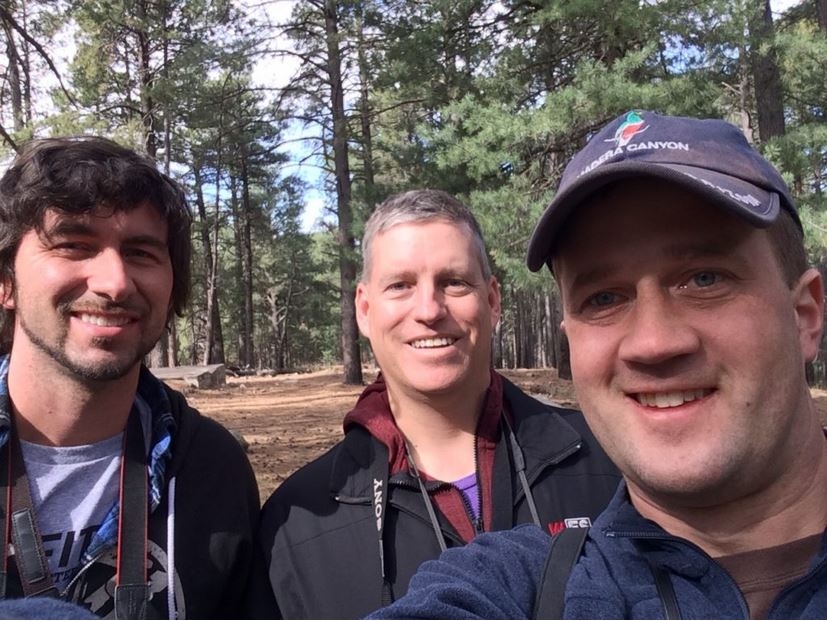
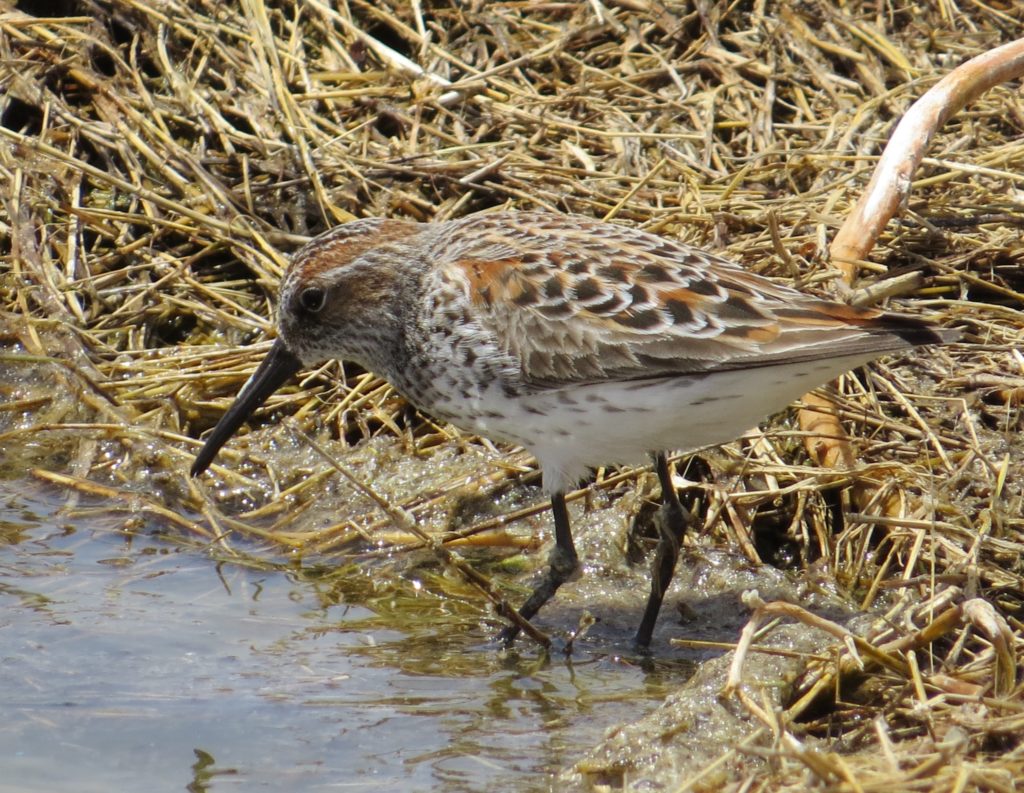 Cinnamon Teal never get old to this birder, and they were quite cooperative in Willcox as well.
Cinnamon Teal never get old to this birder, and they were quite cooperative in Willcox as well.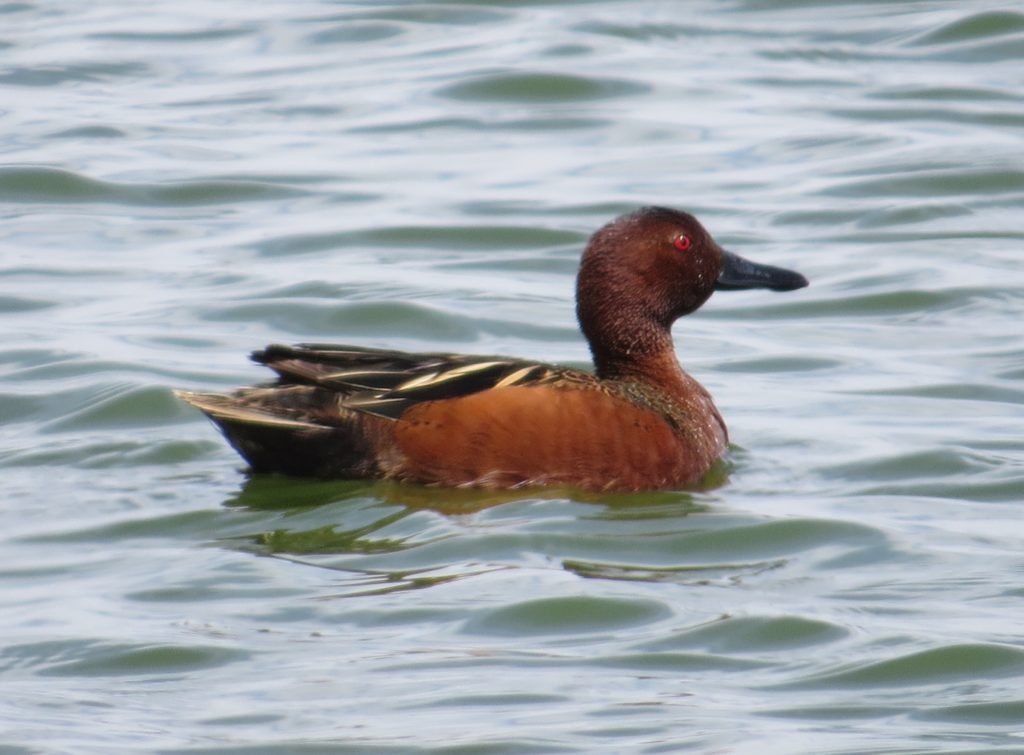 The trip was really over at this point. Steve and I had a flight to catch. That didn’t mean there wasn’t time to make one quick stop when we got close to my parents’ house in Maricopa. Tommy spotted this Burrowing Owl.
The trip was really over at this point. Steve and I had a flight to catch. That didn’t mean there wasn’t time to make one quick stop when we got close to my parents’ house in Maricopa. Tommy spotted this Burrowing Owl.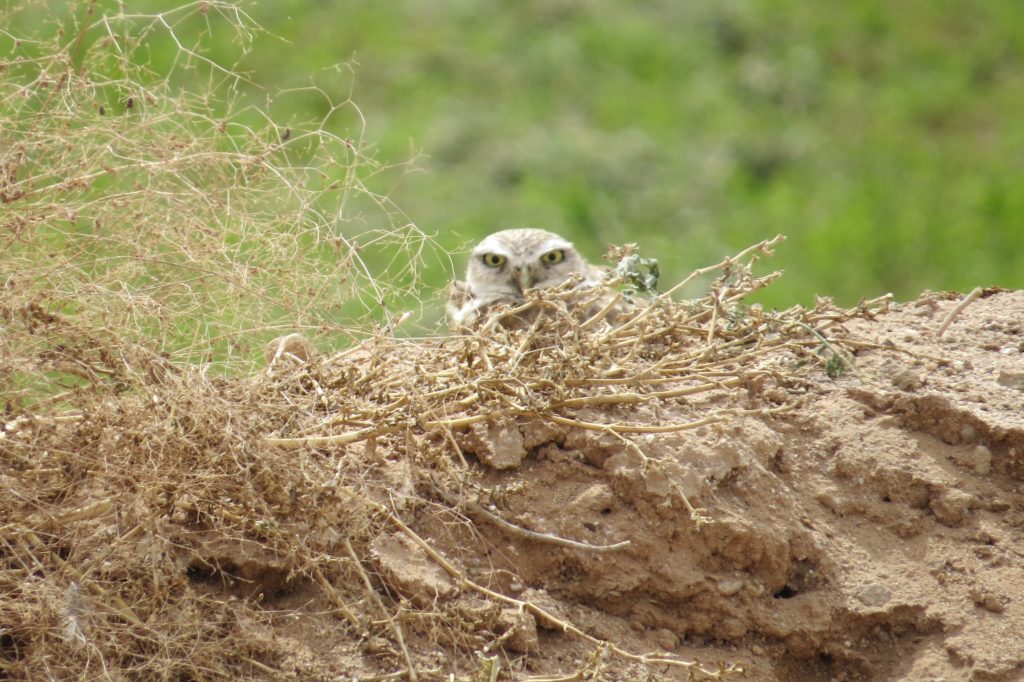
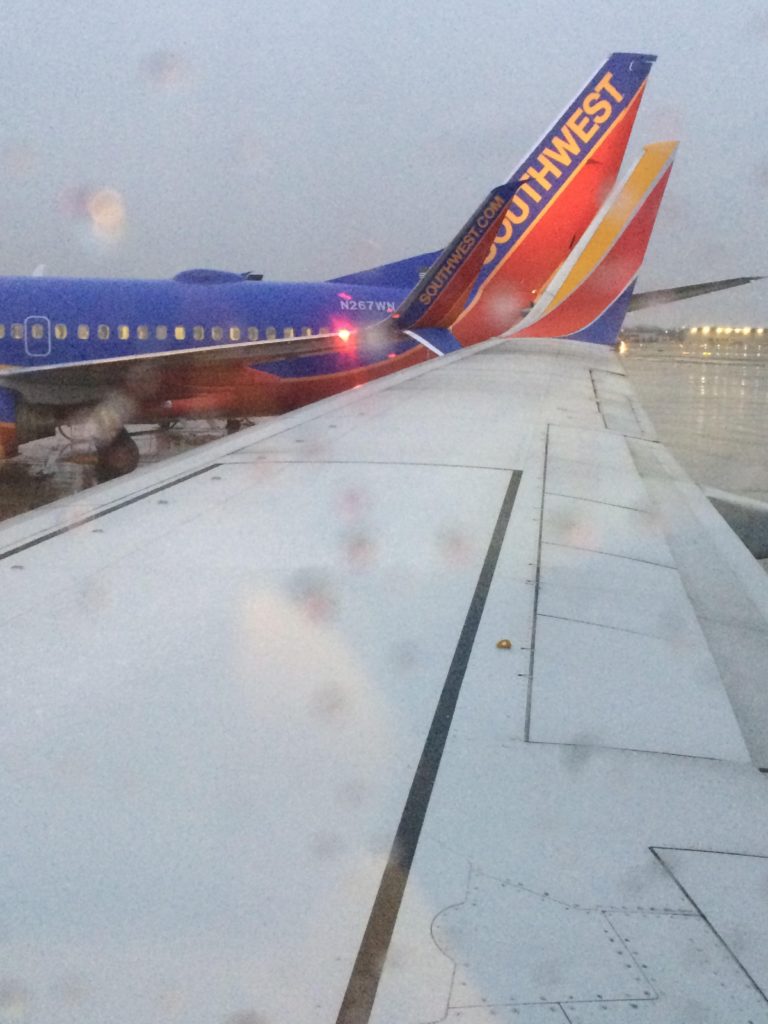
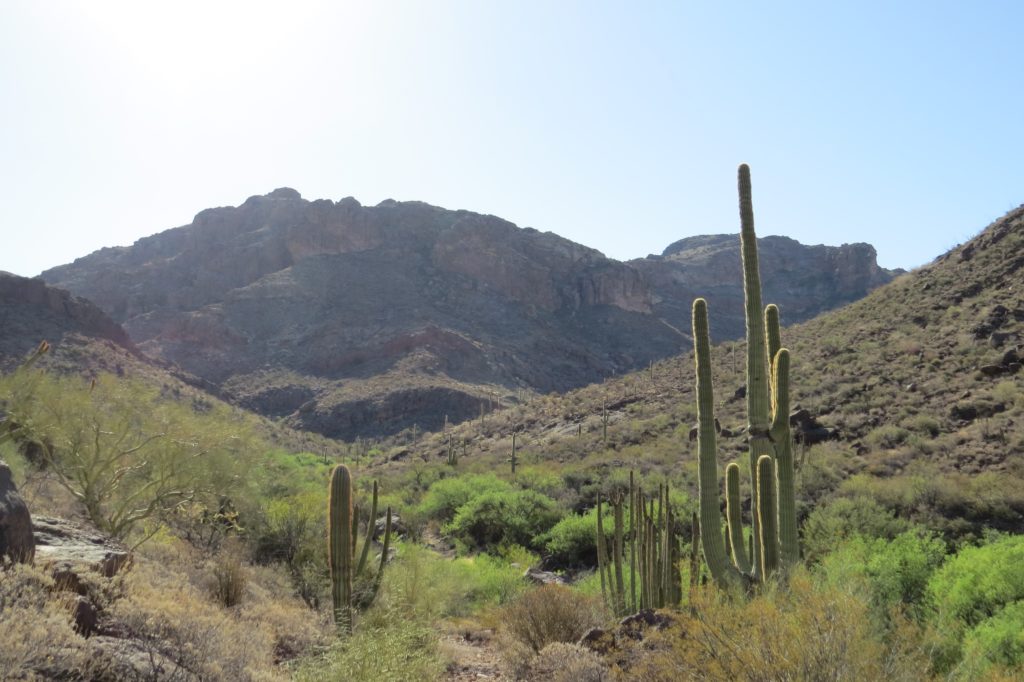 Owls aside, I think Steve and I were just enjoying not being in a blizzard. Our sympathies for our families back home were quickly eclipsed by the beautiful weather we were enjoying. We picked a great weekend to be in southern Arizona.
Owls aside, I think Steve and I were just enjoying not being in a blizzard. Our sympathies for our families back home were quickly eclipsed by the beautiful weather we were enjoying. We picked a great weekend to be in southern Arizona.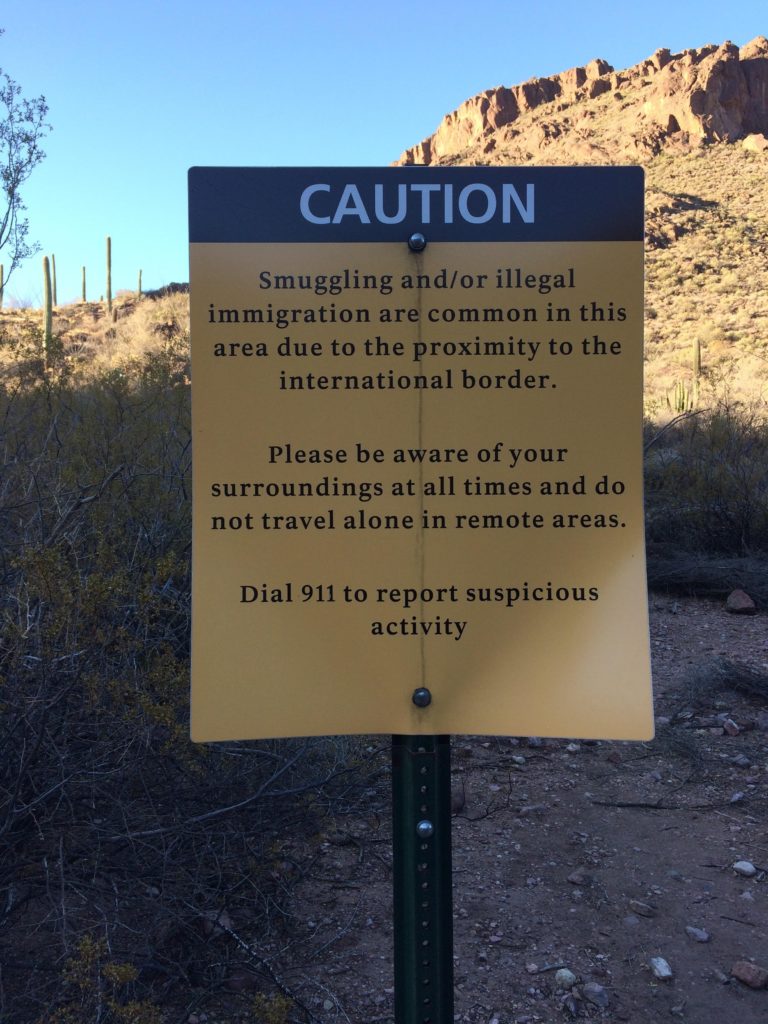
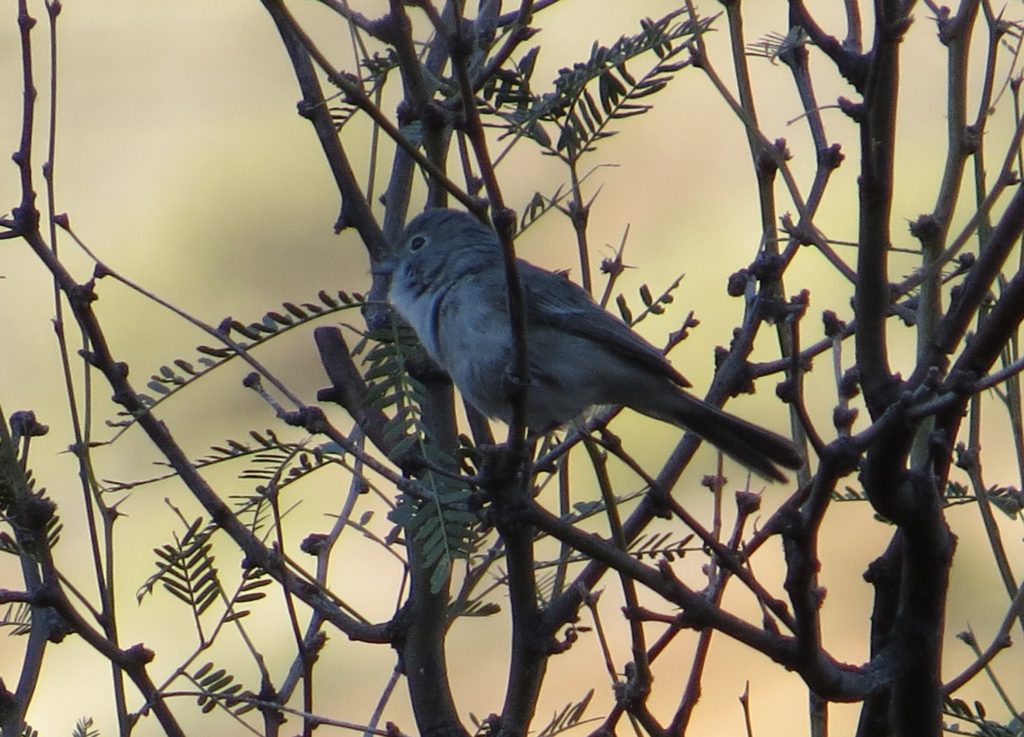 Not long after the Gray Vireo fun it was time to head back down canyon sans FEPO. A petty consolation came in the form of another Vireo lifer we missed on the way up, one of the Cassin’s variety.
Not long after the Gray Vireo fun it was time to head back down canyon sans FEPO. A petty consolation came in the form of another Vireo lifer we missed on the way up, one of the Cassin’s variety.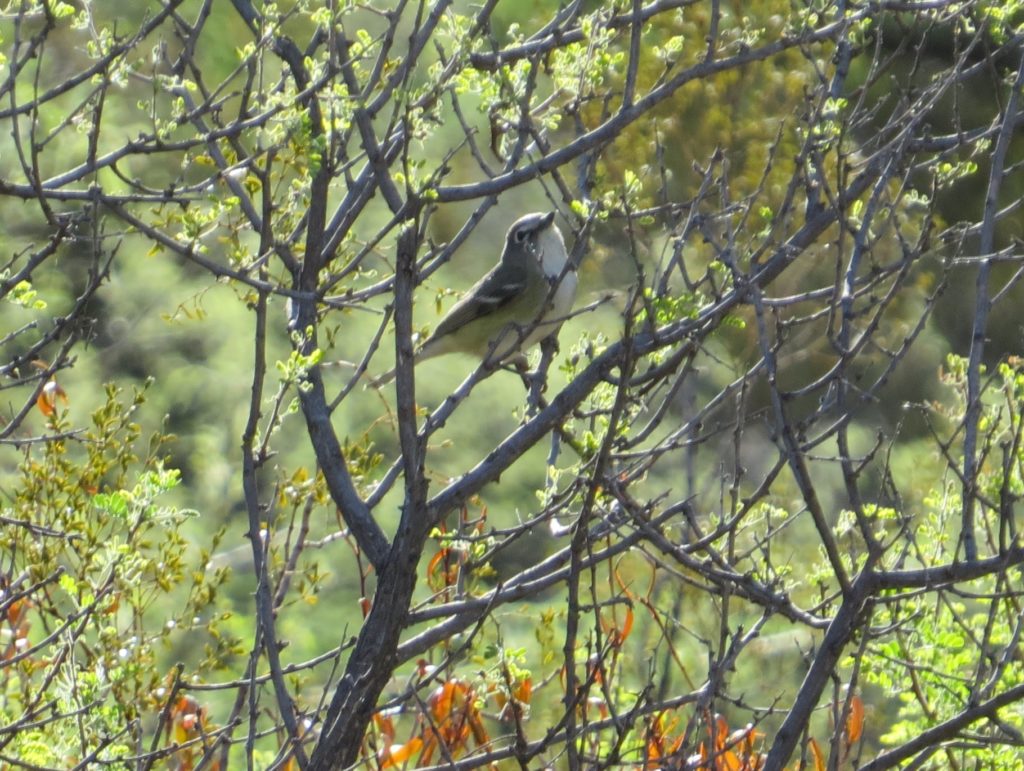
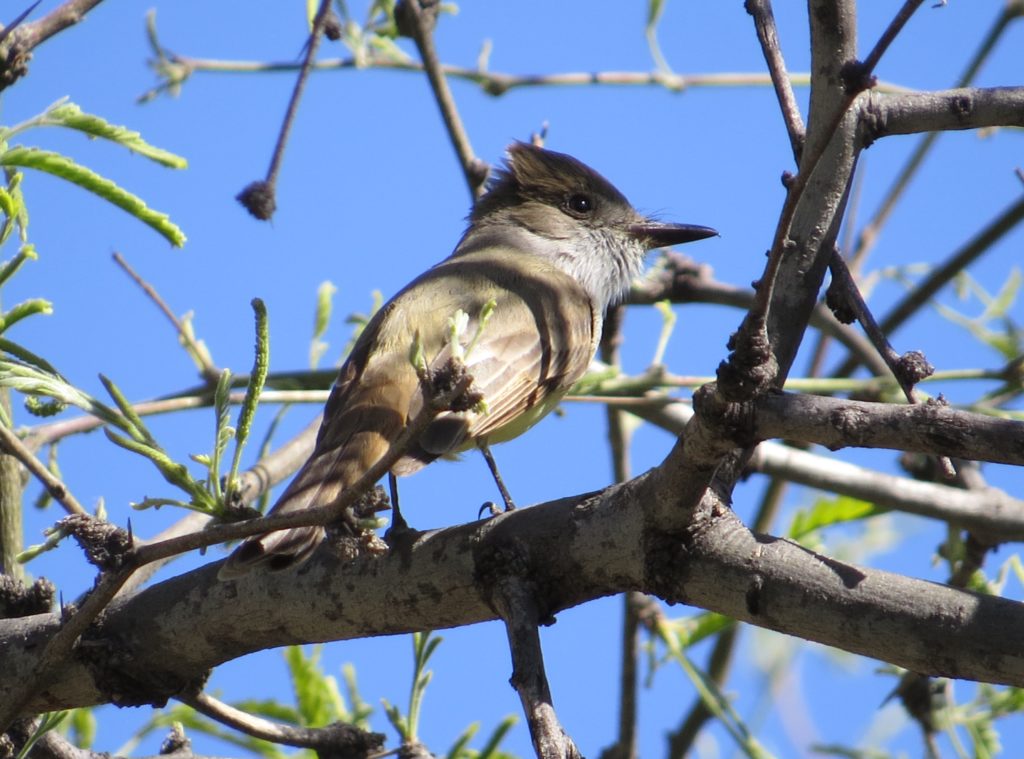
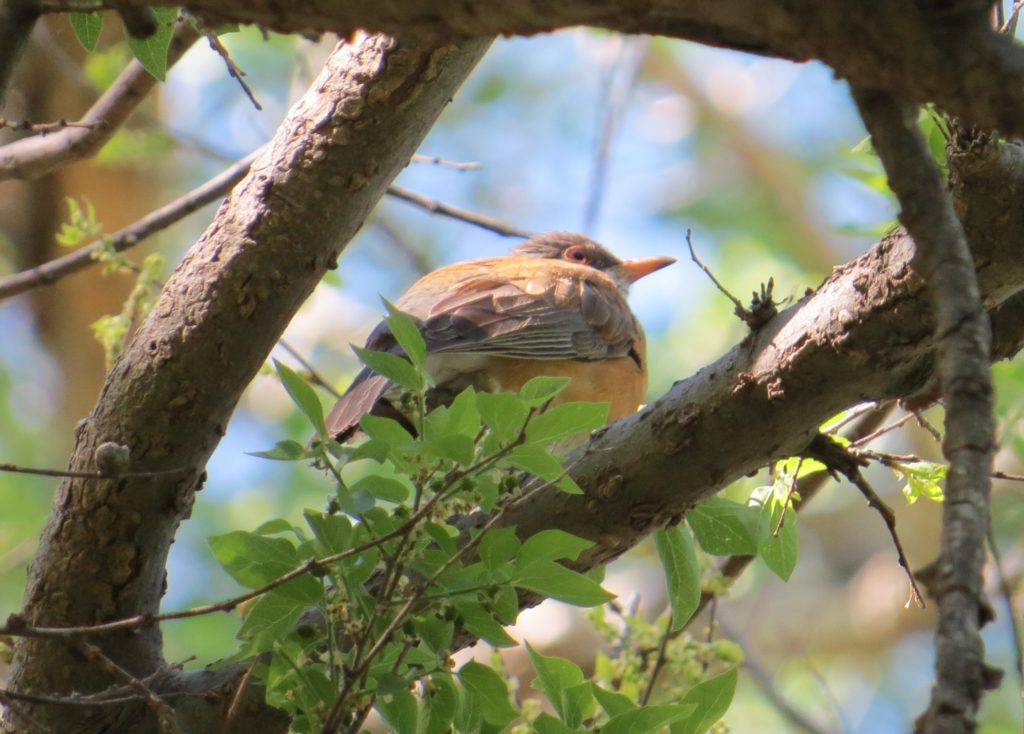
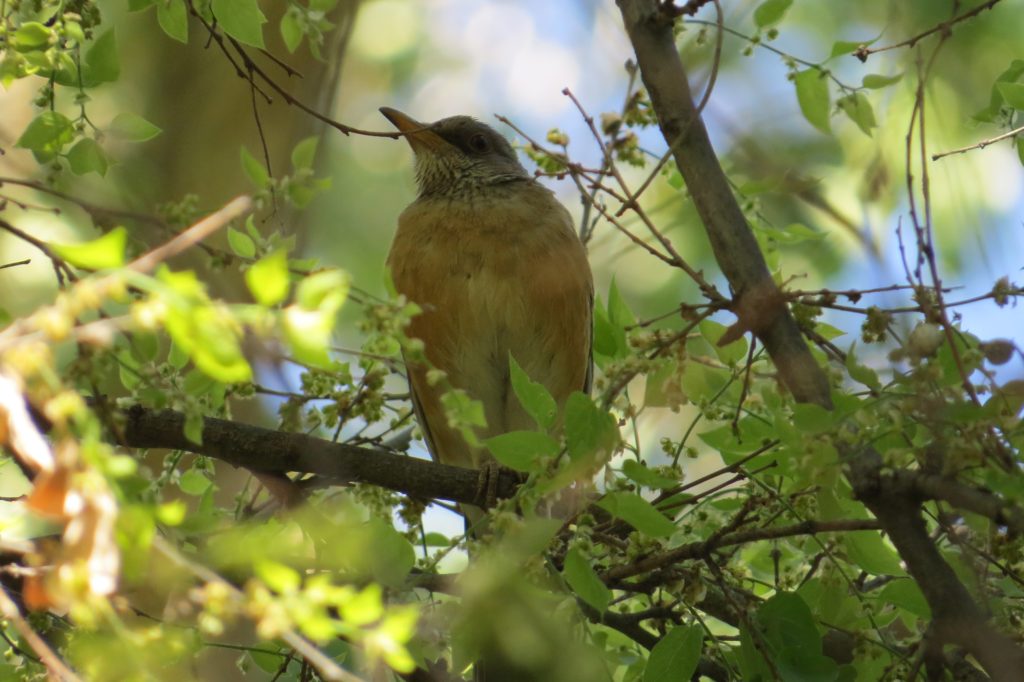
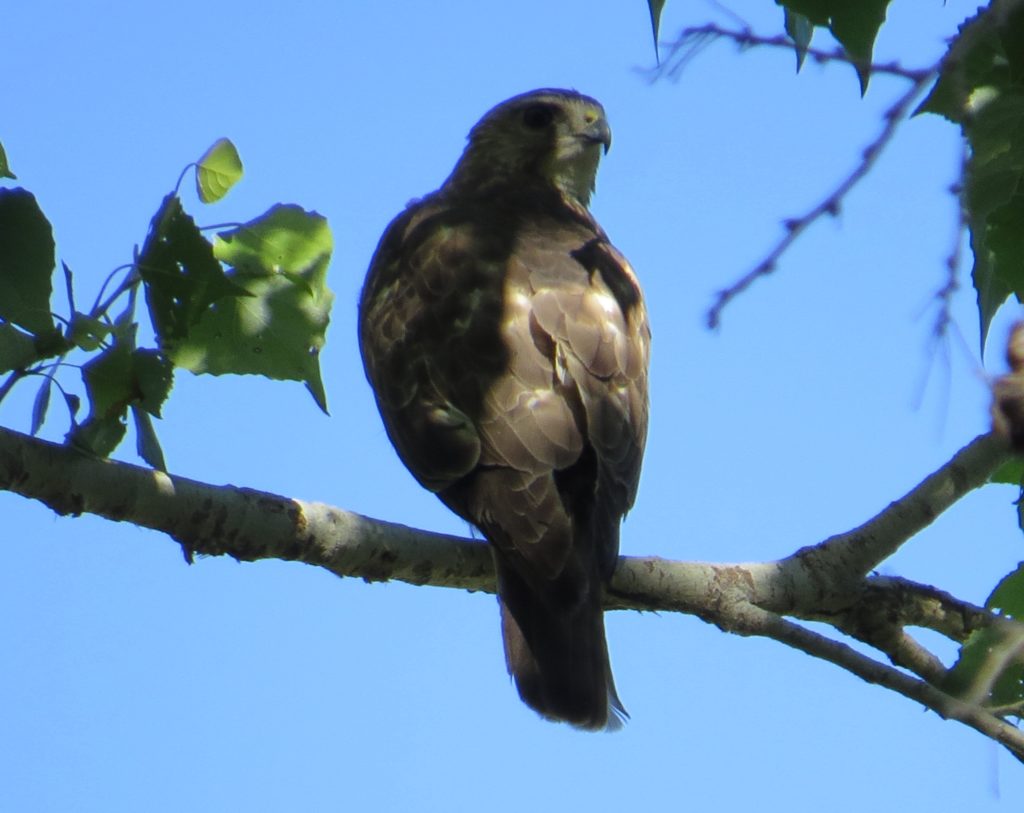 By this point in the afternoon, it was time we made our way to Madera Canyon. Not wanting to waste any burning daylight, we squeezed out every minute stopping briefly at Florida Canyon for Rufous-capped Warbler for Steve and Black-capped Gnatcatcher for both of us. Nada on those, but the effort was minimal. At least a Black-throated Gray Warbler was an nice lifer bonus for Steve. Next up was a stop at Proctor Road to try one more time for the Gnatcatcher. We did find a Gnatcatcher that was more Black-capped-like that Black-tailed, but the waning daylight and the bird’s fidgety behavior did not allow us to clinch the key field marks for an ID beyond a reasonable doubt. The regularity of this species makes it highly likely that it will eventually land on my list, just not this day.
By this point in the afternoon, it was time we made our way to Madera Canyon. Not wanting to waste any burning daylight, we squeezed out every minute stopping briefly at Florida Canyon for Rufous-capped Warbler for Steve and Black-capped Gnatcatcher for both of us. Nada on those, but the effort was minimal. At least a Black-throated Gray Warbler was an nice lifer bonus for Steve. Next up was a stop at Proctor Road to try one more time for the Gnatcatcher. We did find a Gnatcatcher that was more Black-capped-like that Black-tailed, but the waning daylight and the bird’s fidgety behavior did not allow us to clinch the key field marks for an ID beyond a reasonable doubt. The regularity of this species makes it highly likely that it will eventually land on my list, just not this day.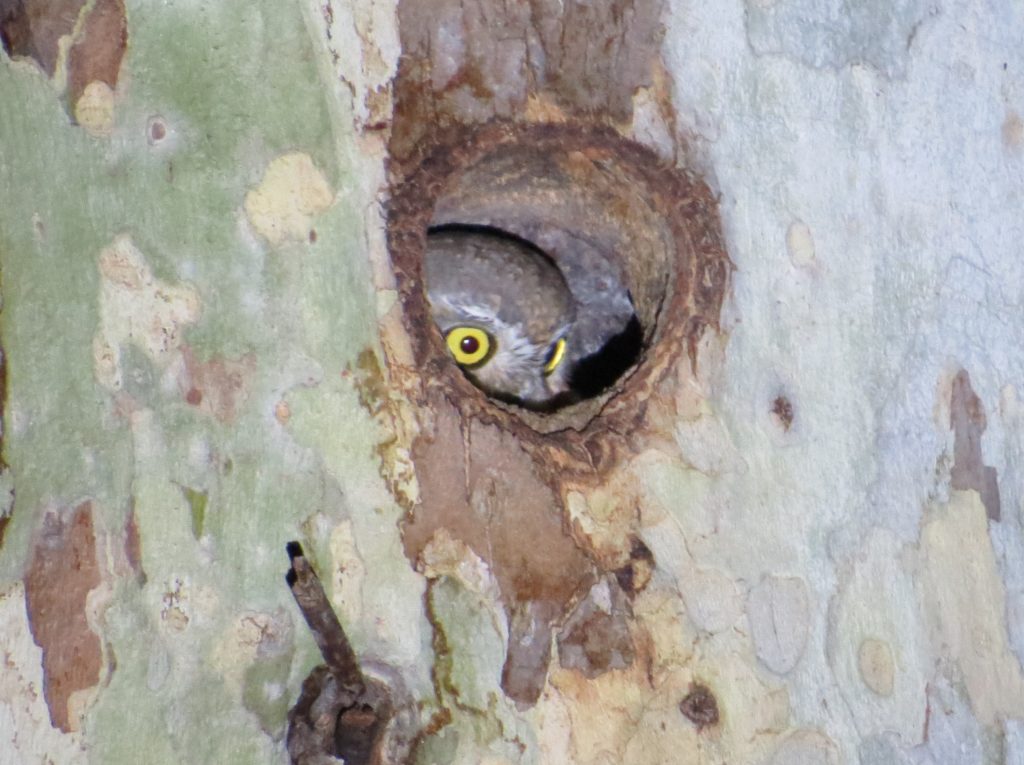
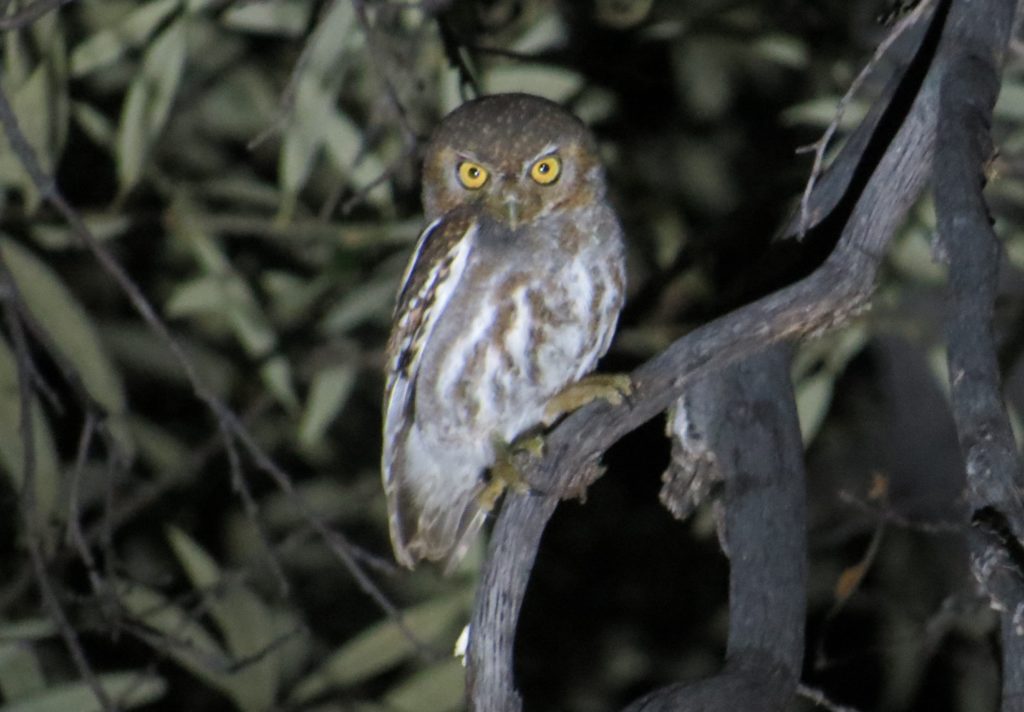
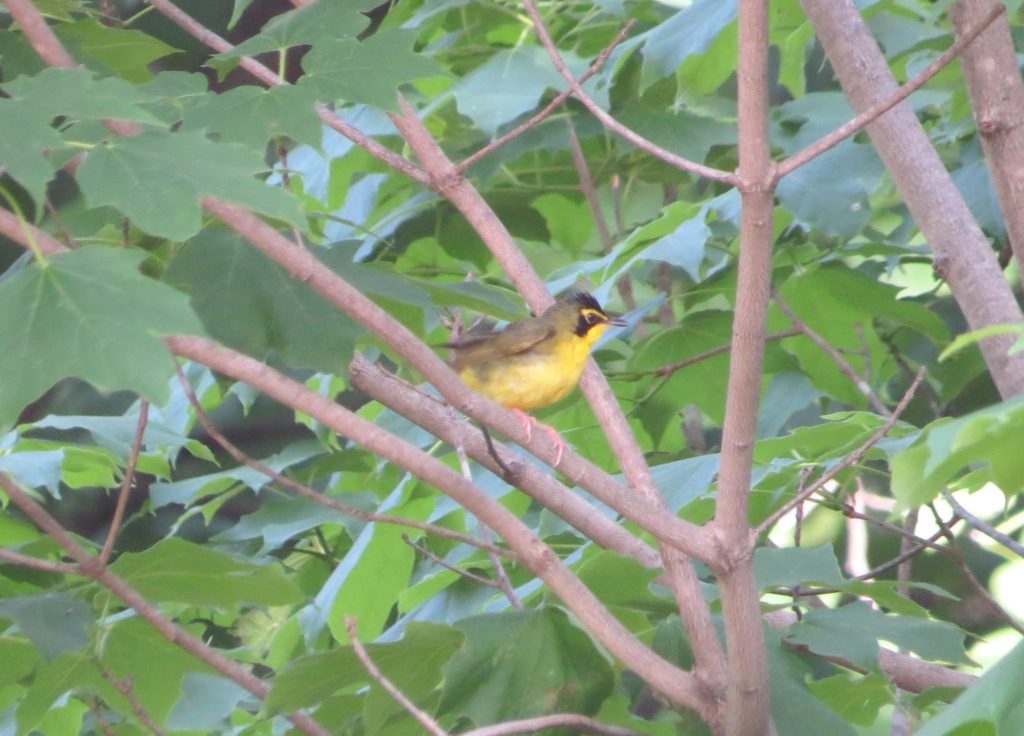
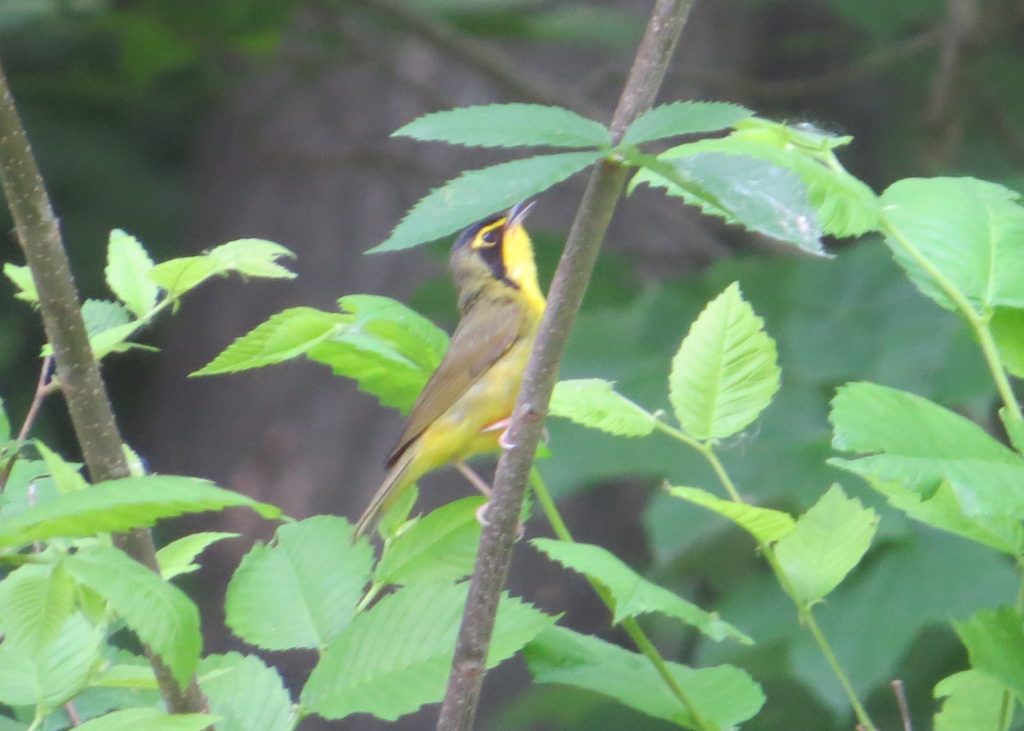
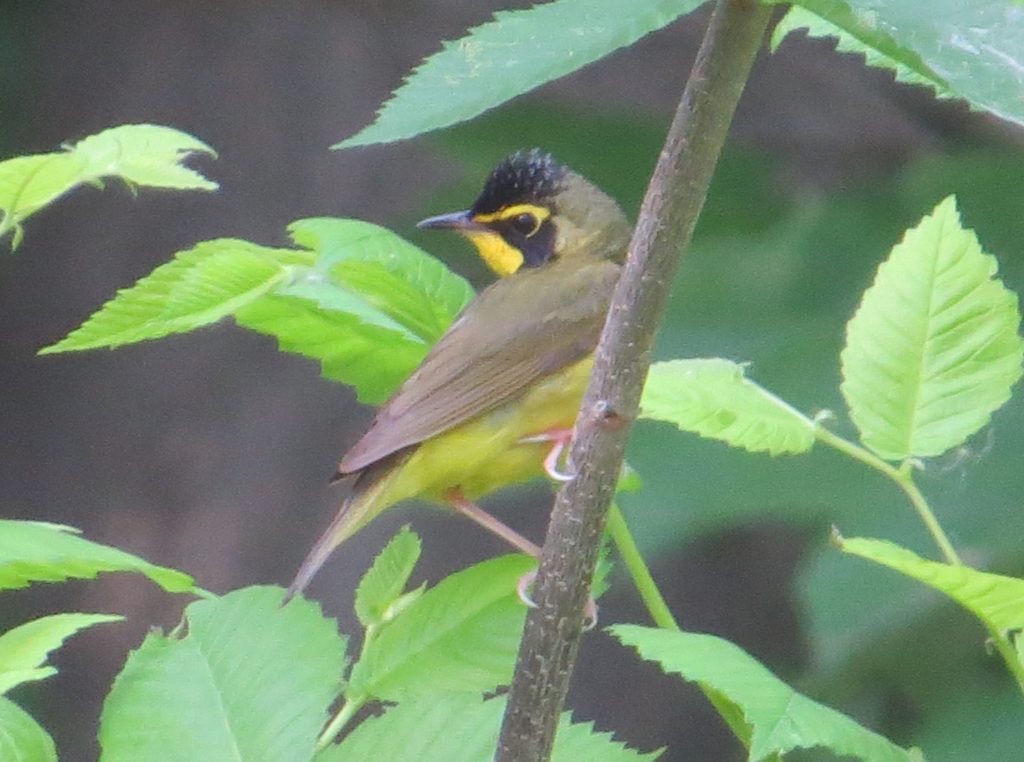 I am still shocked I got to see this Warbler after dipping in the original spot. Getting a photo was a wonderful bonus as I never counted on getting one in the first place even when I thought the bird would be a cinch. That’s birding for you, though. It’s never over until it’s over and doesn’t always play out like you think it will. This was a good reminder to bird hard to the end and expect the unexpected.
I am still shocked I got to see this Warbler after dipping in the original spot. Getting a photo was a wonderful bonus as I never counted on getting one in the first place even when I thought the bird would be a cinch. That’s birding for you, though. It’s never over until it’s over and doesn’t always play out like you think it will. This was a good reminder to bird hard to the end and expect the unexpected.
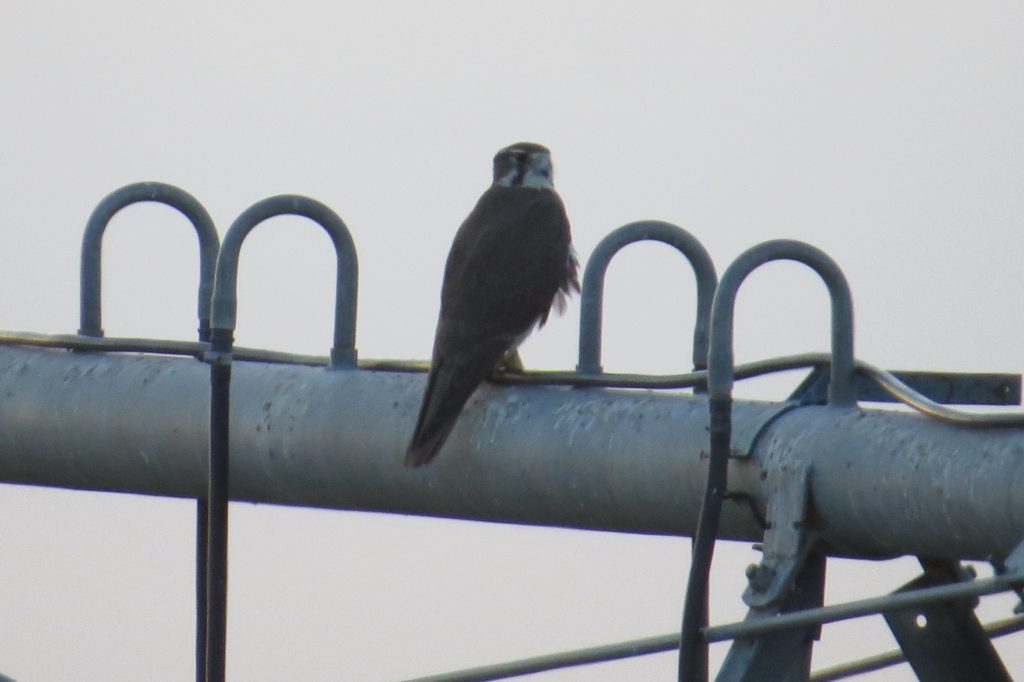 My clean-up operations are not haphazard–my strategy is to try to go after anything rare first and save the most common for later if need be. One of those rarities was the Rufous-backed Robin. This past winter was exceptional for this species with many records popping up in AZ. So that next day, my friend Gordon Karre took me on a mini-outing to stake out a gorgeous backyard in Paradise Valley to hopefully get one of two Robins that had been eating the berries of pyracantha bushes. The problem was that time and berries had run out for this particular Robin pair. We dipped.
My clean-up operations are not haphazard–my strategy is to try to go after anything rare first and save the most common for later if need be. One of those rarities was the Rufous-backed Robin. This past winter was exceptional for this species with many records popping up in AZ. So that next day, my friend Gordon Karre took me on a mini-outing to stake out a gorgeous backyard in Paradise Valley to hopefully get one of two Robins that had been eating the berries of pyracantha bushes. The problem was that time and berries had run out for this particular Robin pair. We dipped.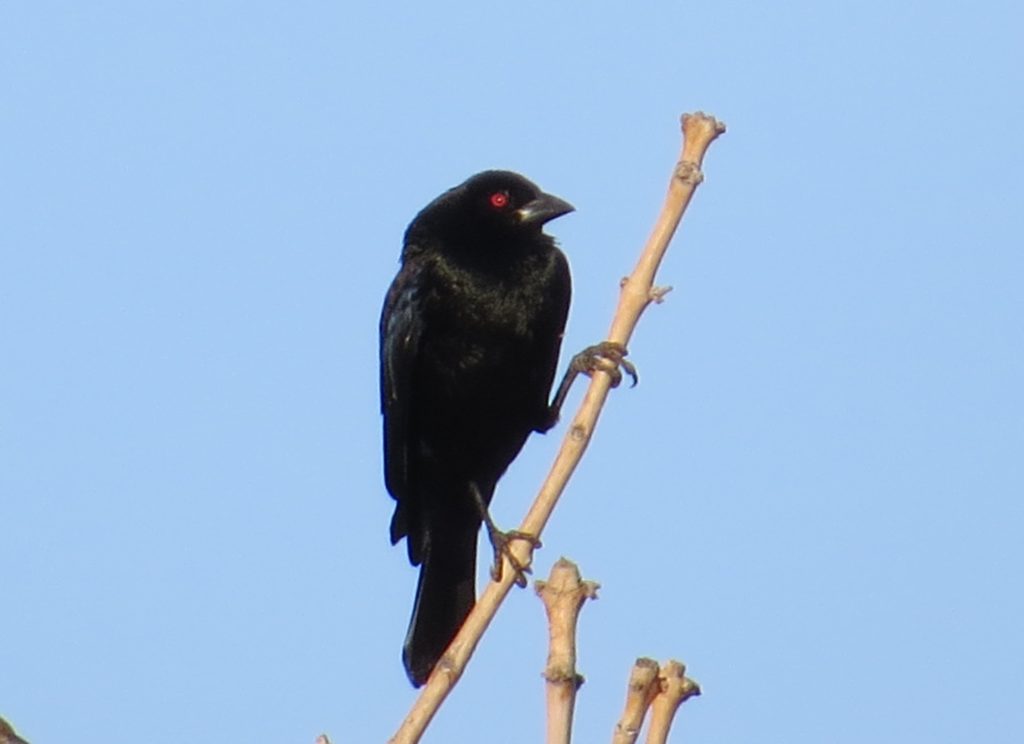 With that target achieved, the birding was put on hold until the next morning where Gordon, my Dad, and I would follow the same strategy–go after a key rarity and snag as many other lifers along the way. That rarity was the Ruddy Ground-Dove. Though we were going to originally go after one in the Phoenix area, it became a no-show just a couple days before the trip. We were then forced to go south to the Red Rock feedlot where several had been seen.
With that target achieved, the birding was put on hold until the next morning where Gordon, my Dad, and I would follow the same strategy–go after a key rarity and snag as many other lifers along the way. That rarity was the Ruddy Ground-Dove. Though we were going to originally go after one in the Phoenix area, it became a no-show just a couple days before the trip. We were then forced to go south to the Red Rock feedlot where several had been seen.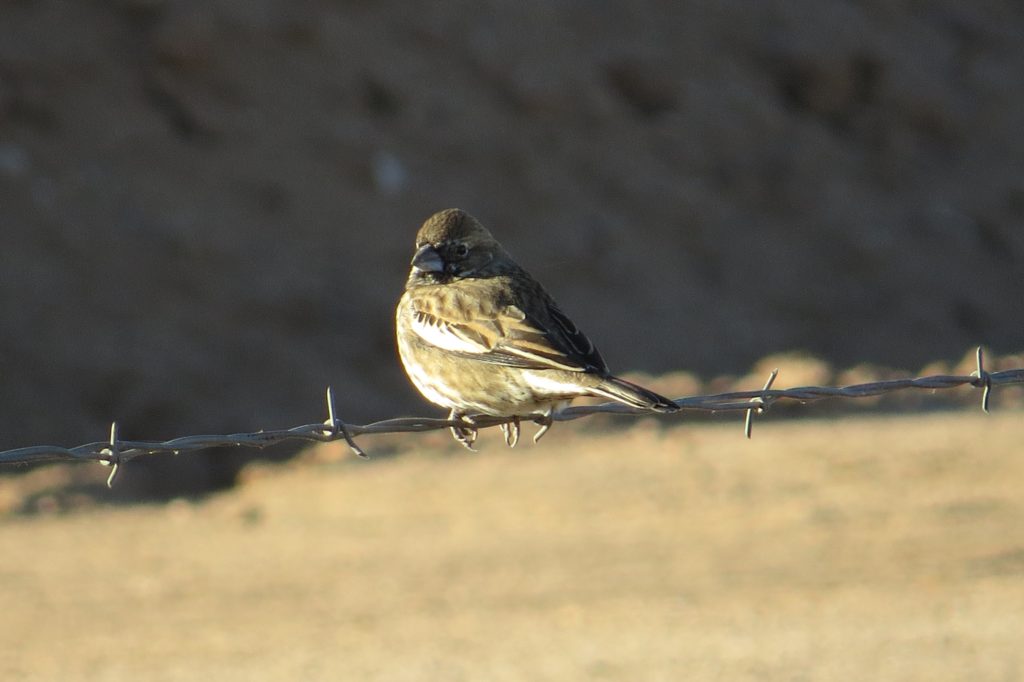 Finally we got on to the flock(!) of the rare Doves, finding five or six in all. Here are four of them with an Inca Dove that has identity issues, all huddling to keep warm on this chilly morning.
Finally we got on to the flock(!) of the rare Doves, finding five or six in all. Here are four of them with an Inca Dove that has identity issues, all huddling to keep warm on this chilly morning.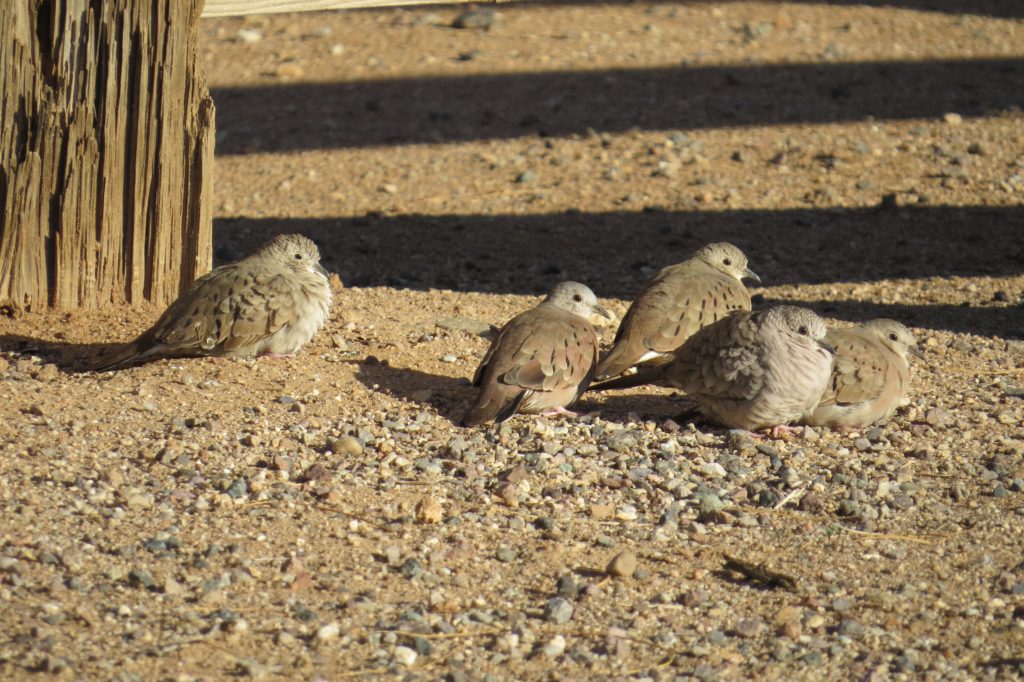
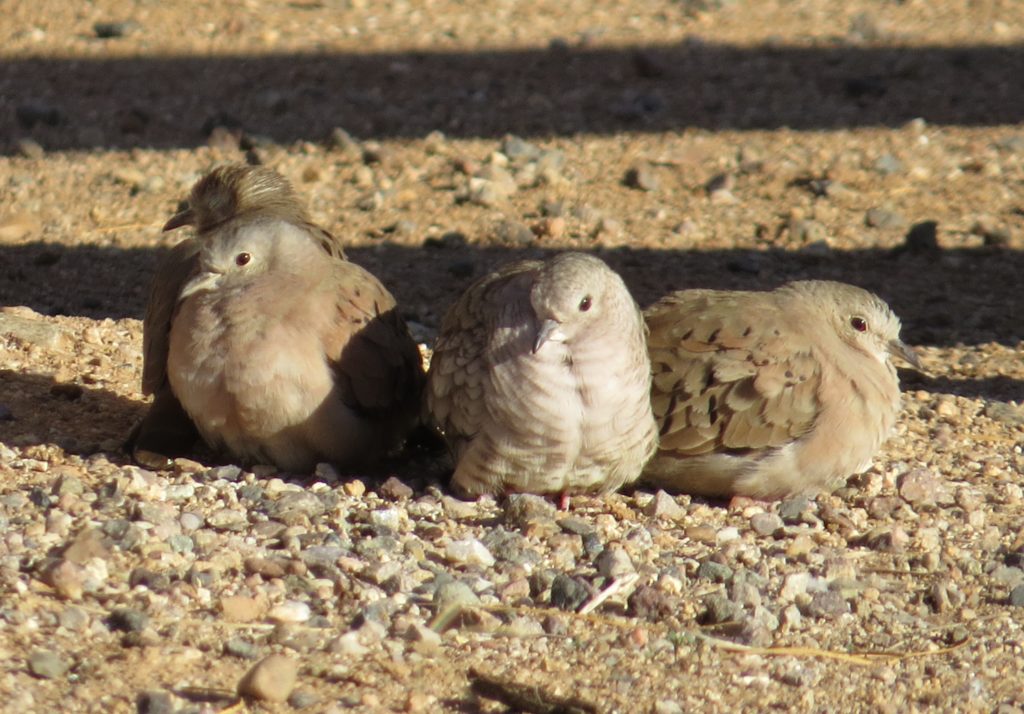
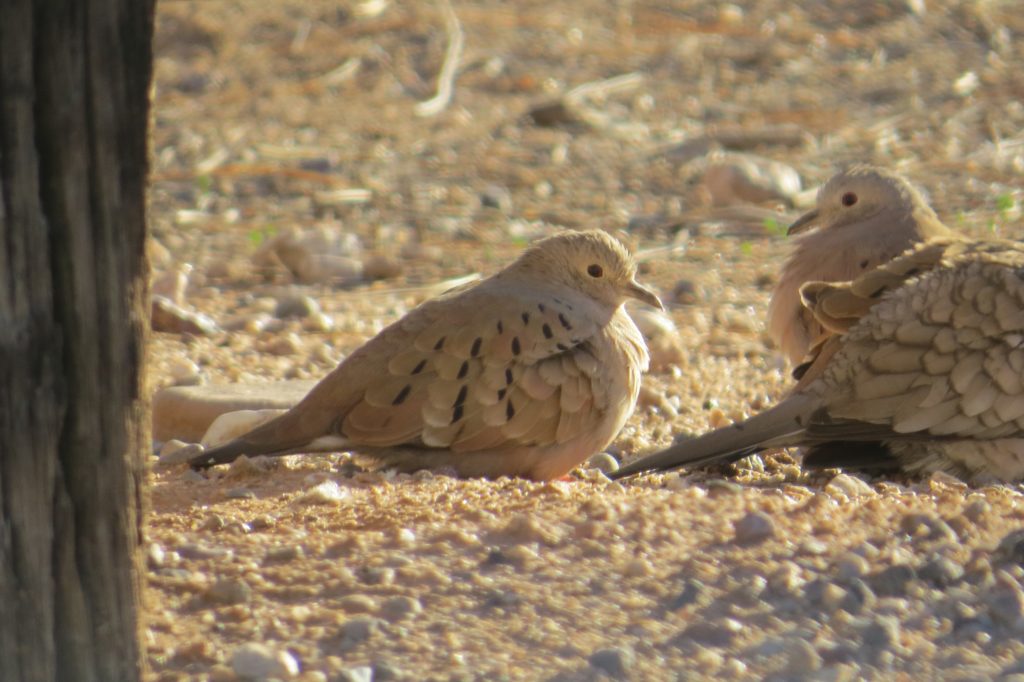
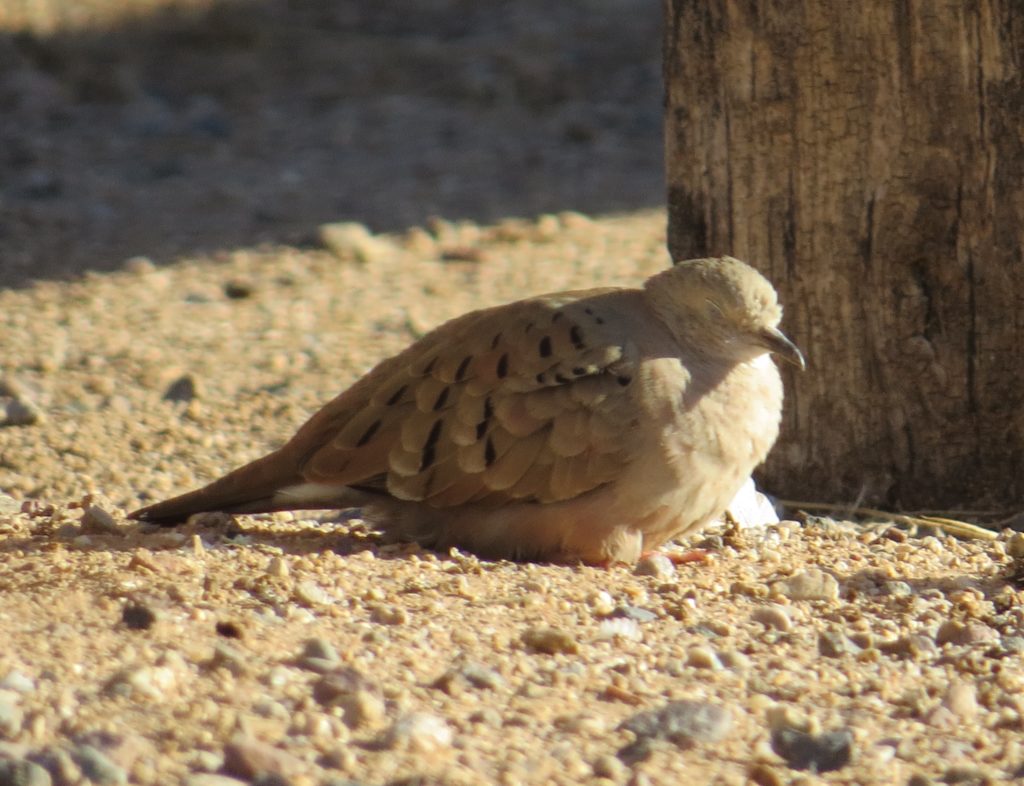 The plan was to cruise through the Santa Cruz Flats on the way home to try for two birds I had long been holding in reserve: Crested Caracara and Mountain Plover. The Santa Cruz Flats are fun place to bird where one can not only stumble across a Mark Ochs lifer but also see cool stuff like Harris’s Hawks.
The plan was to cruise through the Santa Cruz Flats on the way home to try for two birds I had long been holding in reserve: Crested Caracara and Mountain Plover. The Santa Cruz Flats are fun place to bird where one can not only stumble across a Mark Ochs lifer but also see cool stuff like Harris’s Hawks.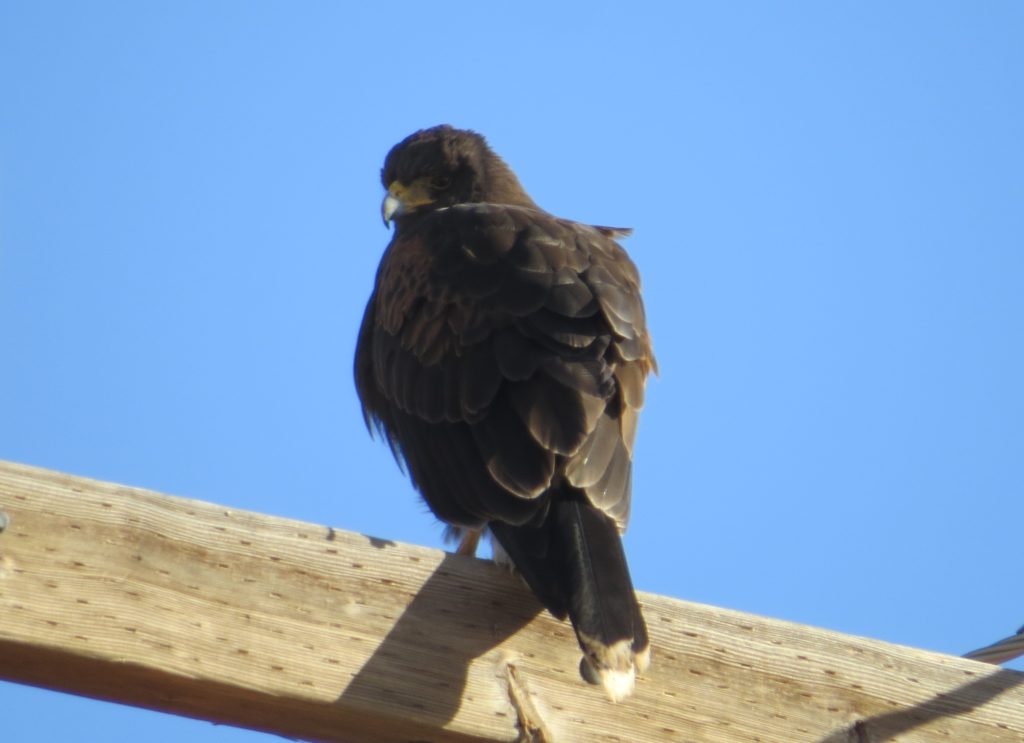
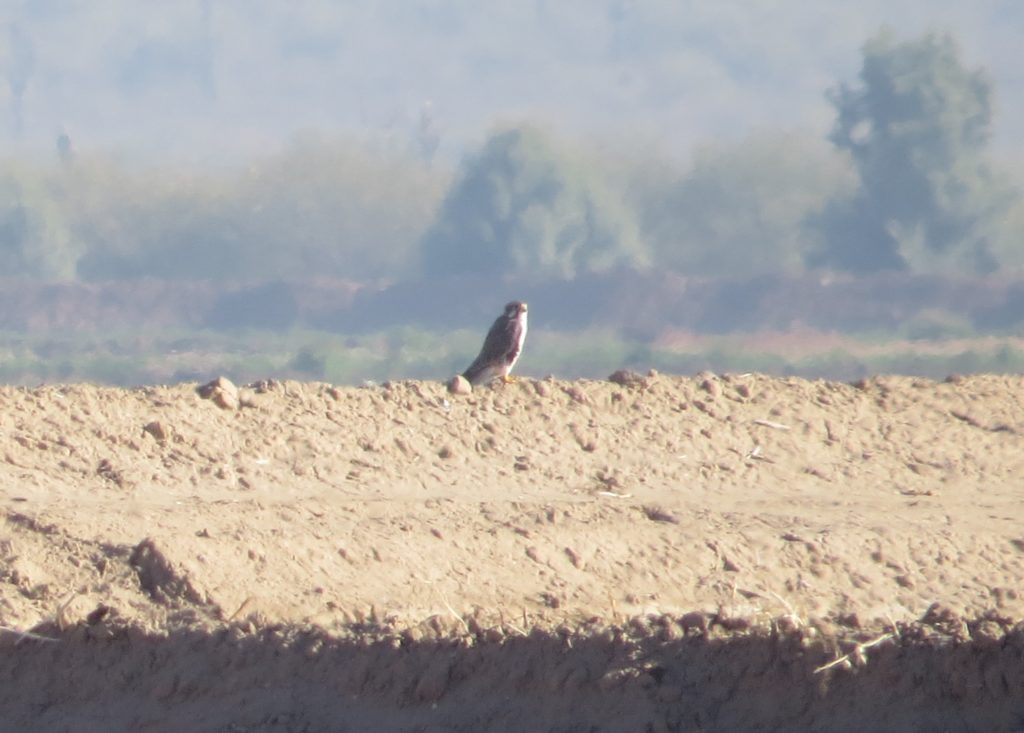 Then, thanks to our trusty guide, we finally got onto one of the two targets–a whole heap of Crested Caracaras.
Then, thanks to our trusty guide, we finally got onto one of the two targets–a whole heap of Crested Caracaras. 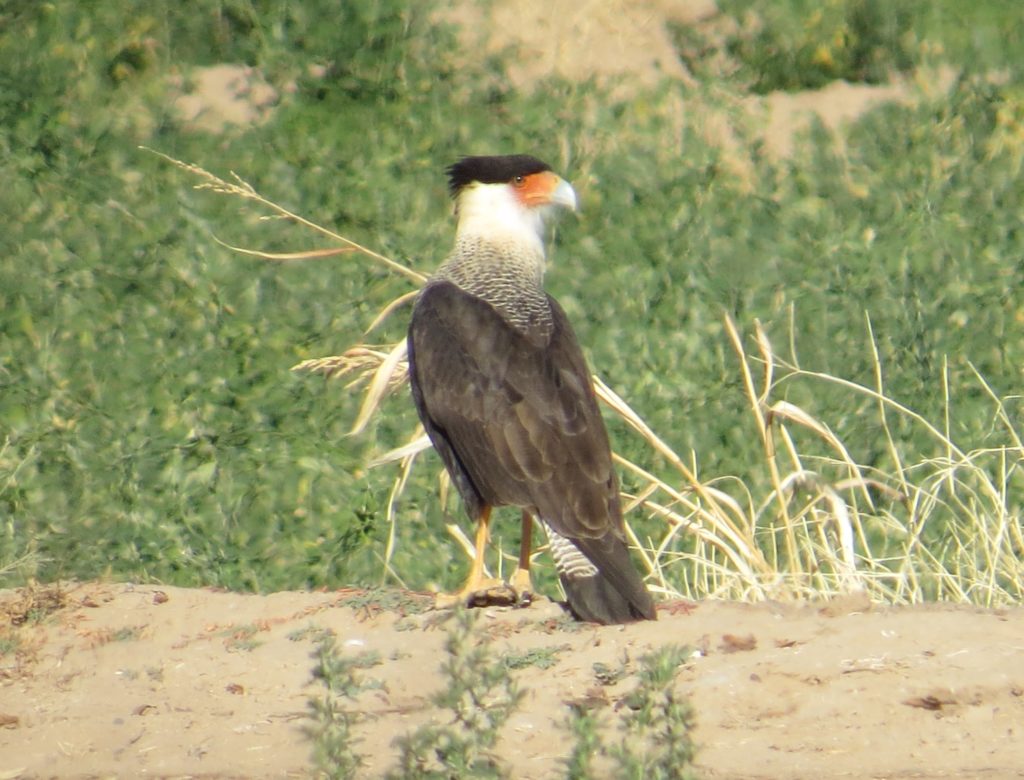
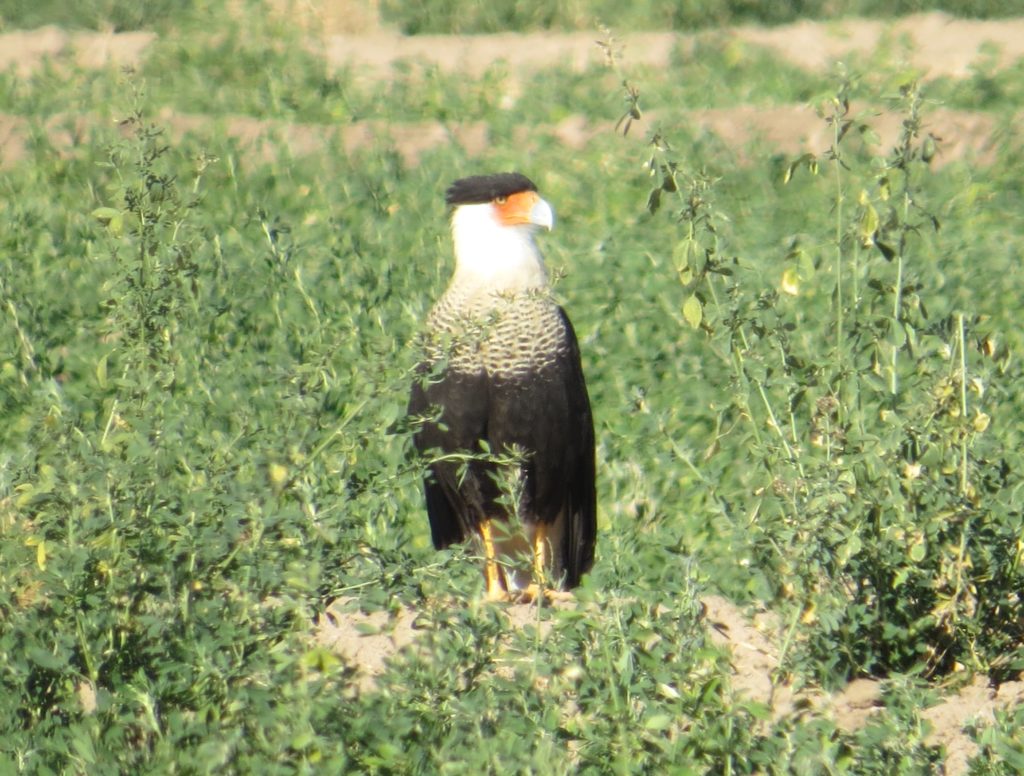 Not long after, Gordon had found us some Mountain Plovers.
Not long after, Gordon had found us some Mountain Plovers.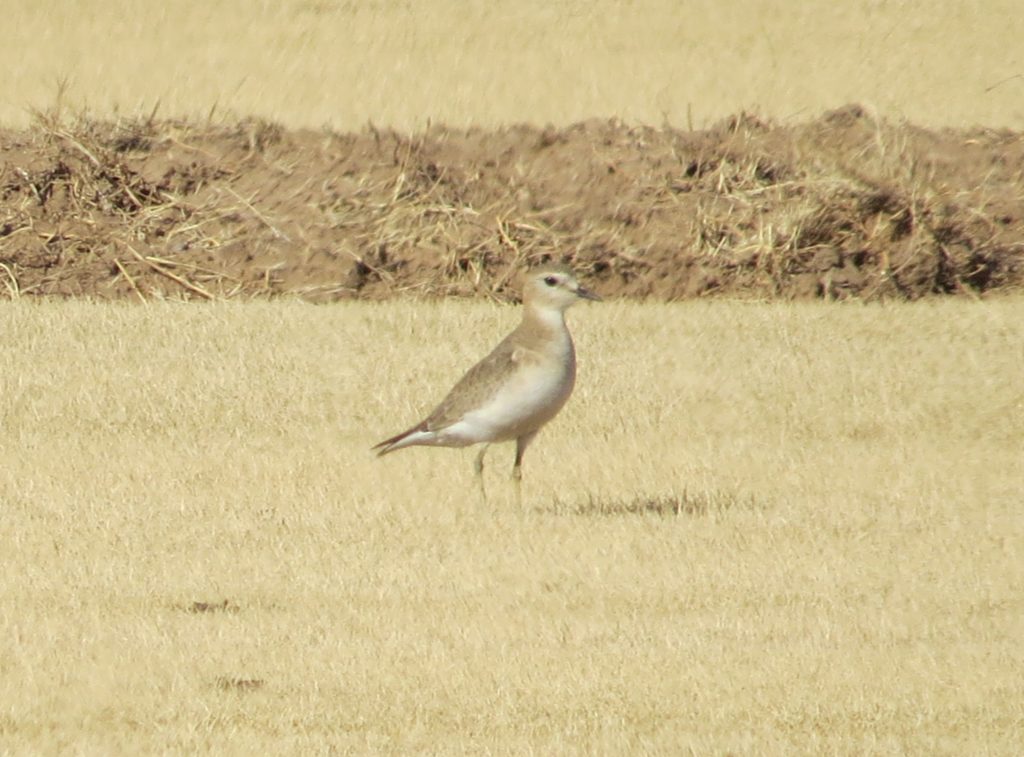
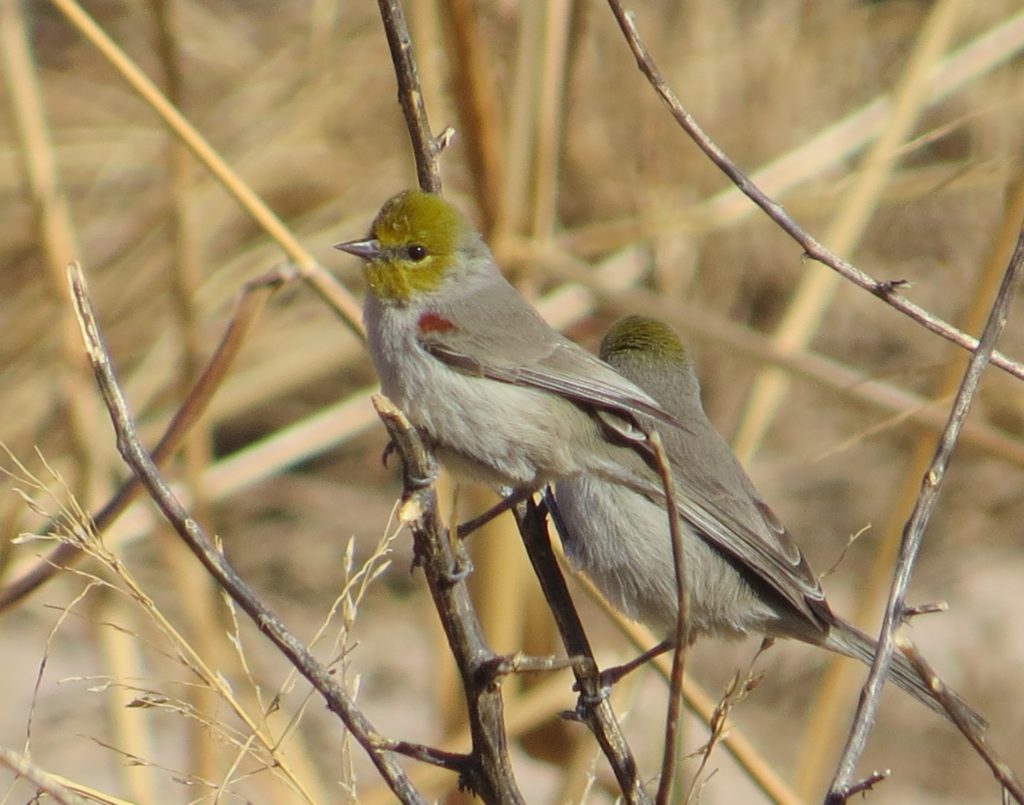 Some birds practically throw themselves at you when you’re just out walking in the neighborhood. Vermilion Flycatchers seem to be becoming more prolific in the area of Maricopa where Mom and Dad live. I don’t mind.
Some birds practically throw themselves at you when you’re just out walking in the neighborhood. Vermilion Flycatchers seem to be becoming more prolific in the area of Maricopa where Mom and Dad live. I don’t mind.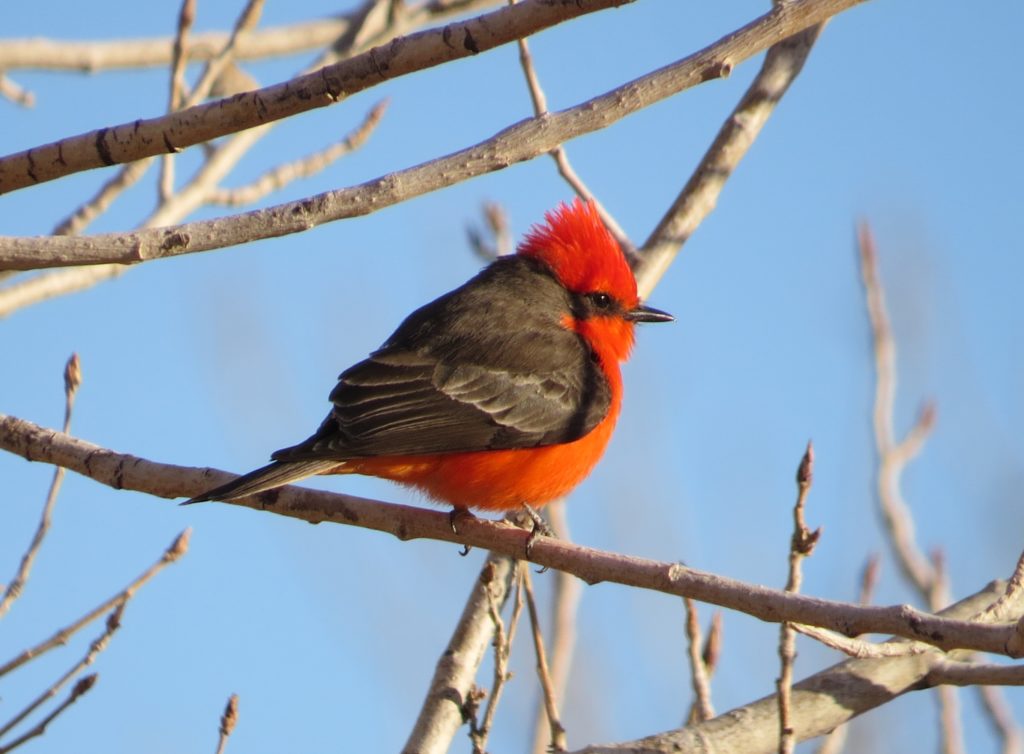
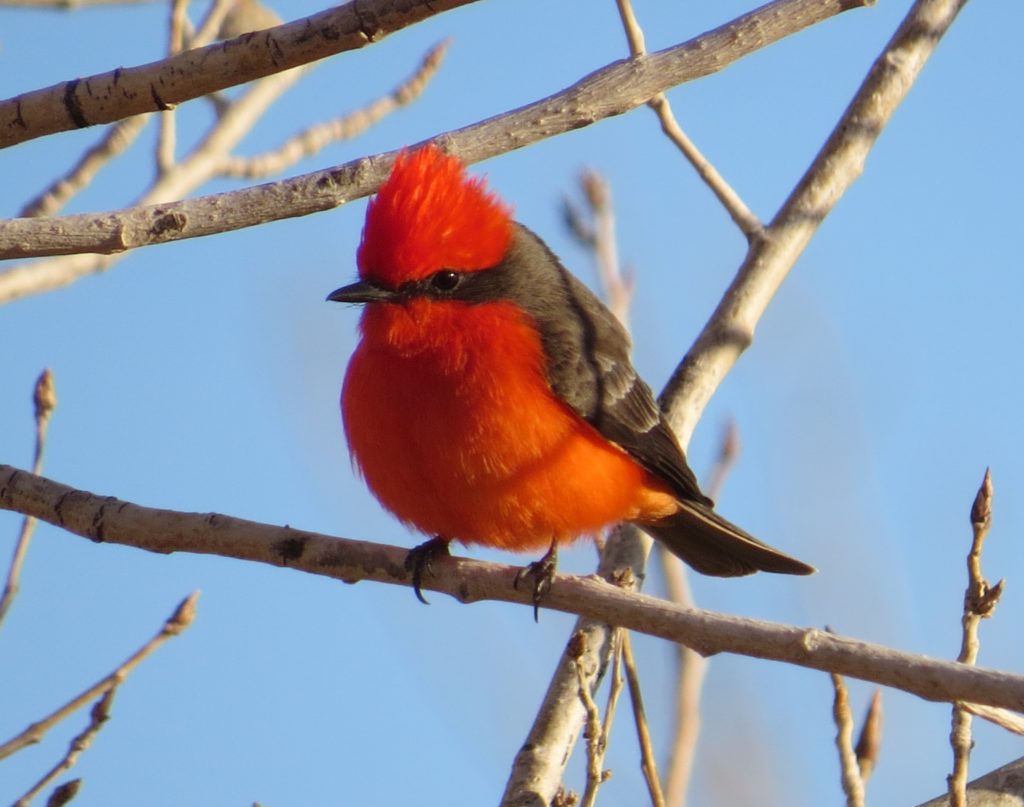 Last, but certainly not least, checking on our neighborhood buddy is an annual tradition.
Last, but certainly not least, checking on our neighborhood buddy is an annual tradition.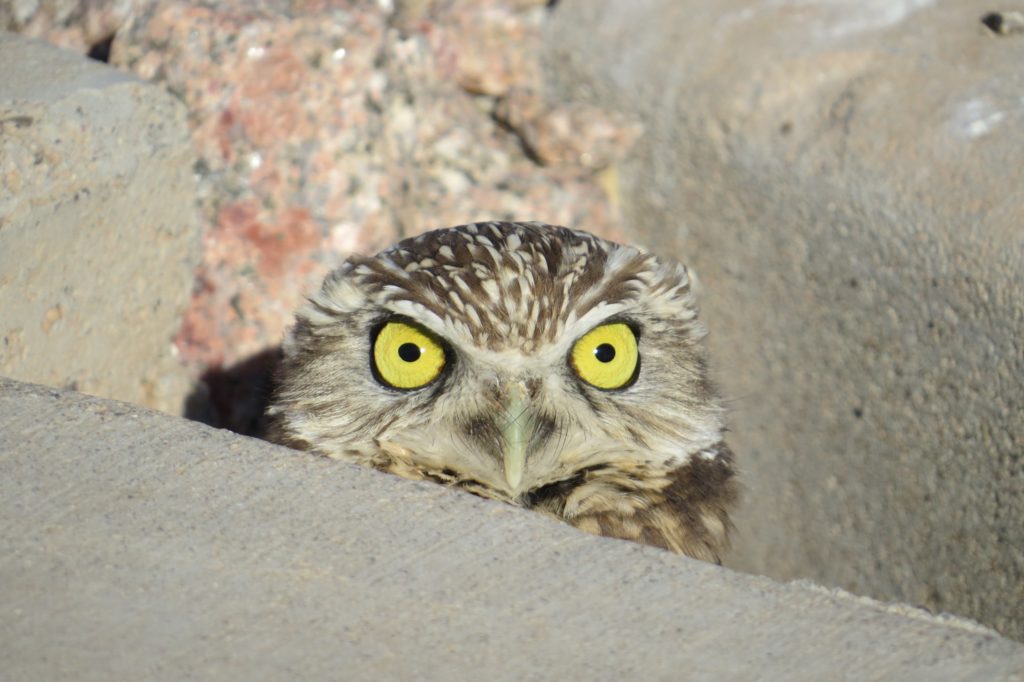 So that’s it from this trip. Pretty tame by previous standards, but that will more than be made up for on an upcoming post detailing another trip to Arizona that was focused exclusively on birding. But first, we have to cover another excursion to Duluth. There was an irruption going on this winter, after all.
So that’s it from this trip. Pretty tame by previous standards, but that will more than be made up for on an upcoming post detailing another trip to Arizona that was focused exclusively on birding. But first, we have to cover another excursion to Duluth. There was an irruption going on this winter, after all.